

The Definitive Guide to the Kumano Kodo Trek in Wakayama, Japan
This post contains product affiliate links. These are mainly on items/hotels/tours that I personally endorse & love. I may earn a small commission if you make a purchase, but at no extra cost to you.
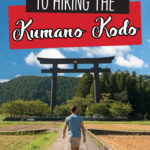
Thinking of doing the Kumano Kodo trek in Japan? From advice to accommodation, this is all you need to know about hiking the Kumano Kodo!
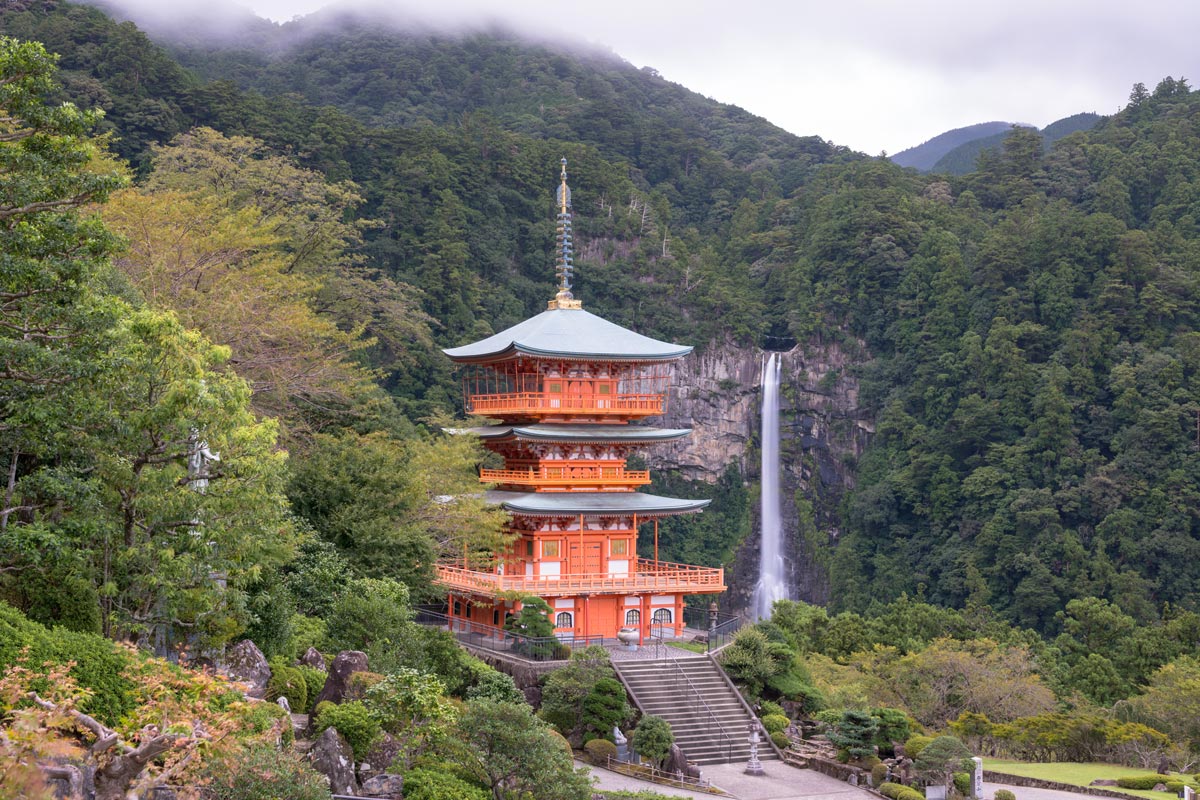
I’m going to say this right away, the Kumano Kodo trek in Wakayama is one of the best I’ve ever done in my life. Honestly, I really mean that.
With gorgeous rolling mountains, mist rising in the morning, tea houses along the route, traditional temples to stop off at – the Kumano Kodo trail has all of this and more. Also, where else in the world can you walk in the footsteps of Japanese emperors and samurai?
I recently visited Japan for the first time, and one of the things I was most looking forward to doing was hiking the Kumano Kodo. In the hiking world, this is up there as one of the most popular hikes you can do. Well, it certainly didn’t disappoint.
I’ve always been drawn to the mountains. There’s some so ethereally beautiful about hiking in this part of Japan . It gets to you, gets to your soul. After doing the Kumano Kodo trek myself, I can see why this is so high up on people’s bucket list. I really can’t recommend it enough.
So, if you’re thinking of doing the Kumano Kodo pilgrimage yourself, this is the post for you – from the history of the area to which is the best route to take, this is everything you need to know about hiking the Kumano Kodo!
Travelling around Japan? Then make sure you read my big two week itinerary for Japan . You can also check out some of my guides to Kyoto , Hiroshima and Osaka here.
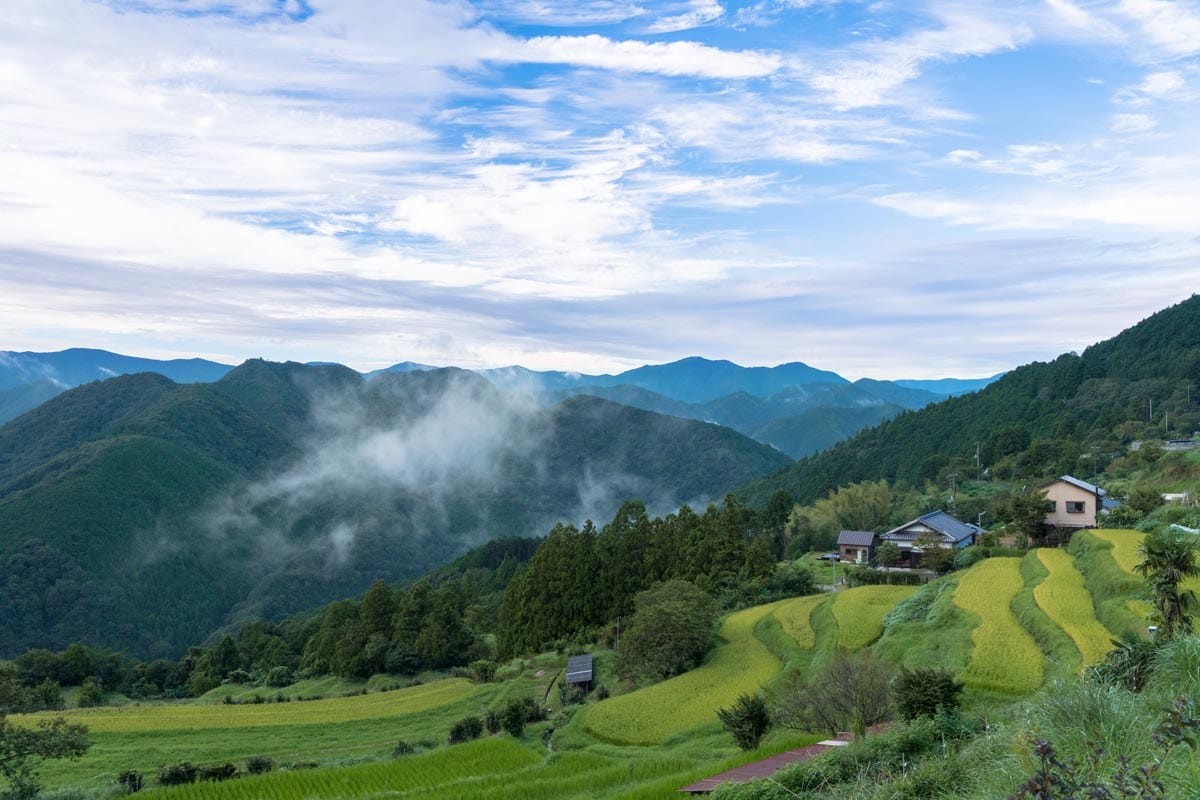
What is the Kumano Kodo trail?
The Kumano Kodo is a 70km 5-day pilgrimage taking you through the most beautiful countryside in Wakayama.
I didn’t realise this before I trekked the Kumano Kodo myself, but there are only two hiking routes that have UNESCO World Heritage status – this one and the Camino de Santiago (the Way of St. James) in Spain.
Because of this, these two routes are linked together. If you complete the Kumano Kodo walk and the Camino de Santiago then you can officially refer to yourself as a ‘dual pilgrim’ – how cool is that? You even get your own certificate and everything.
The Kumano Kodō is the holiest and most sacred pilgrimage in Japan. This route used to be only reserved for emperors and samurai. Being a bit of a history buff, I loved that I actually walked the same route as the old Japanese emperors centuries before me.
Put it this way, hiking in Wakayama really doesn’t get any better than this.
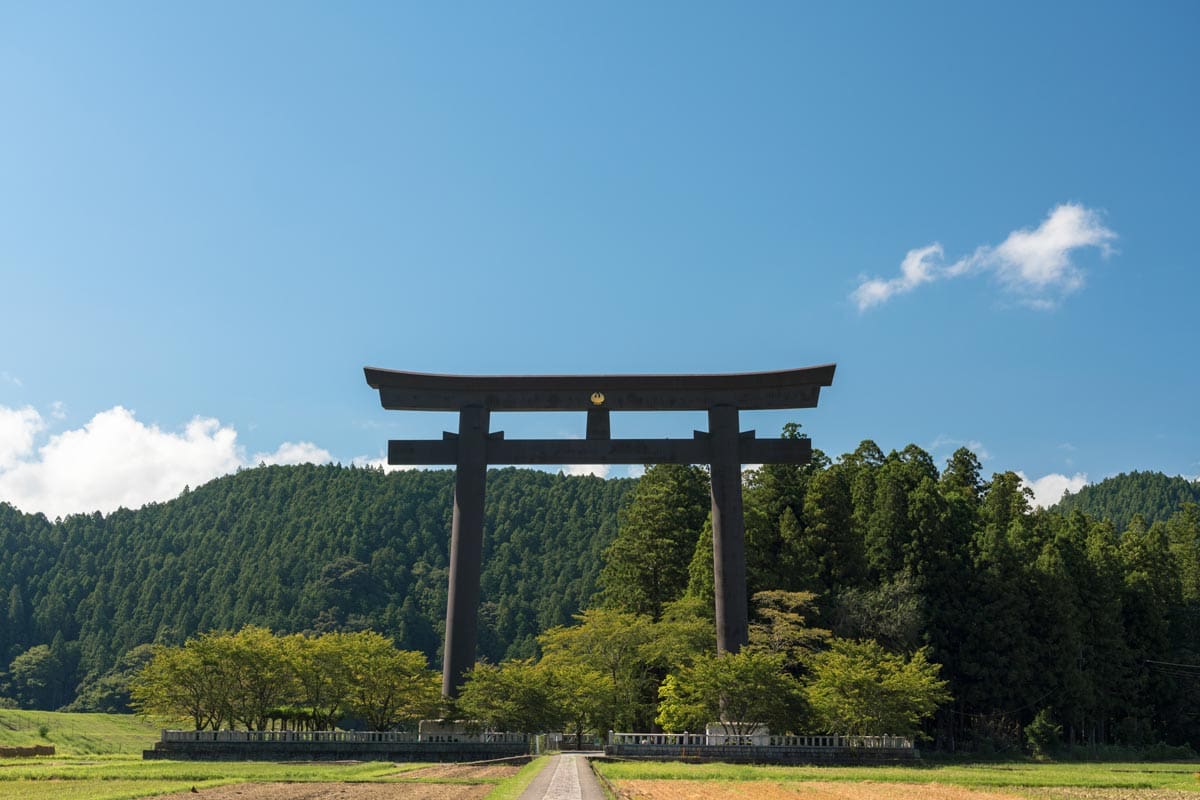
The history of the Kumano Kodo
Don’t worry if you haven’t heard of the Kumano Kodō before – I hadn’t either before I trekked it. However, it is old. The history of this route dates back over 1,000 years. And urban legends in this area date back even further.
At the very centre of this religious area are the three Kumano shrines: Hongu Taisha, Hayatama Taisha and Nachi Taisha. Collectively they are known as Kumano Sanzan .
However, the Kumano Kodo pilgrimage route developed over time as a way for people to move between these sacred areas on the Kii Peninsula.
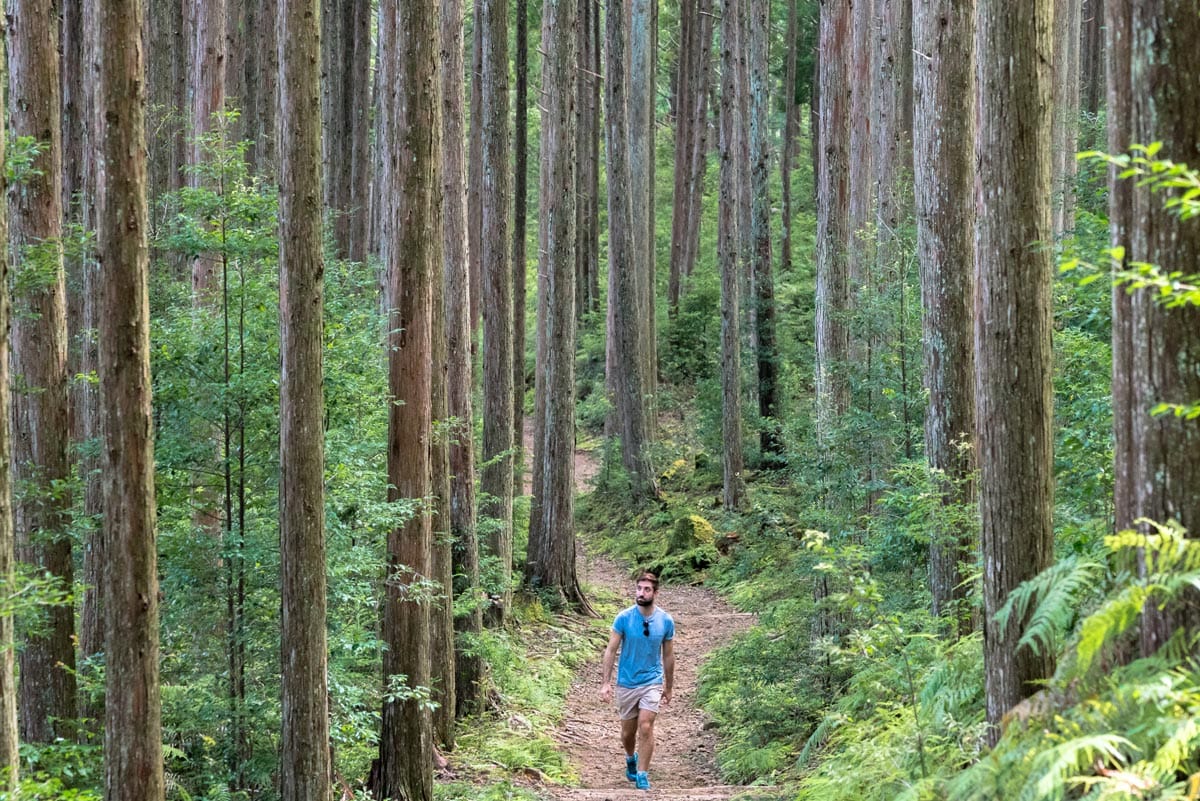
By the 12th century, the Kumano Sanzan were well known shrines all over Japan pulling in people from all over the country, and the route eventually became a religious pilgrimage for all those who walked it.
Once emperors walked the Kumano Kodo searching for peace and enlightenment, the route was secured as one of the most popular pilgrimages in Japan. This is something that hasn’t changed for the centuries since.
One of the things I loved about the Kumano Kodo trek is you really get a sense of the importance and history of it. Add in the mountains and forest, and it’s hard not to get caught up in the moment yourself. I know I certainly did!
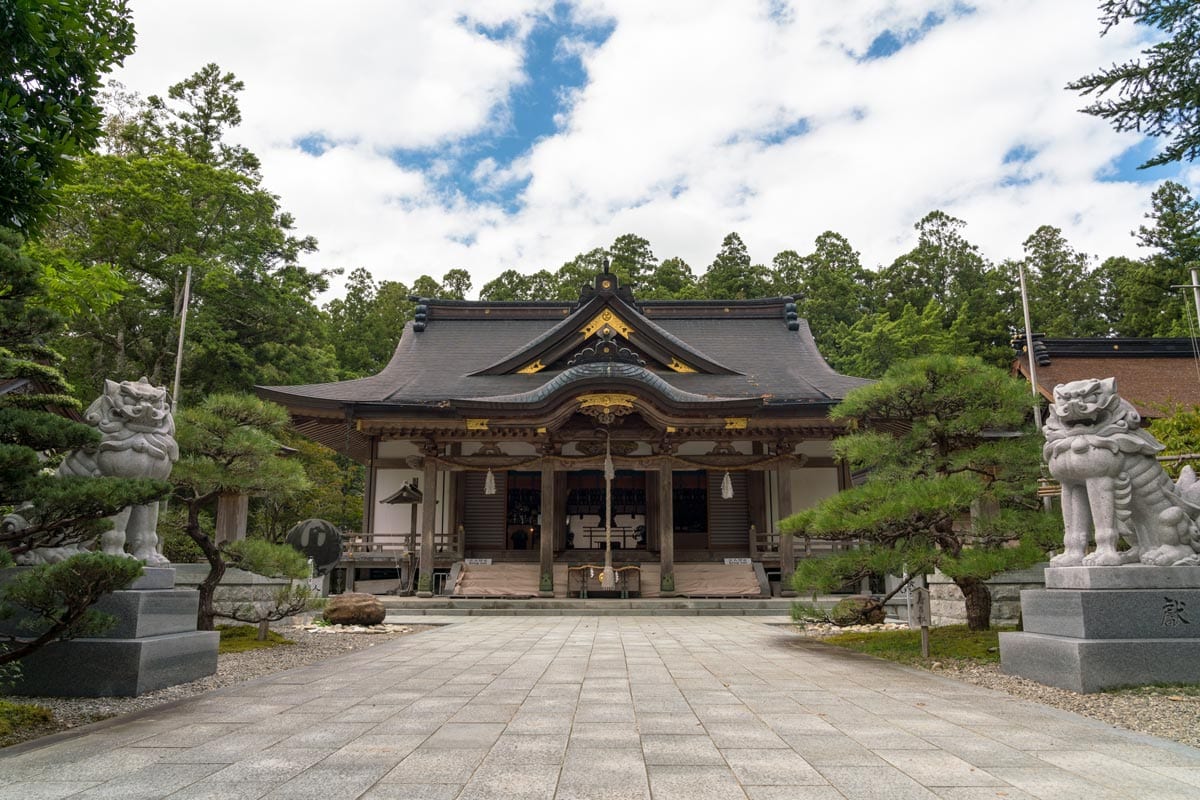
Nakahechi – the main hiking route
Unlike the Camino de Santiago that has a clear start point and end point, the Kumano Kodo is not one route but a network of routes all linking together.
This means you can start at different points, some trails taking 30 days and some taking just a few hours. It all depends how much time you have and how much of the Kumano Kodo trail you want to do.
However, historically pilgrims would visit the three main shrines of the Kumano Sanzan which are the three cornerstones of the Nakahechi route (the Imperial Route), the most popular and action-packed route through Wakayama.
The Nakahechi pilgrimage route starts from Tanabe on the western coast of the Kii-Peninsula and works its way east across the mountains towards the Kumano grand shrines at Hongu and then Nachisan.
This trail has traditional lodgings in small, isolated villages along the route and is a trail very well suited for those of you looking at doing it on your own. That’s one of the best things about this route – it’s really friendly for all types of hikers.
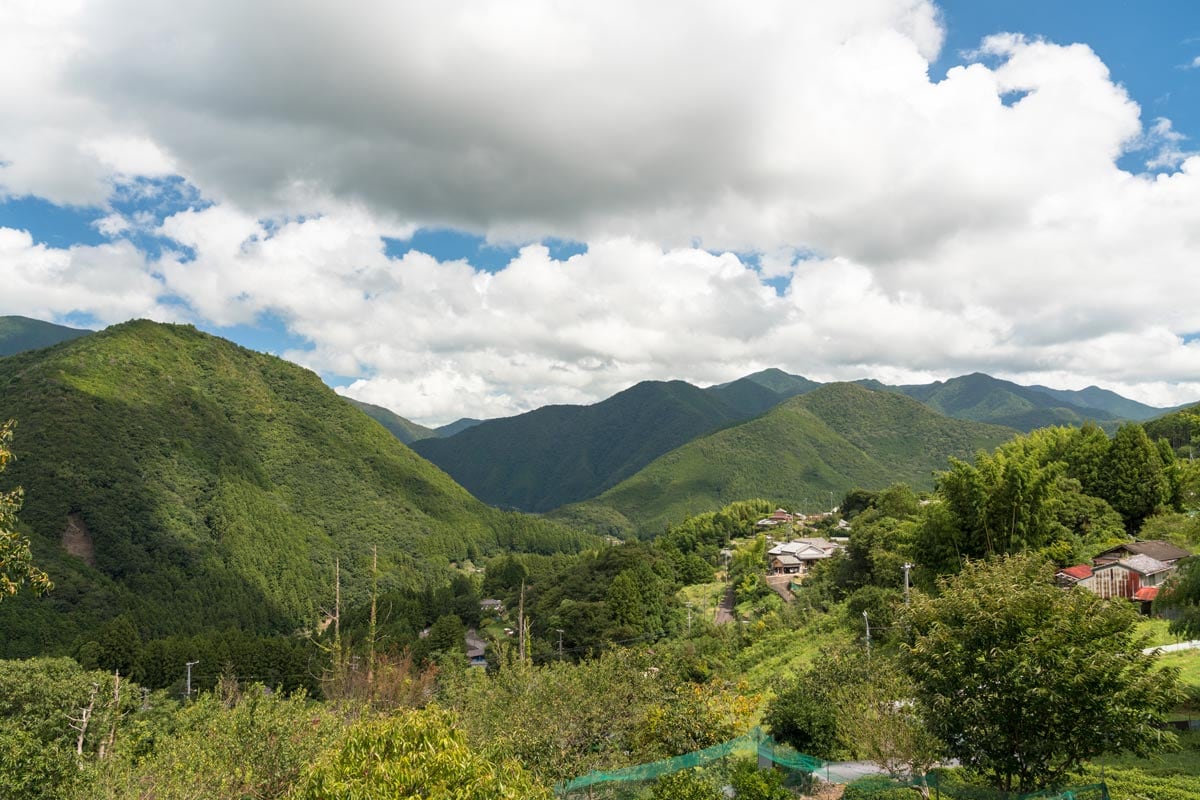
Kumano Kodo map
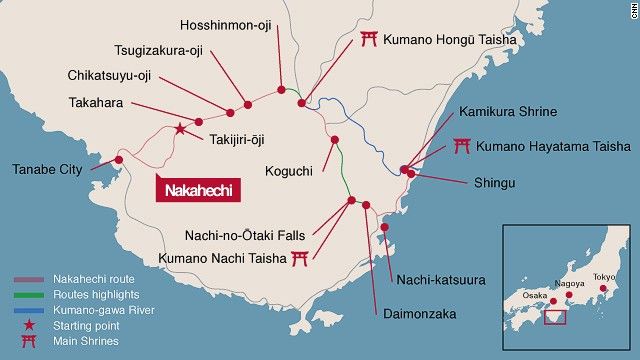
The three main shrines of the Kumano Sanzan
Hongu taisha:.
This shrine is nestled in the forests of Wakayama and is made up of three main temples.
Legend has it that the Kumano gods, in the form of three moons, descended into the branches of a giant oak tree in this clearing and laid to rest forever. Today, each of the three temples is said to have the spirit of the gods, and people prayer to the different temples for safe passage in life.
All of the Kumano Kodo pilgrimage routes lead to this sacred site and I had one of my best days in Japan here. There are a number of market stalls selling ice-cold water and snacks if you need to pick anything up.
Also, you can buy traditional Japanese ‘charms’ to pray with at the temples. Just don’t forget to ring that bell to make sure your prayer is heard!
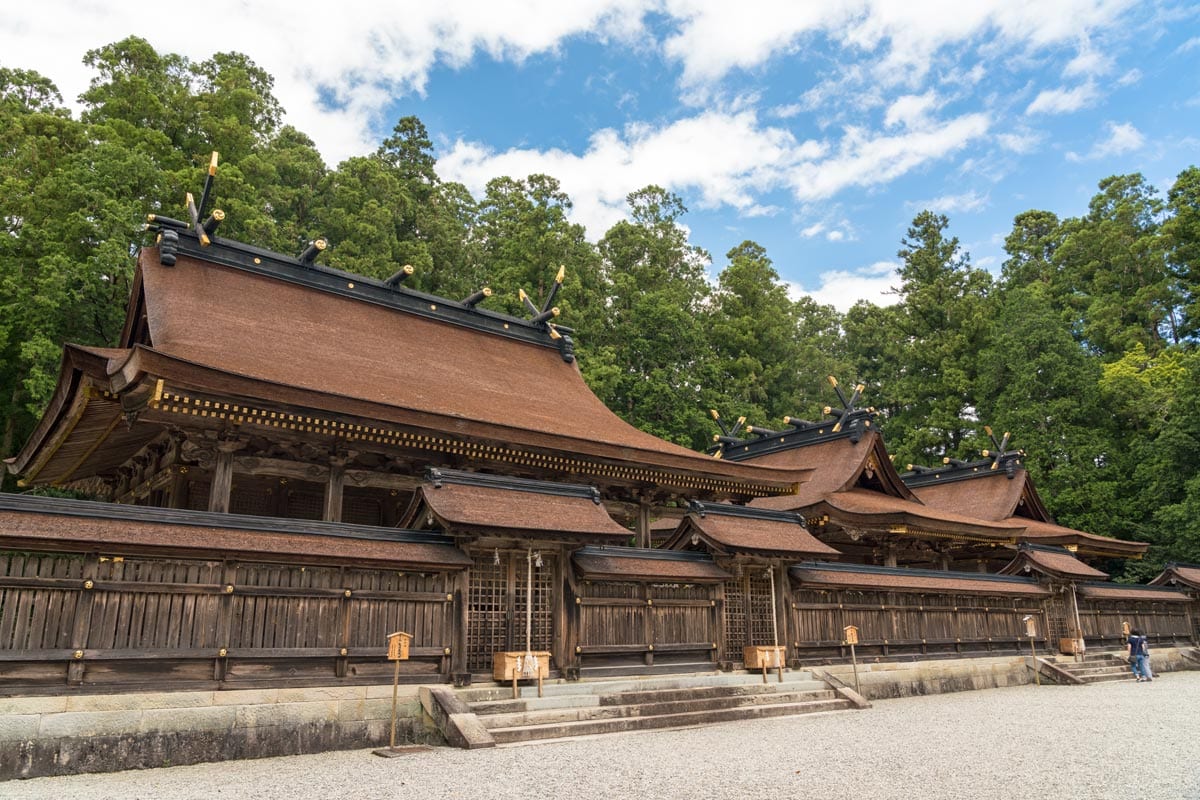
Hayatama Taisha:
Hayatama Taisha is located at the mouth of the Kumano-gawa River and it is another incredibly beautiful temple in Wakayama. One of the main pulls to Hayatama Taisha is Nagi-no-Ki tree, an ancient tree that’s said to be over 800-years-old and is considered a scared site.
There’s also a museum here with dozens of national treasures including offerings brought from pilgrims from all around the world which is well worth seeing. Don’t forget, if you want to complete the Kumano Kodo you need to visit all three of these holy shrines. When it comes to what to do in Kumano, visiting Hayatama Taisha is right up there.
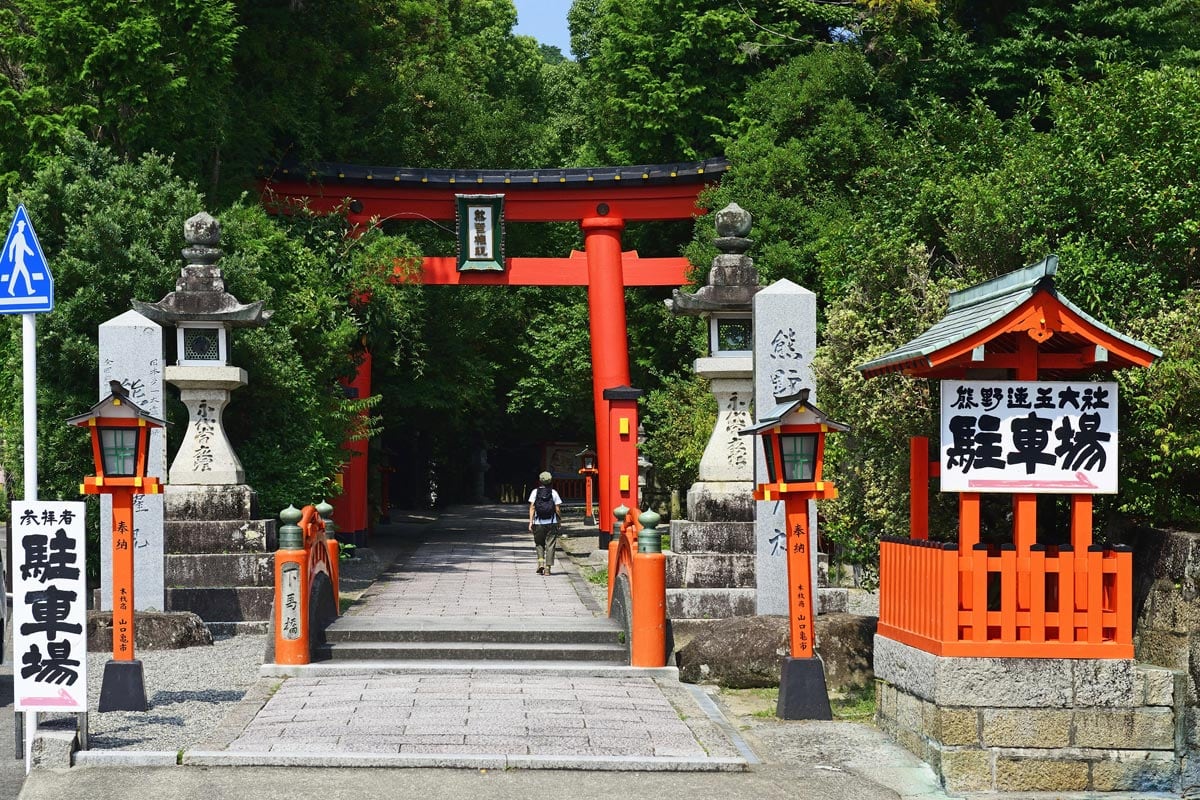
Nachi Taisha:
If I had to pick a favourite temple in Japan it would be Nachisan Seiganto-ji Temple. This really is one of the best things to do in Kumano.
The photos says it all, but this is a bright orange temple overlooking Nachi Falls, the tallest waterfall in Japan standing at 133m. I mean, look how beautiful it is!?
This is where I finished my Kumano Kodo trek and it was the perfect place to pause and reflect on the beauty of the area. Honestly, this is what the Kumano is all about, views like this. This is an incredibly holy place and there’s another beautiful shrine to take in at the bottom of the falls.

Kumano Kodo accommodation
Obviously there are countless options of places to stay at along the Kumano Kodo trail. These are a mixture of Japanese-style lodges and Western B&Bs/hotels.
Prices vary massively from as little as 2,500 yen (£18) per night all the way up to 25,000 yen (£180) per night for an uber lux place.
Some places offer dinner and breakfast, and some only offer a bed for the night – it all depends what you’re looking for.
I would really recommend making all reservations beforehand. Speaking to a few homestay owners, they said they’re usually booked up 4-6 weeks in advanced, so try to book everything before this.
Here are a few places I’d recommend along the route though. I had dinner at Takahara Lodge and it has the most beautiful views of the mountains.
- Takahara Lodge – this one is probably my favourite and right on the Kumano Kodo trail
- Kumano Kodo Nagano Guesthouse – this is one of the most popular places to stay at
- Guesthouse TAKAO – one of the best budget homestays around
- Kishuji Minabe – nice hotel to relax at by the ocean
- Iruka Onsen Hotel Seiryuusou – a really gorgeous property with gorgeous views
- Shiraraso Grand Hotel – fantastic views from this place
Do you need a Kumano Kodo guide?
No, you don’t!
One of the best things about this pilgrimage is its self-guided. There are lots of signposts all along the route in Japanese and English pointing you in the right direction.
However, I had a guide (Waka from Mi Kumano Guides) for the last section and she was brilliant at pointing out things I would’ve missed myself; she really brought the history of the area to life.
If you really want to learn the history of the Kumano Kodo and all about the temples along the way, it’s recommended you hire a guide. You can find out some more information about the guides at the Kumano Kodo information centre (which is here ).
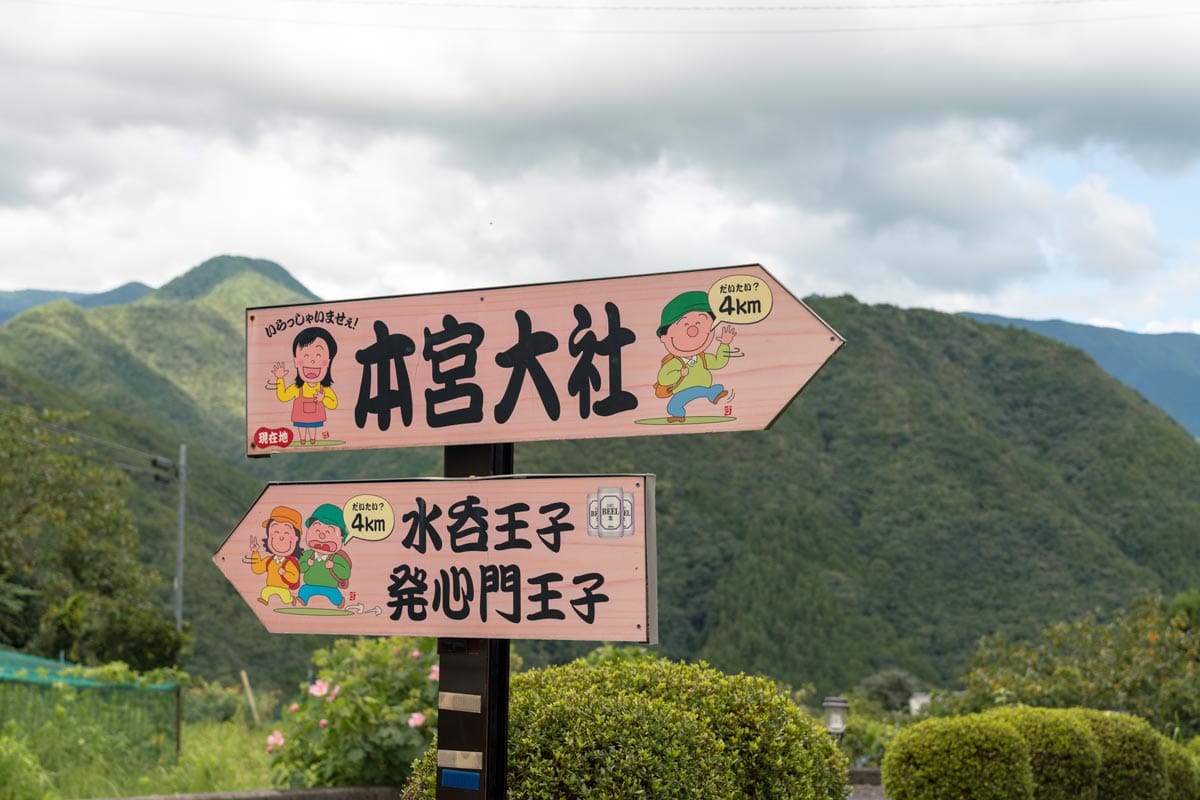
Don’t forget to stamp your trekking passport!
If you head to the visitors center before you start the Kumano Kodo walk then you’ll be given a passport book which you can stamp at a number of places along the route.
Even though it was a little gimmicky, I really like that stamping was encouraged and the passport book actually became a nice souvenir at the end of the trek.
You can also use this passport book on the Camino de Santiago to show you’ve done both pilgrimages. That’s when you get a special certificate saying you’ve completed both pilgrimages.
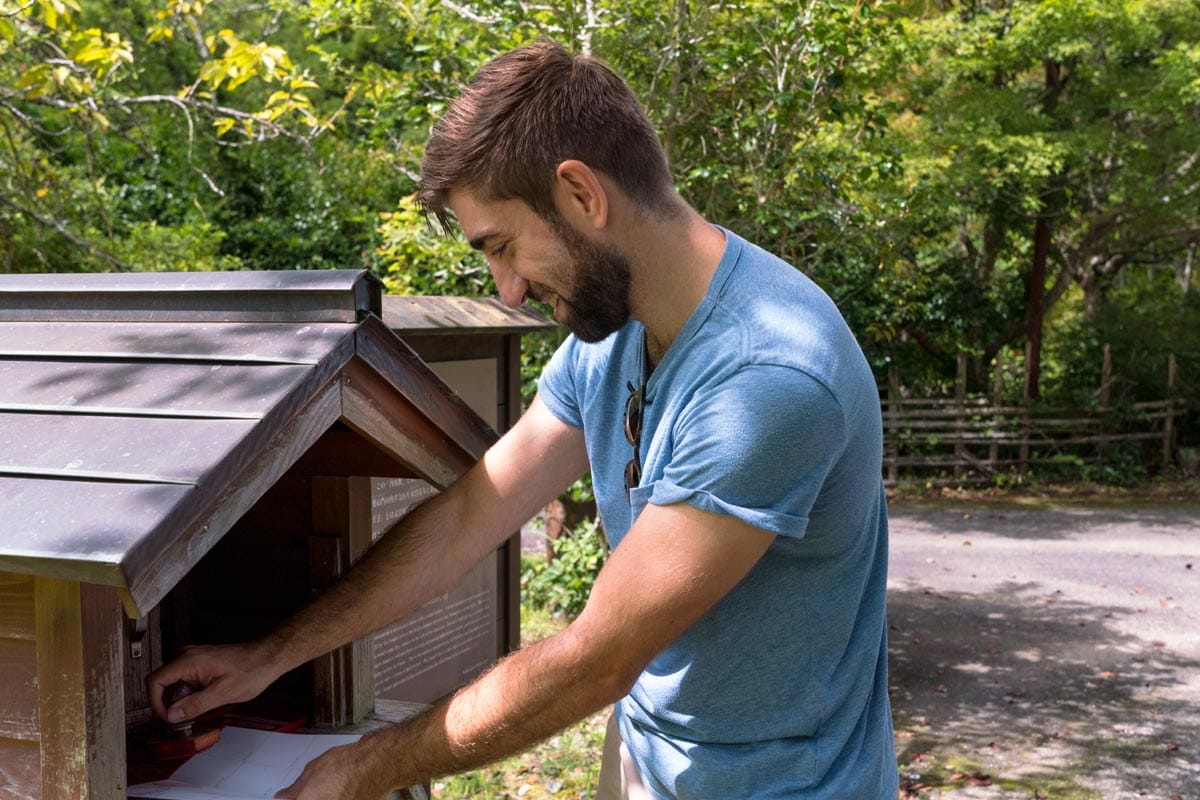
Top tips for the Kumano Kodo walk
- Insect repellent – My number one tip here but make sure you bring lots of insect repellent. Not only are there mosquitos here but there are huge horse flies too – they’re the ones that really hurt so spray up!
- Wear trousers and a long-sleeved shirt – When my guide turned up in trousers and a long-sleeved shirt in the blazing sunshine I thought “what is she wearing?” A few hours later and I was the one being bitten by bugs and she was happily drinking green tea. To further get rid of the bugs, cover yourself up!
- Bring waterproofs – If you’re hiking during the summer (also known as typhoon season) then bring waterproofs with you. Even if it’s bright blue skies the weather can change in an instant and you’ll be sorry if you don’t have any way to keep dry, especially for your camera.
- Bring money with you – With lots of tea houses on the route and places where you can buy souvenirs, make sure you bring enough money with you. I often found buying a coffee was a huge highlight of my day.
- Take off your shoes – If you’re entering someone’s house, always remember to take off your shoes. This is very important in Japanese culture and if you don’t it’ll cause offence to your host.
- Get naked – If you’re relaxing at an onsen after a long day’s hike, make sure you go in naked. Don’t worry, this is a part of Japanese culture and you’ll soon lose that self-consciousness once you get into the water. It really is the ultimate way to unwind.
Photos of the Kumano Kodo
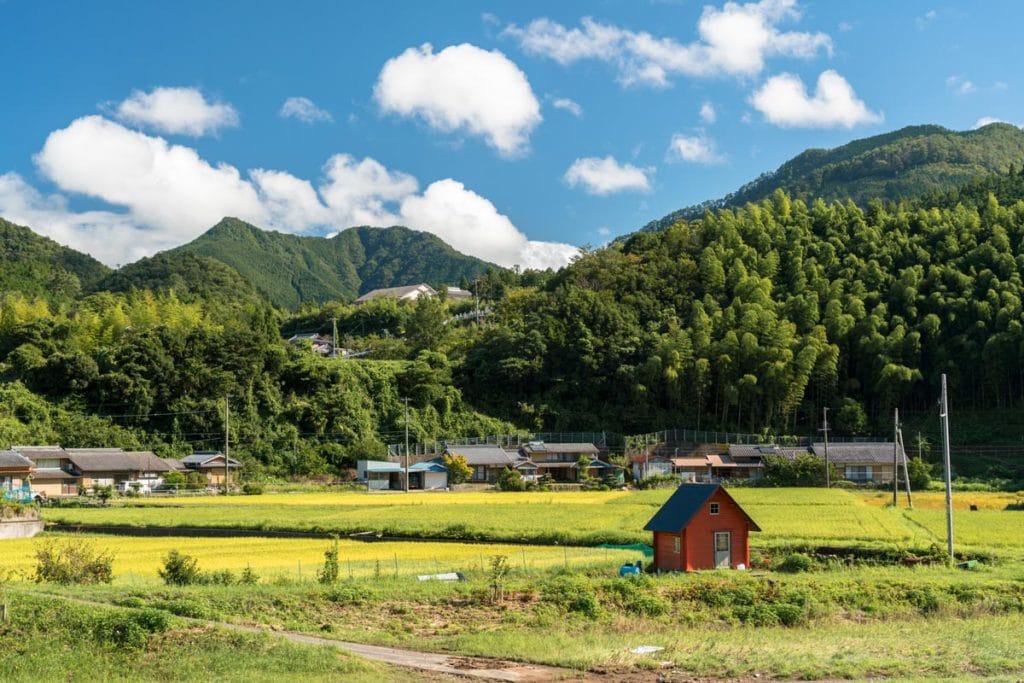
This trip was in association with the Japanese National Tourist Office (JNTO) , and with Explore Shizuoka , Hot Ishikawa and Visit Wakayama showcasing some of the different peninsulas in Japan. As always, all views and opinions are my own.
Are you doing the Kumano Kodo trek? If you have any questions at all about the trek at all then just let me know in the comments below!
Like this blog post? Then make sure you Pin it!
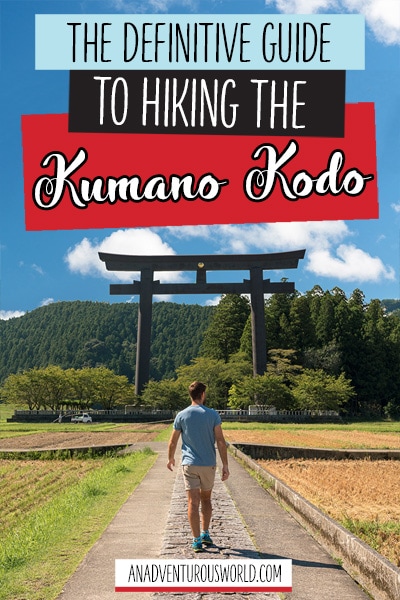
About the Author

Macca Sherifi is the founder of the multiple award-winning blogs An Adventurous World and the Great British Bucket List. Every month he inspires over 200,000 avid readers to travel the world.
View all posts
32 thoughts on “The Definitive Guide to the Kumano Kodo Trek in Wakayama, Japan”
Thanks for all the tips.
Is the trail safe for a solo female traveler ?
And how can I get my luggage transferred from each point so that I only carry a day pack with water and snacks?
Macca, 3 of us from Malaysia want to undertake this adventure of Kumano Kudo. After reading your blog, just want to know how we can get started on this adventure. Appreciate your response and if possible if I can set up a Zoom call to discuss more about it
That’s great to hear! What stage of planning are you at? You should be able to get the most up-to-date information at this website – https://www.tb-kumano.jp/en/ . Let me know how else I can help out though!
Hello, Where did you stay when you had dinner at the Takahara Lodge? We could another guest house near Takahara but it seems quite far to walk to for dinner. Thanks!
Is it possible in One day to train from Osaka, walk Takijiri-Oji to Tajahara and then bus to Yunomine Onsen for the night or too much?
We stayed at a little guest house in the village near Takahara Lodge and walked up the hill to it. It was well worth it for the views I promise you! And yes, you could do all of that in a day if you set off early enough. You’ll certainly enjoy the onsen at the end of it!
Hi thank you so much for your post! My friend and I did the Camino du Santiago from France to Santiago – we would like to do the 6 week hike? I can’t seem to find where to start organizing it and getting the maps etc. Can you please advise us? Kathleen
Hi Kathleen! Did you find the information you were after? If not let me know and I’ll help out with it!
Hey Macca! This piece was very helpful. What’s the best way to book ahead? It’s kind of confusing because I don’t know where I’ll stop or end up?
It depends on what you mean by book ahead. For accommodation I’d use booking.com (that’s my preferred booking site), and for everything else I’d do it a few days beforehand.
We’re planning on running the Imperial Route…I see that there are guided runs, but want to be sure it would be culturally appropriate to run the trails. Your thoughts?
It’s a really good question Kyle and thanks for asking it. You’ll be absolutely fine running the trails. As long as you’re respect of other hikers when passing by it won’t be a problem at all. Maybe pack a spare pair of socks and shoes for the temples though!
Hey Macca, I only have 3 days to do some of the trek. I was wondering if it was possible to start the hike at Hosshinmon-oji and finish at Nachi Taisha? Or is it recommended to start the hike at Takijiri and finish at Hongu Taisha?
You can do the first one! I really recommend finishing at Nachi Taisha as it’s such a spectacular spot. Hopefully you can find a route that works for you though!
Hi Macca, What is the proximate cost of the 5 days trek? Thank you
It all depends on where you stay, but if you’re in simple accommodation I would say it costs approximately around $200 for a self-guided 5-day trip. It can be done cheaper for sure – it all depends on your style of travel!
what is cost?
I’m excited to hike this. I’m wondering if anyone has any thoughts on doing the Nakahechi and then turning North to the Kohechi after all the cultural stops are done?
I think it’s a great idea Vita! Then you get to see more of the region – Wakayama is one of my favourite places in Japan!
I wanna do this.. but not sure if i can make it alone. I just don’t want to stress myself out. Is there a travel agency that I can just pay for everything for airport transfer, to accommodations and transportation? Also, I would love to join other hikers.
Good question and there are definitely some tour agencies that offer this. WalkJapan are a fantastic company who I’d recommend for a tour to the Kumano Kodo.
Hi, I’m planning for Kumano Kodo, there are lots of info online but I’d like to get a hold of a paper version too. What’s the best way to get a guide book in the UK? Also, do you have any tip for a kayak trip while trekking the Kumano? Thank you Macca!
There’s actually an amazing book called ‘Japan’s Kumano Kodo Pilgrimage’ by Cicerone guide books which I really recommend as a paper version. It’s packed full of useful information and has everything you need!
Hi Macca, Very good article with lots of useful information. I am planning to do Kumano Kodo in early September – 5 days. I have done Camino Santiago (twice). Is it common to walk with one’s back pack everyday – as most people do on Camino de Santiago? Thank you for giving accommodation recommendations. Is there a particular site that’s useful to do the reservations?
Hi Jose! Yes, it’s very common to walk with a backpack on your back. There are lots of tea stations along the route too where you can relax and rest for a bit to give your shoulders a break. As for booking accommodation, I’ve always gone with booking.com and I find them the easiest to use. I *think* there are a couple of local ones though so make sure you look around online first!
Aloha Macca. My friend and are looking at this route but we prefer camping to lodging. Is camping allowed? Mahalo
I’m not 100% sure about wild camping (though I know people who have done this). There are definitely camp sites you can pitch up a tent and obviously a fraction of the cost of other accommodation. Take a look here which should help – http://www.tb-kumano.jp/en/lodging/campgrounds-bungalows/
Hi Macca, I really enjoyed reading your post on the Kumano Kodo, there are some really fantastic tips there. My partner and I are headed to Japan in mid May, and we’ll only have one day to do a portion of the Kumano Kodo (unfortunately!). Do you have any advice for where is a good place to do a day trip? Preferably a round trip, but that’s not necessary. We’ll be staying in the area the night before and night after, and are happy to spend most of our day walking.
Thanks in advance for any advice 🙂
I’d say the last day to Nachi Taisha. You can stay in Takahara where there are some really nice places to stay at. Then you can head down into the valley and work your way through the last half-day / full-day of the Kumano Kodo to Nachi Taisha (which was my fav bit I’d say!) I hope that helps!
How can I get the “credencial” and passport?????????????????
If you pop to the tourist information office they’ll have the passport there. Also, a lot of the hiking hotels will have them too!
We are planning to hike Nakahechi for 3 full days this coming June. Do you have advice on whether to start hiking the trail on the East side of the penninsula or the West side? With only 3 days of hiking, I don’t believe we can do the entire route so would like to start on the most scenic and interesting side and then head towards the middle from there. Thanks in advance…
Hi Liz! I’d recommend starting at Tanabe in the south west and going from there on the Nakahechi route. I would say that’s the most popular point to start from for a shorter 3-day hike. To be honest with you though, it is such a beautiful hike it doesn’t really matter where you start because it’s all so stunning!
Leave a comment Cancel reply
Inside Kyoto
A Kyoto Travel Guide
The Kumano Kodo Walking Trail: A Guide with Maps
The Kumano Kodo is an ancient pilgrimage trail in the mountains of Wakayama (south of Kyoto) where you can walk with a light pack from guesthouse to guesthouse for a few days. It’s a brilliant way to experience Japan’s rural side and ancient religious traditions.

Kumano Kodo Walking Trail Overview
If you’re looking to do a trek in Japan, you’re probably considering either the Kumano Kodo, which is in Wakayama (southern Kansai), or the Nakasendo , which connects Tokyo and Kyoto via the mountains of Central Honshu. Since the Nakasendo has become popular in recent years, we find that the Kumano Kodo gives you a more authentic and less touristy experience of the Japanese countryside.
The Kumano Kodo is actually a network of several ancient pilgrimage routes that converge on Kumano Hongu Taisha Shrine, a powerful Shinto shrine in the mountainous heart of Wakayama Prefecture. Hongu Taisha is the most important of three famous shrines known as the Kumano Sanzan. The other two, Kumano Nachi Taisha and Kumano Hayatama Taisha, are both near the eastern coast of Wakayama and are connected to Hongu Taisha by well-traveled pilgrimage routes.

The most popular and accessible route is the Nakahechi, which starts at Takijiri, a trailhead about 15km west of Tanabe, the city on the west coast of Wakayama that serves as the main entry point for the Kumano Kodo (it’s accessible by express trains from Kyoto and Osaka. You can use a Japan Rail Pass for these journeys). From Takijiri, it’s a three-day walk through the mountains to Hongu (home to Kumano Hongu Taisha). This is the walk we will describe in this article. From Hongu, you can visit three nearby onsen (hot springs), continue hiking another three days to Kumano Nachi Taisha, or do several other nearby hiking routes.
In this guide, we discuss the following:
- Best time to hike the Kumano Kodo
- How to book accommodations on the Kumano Kodo
- Recommended accommodations on the Kumano Kodo
- How to get to/from the Kumano Kodo
- A full guide to each day of the Nakahechi from Takijiri to Hongu
- Other hiking routes and things to do in the Hongu area
- Tips for enjoying the Kumano Kodo
We also provide Google maps for each section of the hike in the hiking guide section of this article.

Best Time to Hike the Kumano Kodo
You can hike the Kumano Kodo year round. Wakayama is relatively far south in Japan and the mountains are not high enough to get much snowfall, but it can snow a bit in winter months (not usually enough to prevent travel). The advantage of winter is fewer crowds. Spring and autumn are both great times to hike, with warm weather and pleasant views (with cherries in late March/early April and fall foliage in October and November). Summer is great but it can be pretty hot and humid (but not as hot as the cities). The June rainy season can be wet, but it doesn’t usually rain every day.

Booking Accommodation and Services on the Kumano Kodo

The Tanabe City Kumano Tourism Bureau runs the Kumano Travel Reservation System with which you can book lodging, luggage transfers and other services/activities. They also produce excellent maps and brochures about the area. The Kumano Tanabe booking service is relatively easy to use. Just note that you must make all your accommodation choices and fill all the boxes before you check out.
In addition, several of the Wakayama guesthouses and lodges on the routes can be booked through sites like Booking.com a and Agoda.com . This is a good choice for those who are already members of those sites or who want more flexibility than the official booking service provides.
Check Hotel Availability
Destination, check-in date, check-out date.

Some Recommended Accommodation in the Kumano Kodo Area
- Kii-Tanabe Guesthouse Ogawaya: This is one of the best places to stay in Kii-Tanabe. The rates are reasonable and it’s within walking distance of the station. (View on Booking.com or Agoda.com)
- Takahara Kiri-no-Sato Takahara: This beautiful guesthouse in Takahara is a favorite of many Kumano Kodo walkers. (View on Booking.com or Agoda.com )
- Hongu Hoshi-no-Jikan: If you’d like to stay in Hongu, this is an excellent choice. (View on Booking.com or Agoda.com)
- Yunomine J-Hoppers Yunomine Guesthouse: If you’d like to stay in the quaint onsen town of Yunomine, this is a great choice. They’re more comfortable with foreign guests than some other places. (View on Booking.com or Agoda.com )
- Kawayu Onsen Ashita-no-Mori: This guesthouse overlooked the river and onsen in Kawayu is a nice and friendly place to stay. (View on Booking.com or Agoda.com )
How to Get to the Kumano Kodo from Kyoto, Osaka or Tokyo

As noted above, the small city of Kii-Tanabe, on the west coast of Wakayama Prefecture, serves as the main gateway to the Kumano Kodo. The best way to get there is by the Kuroshio limited express that runs about once an hour between Shin-Osaka Station and Kii-Tanabe Station. The journey takes about two hours and 15 minutes.

If you’re coming from Tokyo or Kyoto, you just have to hop on the Tokaido Shinkansen to Shin-Osaka and change there for the Kuroshio.

At Shin-Osaka Station, exit the shinkansen concourse into the regular train concourse. Follow the signs for Platform 3, which is where you catch trains south to Wakayama.

There is a departure board above the platform that displays in English when the next Kuroshio is departing (they go about once an hour). In most seasons, you’ll have no trouble getting a seat in the unreserved carriages (Shin-Osaka is where the train starts), but if you are concerned about getting a seat (say, in cherry blossom season), then you can reserve on in advance.

Check the overhead signs to figure out where to stand to get into the right carriage.

As you can see, the train is quite comfortable inside.

If you look in the seatbacks in front of you, you will find a notice explaining what to do in the event of a tsunami (or, perhaps it’s what to do in case you’re a panda and the train encounters a tsunami). This is because the train runs along the Pacific Coast of Wakayama, often within sight of the sea.

Once you get past Wakayama City, you’ll start to catch some lovely glimpses of the Pacific out of the left side of the train.

About two hours and 15 minutes after leaving Shin-Osaka, you’ll arrive at Kii-Tanabe Station, where you get off.

Just after leaving the station, you’ll see the Tanabe Tourist Information Center on your left. This is where to buy your bus ticket to Takijiri, the start of the Nakahechi section of the Kumano Kodo. It’s also a great place to pick up a route guide (in this case, the “Kumano Kodo Nakahechi Pilgrim Route Map”). You can also ask questions in English of the helpful people who work there.

You will find the ticket vending machine opposite the information counter.

The ticket machine has buttons clearly marked in English. Buy a ticket for Takijiri.

Wait for your bus at Bus Stop #2 just outside the information center.

The route number is displayed on the bus. Sometimes, the destination will also be written in English, but often only in Japanese (so confirm the number with the people at the information office).

The bus will often be crowded with other hikers heading to the Kumano Kodo.

Walking the Nakahechi from Takijiri to Hongu: Two (or Three) Nights and Three Days
- Total distance: 38km
- Total hiking time: around 21 hours (over three days)
- Total climb (all ascents): 2240m
The walk we describe here is the main Nakahechi Route, which runs from Takijiri to Hongu, with overnight stops en route in the villages of Takahara and Nonaka (sometimes referred to as Tsugizakura-oji). If you’re fast, you can get to Hongu on the last day in time to get on a bus to Kii-Tanabe and catch a train north to Osaka on the same day. However, it’s much more relaxing to spend a third night in Hongu or an onsen town nearby before heading back to the coast and heading north.
Day One: Takijiri to Takahara
- Total distance: just under 4km
- Total hiking time: 2~3 hours
- Total climb: 430m
- Total descent: 200m
( Takijiri to Takahara Google map full size version )
The bus from Kii-Tanabe Station to the trailhead at Takijiri takes about 40 minutes. You put your ticket into the machine at the front of the bus when you get off.

As soon as you get off, you’ll see the Takijiri Information Center across the river from you. This is a good place for a last-minute bathroom break or to grab a map.

The actual trailhead is behind Takijiri-oji Shrine, across the road from the information center.

The trailhead is marked with a sign, indicating that it’s 3.7km to your first night’s stop: Takahara.

The trail climbs continuously through forest above Takijiri.

The first landmark is the Tainai Meguri. This is a turtle-shaped rock (actually, a collection of rocks) that you can crawl through. The name means “passing through the womb” and it might remind you of the Tainai Meguri at Kiyomizu-dera in Kyoto. It is said to insure a smooth deliver of babies for women and general good luck for men.

Be warned, it’s a lot narrower than you might expect. You really have to crawl and slither to get through it. Take off your pack and push it ahead of you and pass it to someone on the other side. And, if you suffer from claustrophobia, just walk around the rocks. Here’s a picture of me emerging from the Tainai Meguri.

Soon after the Tainai Meguri, the trail reaches a peak, after which it starts to descend. You’ll soon come to a fork, the left side of which leads to a lookout point which offers a nice view (either fork will get you to Takahara – the trails rejoin later on). After descending for a while it briefly flattens out and then you start the steep final climb up to Takahara.

Soon after passing a TV tower, you enter the village of Takahara.

The village of Takahara is incredibly picturesque. Most of the accommodations in the village are marked on the maps produced by the Tanabe Kumano Tourism Bureau (note that some are before the main part of the village, some are in the village and some are on the far side).

After checking into your guesthouse, dropping your pack and taking a break, head out and explore the village. The views from the village over the valley and mountains are lovely, particularly in early evening.

The highlight of the village is lovely Takahara Kumano-jinja Shrine, just off the main road through the village.

There are some enormous camphor trees at the shrine. These call to mind the magical tree in Hayao Miyazaki’s fantastic movie “Totoro.” They have been the spiritual heart of this village for centuries and you can still feel their power. It’s no wonder they built the shrine here.

In my case, I chose to stay at Hoshizora-no-Yado, a guesthouse built with fantastic timbers in the traditional Japanese fashion. It’s on the west side of the village, just after you enter Takahara. There are only two rooms here, one upstairs and down. The upstairs room has the view but it’s less private. The downstairs room has no view, but is very private. Take your pick.

The view from the bathtub at Hoshizora-no-Yado is fantastic. What a way to end a day of hiking!

The dinner is also excellent.

It should be noted that there are other good accommodations in Takahara, including the excellent Kiri-no-Sato Takahara Lodge , which you can easily book via Booking.com.
Day Two: Takahara to Nonaka (Tsugizakura-oji)
- Total distance: 13km
- Total hiking time: 6~8 hours
- Total climb: 830m
- Total descent: 650m
( Takahara to Tsugizakura-oji Google map full size version )
Today is a solid day of hiking that takes you through some nice mountain scenery. After breakfast at your lodgings, you can enjoy the morning views from Takahara. There’s often mist down in the valleys, which makes for great photos. If you need extra caffeine before starting, there’s a vending machine in the center of the village that sells coffee and tea.

The trail is well marked out of the village.

It’s a nice scenic trail out of the village.

You’ll soon come to a road and a sign indicating the distance to the next village, Chikatsuyu.

The trail winds through second-growth forest, with some gentle climbs and descents for the next few hours.

Eventually, you’ll start to descend more steeply and come to a bridge.

Shortly after crossing the bridge, you’ll come out to a fairly major road, on the other side of which is a “Michi-no-Eki” (a rest stop for motorists). There are vending machines and bathrooms here.

To get back on the trail after the Michi-no-Eki, cross back over the road and go to your right, working slightly uphill. From here, there’s a brief climb before you start to descend into the village of Chikatsuyu.

Chikatsuyu (literally “Near Dew”) is a relatively large village with a few small shops, a post office (with an ATM) and one or two restaurants, as well as vending machines. The route goes right through the middle of town.

The route finding gets a bit tricky as you leave Chikatsuyu. You’ll need to pay attention to stay on track.

You’ll pass a few small farms above the village.

You’ll go in and out of forest and eventually wind up on the narrow paved road that leads up to your destination, which is variously and confusing called Nonaka, Hisohara-oji and Tsugizakura-oji. Most of the accommodations are near where this road joins the upper road. But, a few down the hill (meaning, you walk along the upper road then descend again).

Once you get to the upper road, check the map carefully and locate your lodgings for the night.

One good place to stay here is Minshuku Irorian.

The place I stayed in is called Minshuku 3rd Place. It’s to the left when you get to the road junction (meaning, take a hard left when you get to the upper road).

This place is called 3rd Place because it’s the third house in the village. It’s actually two small self-contained houses that are more like vacation rentals than guesthouses. I loved it. The views from the houses are great.

The owner, Tetsu, speaks some English and is a great guy. The dinners served here are excellent and include a lot of local ingredients. And before or after dinner, you can take a piping hot bath.

Day Three: Tsugizakura-oji to Hongu
- Total distance: about 21km
- Total hiking time: 7~11 hours
- Total climb: 970m
- Total descent: 1170m
( Tsugizakura-oji to Hosshinmon-oji Google map full size version )
Okay, this is your long day. If you’re going to walk the entire route to Hongu, you’ll need a relatively early start, especially in winter. There can be some tricky route finding, particularly in the afternoon, so you’ll have to keep your wits about you. The day starts off with the incredible Tsugizakura-oji Shrine, which is just down the road from the guesthouses. It’s really lovely and has some enormous sugi (cedar) trees.

Just past the shrine is a lovely thatch-roofed teahouse. This is probably the single most beautiful section of the hike.

This section is particularly beautiful in the fall, which is when I hiked it.

You’ll continue along the paved road for a while. The trail leaves the road after it makes a sharp descent. There’s a small covered shelter here. There are two ways to go here. You want to take the uphill route.

You’ll climb through a second-growth forest to your first pass of the day: Waraji-toge Pass. It’s a pretty easy climb.

After crossing Waraji-toge, you’ll come to a bridge across a small river. After crossing this, you’ll ascend continuously to Detour Pass (so named because this section is a detour around an older section that was destroyed in a landslide). The pass is just a hair under 700m and it’s the highest point of today’s hike. In good weather, there are good views on either side of the pass.

After the pass, you’ll descend once again, noting a huge landslide to the right of the trail below the pass. You’ll eventually reach a mountain road. You’ll follow the mountain road for a while before the trail branches off down a hill on your right. This leads to a river, which you will follow for a while before the trail starts to climb again, eventually reaching Mikoshi-toge Pass. This isn’t such a bad climb – at least not quite as high as Detour Pass. The actual pass is a road, on the other side of which you will see a gate leading to the trail down the opposite side.

After crossing the pass, you’ll descend through forest and eventually pass an area below a previous landslide that has been concreted over to form a huge concrete wall on the mountain (and one hell of an eyesore). After this, you follow a mountain road for quite a long stretch. This is a rather drab section of the trail, but there are some nice views of the mountains along the way.

The route finding here is a little confusing and the route has apparently changed a bit recently. The maps warn of the trail descending sharply to meet a river, but I couldn’t find this junction and wound up following the road all the way to Hosshinmon-oji. Hopefully, signage will have improved by the time you get there.

You’ll be pretty happy by the time you get to Hosshinmon-oji, which is a small shrine in the woods. The road from here leads down to a bus stop and a village (with vending machines in case you need some caffeine, as I certainly did by this point). You can catch a bus from here down to Hongu, but if you have the energy, I definitely recommend walking since the next 7km are mostly downhill and take you through some extremely picturesque little villages. In fact, it’s one of the nicest sections of the entire walk.
( Hosshinmon-oji to Hongu Google map full size version )

Here’s a typical view of the route below Hosshinmon-oji.

You’ll see lots of things growing here, including tea, rice and yuzu.

Eventually, after one more section in the forest, you’ll come to the outskirts of Hongu and to the side entrance of the goal of this trek: Kumano Hongu Taisha. The following pictures were taken by my friend Nelson Alvarez, with whom I walked this route.

Now, it’s time to go into the shrine and give thanks for a successful trek. You will feel the power emanating from the inner hall of the shrine. You can see why this became such a major spiritual center in Japan.

When you are done paying respects at the shrine, exit down the main steps and out to the main road.

In the center of town, a short walk from the shrine, you will find Kumano Hongu Heritage Center, beside which is the main bus stop. Here is where you can catch a bus back to Kii-Tanabe, or on to your next destination (see the following section). Also, there are several guesthouses, restaurants and shops in Hongu itself. Finally, you will find a huge torii (Shinto shrine gate) towering above the river behind the Heritage Center. This is a good place for a final picture from the trek.

Other Hiking Routes and Sights in the Hongu Area
If you’d like to head straight back to the big cities of Osaka, Kyoto and onward, then skip to the following section. If you’d like to continue your adventure in the Kumano area, read on.
One of the highlights of Kumano are onsen (hot springs). Just a few kilometers southwest of Hongu is Yunomine Onsen, which is where many people stay on the third night of this trip. In addition to two great public onsen here, most accommodations have their own private onsen. You can walk to Yunomine from Hongu or Hosshinmon-oji, but many people take the bus from Hongu. For some places to stay in the area, scroll down on this page.

A few kilometers south of Hongu is Kawayu Onsen, which is a collection of riverside accommodations with private onsen. However, the real highlight here is the hot water that comes out of the river bottom. In the summer, it’s usually just one pool or two, but in the winter, they dam the river to create a giant “Sen-nin buro” or 1,000-person onsen. Kawayu is also accessible by bus from Hongu.

If you’d like to keep trekking, you can walk for two more days along the Nakahechi section of the Kumano Kodo to reach Kumano Nachi Taisha. From there, you can bus it out to Shingu, on the coast, where you can catch trains back to Osaka and onward.

If you like beaches, in warm months (May to October) you can go to the beach resort of Shirahama, which has both great onsen and a nice stretch of white sand beach. This is awesome in September when the water is still warm but the crowds have gone home. To do this, take a bus from Hongu back to Kii-Katsura and then hop of the train for the short ride south to Shirahama.

Getting Back from Hongu to Osaka, Kyoto or Tokyo
Getting back from Hongu to the cities up north is easy. First, catch a bus from Hongu to Kii-Tanabe, and then reverse the route you took to get down here: Kuroshio Express north to Shin-Osaka and then shinkansen onward from there. As I wrote above, if you get to Hongu before around 3pm on the third day of the hike, you have time to catch trains north to Osaka or even onward.
Hints for Enjoying the Kumano Kodo
- Leave your big luggage in storage before heading south to the Kumano Kodo. Most hotels will store luggage for guests. At larger train stations, in addition to lockers, you will find luggage storage offices (recommended over lockers)
- Bring sensible raingear.
- Bring warm gear in colder months.
- Bring a sun hat in warmer months.
- Carry one outfit in a dry bag or plastic bag to keep it dry and clean to wear in the guesthouses in evenings and on the bus/train on the way north.
- Buy trail snacks in convenience stores or supermarkets in Kyoto or Osaka before heading south. The selection in Kii-Tanabe is pretty limited (at least near the station).
More Useful Japan Hiking Information
- Mt Fuji Climbing Guide
- Best Kyoto Hikes
- Walking the Nakasendo from Kyoto Guide and Map
- Hiking in the Japan Alps: Kamikochi to Mt Yari-ga-Take via the Daikiretto Traverse
Kyoto Vacation Checklist
- For all the essentials in a brief overview, see my First Time In Kyoto guide
- Check Kyoto accommodation availability on Booking.com and Agoda.com - often you can book with no upfront payment and free cancellation
- You can buy shinkansen (bullet train) tickets online from Klook - popular routes include Tokyo to Kyoto , Kyoto to Osaka and Kyoto to Tokyo
- Need tips on where to stay? See my one page guide Where To Stay In Kyoto
- See my comprehensive Packing List For Japan
- Buy a data-only SIM card online for collection when you arrive at Kansai International Airport (for Osaka and Kyoto) or Tokyo's Narita Airport . Or rent an unlimited data pocket wifi router
- Compare Japan flight prices and timings to find the best deals
- If you're making frequent train journeys during your visit, you might save money with Japan Rail Pass – see if it's worth it for you
- A prepaid Welcome Suica card makes travelling around Kyoto easy – here's how
- World Nomads offers simple and flexible travel insurance. Buy at home or while traveling and claim online from anywhere in the world
Kyoto District Map

- Central Kyoto
- Northwest Kyoto
- Northern Higashiyama
- Southern Higashiyama
- Downtown Kyoto
- Kyoto Station Area
- South East Kyoto
Disclosure: InsideKyoto.com is a participant in the Amazon Services LLC Associates Program, an affiliate advertising program designed to provide a means for sites to earn advertising fees by advertising and linking to amazon.com and amazon.co.uk. World Nomads provides travel insurance for travellers in over 100 countries. As an affiliate, we receive a fee when you get a quote from World Nomads using this link. We do not represent World Nomads. This is information only and not a recommendation to buy travel insurance.
- Things to Do
Kumano Kodo - The Complete Guide to Hiking Japan’s Great Pilgrimage Route in 2023

- Stefania Sabia
The Kumano Kodo is one of Japan’s great ancient pilgrimage routes, flaunting the best of Japan’s natural beauty and spirituality. Located in Kansai south of Kyoto, the Kumano Kodo will lead you deep into one of the most magnificent mountain ranges in Japan. This complete guide to the Kumano Kodo will dive into the history of the pilgrimage, the different Kumano Kodo trails, and how to hike it. Read on to find out everything you need to know before visiting the Kumano Kodo.

This post may contain affiliate links. If you buy through them, we may earn a commission at no additional cost to you.
What Is the Kumano Kodo?
The Kumano Kodo is one of Japan’s most ancient pilgrimage routes located in the Kii Peninsula in Wakayama Prefecture. Earliest records of the pilgrimage date from the early 10th Century. For over 1200 years, nobles, monks and ordinary pilgrims from all across Japan have walked along these impressive routes and the majestic sacred sites along them, nestled deep in the densely forested mountains, in search of spiritual enlightenment.
Many historic and important shrines are located along the Kumano Kodo pilgrimage trails. The larger shrines are supported by many smaller "oji" shrines en route; these are subsidiary shrines of the Kumano Sanzan with the purpose of providing focus and encouragement for pilgrims making the arduous journey. The large concentration of shrines and spiritual sites in this otherwise remote wilderness has led to the area being called the "Land of the Gods".
What Does Kumano Kodo Mean?
The name Kumano Kodo comes from the sacred Kumano Region, the namesake for the three shrines at the heart of the pilgrimage. The word kodo translates to "old ways," and refers to the pilgrimage paths themselves.
The 3 Grand Shrines of Kumano Kodo - Kumano Sanzan
Originally, the Kumano Kodo pilgrimage routes were developed to connect the ancient capitals of Kyoto and Nara with a trio of sacred shrines located deep in the heart of the Kii Peninsula. The network of paths that make up the Kumano Kodo all converge on the Kumano Hongu Taisha Shrine, the main shrine of the sacred Kumano region and the ultimate destination for those making the pilgrimage. The pilgrimage trails connect the Kumano Hongu Taisha Shrine to the Kumano Nachi Taisha Shrine and Kumano Hayatama Taisha Shrine. These three shrines are collectively known as the Kumano Sanzan, and they are three of the most important shrines in Japan.
Where Is the Kumano Kodo?
The network of trails that make up the Kumano Kodo stretch across the Kii Peninsula in the Kansai Region of Japan’s main Honshu Island. It is the largest peninsula in Japan, and it is primarily mountainous and covered in thick forest, with a rugged coastline. The pilgrimage trails connect the modern-day prefectures of Osaka , Nara, Mie and Wakayama. In addition to providing routes to the Kumano Sanzan, the pilgrimage trails also lead to the sacred mountains of Koyasan, Yoshino, and Omine.
Our Top Tips
JR Pass for Whole Japan
Explore Japan in the most convenient and economical way with a Japan Rail Pass! It is valid for the majority of railways and local buses operated by JR.
History of the Kumano Kodo Pilgrimage
Why did people visit the kumano kodo in the past.
Since ancient times, Shintoism has held that deities dwell in natural elements such as rocks or waterfalls. The Kumano area, with its unique natural feautures, has been a place of ascetic practice since the Nara Period (710-794), while the veneration of the Kumano shrines as holy sites precedes the introduction of Buddhism to Japan. Once Buddhism arrived in the area, it began mixing with the indigenous religion. For this reason, the Kumano region is particularly notable for its unique fusion of Shintoism and Buddhism. The fusion is known as "shugendo," which is a mountain-based religious practice stressing the importance of pilgrimages and spiritual awakening through physical rituals.
People first journeyed to this remote region for pilgrimage purposes during the Heian Period (794-1185). At first, only Japan’s Emperors and aristocrats could travel along the arduous Kumano Kodo, but in the Edo Period (1603-1868), anyone who could afford the journey were allowed to make it. The reason why people aimed to travel the Kumano Kodo was their desire to reach the World of the Pure Land (the Buddhist Celestial Realm), as the mysterious, far-away Kumano area and Kii Mountains were associated with it and the possibility of gaining merits in this world.
Why Was the Kumano Kodo Registered as a UNESCO World Heritage Site?
The Kumano Kodo embodies a unique fusion of religions, and its shrines and temples and their related rituals are a testimony to the development of Japan’s religious culture over the millennia. The Kumano Kodo and its well-preserved sacred sites contributed to the creation of unique forms of architecture that influenced temple and shrine buildings all across Japan and to the maturing of a cultural landscape that includes places of worship, the surrounding forests, as well as religious rituals which all retain a significant degree of integrity and authenticity.
This was all recognized by UNESCO when it registered the Kumano Kodo as a World Heritage Site in 2004. The Kumano Kodo is one of only two pilgrimages in the world to be given this designation, the other being the Camino de Santiago in Spain.
Why Do People Go to the Kumano Kodo Today?
Today, the Kumano Kodo pilgrimage routes are a popular destination for visitors and locals alike. The serenity of the landscape and the sheer beauty of the natural environment will wow anyone who makes the trip. While there are still people who visit for the purification ritual of the pilgrimage, for most visitors the Kumano Kodo offers a way to discover the history and spirituality of old Japan. To follow in the same footsteps as noblemen, monks and laymen for over a millennium, immersed in breathtaking forested mountains, passing rugged coastlines, bamboo groves, quaint villages, terraced rice fields and onsen is an opportunity that continues to draw people from around the world.

The Different Routes of the Kumano Kodo
Kumano kodo nakahechi route.
This is the most popular of the pilgrimage trails, and for good reason. It is the most accessible and easiest of the paths, and it is beautiful to boot. The Nakahechi Route takes you through breathtaking forested mountains, passing by quaint villages and sacred historical sites full of atmosphere. With refreshing onsen popping up to relax weary limbs after long treks, the Nakahechi route offers riches at every turn.
The trail starts at the coastal town of Tanabe in Wakayama Prefecture, on the western edge of the Kii Peninsula. As with all the pilgrimage trails, the Nakahechi route’s final destination is the Kumano Hongu Taisha Shrine.
The Nakahechi route was the chosen route of Emperors and the Imperial family from as far back as the 12th century, so you will be walking in the footsteps of nobility. It has even been nicknamed the "Imperial Route." Originally beginning in Kyoto, the trail now starts at Takijiri-oji, a 40-minute bus ride from Kii-Tanabe Station.
The route is well sign-posted in Japanese and English. Most of the route is an escape into the wilderness and a chance to witness the purity of Japan’s natural beauty. There are places where you will come across modern infrastructure, so don’t be surprised if you have to cross the occasional highway. While this might be the easiest walking option, it is still remote, with long stretches of trail passing through forests, with large sections having no places to stop and eat or sleep. So it is best to prepare well before you go.
Japan Shinkansen, Narita Express (N'EX) & Express Train Tickets
Plan ahead by booking your shinkansen, airport train, and express train tickets online in English. Have the tickets sent to you by mail or collect them at the station once you're in Japan.
Highlights of the Kumano Kodo Nakahechi Route
Takijiri is the traditional starting point of the Kumano Kodo pilgrimage. Here visitors can find Takijiri-oji, one of the five major oji shrines of the pilgrimage. Takijiri means “base of the waterfall,” a reference to its location at the confluence of two sacred rivers, the Tonda (Iwata) and Ishiburi Rivers. So, the site has buckets of spirtiual and historic significance.
・Takahara Kumano Shrine
Takahara Kumano Shrine is located in the atmospheric mountain village of Takahara, also known as the "Village in the Mist" because the scenic panorama is often blanketed with mist, or the valley below is filled with a beautiful sea of clouds. It is one of the region's oldest shrines and is appreciated for the view of giant camphor trees.
・Kumano Nachi Grand Shrine and Nachi Falls
Kumano Nachi Taisha shrine is one of the Kumano Sanzan. It is a spectacularly located shrine, offering exceptional views over the Nachi Falls, the tallest waterfall in Japan. The scene is one of the most picturesque spots in the whole of Japan. Here at Daimonzaka Chaya, visitors can also rent costumes from the Heian Period to feel like they stepped back in time.
・Yunomine Onsen
Yunomine Onsen was discovered roughly 1800 years ago. It is one of the oldest hot springs in Japan. Traditionally, pilgrims would perform purification rituals in the onsen waters before visiting Kumano Hongu Taisha Shrine. Magically, it is said that the waters change color 7 times over the course of a day. The Yunomine Onsen continues to provide weary travellers with much-needed relaxation to this day.
・Kumano Hongu Taisha Grand Shrine
The Kumano Hongu Taisha Grand Shrine is the ultimate destination of the Kumano Kodo pilgrimage routes. It is the head shrine of over 3000 Kumano shrines in Japan, and is beautifully preserved.
・Kumano Hayatama Taisha Grand Shrine
Nature is a fundamental part of the Kumano Hayatama Taisha , as there are many natural spots of interest in the precincts of the shrine. Visitors shouldn't miss the 800-year-old Nagi no Ki, a sacred conifer tree, as well as the nearby Gotobiki Iwa, a gigantic rock which is the focus of a traditional festival held every year on February 6th.
How Do I Get to the Kumano Kodo Nakahechi Route?
Kumano kodo ohechi route.
The Ohechi route will take you along the rugged coastline of the Kii Peninsula, through forested mountains opening up to expansive views over the Pacific Ocean. The natural beauty of this route was eagerly sought out by poets and painters of the past in search of inspiration. Unlike the Nakahechi route, ordinary people, not necessarily in search of spiritual enlightenment, would trek the Ohechi trail to admire the beautiful views.
Also starting at Tanabe, the Ohechi trail used to finish at the stunning Nachi Taisha, but unfortunately modern development has interrupted the latter section of the route. As a result, today most walkers finish at Mirozu Station to avoid long stretches along paved highways with no pedestrian footpaths. It is less popular than the Nakahechi route, so could be a good option if you are seeking a more solitary experience.
Highlights of the Kumano Kodo Ohechi Route
・Shirarahama Beach
Shirarahama Beach is a beautiful long stretch of sandy beach with crystal clear waters, and plenty of onsen spots to stay at.
・Katsuura Onsen
Katsuura Onsen is a picturesque onsen resort with stunning scenery over the coast and surrounding islands. Many open-air baths overlooking the ocean are available, both public and at private ryokan.
・Susami Village
Susami is a quaint seaside village along the Ohechi route, with a rocky shoreline, atmospheric shrines and small train station.
How Do I Get to the Kumano Kodo Ohechi Route?
Kumano kodo iseji route.
The Iseji route is best-known for its extensive cobbled stone paths that meander across the densely forested mountain along this section of the Kumano Kodo. The stone paths have been developed for centuries and sit harmoniously in their natural surroundings. They ensure the pilgrimage trail remains clear and passable for future generations. On this trail you will also come across sandy beaches, bamboo forests and impressive shrines.
The Iseji route connects the Ise Grand Shrine in Mie Prefecture and the Kumano Sanzan in Wakayama Prefecture. Due to its location it is often termed the 'Eastern Route'. The Ise Jingu is one of the most important shrines in the whole of Japan, and so it has attracted pilgrims for millennia. It is a shrine to the Shinto Sun Goddess Amaterasu who is said to be the Mother of Japan. By connecting the birthplace of Japanese spirituality and the Kumano Sanzan, the Iseji route of the Kumano Kodo is one of the most spiritually significant options available to travelers.
It is a well-maintained trail with abundant natural beauty, variety and spirituality, yet it is generally overlooked by both local and foreign visitors. For a chance to be at one with nature without interruption from other hikers or modern developments, then consider opting for this route.
One of the attractive features of the Iseji route is its adaptability. It is a long route, starting in the town of Ise on the east coast of the Kii Peninsula and stretching for 170 kilometers (106 miles), but you can pick and choose the stretches that you're most interested in.
Highlights of the Kumano Kodo Iseji Route
・Ise Grand Shrine
Ise Jingu is one of the most important shrines in Japan, and the starting point of the Iseji Route. It enshrines Shinto's most venerated deity and the ancestral deity of the Imperial family, Amaterasu Omikami (the sun goddess), and it is believed to have been established over 2000 years ago.
・Maruyama Senmaida
The Maruyama Senmaida , or the Maruyama Thousand Terraced Rice Fields is a spectacular site full of the charm of old Japan. It is considered one of Japan's best terraced paddy fields with 1,340 rice paddies of all shapes and sizes.
・Shishi Iwa
Shishi Iwa, also known as the Lion Rock, is an enormous 25m high rock with the appearance of a lion roaring over the sea. It is a designated Natural National Treasure, and is said to be one of the guardians of Kumano's Oma Shrine.
・Onigajo Rock Formations
The Onigajo rock formations are located along a 1km stretch of coastline by Shichirihama Beach that has been transformed into magnificently unsual rock formations. Hardened volcanic ash was pushed out from the ground by earthquakes, and then eroded by the sea. It has been designated a Natural National Treasure.
How Do I Get to the Kumano Kodo Iseji Route?
Kumano kodo kohechi route.
The Kohechi route is more demanding than either the Nakahechi or the Ohechi routes, and is recommended for experienced hikers only. Those up for the challenge will be rewarded with exceptional views and the chance to experience the serenity and spirituality of Mount Koya.
The Kohechi route is the most remote and difficult of the four main trails of the Kumano Kodo. At 65 km (40 ml) long, taking in 3 mountain passes and reaching elevations of over 1000 metres, it is not for the faint hearted.
The trail was set up for Buddhist monks living on Mt Koya, looking to make the pilgrimage to Kumano Sanzan. The path was treacherous, which was part of the point. As with all pilgrimages, the journey is as important as the destination. The Kohechi route is very isolated and demands detailed planning and preparation. It is worth preparing for difficult weather conditions such as fog and heavy rain, and few places to eat and rest.
If you brave the narrow cliff-side paths and steep rocky terrain, then otherworldly sites await! You will encounter breathtaking views and moss-covered ruins as though from a fairy tale peeking out from behind cedar and bamboo groves. Sleepy mountainside villages lost to time, and ryokan with natural onsen baths will appear like an oasis after a difficult day trekking. It is a special experience, but one that requires skill, good health and fortitude.
The hike begins at Mount Koya, one of Japan’s most sacred sites. It ends at Hongu Taisha of the Kumano Sanzan after passing through Nara and Wakayama Prefectures. There are 4 main sections to the Kohechi Route, each taking about a day to complete. Check here for details of the different sections.
Highlights of the Kumano Kodo Kohechi Route
Koyasan is a sacred mountain and one of Japan's most important spiritual centres, as it is the headquarters of the Shingon Buddhism that was introduced to Japan by Kobo Daishi (one of Japan's most significant religious figures) in 805. There are over 100 temples on Koyasan, but the main ones are Kongobuji Temple (the head temple of Shingon Buddhism) and the Okunoin Temple, the site of Kobo Daishi's mausoleum.
・Totsukawa Onsen
Totsukawa Onsen is a spectacularly located onsen village deep in the mountains of the Kii Peninsula. It is famous for its "kakenagashi" waters, which means the hot-spring keeps running in and is kept fresh and clean. Look out for the Yaen Bridge, a self-propelled cable car that will take you across the rivers and steep gorges in the area.
How Do I Get to the Kumano Kodo Kohechi Route?
Guide to hiking the kumano kodo, how long is the kumano kodo trail.
The Kumano Kodo is made up of 307 km of pilgrimage trails, connecting different urban centres to the various sacred sites located across the Kii Peninsula. The longest of the main routes is the Iseji Route, at 170 km. The Kohechi Route is 70 km, but the terrain is difficult. The total length of the Ohechi Route is 92 km, but due to modern intrastructure across the end of the course, most people don't walk the entire route. While the Iseji Route may be the longest trail, it is also very easy to split into shorter sections, as the entire route is well-connected and accessible.
How Long Does It Take to Walk the Kumano Kodo?
This depends on which route you choose, and whether you do the entire course or split it up. For example, to walk the whole of the Iseji Route would take about 2 weeks, but it can also be done more leisurely with frequent stops. The Nakahechi Route typically takes about 3 days and 2 nights, but again, this will depend on your abilities and preference. It is best to consult the maps of the different sections, check the difficulty ratings and sites on route, and come up with a course that suits your individual needs.
How Difficult Is the Kumano Kodo?
Certain sections are for experienced hikers only, while others are easy walks. To do the entirety of any of the routes will require you to be in good shape, but you do not need to be an experienced hiker to tackle the Nakahechi Route, or sections of the Iseji and Ohechi routes. If you are not sure what your abilities are, then check this handy difficulty rating guide . It explains what the different difficulty ratings mean, and how they apply to different sections of the Kumano Kodo.
Best Time to Walk the Kumano Kodo
If you are hoping for a solitary experience, then avoid the Japanese holidays of Obon (August 13th - August 15th), New Year (December 31st - January 3rd), and Golden Week (April 29th - May 5th). Certain sections of the Kumano Kodo pilgrimage trails are popular, so mid-week trips will guarantee smaller crowds.
The Kii Peninsula is fairly temperate all year. The coldest month is January, but even then snowfall is rare and the skies are usually crisp and bright. The summer months of July and August are hot and humid, but the elevation and thick forest provide some respite from the worst of the heat. Spring and autumn are the best times to go in terms of the weather, but they will also be the busiest.
Where to Stay and How to Book Accommodations
Camping is possible on the routes if you are after a fully immersive experience and don’t mind roughing it a bit. Most people opt to stay in one of the many homely and comfortable "minshuku" (traditional guest house) or "ryokan" (traditional Japanese inn) along the routes. Many have access to natural "onsen" (hot springs), offering the chance to soak weary limbs after a long day of trekking, as well as excellent and nourishing food. There are many options to choose from on all of the routes, but it is best to book in advance and plan your walk around the stopping points.
It is possible to plan your trip by yourself, but it is recommended to use the Kumano Travel reservation service. It is a local, community-run site that can help to plan all aspects of your trip to the Kumano Kodo, including accommodations, tours, and itineraries.
In addition to the above, you can also take advantage of Kumano Travel’s luggage forwarding service . With this service, you can have your baggage forwarded between each accommodation on your planned trek, so you don’t have to lug it around with you.
You can also order lunch boxes (bento) to be prepared for you each day by your chosen accommodation, ensuring you won’t be caught out without food on route. Taxis, rental cars or special access buses can be arranged if you are not up for sections of the walk, but still want to have access to the highlights on the trail.
Hiking the Kumano Kodo - Sample Itinerary
Kumano Travel has a range of model itineraries on its site, ranging from day hikes to 6-day treks. You can either choose one of these ready-made options, or customize an itinerary to your own preference. The site is keen to stress that these are not package tours, but fully customizable sample itineraries.
Many hikers opt for a 3-day, 2-night trek. If you are not an experienced hiker but want to visit the Kumano Kodo and take in the highlights, then the 3-day Kumano Kodo Highlight Walk would be a good option for you. This is based on the Nakahechi Route, and takes in two of the most popular Kumano Sanzan Grand Shrines (the Kumano Hongu Taisha and the Kumano Nachi Taisha). You will stay at a ryokan in onsen villages on route, the first in the mountains at Kawayu Onsen , and the second on the coast at Katsuura Onsen.
The walking option on this itinerary is easy, with one 7 km, 3 hour walk, and one 1.5 km, 1 hour walk. It is designed to enable walking on scenic sections only, while taking in the sacred highlights of the Kumano Kodo pilgrimage trail.
This is the easiest sample itinerary on the site, but there are plenty more to browse through, with many different accommodation and walking options suggested. Booking through this service offers great peace of mind, and allows you to plan the perfect trip to the Kumano Kodo.
Experience the Spirituality of Kumano Kodo Pilgrimage Routes
The Kumano Kodo promises an epic experience, whether you are in search of spiritual enlightenment or a hike through breathtakingly beautiful scenery with regular soaks in some of Japan's most pictureque onsen . The Kumano Kodo's adaptability means there is truly an option for everyone, including experienced thrill-seekers and flip-flop wearing day-trippers. Steeped in spiritual significance and awe-inspiring natural beauty, there is no better place than the Kumano Kodo to immerse yourself in the wonders of old Japan.
If you want to give feedback on any of our articles, you have an idea that you'd really like to see come to life, or you just have a question on Japan, hit us up on our Facebook , Twitter , or Instagram !

The information in this article is accurate at the time of publication.
tsunagu Japan Newsletter
Subscribe to our free newsletter and we'll show you the best Japan has to offer!

About the author
Related Articles
Related interests.
- Sports & Outdoors
- Onsens & Spas
- Museums & Art Galleries
- Japan at night
- Flowers & Trees
- Tourist Spots & Attractions
- Theme Parks
- Nature & Scenery
- Parks & Gardens
Restaurant Search
Tsunagu japan sns.
Subscribe to the tsunagu Japan Newsletter
Sign up to our free newsletter to discover the best Japan has to offer.
Connect with Japan through tsunagu Japan
Let us introduce you to the best of Japan through our free newsletter: sightseeing spots, delicious food, deep culture, best places to stay, and more!
Kumano Kodo Pilgrimage Trail: The Complete Guide
:max_bytes(150000):strip_icc():format(webp)/jessicaesaprofile-7bb1d24acee44aa5839ac875cb2e0bff.jpg)
Saha Entertainment / Getty Images
One of only two UNESCO World Heritage trails in the world—the other being the Camino de Santiago in Spain—the Kumano Kodo in Japan has been a pilgrimage route since 800 AD. Just south of Osaka in Wakayama prefecture, the trail has been described as a "pilgrimage of ants" due to the huge number of pilgrims that would walk the trails in the 12th Century.
While there are some major sights to be seen on the trail, smaller Shinto shrines are dotted right along the trails where you can pray for a safe journey, as well as Jizo statues, wearing their iconic red bibs, protecting hikers from evil and fatigue. You’ll also be traversing through ancient cedar forests and bamboo groves, following the Kumono River, and enjoying rolling mountain views as you make your way to the three major shrines of the trail (also known as the Kumano Sanzan), which honor the trees, rocks, and waterfall:
- Kumano Hongu Taisha — Found at the center of the Kumano Kodo Pilgrimage and serving as the lead shrine to over three thousand shrines across Japan, this sacred complex can be reached by climbing up 580 stone steps.
- Kumano Hayatama Taisha — A sacred space, three deities of Shintoism are said to have come to Earth on a rock near the shrine. Religious artifacts dating back to the third century are present as well as an ancient tree within the shrine area.
- Kumano Nachi Taisha — Part of a large complex with both Shinto and Buddhist influences including the Buddhist temple Seigantoji. The area is also home to Japan’s largest waterfall and a three-story pagoda associated with the temple.
During your hike, you will also be able to stop at onsen towns such as the famous Yunomine Onsen which has been an integral stop along the trail for more than a thousand years. The Kumano Kodo differs from other trails as it’s a network of various routes ranging from a three-day to a 30-day hike depending on what you’re looking for. A standard hike will take you three days, including getting there. A great resource for everything from trail itineraries to booking accommodation in advance is the Kumano Tourism Board website.
Best Time to Hike the Trail
Spring and fall are the best time to hike the trail as the weather is temperate, there’s less chance of rain, and trees and flowers will be particularly beautiful. That being said, Wakayama is a lot warmer than northern Japan, so hiking during the winter is possible, and the trails will be quieter. Plus, warming up in the onsen will also feel even more satisfying. In the summer there’s a high chance of rain and it will be incredibly humid so best avoided, and try to avoid National Holidays in Japan if you prefer a quieter trail.
Kelly Cheng / Getty Images
Where to Stay Along the Trail
Ample accommodation is present along the trails, especially in the form of traditional Japanese inns or ryokan, but it’s worth booking your accommodation as far in advance as possible as people tend to book ahead. Whether you’re used to luxury or budget options, there are accommodation options available ranging from $20 to $200. Many smaller Japanese inns, known as minshuku, won’t have an online presence, so it’s possible to turn up and find somewhere for the night without booking ahead.
Luckily, if you’re staying in a Japanese inn or hotel, you’ll find that you will be provided with slippers, gowns, evening wear, and toiletries so you can pack light and just bring your hiking gear. Japanese inns are also more likely to provide a full traditional breakfast and dinner service, though there are restaurants, shops, and pubs at all major stopping points along the route.
Typical stopping points where you’ll find accommodation include the ancient Yunomine Onsen town, which sits at the base of two trailheads, Akagi-goe and Dainichi-goe, and features the thousand-year-old Tsuboyu Onsen, a hot spring mentioned in many legends associated with healing and rejuvenation.
While free camping is forbidden on the trail, there are several campsites that you can reserve in advance with the most popular being Kawayu Campground which is near the onsen and trailhead.
Gonzalo Azumendi / Getty Images
LaChouettePhoto / Getty Images
Floris Leeuwenberg / Getty Images
Three-Day Itinerary Along the Kumano Kodo Trail
Whichever city you’re arriving from, the best access to the trail is to take the train to the small city of Kii-Tanabe, on the west coast of Wakayama Prefecture. This serves as the main entry point to the Kumano Kodo. Here is an ideal three-day itinerary to see some of the main sights along the Kumano Kodo Pilgrimage Trail.
Day One : It will take just over two hours from Osaka or Kyoto by train to Kii-Tanabe Station. You’ll be able to pick up maps and other information from the Tanabe Tourist Information Center at the station. Take the bus from Kii-Tanabe to Yunomine Onsen which will take just under two hours and check into your accommodation. Make sure to explore and enjoy Tsuboyu Onsen while you’re there.
Day Two : It’s time to start your hike! Walk from Yunomine Onsen to Hongu so you can visit Oyunahara, Japan’s largest torii gate and the original site of Hongu Taisha, and the Hongu Taisha Shrine itself. The hike will take around four hours. After lunch, take the bus to the start of the Ukegawa Trailhead and start your three-hour hike towards Koguchi. You’ll see the immense Hyakken-gura viewpoint on the way. Check into your accommodation and enjoy the town.
Day Three: The final day of hiking takes you from Koguchi to Nachi-san and is the most challenging part of the hike with the steep first section being named the "body-breaking slope." While the steepness does make this challenging, the slippery rocks make it more difficult, which is why it’s essential to wear good hiking boots.
After two hours, you will reach the Echizen-toge pass where the trail alternates between steep and downhill. You’ll reach the remains of an old tea house where you can rest. The final part of the trail is mostly downhill for two hours until your each the Nachi-no-Otaki waterfall and shrine complex. You can stay in a guesthouse at Nachi for the evening or take the bus to nearby Katsuura where there are more accommodation options.
Tip: This is the most popular route for those taking the Kumano Kodo trail but those looking for a longer and more challenging hike can look at the 40-mile Kohechi Route that starts at Mount Koya, one of Japan’s most sacred sites and home to the country’s largest graveyard. The Kumano Tourism page has a number of alternative routes to try.
Fiers / Getty Images
Tips for Visiting the Kumano Kodo Pilgrimage Trail
- The hike can get steep, so wear proper hiking boots and suitable clothing for the weather. Hiking poles can also come in handy, though not essential, especially for coming down some of the steeper areas and insect repellant is a must. There are shops, inns, and restaurants en route for anything you might suddenly need.
- Make sure to carry cash as most of the establishments on the route won’t take a card.
- Make onsen tamago! In the onsen towns, you can pick up bags of eggs to boil in the public onsen basin called yuzutsu. These will keep for a few days and can be taken on the trail with you for easy snacks.
- There will be many places for you to pray along the route. If you’d like to join in and pay your respects, the correct method to pray at a shrine is to toss a coin in the offering box, ring the bell, bow twice, clap twice, and bow once. At a temple, the correct way is to bring your hands together and pray.
- Don’t forget to get your shrine passport stamped at the oji (subsidiary shrines). You’ll find the stamp and ink in a little wooden box on the shrine. Collecting goshuin (passport stamps) is something you can do all over Japan and makes for a wonderful and free memory of your trip. The folding stamp books can be purchased from shrines or stationery shops.
The Top 25 Things to Do in Japan
Yakushima National Park: The Complete Guide
Top 12 Things to Do in Nagano, Japan
The 15 Best Day Trips from Tokyo
Nikko National Park: The Complete Guide
The 15 Best Hiking Destinations in Asia
The Top 15 Destinations to Visit in Japan
18 Best Things to Do in Japan in Summer
How to Stay at a Ryokan
Kyoto's Nishiki Market: The Complete Guide
Kyoto Guide: Planning Your Trip
Kaʻena Point State Park: The Complete Guide
The Best Time to Visit Japan
Popular Swimming Beaches in Japan
A Traveler's Guide to the Yen
The Top 12 Day Trips From Osaka
Kumano Kodo Pilgrimage Trails
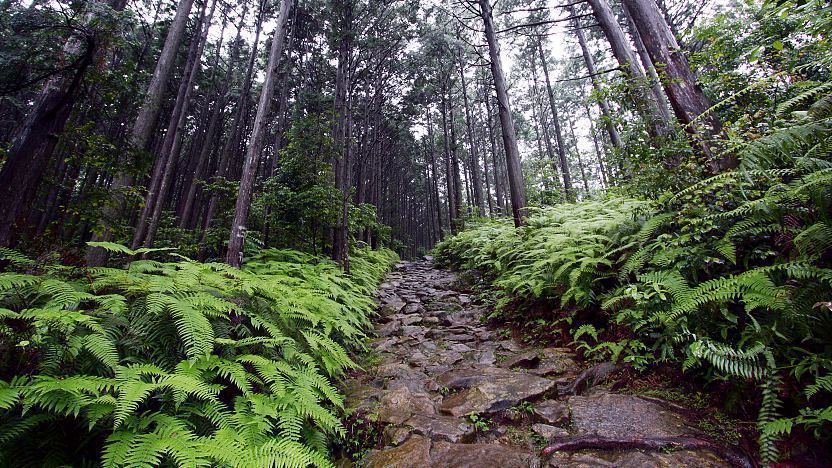
Kumano Kodo (�F��Ó�, Kumano Kodō) refers to a network of pilgrimage trails through the southern Kansai region. The Kodo ("old ways") are a key part of the region's World Heritage designation and have been in use for over 1000 years. They are the only pilgrimage routes besides the Camino de Santiago to be designated a World Heritage site.
The pilgrimage routes developed as a way for people to move between the sacred areas on the Kii Peninsula. At the center of this religious area are the three Kumano shrines: Hongu Taisha , Hayatama Taisha and Nachi Taisha , collectively known as Kumano Sanzan.
By the 12th century, the Kumano Sanzan were well known shrines in Japan, drawing pilgrims from Kyoto , Osaka and beyond. More than just a means to reach the three shrines, the pilgrimage trails were designed to be a religious experience in themselves and often pass through difficult, even dangerous, mountain terrain.
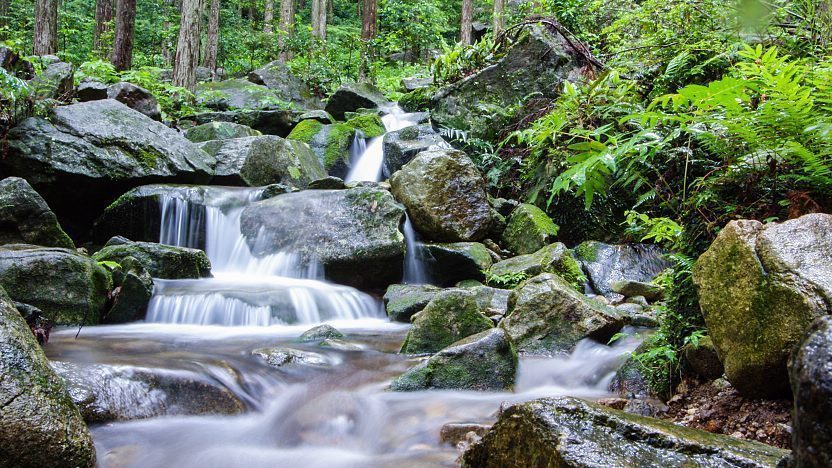
In addition to linking the shrines to one another, the Kodo pilgrimage trails link the Kumano area to Kyoto, Koyasan (the headquarter of Shingon Buddhism), Yoshino and Omine (centers of mountain worship) and Ise (Japan's most important shrine).
Today, most of the coastal trails have disappeared with development, but several mountain trails and passes remain. The trails are as follows:
Nakahechi is well preserved and relatively easy to walk, leading through hilly, forested landscapes and occasional villages. The section between Takijiri Oji (outside central Tanabe) and Hongu is about 30 kilometers, and can be done in a comfortable two days' walk with an overnight stop in Chikatsuya Oji, where there are a few minshuku . The trail ends with a descent into Hongu Taisha, offering a spectacular view of the shrine's massive torii gate.
Ohechi follows the coast from Tanabe to Nachi Taisha . This trail has virtually disappeared due to development and the construction of modern roads. At the height of its use between the 10th and 15th centuries, Ohechi, along with Nakahechi and Kohechi, is estimated to have seen the passage of over 30,000 people each year.
Iseji connects Kumano with Ise Shrine in Mie Prefecture. Like Ohechi, much of Iseji's coastal trail has been covered by paved roads and towns. Only short, isolated sections remain as stoned or earthen trails today. Among them, the Magose Pass in Owase City and Matsumoto Pass in Kumano City are some of the most picturesque.
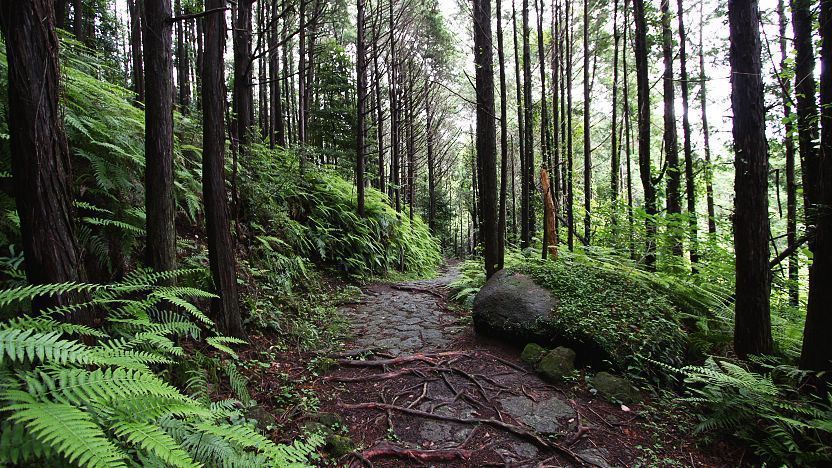
Kohechi connects Kumano with Koyasan . This mountaintop route is long and challenging, and consequently should not be undertaken without careful preparation. Inns are rarely found without zigzagging up and down the mountainsides into valley towns, greatly increasing the distance traveled. Kohechi was used mainly by Buddhist monks from the temple complex of Mount Koya .
Omine Okugake connects Kumano with Yoshino via Mount Omine. Like Kohechi, Omine Okugake is a long, difficult and dangerous route that follows high mountain ridges and barely passes any towns for much of its duration. This route was used primarily by followers of the Shugendo mountain worship sect.
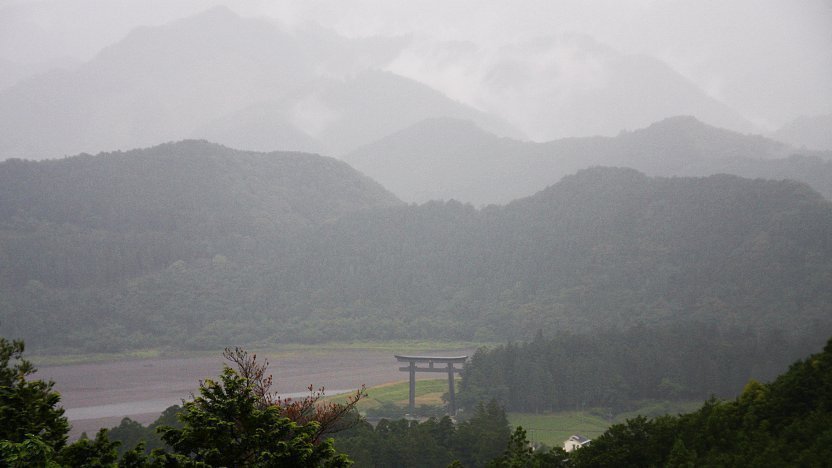
Getting there and around
How to get to and around Kumano
Questions? Ask in our forum .
Links and Resources
Tanabe city kumano tourism bureau, sacred sites and pilgrimage routes in the kii mountain range.

- Work With Us
- Blogging Bootcamp

- Van Conversion Academy
- Campervan Shop
- Campervan Rentals
- Plan a Trip
- Itineraries
- Destinations
- Responsible Travel
- Family Travel
- Budget Travel
- Scuba Diving
- Travel Credit Cards
- Digital Nomad
- Teach English Abroad
- Blogging Resources
- Income Reports
- Travel Shop
- Meet Katie & Ben
- About Two Wandering Soles
- Personal Stuff
- Portfolio & Press
Kumano Kodo Trail: How to Hike Japan’s Pilgrimage Route On Your Own
Home » Blog » Japan » Kumano Kodo Trail: How to Hike Japan’s Pilgrimage Route On Your Own
One of the best places to go hiking in Japan is on the Kumano Kodo Trail. Quite literally, off the beaten path, this destination is a historic pilgrimage trail that has been trekked for thousands of years. Hiking the Kumano Kodo was a highlight of our time in Japan, and this guide will show you how you can do it too!
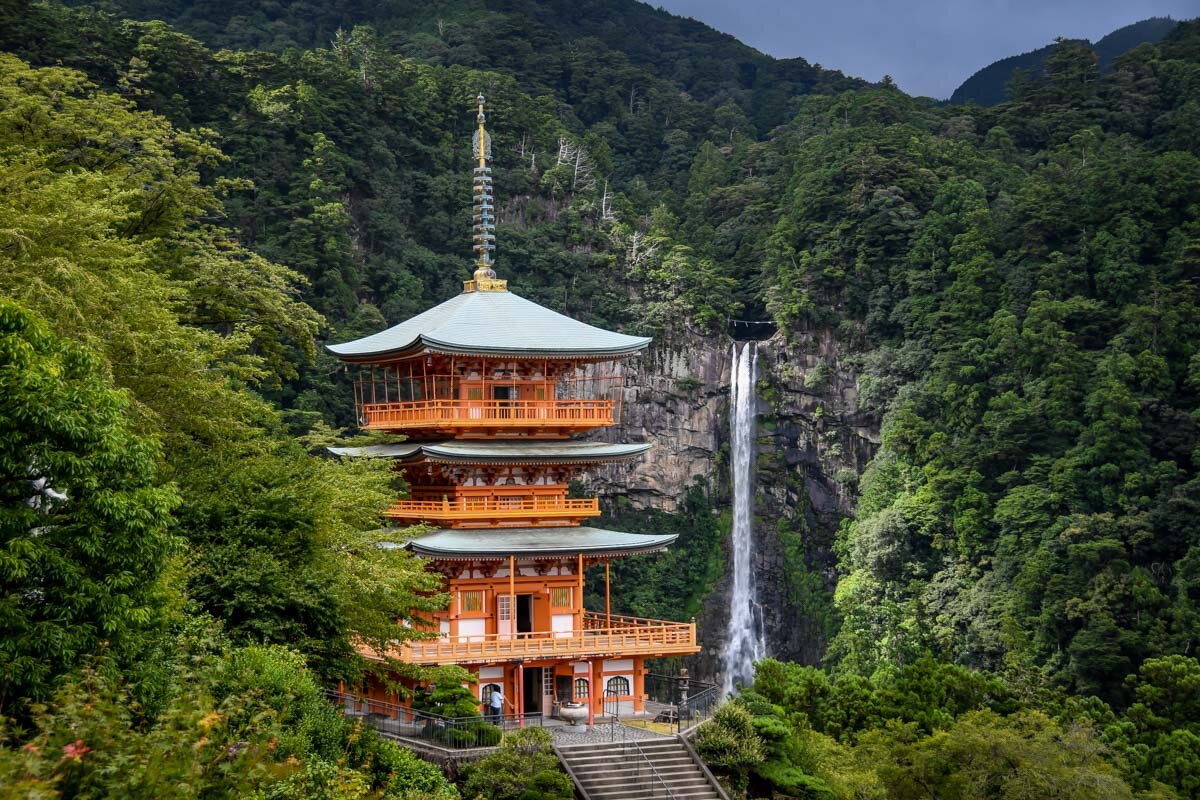
If you are looking to have an authentic and experience in Japan’s countryside and get, quite literally, off the beaten path , you’ll want to keep reading… We’re about to introduce you to the Kumano Kodo Trail, an adventure you’ll definitely want to pencil into your Japan itinerary .
First things first, you might be asking…
What exactly is the Kumano Kodo trail?
The Kumano Kodo is a pilgrimage trail through the mountainous Kii Peninsula, and brings hikers to small villages, past picturesque farmsteads, historic shrines, and through giant cedar forests. It is utterly enchanting and packed with plenty of photo ops as well as views that simply can’t be captured in pixels.
We think hiking the Kumano Kodo Trail is one of the most underrated things to do in Japan , and gives hikers a glimpse into local life and an opportunity to support the people and businesses in this under-visited region.
So if escaping the crowds and being surrounded by nature sounds dreamy, this article has everything you need to plan your Kumano Kodo hike. We’re going over the history of this iconic walk, where to stay along the way, what to pack, and what to expect along the way. And yes, we’ll tell just how difficult this hike in Japan is so you can plan and prepare accordingly.
Alright, let’s get into it!
Article Contents
Who is the kumano kodo trail for, what is the kumano kodo, what to expect hiking the kumano kodo, when is the best time to hike the kumano kodo, kumano kodo routes.
- 3-Day Kumano Kodo trekking itinerary
Highlights along the Kumano Kodo trail
How to book accommodation on the kumano kodo, food on the kumano kodo, what to pack for hiking the kumano kodo trail, travel tips for the kumano kodo, how much does it cost to hike the kumano kodo, how to get to the kumano kodo.
- Kumano Kodo FAQ’s
Come along on the trail with us and watch our Kumano Kodo video:

If you’re planning a trip to Japan, we have the ultimate resource for you!
This FREE PDF download includes everything you’re going to want to pack for your Japan trip, including what NOT to bring, plus tons of insider tips!
Sign up for our ultimate Japan packing list now and get a copy sent straight to your inbox.
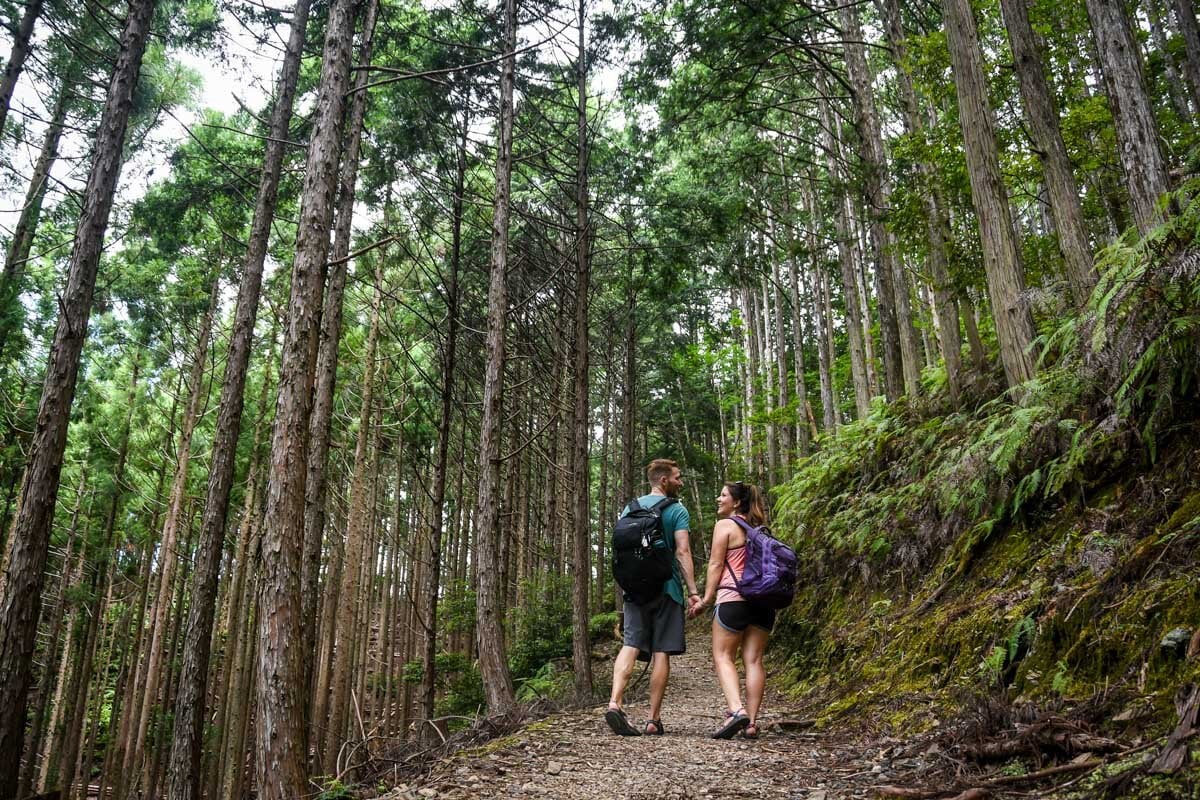
I can’t overstate how highly we would recommend adding this experience to your trip to Japan, but only if you answer “yes” to all of the statements below:
The Kumano Kodo Trail is for you if…
- You want an authentic experience in the Japanese countryside
- You love being in nature
- You like hiking (and don’t mind a few steep stretches)
- You want to escape the crowds
- You want to have a unique experience in Japan that most tourists miss
- You have a sense of adventure
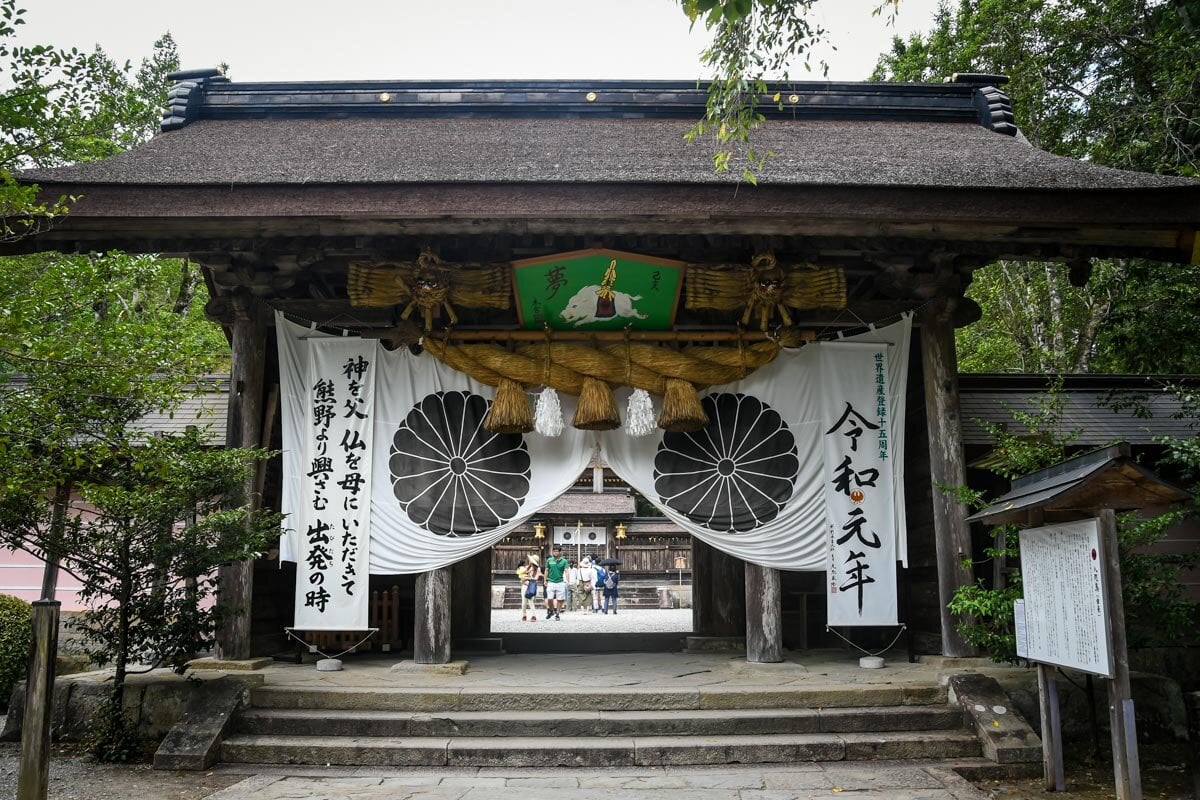
Let’s begin with a brief history lesson…
Located nearly 100 kilometers (62 miles) south of Osaka on Japan’s Kii Peninsula, the Kumano Kodo is a network of pilgrimage routes that have been in use for more than 1,000 years.
Those who hike the Kumano Kodo will follow in the footsteps of ancient emperors and samurai who made this journey in centuries past. These routes were sacred and held great spiritual meaning since they connected the three famed Kumano shrines:
- Kumano Hongu Taisha
- Kumano Hayatama Taisha
- Kumano Nachi Taisha
In 2004, the Kumano Kodo was named a UNESCO World Heritage Site , and it is one of only two pilgrimage paths to receive this coveted title (the other being Spain’s Camino de Santiago).
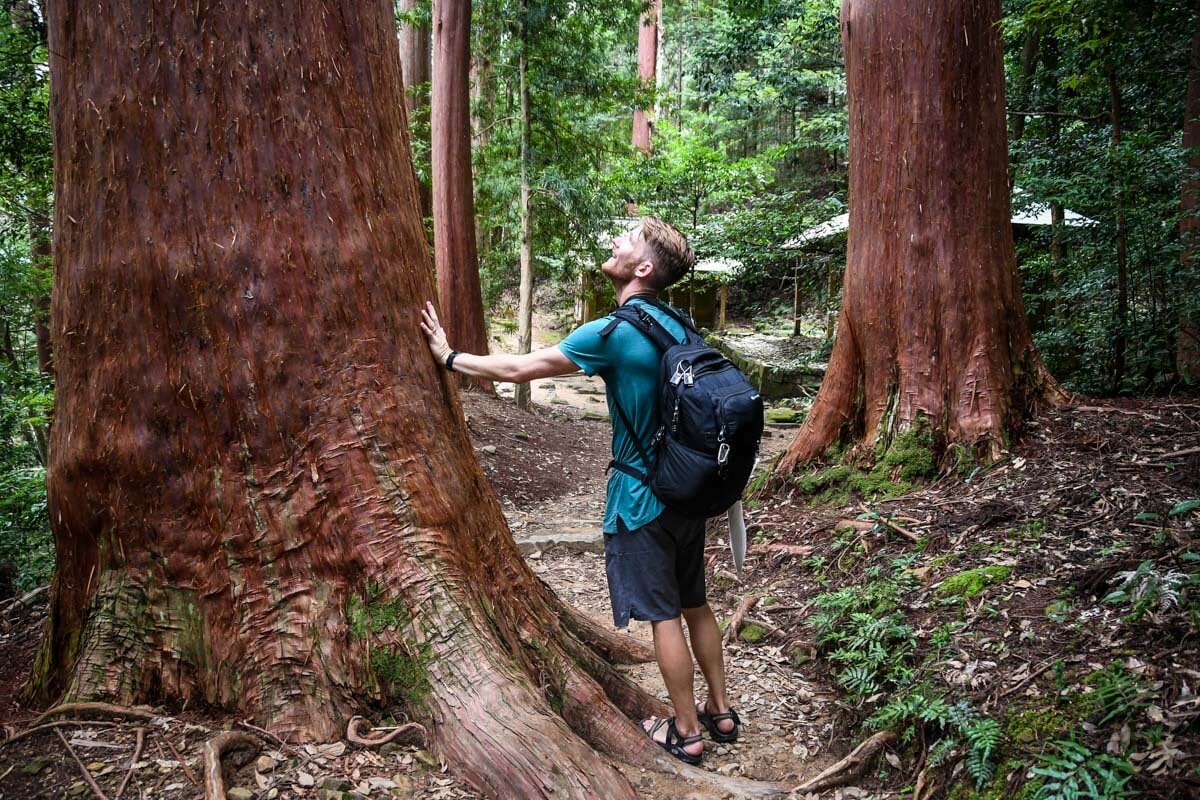
Today, the Kii Peninsula is connected by Japan Rail lines. Most routes start from Kii-Tanabe Station, so if you have the JR Pass you can travel to the peninsula for free! Saving you over $100 USD for a round trip from Osaka. The only transportation you’ll have to pay for after that are the buses into the mountains.
Learn how to purchase the JR Pass which gives you unlimited access to Japan’s bullet trains for 7, 14, or 21 days!
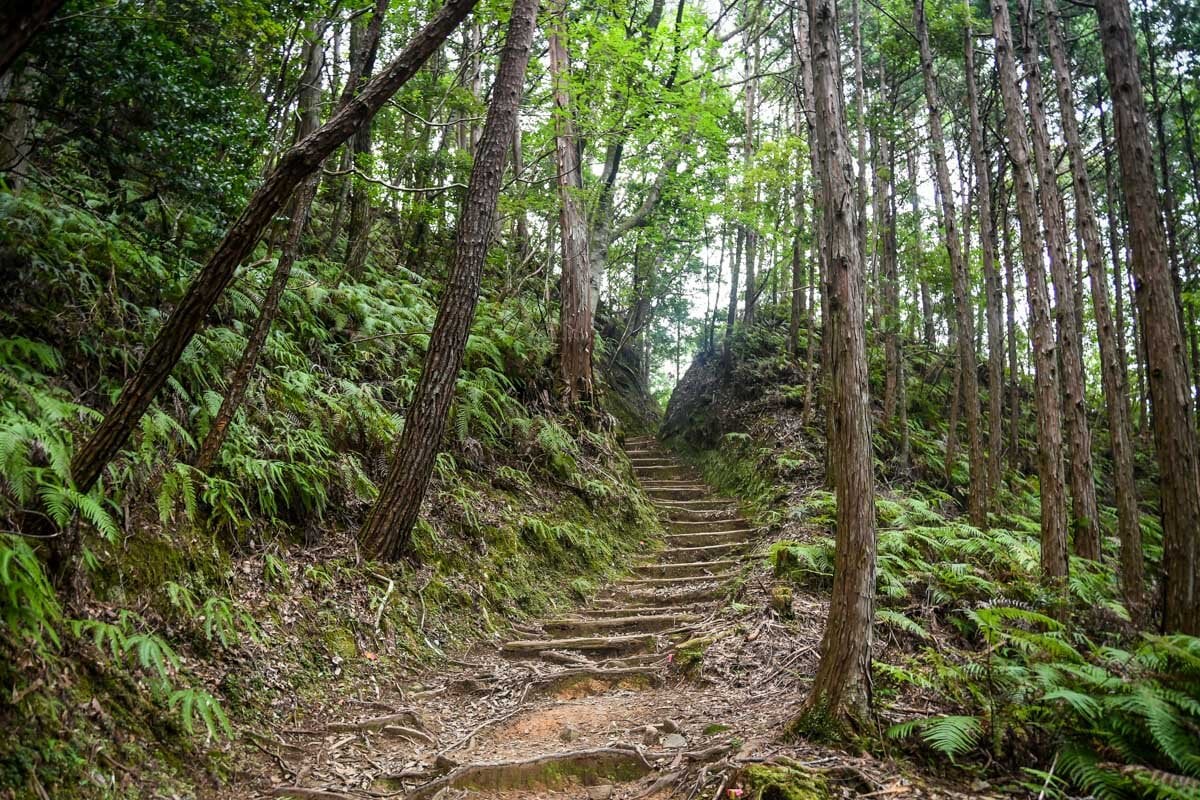
After returning from our 3-week trip to Japan, we were reflecting on our favorite experiences, and we both wholeheartedly agreed that hiking the Kumano Kodo was the most unique and memorable thing we did (and we did a lot!).
So what should you expect exactly?
The paths on the Kumano Kodo are well-maintained and is clearly marked with signs in Japanese and English. Every half kilometer, there are trail markers signaling where you are on the trail. (They even let you know when you’re veering off the right path, with “NOT Kumano Kodo” in bold letters!). You can use these trail markers along with the maps to show where you are on the route.
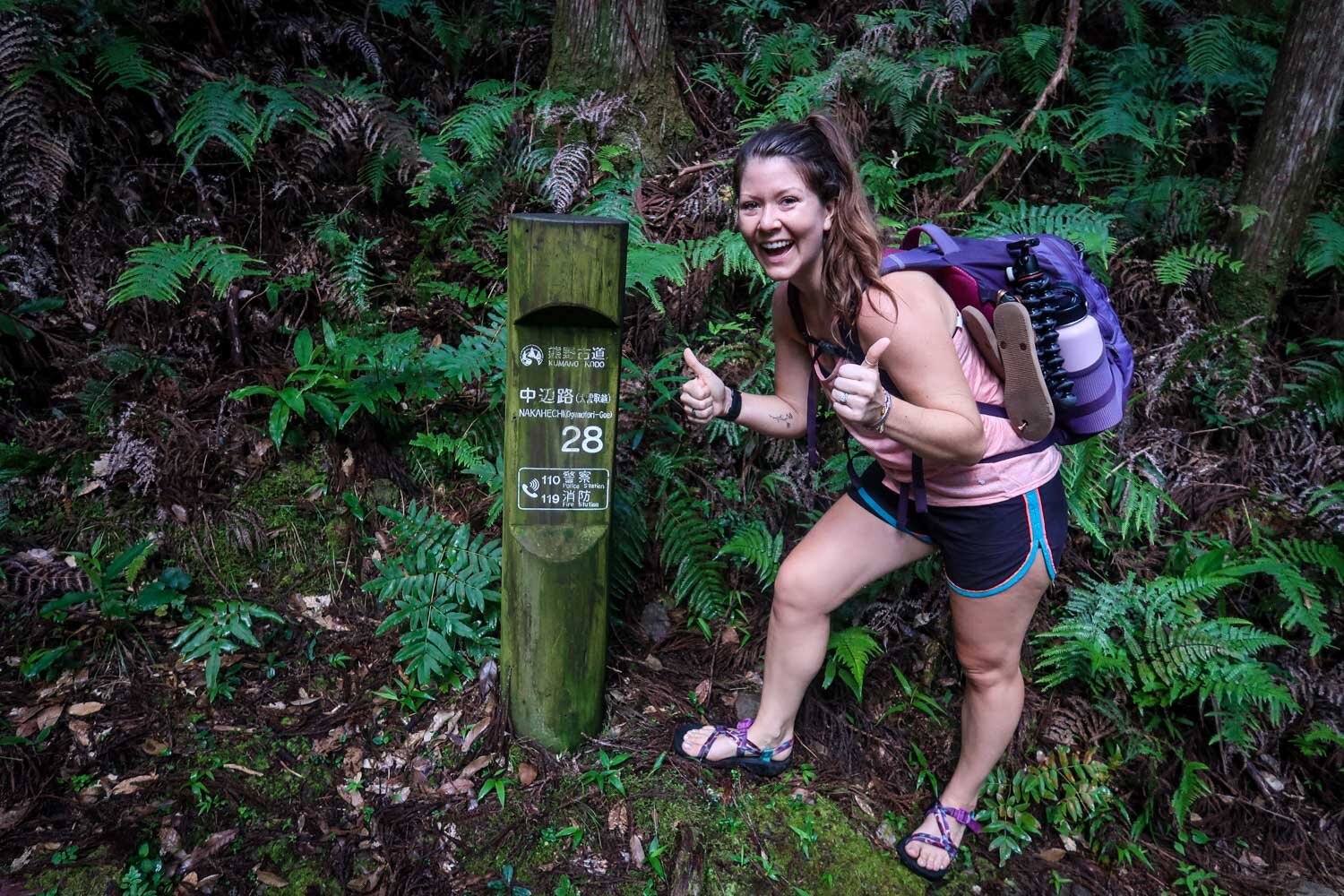
These trails weave their way through this mountainous region and take hikers through forests of towering cedar trees, and past oji , or small shrines, meant to protect pilgrims.
You’ll walk past farmsteads and small villages that appear not to have changed in decades. Stand at lookout vistas and see wispy clouds hanging low in the valley over a sea of trees that seem to expand to the horizon.
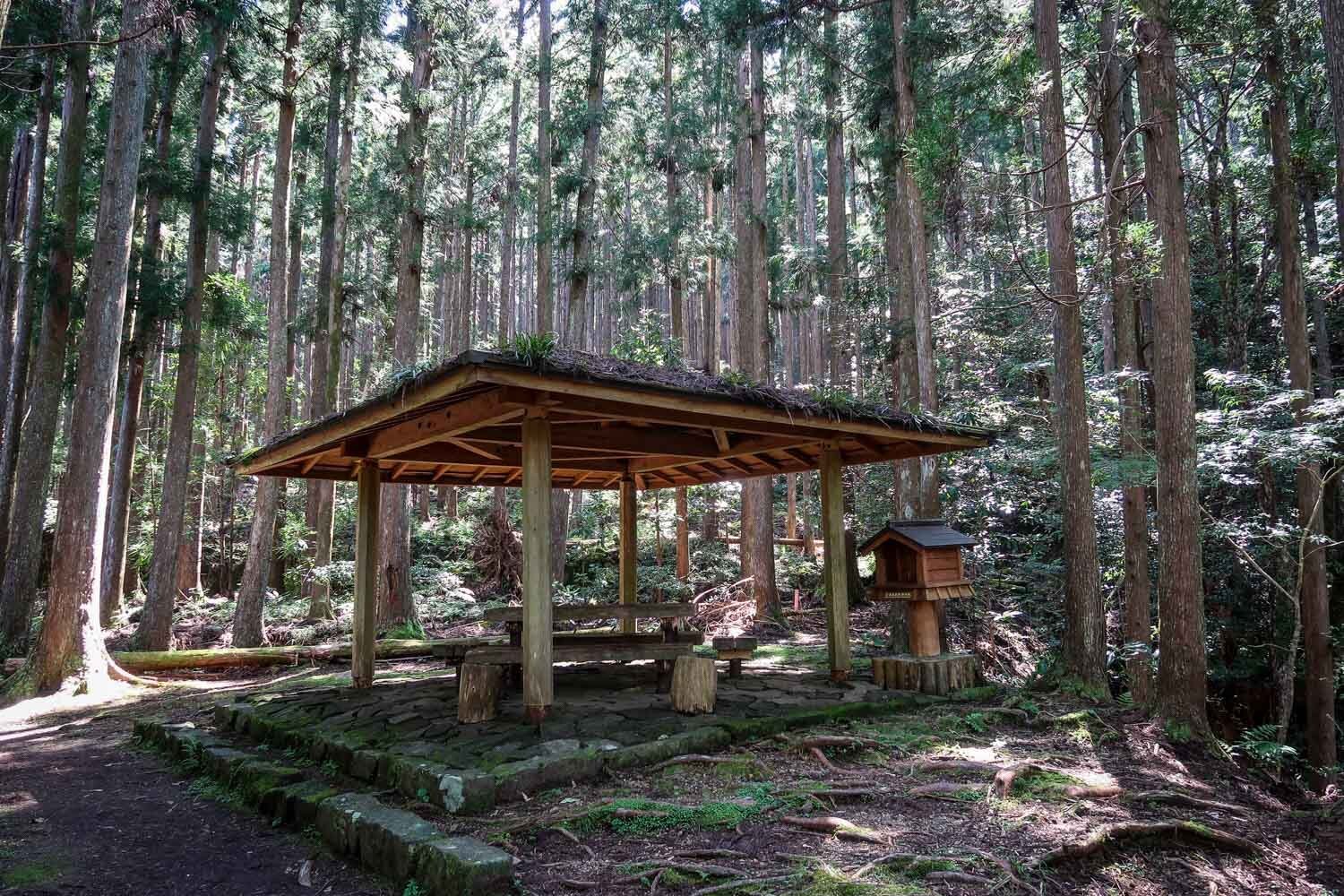
Along the trail, there are signs demarking historical spots, like where inns used to sit as refuge for weary pilgrims. There are small shelters every so often that you can take a rest and have lunch.
Stay at small family-operated inns, eat meals that have been prepared with local ingredients, and soak in hot springs that are common in this region. Visit shrines that have seen thousands of years of travelers hiking passed them.
Psst! Check out our list of the most beautiful places in Japan you’ll have to see to believe!
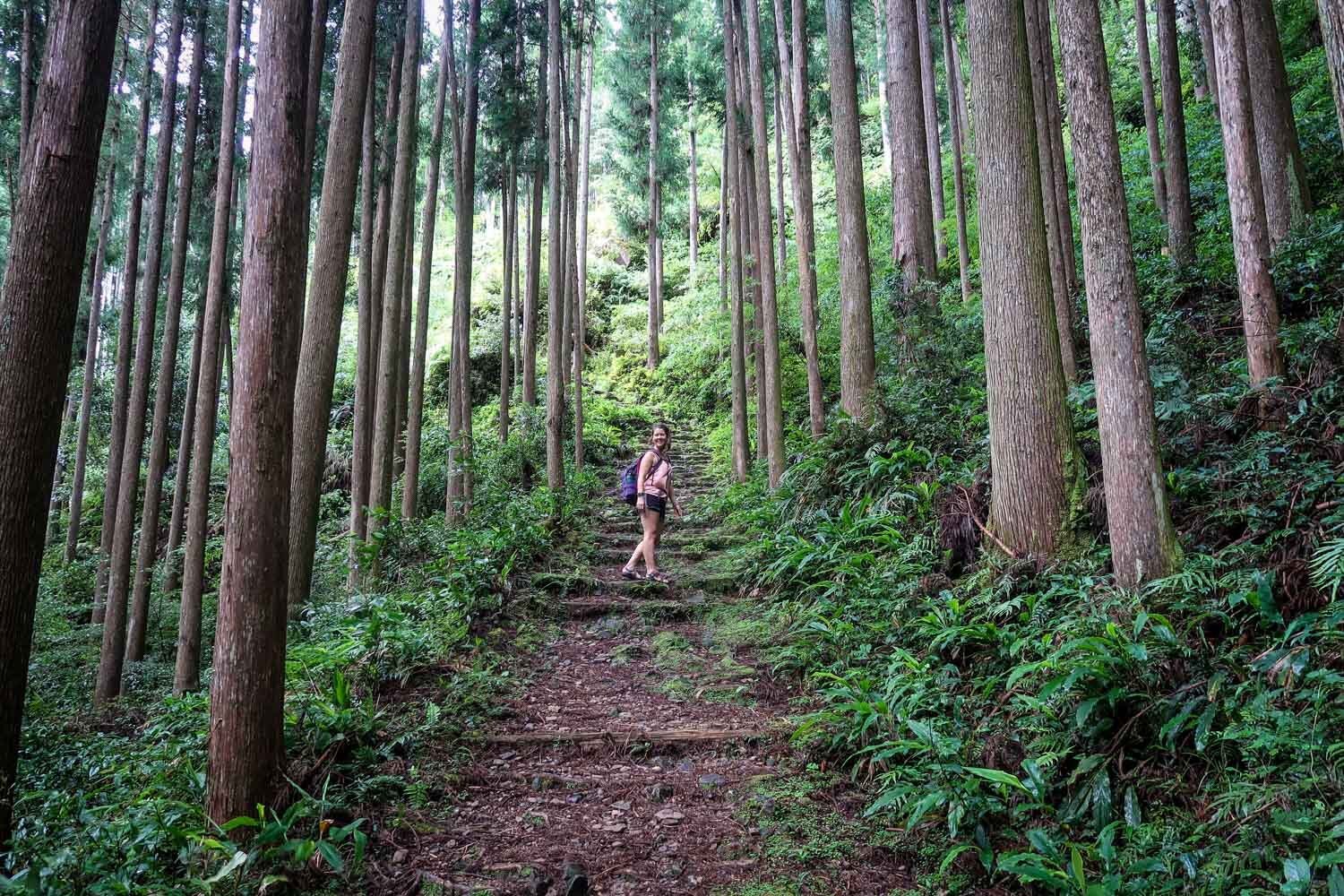
The good news is that the Kumano Kodo can be hiked all year round.
Wakayama prefecture on Japan’s Kii Peninsula sits pretty far south, meaning the weather in this region tends to be quite mild. To give you a point of reference, Wakayama prefecture is south of Osaka.
Psst! Be sure to read up on all the fun things to do in Osaka because you’ll likely be in this city before or after your hike and will want ideas of ways to unwind (or if you’re like us, you’ll want to know exactly where and what to eat!)
Spring and fall are going to offer the most comfortable temperatures as well as beautiful blossoms and fall foliage. That said, these are the most popular times of the year to make the hike, so you’ll encounter more people along the trail.
- Spring: Cherry blossoms and comfortable temperatures make springtime a lovely (and popular!) time to make this hike!
- Summer: The summer months can get very hot and humid, meaning the hike can be uncomfortable at times. Rain is also highly likely, at least for part of your trek, so be prepared. The good thing is that it will be very green at this time!
- Fall: Comfortable temperatures and stunning fall foliage make this a very nice time to hike, and for this reason, it is a popular season on the Kumano Kodo.
- Winter: While temperatures can get cold and snow is possible, the Kii Mountains tend to be more temperate than other mountain ranges in Japan. There will be fewer people hiking in Japan in the winter than at other times of the year.
No matter what time of year you plan to hike, be prepared for rain, as the weather in the mountains can change quickly and can be quite different from the weather in surrounding cities.
Our advice is to read up on the best time of year to travel to Japan and decide what season sounds best to you based on your preferences.
Good to know: August and September are peak typhoon months, and transportation may be affected in the case of inclement weather. Also, portions of the trail may be affected by landslides caused by heavy rains. Be sure to get trail updates from the information centers before you head out.
Our opinion: We hiked the Kumano Kodo in August, and we experienced high humidity and a bit of rain (see our full experience with the weather below). That said, we hardly encountered other hikers, and we were prepared for the not-so-wonderful hiking weather, so we had a good time. We kept saying that if we were to do it again (and we really want to!), we’d choose to hike in the fall.
Our experience with the weather on the Kumano Kodo
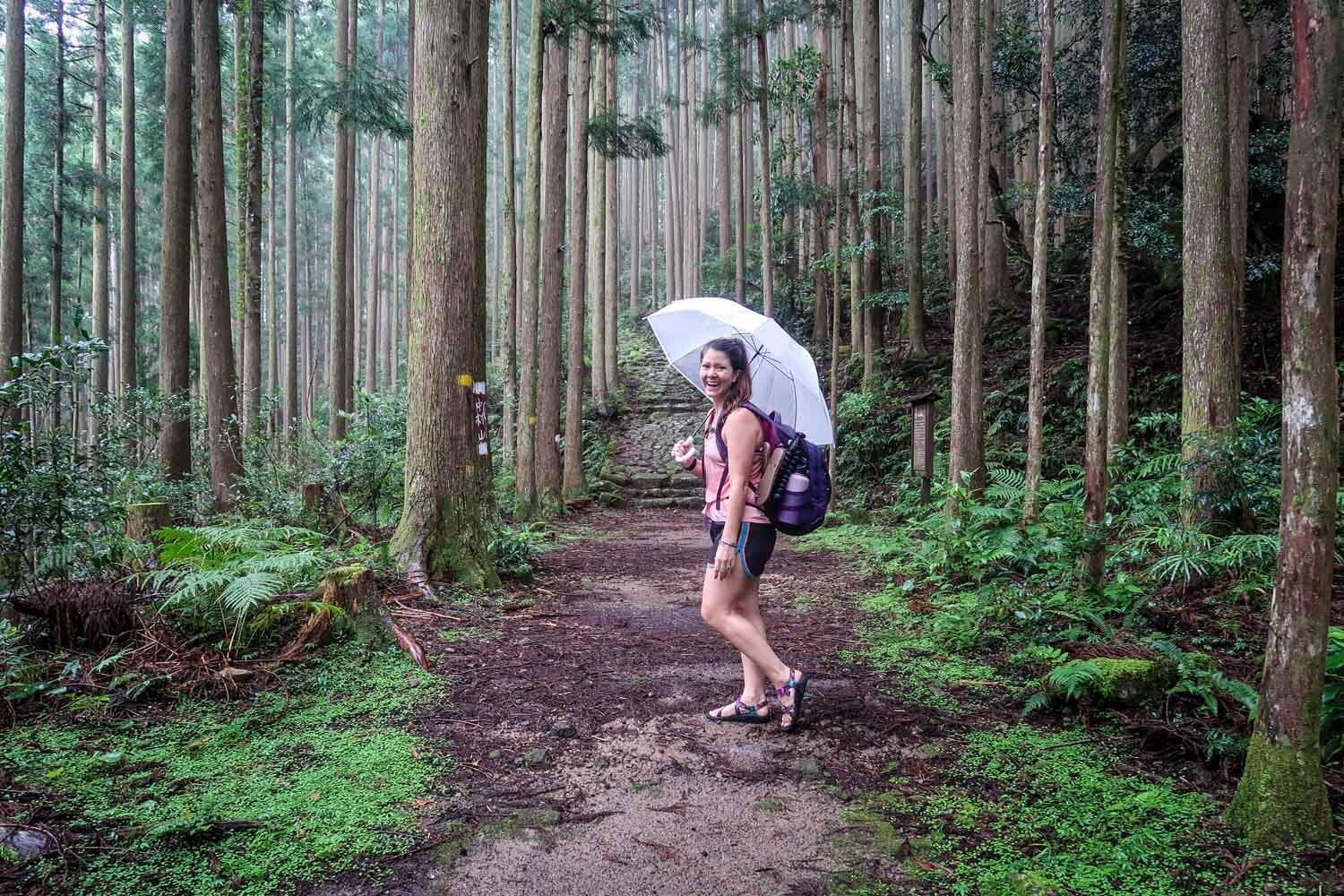
We hiked the Kumano Kodo during the month of August, and we experienced the heat and humidity we had read about online.
We were pretty nervous about the weather and even considered not doing the hike at all. However, we still had a great – no, incredible – time. We were prepared for the heat and humidity, and actually it wasn’t quite as bad as we were expecting. The mountain air, while still muggy, felt considerably fresher than the stifling August heat in Osaka.
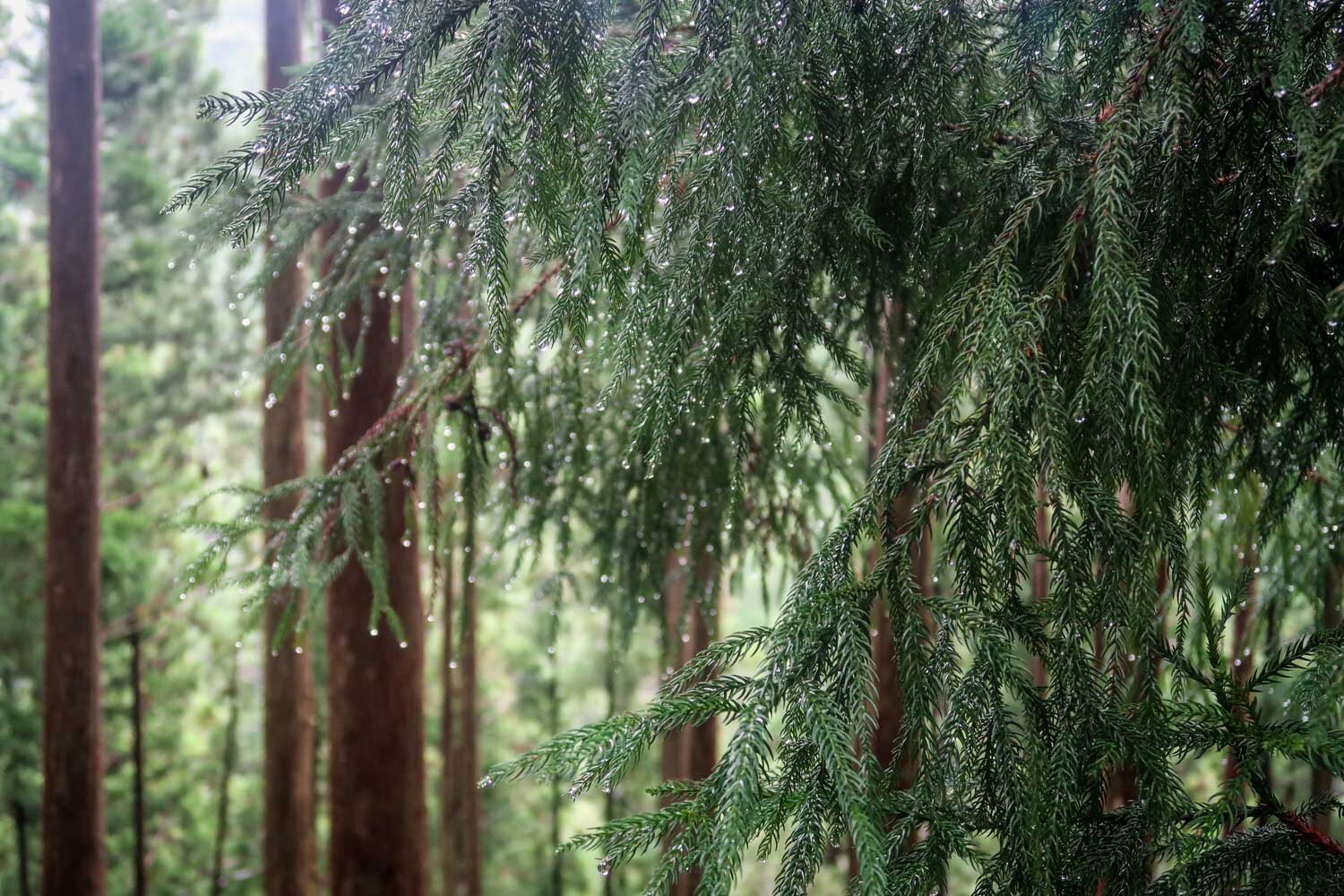
We also had quite a bit of rain – on and off for one day, and very heavy rain on another day. But in between, we also had beautiful, clear skies, so it was a bit of a mixed bag. We had a dry bag to keep our electronics in, raincoats to keep ourselves dry, and , so we didn’t mind the rain all that much. It actually cooled us down, and thankfully stopped at most of the scenic places we visited.
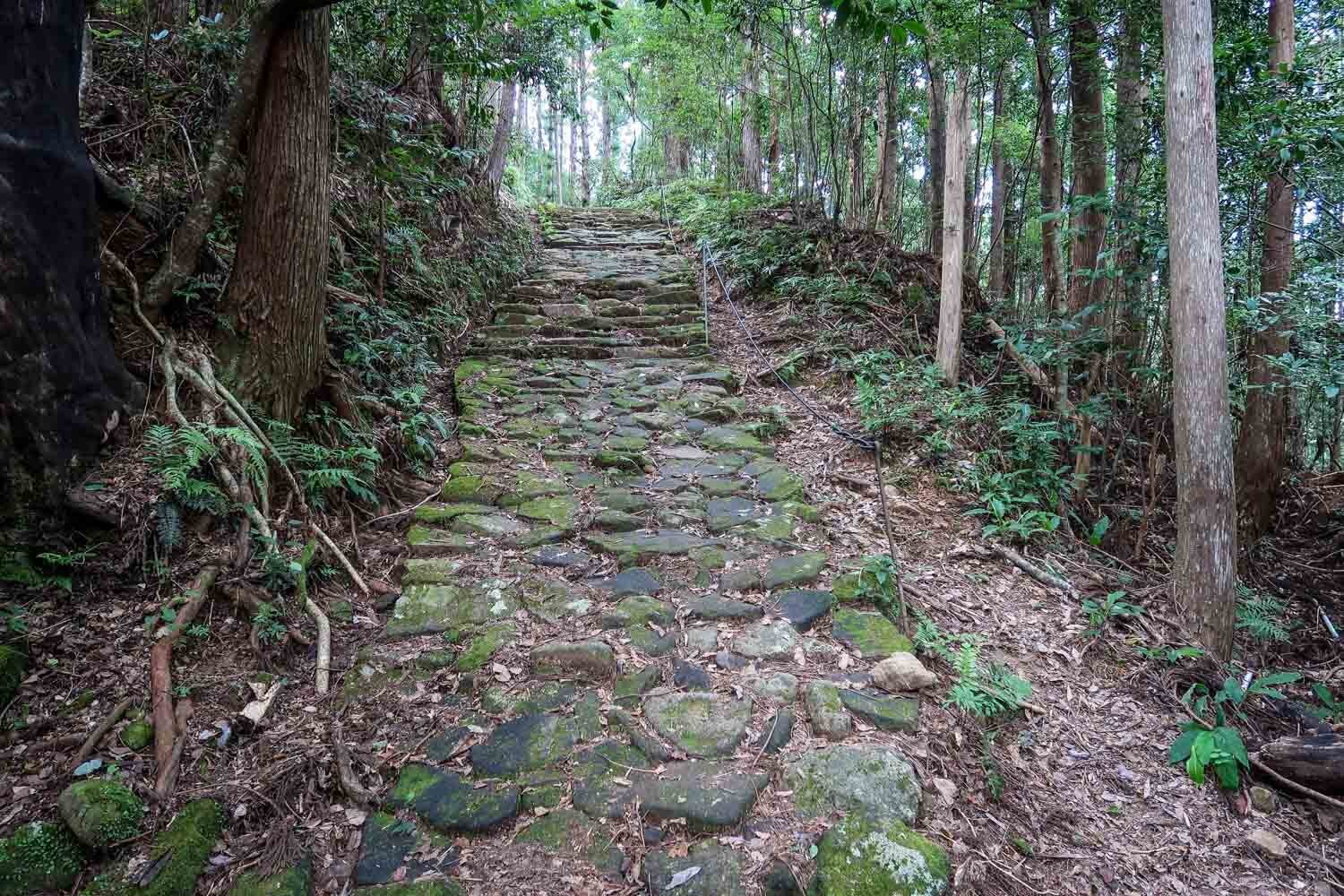
The Kumano Kodo is a network of trails, so most people will choose just one route. Additionally, it’s easy to do just a section of the trail, enabling many hikers (ourselves included) to do just a portion of the trail in order to fit it into their Japan trip.
The thing is, it’s difficult to really say how long the Kumano Kodo is since people do all different routes and itineraries. Plus, there are some sections where hikers will need to take a bus, so the measured distance is a bit different from how far you’ll actually walk.
Nakahechi Route: The Imperial Route
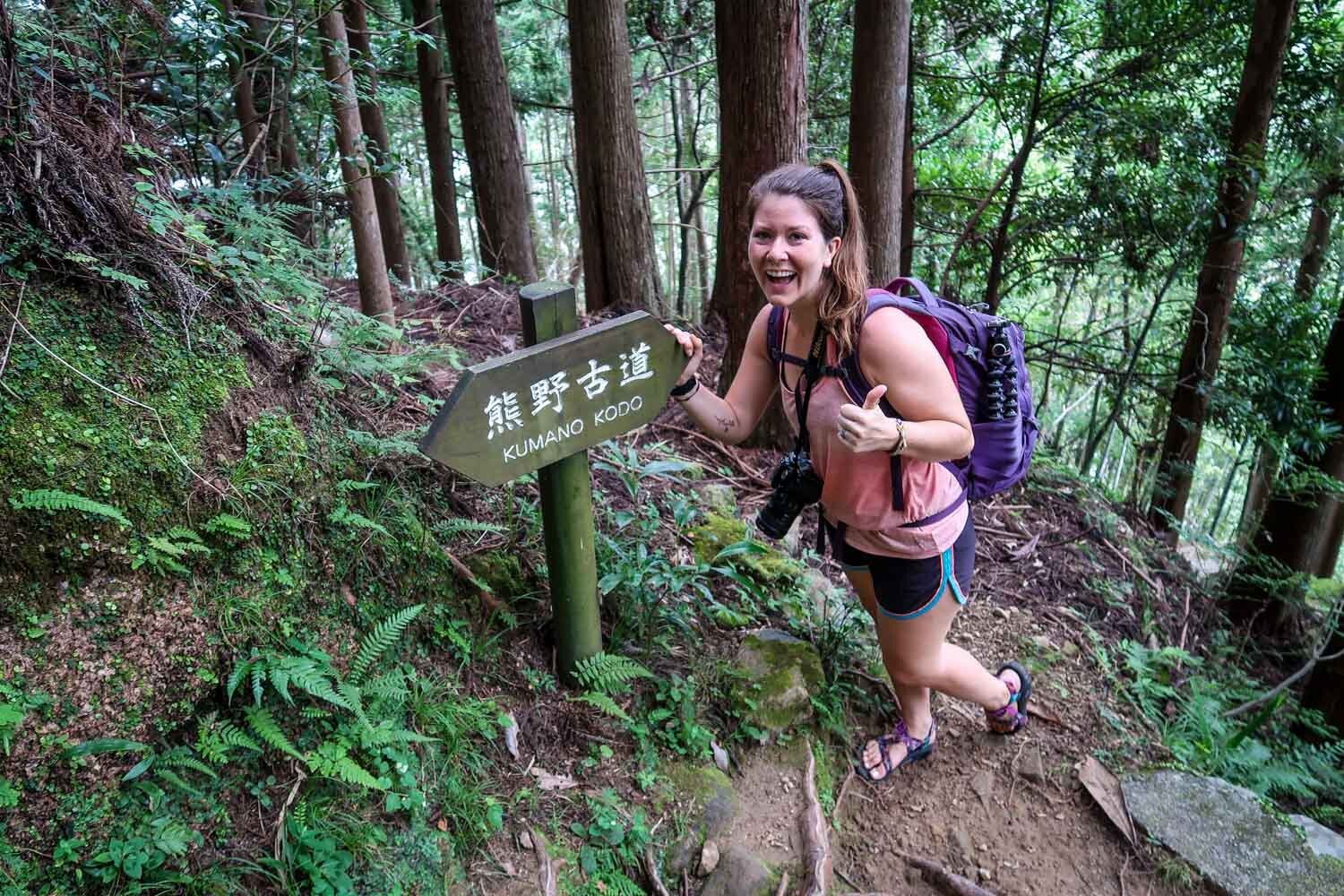
- Distance: 65 km (40 miles)
- Difficulty: Moderate
- Starting Point: Takijiri-oji
- End Point: Nachi Taisha
- Avg. Duration: 4-5 days
- Outline of the route
The most popular route, Nakahechi (known as the Imperial Route), spans across the peninsula’s width, and tallies in at just over 65 kilometers (40 miles). It takes most people between 4 – 5 days to complete.
Even within the Nakahechi Route, there are a few variations you can take.
The “main route” takes travelers from Takijiji-oji in the west to Hongu (38.5 km or 55 miles) in the center of Kii Peninsula. Variations include a short detour through Yunomine Onsen, and continuing on past Hongu to Nachi Taisha (one of the Three Grand Shrines of Kumano) in the east. (See the outline of the route above for variations.)
Nakahechi is the most popular route in Kumano Kodo and for good reason. We hiked a 2-day portion of this route from Yunomine Onsen to Nachi.
Kohechi Route: The Mountainous Route
- Difficulty: Advanced
- Starting Point: Koyasan
- End Point: Hongu Taisha
- Avg. Duration: 4 days
Starting from Koyasan in the north and connecting down to Hongu in the center of the Kii Peninsula, the Kohechi Route is 65 km (40 miles) in length. This is considered the hardest of all the routes because you trek over 4 mountain passes, all over 1000m (3,281 ft) in elevation.
This route typically takes 4 days to complete and should not be undertaken by anyone without proper preparation and in peak health.
Ohechi Route: The Coastal Route
- Distance: 37 km (23 miles)
- Starting Point: Kii-Tonda
- End Point: Mirozu
- Avg. Duration: 3 days
Perhaps the most unique route of the Kumano Kodo, Ohechi takes you along the southern coast of the Kii Peninsula with nice views of the Pacific Ocean.
Historically, the coastal route was much longer, connecting the seaside town of Tanabe with Nachi Taisha. However, the modern recommended route begins at Kii-Tonda and ends at Mirozu Station. This is because a large section of the route from Mirozu to Nachi has been paved over with modern highways.
Hiking the entire modern route takes 3 days, but you can do sections of this trail as day hikes. This is also the least popular of the Kumano Kodo routes, so you may get lucky and have the trail all to yourself.
Iseji Route: The Eastern Route to Kumano
- Distance: 182+ km (115+ miles)
- Starting Point: Ise Jingu Naiku
- End Point: Hongu or Nachi
- Avg. Duration: 2 weeks
Pilgrims visiting the Ise-jingu Shrine would trek down to the Kumano trails via over 180 km (115 miles) of sea sidewalks, bamboo forests, and mountain passes. Much of the route is actually paved with stone, making it one of the more unique trails in the Kumano Kodo.
This route can be further divided in 3 sections: North, Central and South. The southern section of the route splits at Hana-no-Iwaya, and takes you either west to Hongu or south to Nachi.
The entire eastern route is doable, but would take around 2 weeks complete. Most trekkers tackle shorter sections of the route in day trips or overnight hikes for 2-5 days.
3-Day Kumano Kodo Trekking Itinerary
Kumano Travel has extremely detailed itineraries detailing out variations of mostly the Nakahechi Route. If you are considering doing a Kumano Kodo trek, we highly recommend researching further on this site.
(Note: we have no affiliation with Kumano Travel. They are just an awesome resource where you can book your accommodation and guide if you want one.)
In order to fit our travel time frame, we altered this 4-day/3-night itinerary from Kumano Travel. This is the 3-day itinerary we trekked on the Nakahechi Route of the Kumano Kodo trail:
Day 1: Transportation Day – Osaka to Yunomine Onsen
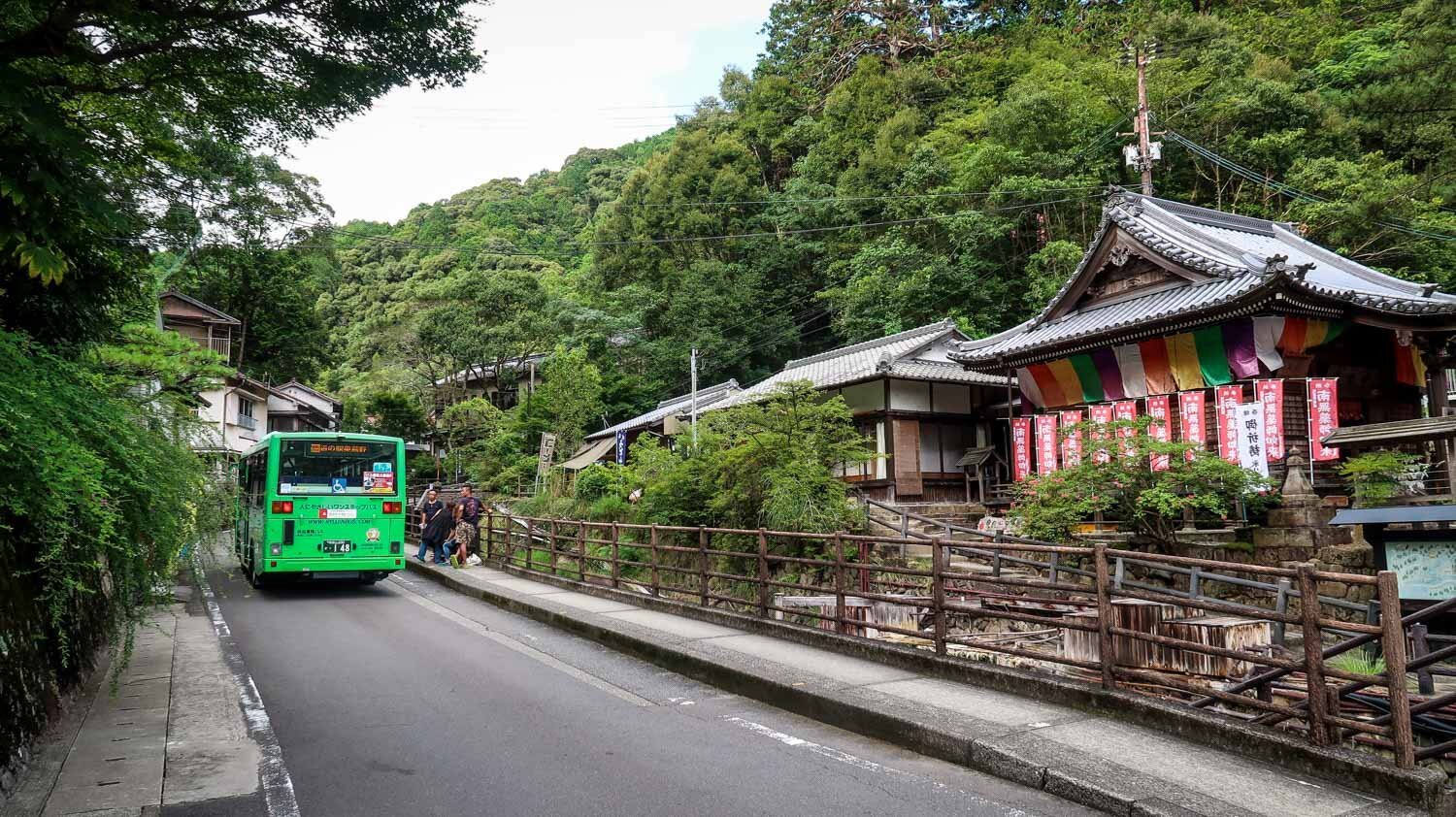
- 8:00 Wake up in Osaka
- 9:01 Leave Shin-Osaka Station toward Tennoji Station
- Note: We recommend getting the Japan Rail Pass when traveling to Kumano Kodo. The trip there and back from Osaka basically makes up over half of the 7-day pass. When you have the JR Pass, you can travel freely on any JR line including the Shinkansen Bullet Trains.
- Visit the Tanabe Tourist Information Center right next to the station to pick up maps and other information. Have lunch near the station, or grab something to go.
- How to Ride the Bus: Enter from the back of the bus and take a small ticket from the machine by the door. It will have a number on it corresponding with the stop number. There is a monitor (in English and Japanese) displaying the stops. Push the Stop button on the wall when you see Yunomine Onsen. As you exit out the front of the bus, pay the driver in cash in the bus fare machine.
- 14:37 Arrive in Yunomine Onsen. Check into your guesthouse. We stayed at J-Hoppers Guesthouse and recommend it!
- Reserve a half-hour spot in 1000-year old Tsubo-yu, the UNESCO World Heritage hot spring in the center of town.
- Soak in your own private onsen at J-Hoppers.
- Boil eggs for morning or get snacks at the convenience store.
- Cook dinner at your guesthouse and socialize with other hikers.
Day 2: Hongu Taisha to Kogumotori-goe Trail to Koguchi
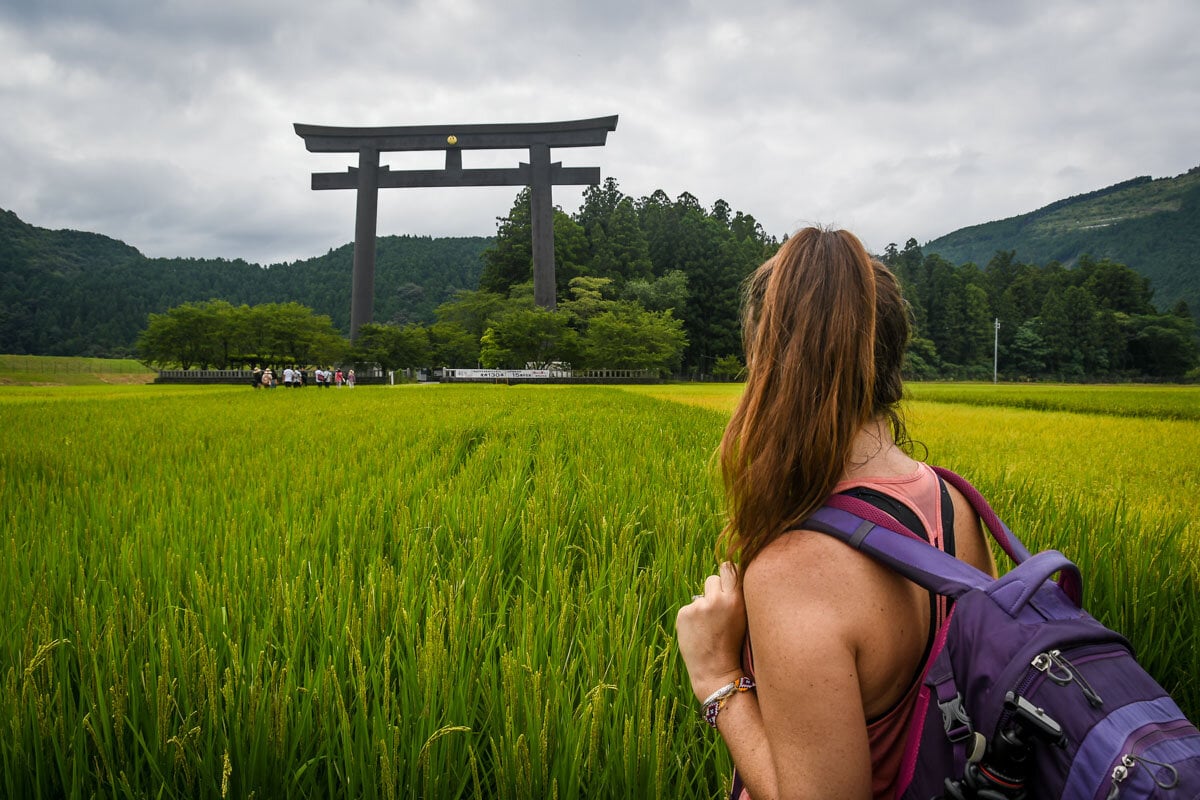
- 8:00 Wake up in Yunomine Onsen
- 9:00 Start hike to Hongu
- Explore Oyunahara and Hongu Taisha Shrine.
- Pick up lunch in town at the bakery.
- Tell the bus driver you want to get off at Ukegawa.
- 12:30 Lunch on the side of the trail. Pack out your trash.
- Be sure to stop at Hyakken-gura viewpoint
- 16:00 Reach Kowaze-Bashi bridge and follow signs toward Koguchi
- 16:30 Arrive in Koguchi and time for a swim in the river!
- 18:00 Have a delicious dinner at your guesthouse.
Day 3: Koguchi to Nachi Falls (option to Katsuura)
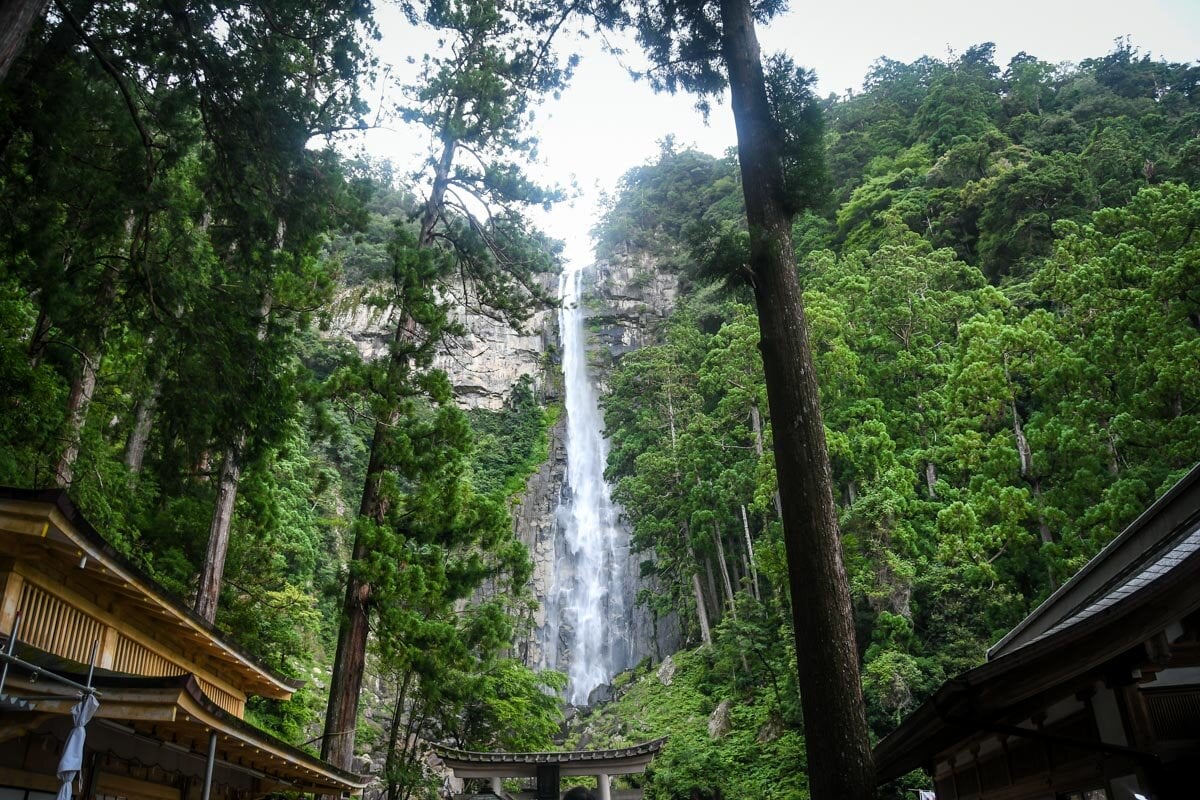
- 7:00 Wake up in Koguchi
- 7:30 Breakfast at guesthouse
- Note: During summer months, there was a water spigot at trail marker #26
- 9:45~10:00 Approach the base of Echien Pass. Prepare for the “bone-breaking slope”
- 10:30 Reach top of Echien Pass
- 11:45 Jizo-jaya Teahouse Remains (nice shelter for lunch)
- Note: Best view of three-tiered pagoda and waterfall: As you reach the end the stairs coming off the trail, turn left and walk toward the three-tiered pagoda. There is a staircase going down next to the parking lot. From the top of the staircase, look down, and you can see the best view platform which is right next to what looks like a hotel. Walk down the stairs, turn right and up the ramp next to it and you’ll be there. In total is about 3-5 minutes from the end of the trail.
- 16:00 Walk to Nachi Falls. It’s free to walk all the way up to the falls, but it costs 300 yen to get a closer look on the viewing platform. The view from the bottom was pretty good so we didn’t feel the need to visit the platform.
- 17:10 Take the bus to your guesthouse or down to Katsuura (25 minutes from Nachi) if the guesthouses around Nachi are full, as they were for us. We stay in Katsuura at Why Kumano hostel.
Optional Day 4: Transportation Day – Katsuura back to Osaka
- 7:00 Every morning in Katsuura (except Tuesday and Sundays) there is a tuna auction from 7-8 am down at the docks. It looks like the famous Toyosu Fish Market in Tokyo , but a much smaller scale.
- 8:00 Breakfast at Fish Market
- 8:53 Depart Kii-Katsuura to Osaka on a bullet train using your JR Pass
While some of our favorite parts of the trail were unmarked stretches where we were entirely alone and surrounded by towering cedars, there are several points of interest along the Nakahechi Route that are worth visiting.
Takijiri-oji
This is the beginning town on the Nakahechi Route of the Kumano Kodo trail. Here you can visit the Kumano Kodo Kan Pilgrimage Center and one of the five major Oji shrines.
If you are hiking the full Nakahechi route, this small settlement would be your first. Known as the “Village in the Mist” as the rolling fog is common and quite a sight form the vistas above.
Tsugizakura-oji
Visit this small shrine surrounded by massive 800-year old cedar trees. All of their branches point south toward Nachi Falls.
Yunomine Onsen
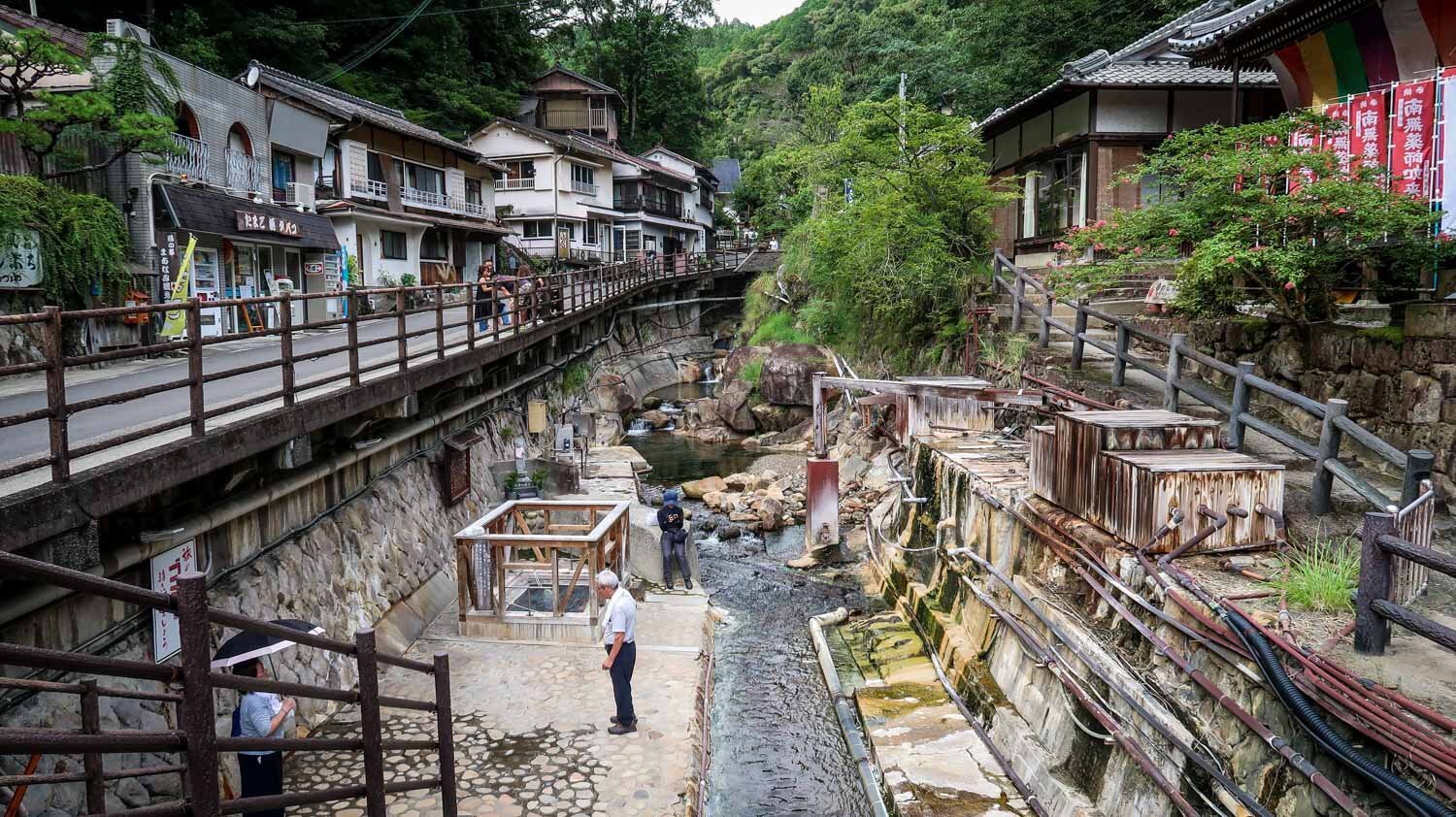
We recommend spending a night in this quaint mountain village, recognized as one of Japan’s oldest onsen towns. The town is home to Tsuboyu, one of the only UNESCO World Heritage hot springs in the world. You can purchase a bag of raw eggs from the convenience store next to the river and hard boil them in the hot spring. It makes a nice snack for the next day’s hike.
We stayed here our first night after taking the bus from Kii-Tanabe. We highly recommend J-Hoppers Kumano Yunomine Guesthouse because they have private onsens you can relax in and they offer free rice at night to go with your meal.
If you get to J-Hoppers early enough in the day, you can rent a hybrid bike for 1500 yen and pedal 20-30 minutes to a public onsen pool called Kawayu Onsen. Visitors must wear swimsuits.
Hongu Village
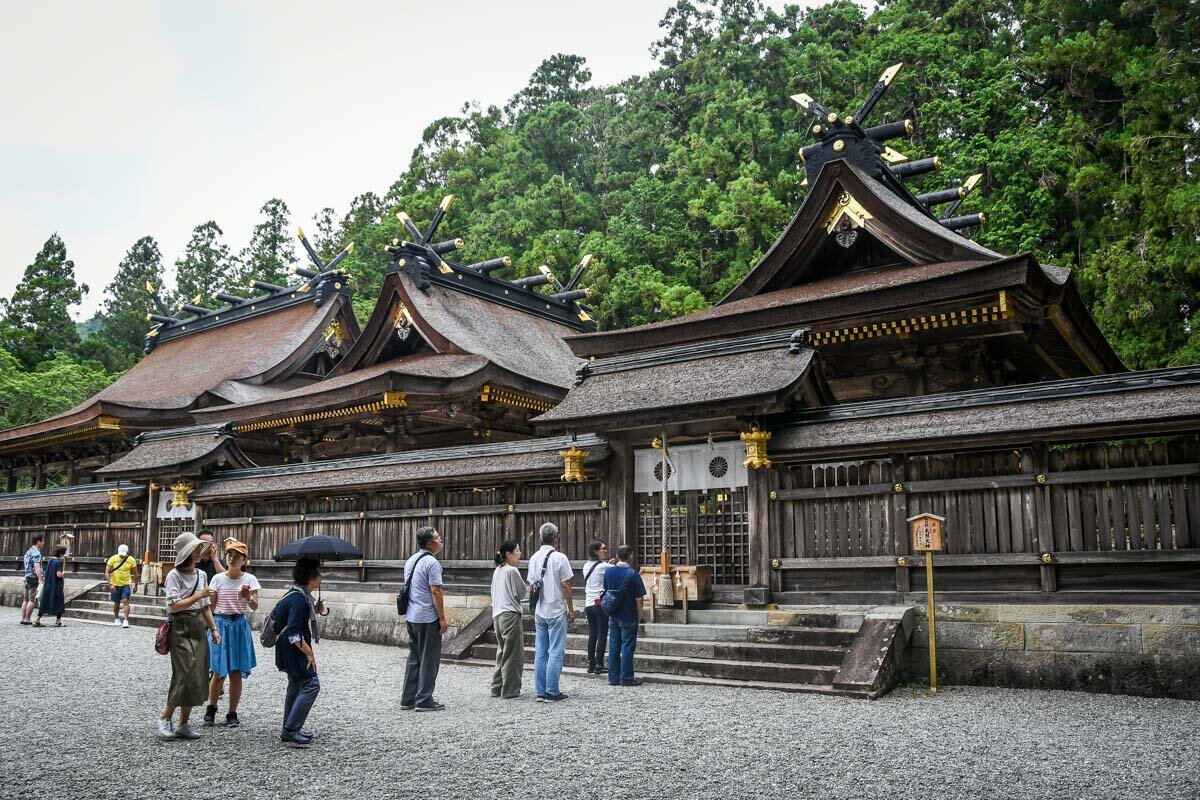
A steep 1-hour hike from Yunomine Onsen will bring you to Hongu. Visit Hongu Taisha, one of the three grand shrines. In Hongu, you can grab snacks for the day and visit the Kumano Kodo visitor center for any trail updates.
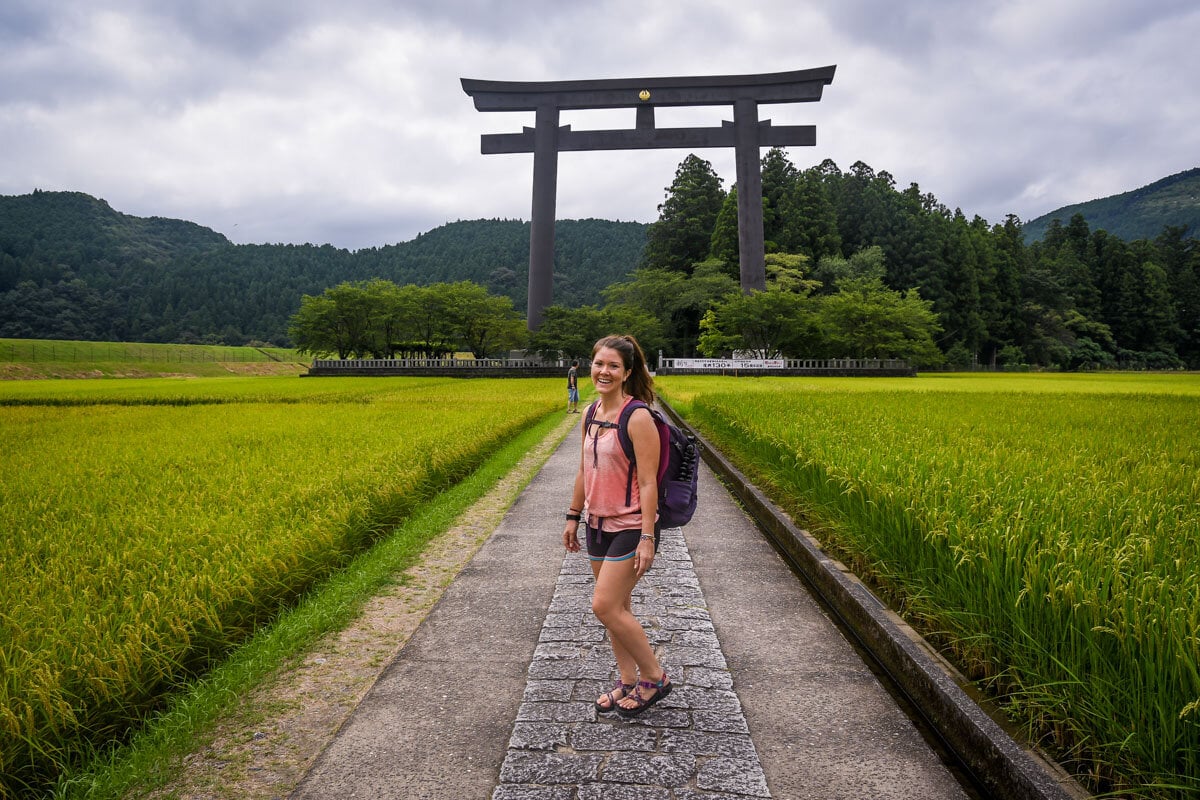
The Hongu Taisha Shrine once stood at the banks of the confluence of the Kumano and Otonashi Rivers, until a severe flood destroyed most of the structures in 1889. That’s when the shrine was moved to the hill where it still resides today.
You can still see the platform where the structures once stood. The entrance to Oyunahara is denoted by the largest Torii gate in the world (33.9 meters tall and 44 meters wide). All routes in the Kumano Kodo go past this Torii Gate and you free to enter, but know that it is a sacred site so be respectful.
Hyakken-gura
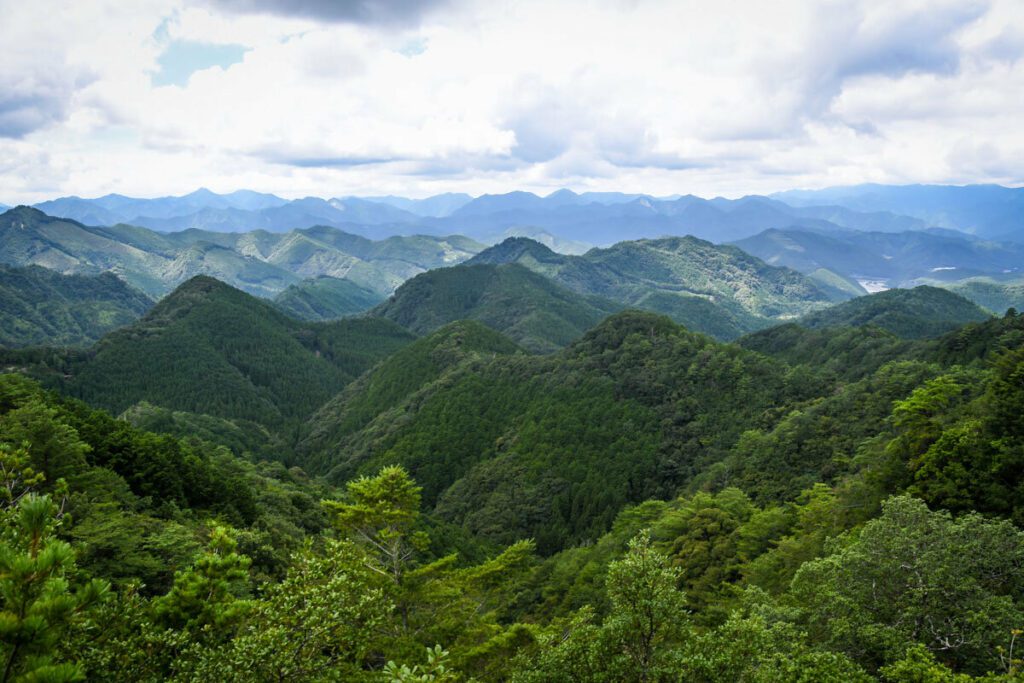
This viewpoint on the Kogumotori-oge section of the trail between Hongu and Koguchi was our favorite on the entire trail. It is said that on a clear day, you can see 3,600 mountains from this vista.
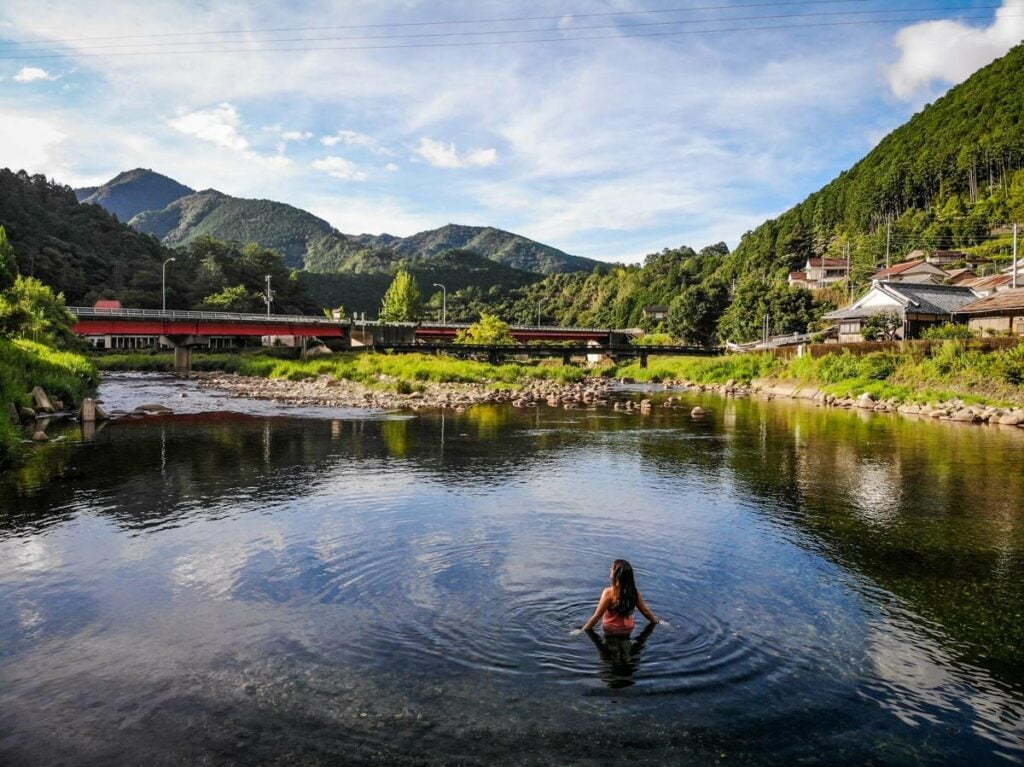
We spent a night in this small village and took a dip in the river which was beyond refreshing after a long day of hiking in Japan. There is not much in the town, but for our second night on the trail, we stayed at Minshuku Momofuku homestay which is run by a lovely elderly couple.
It was one of the more expensive stays in all of Japan, but totally worth it because they prepared dinner, breakfast and a to-go lunch for us the next day.
Echizen-toge Pass
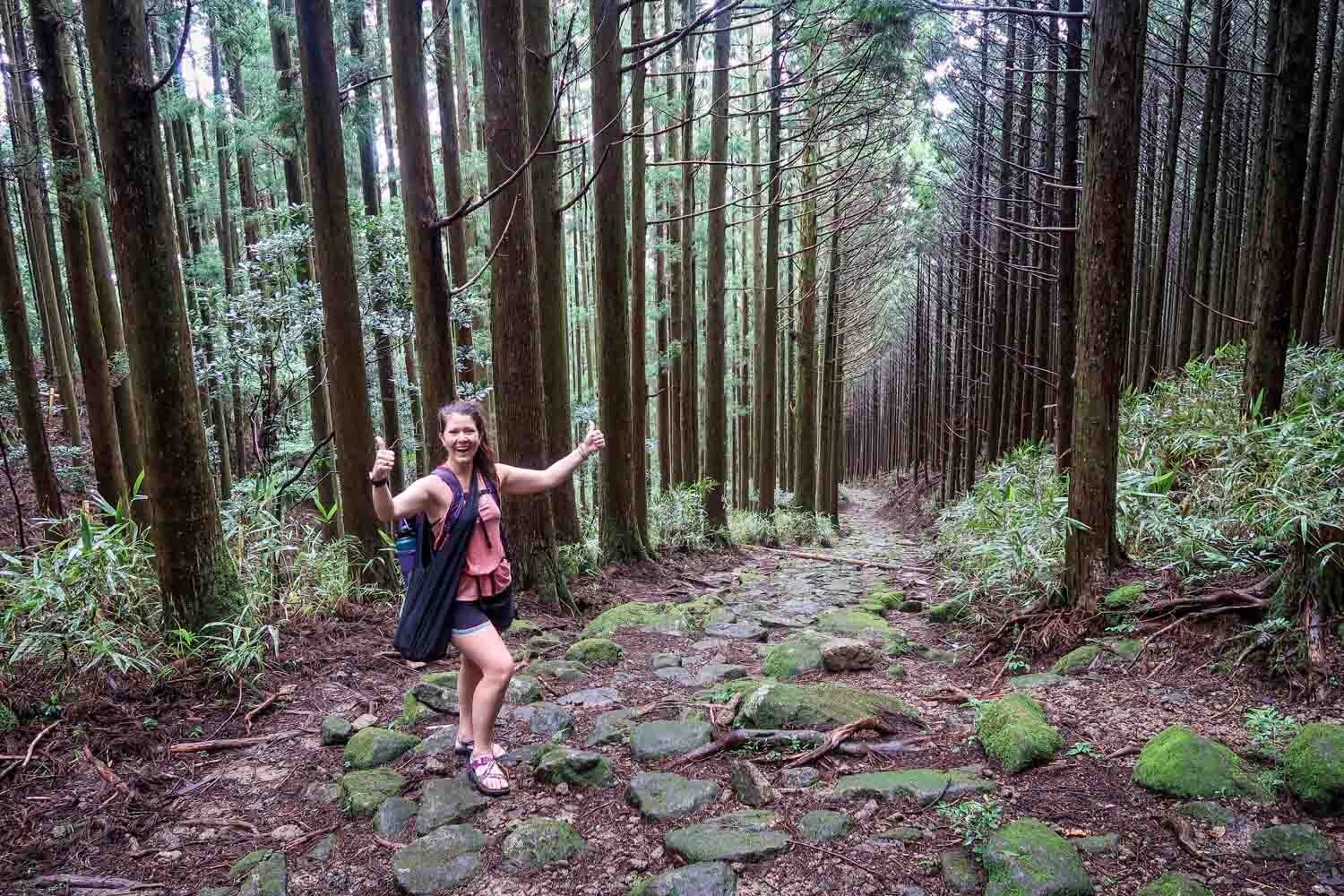
As you approach the pass, sign prepare you for what is called the “bone-breaking slope”, and they are not joking. It’s a long climb up to 870 meters but the rest of the day is relatively flat compared to this.
Nachi Falls
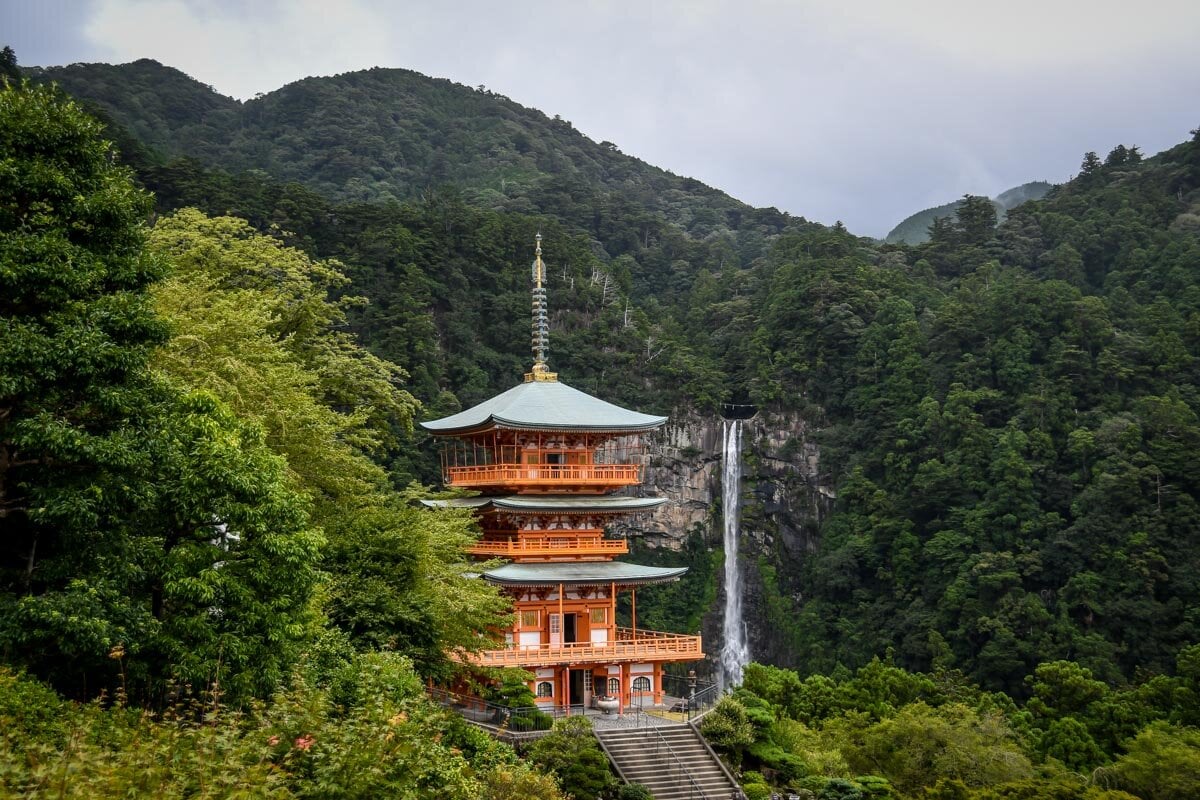
Measuring 133 meters (436 feet) high, Nachi is Japan’s tallest waterfall, and crashes beautifully over the cliffside behind Nachi Taisha, the second and most famous of the 3 grand Kumano shrines.
If you are able to book guest houses in this area, it would be nice because you could take the bus to visit the falls in the morning. Unfortunately, everything was booked for us so we stayed in Katsuura.
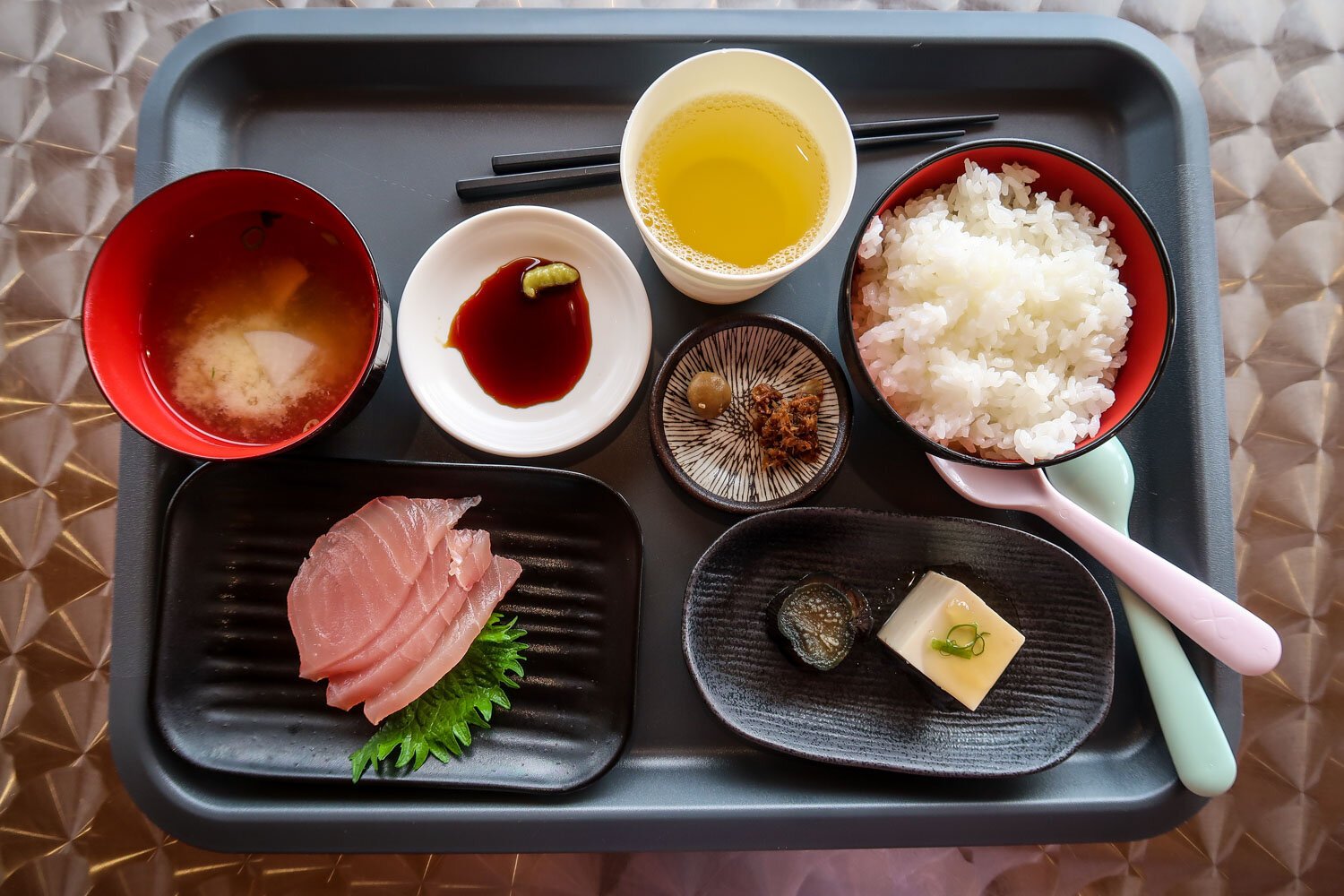
This seaside town can act as a good base for beginning or ending the Kumano Kodo (if the rooms near Nachi are booked, as they were when we were there).
There is a tuna auction every morning from 7-8 am (except Tuesdays and Sundays) down by the docks. After the auction, go inside the market and order fresh sushi for breakfast!
We stayed in a hotel called Why Kumano which had friendly staff and a nice coffee shop attached.
When planning out your Kumano Kodo trek, it’s important to book your accommodation ahead of time. Guesthouses are limited, and some only have a couple of rooms, so they can fill up quickly, especially during popular trekking months.
There are limited options on sites like Booking.com , and many of the smaller villages don’t even show up on booking sites.
So how do you make reservations?
We booked all of our accommodations through Booking.com and Kumano Travel , a local agency that is part run by the Wakayama Tourism Organization.
Here are the places we stayed and we would recommend them all:
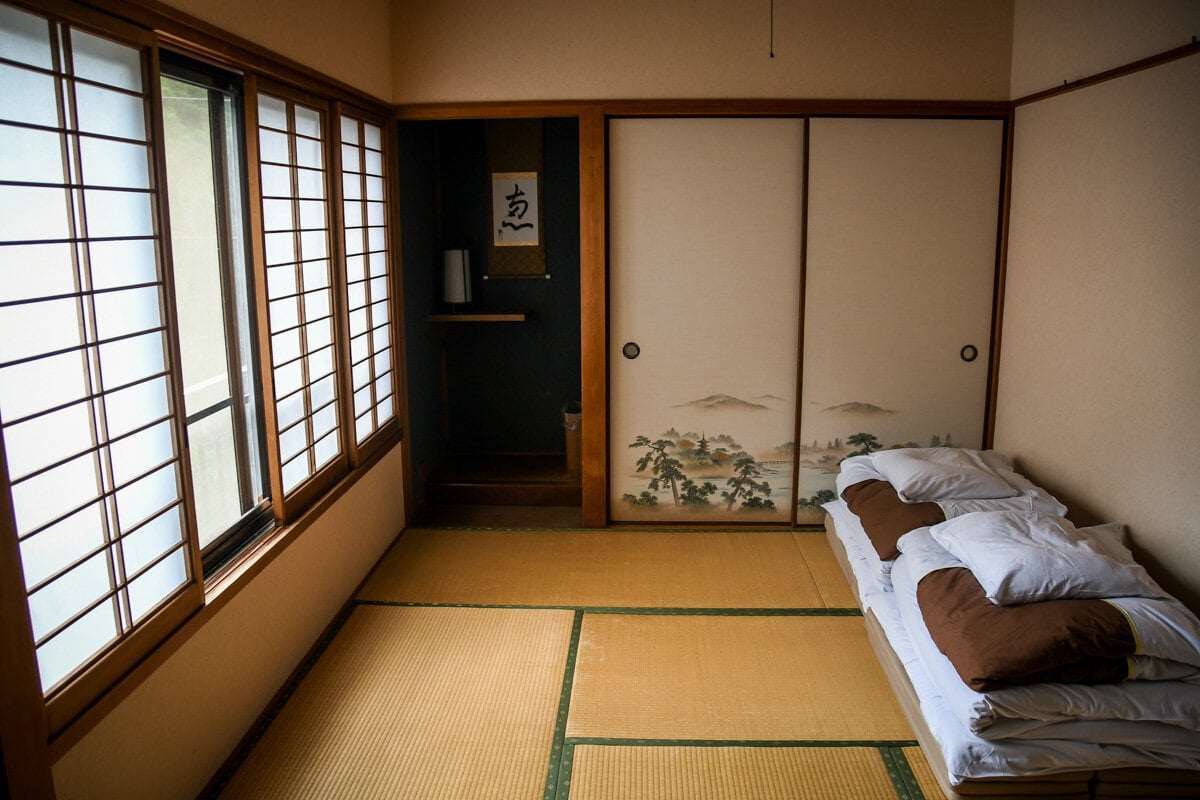
J-Hoppers Kumano Guesthouse in Yunomine Onsen
Stay in a traditional Japanese style room with cosy futons on the floor and shared bathrooms down the hall. The kitchen has all the cookware you can imagine so why not cook your own meal before you start the Kumano Kodo trek. They provide free fresh white rice at dinner time and rice porridge at breakfast.
But the highlight of the guesthouse were the three private onsens. We were able to grab the only open-air hot spring and soaked for a while (as we sipped on a little wine!).
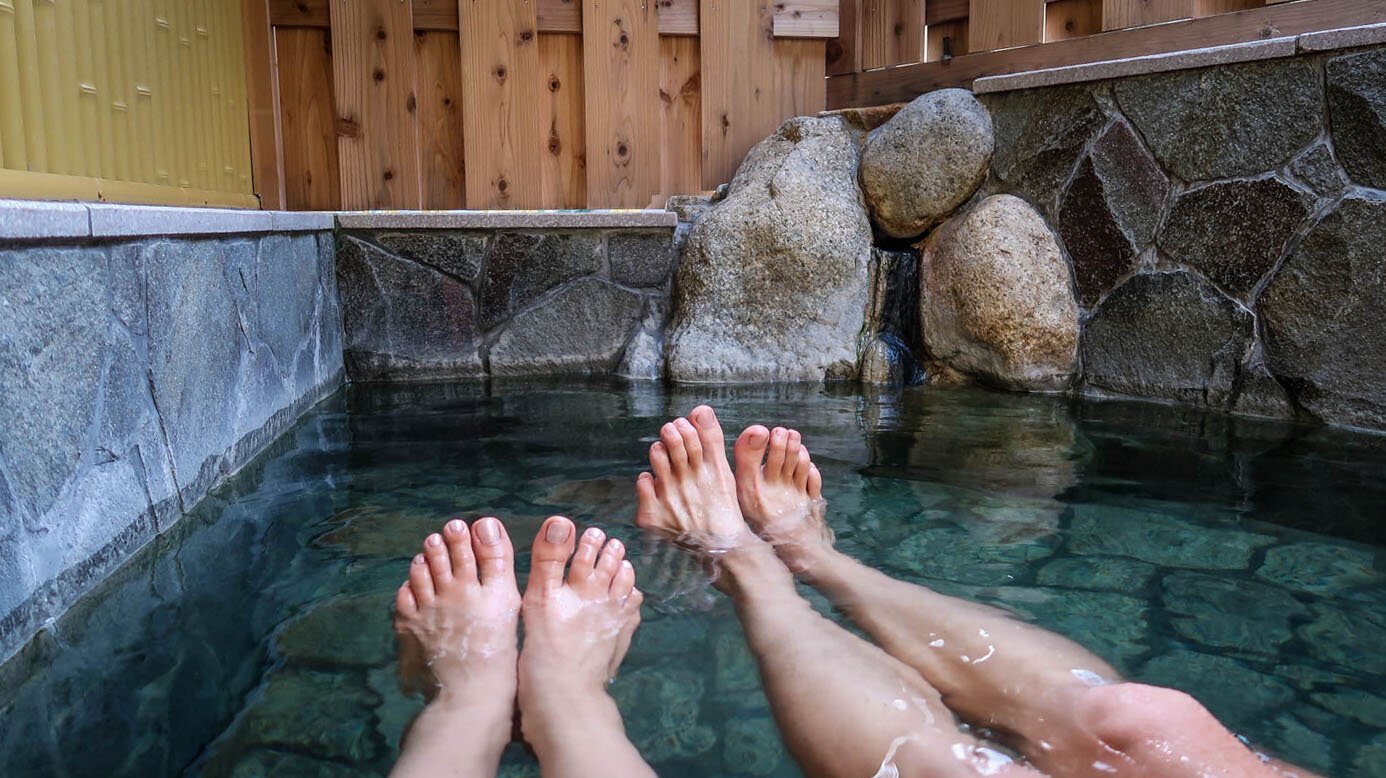
J-Hoppers is super close to town and had a nice social atmosphere. You can book a night here on either Booking.com or Kumano Travel. Check availability for your dates.
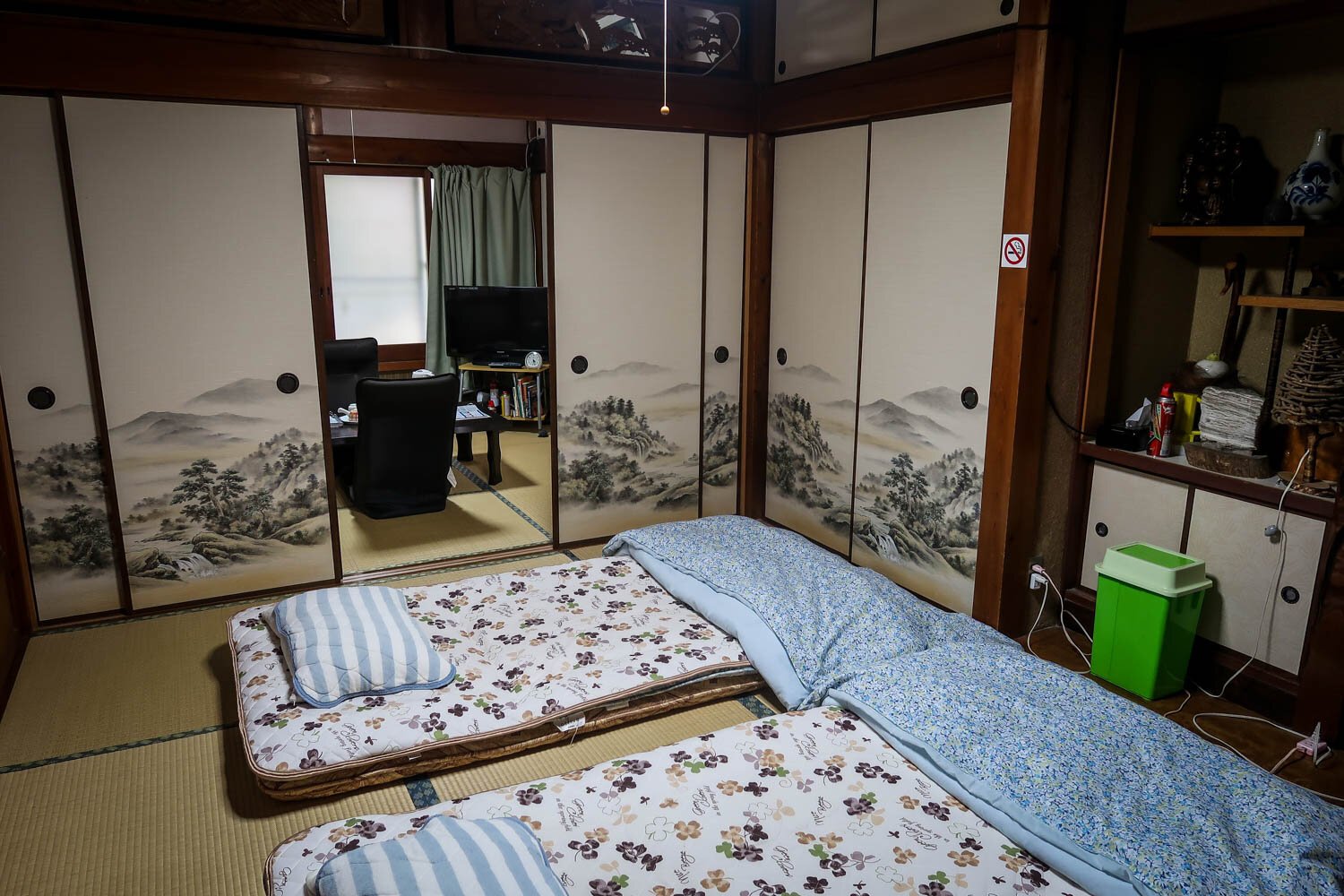
Minshuku Momofuku in Koguchi
Run by an adorable elderly Japanese couple, staying at Minshuku Momofuku was a highlight of our time on on the Kumano Kodo Trail. They welcomed us with open arms and brought us into their home. The husband spoke English pretty well as he showed us around the house. Steps away from their home was the river that ran through village. Nothing felt better then taking a dip in crystal-clear water after a long hike.
The best part of our stay were the meals they prepared. For dinner and breakfast, we were spoiled by their home cooked meals of local fish and vegetables. They even prepared a lunch to-go for us to have on our hike.
If you plan on staying in Koguchi, we highly recommended Minshuku Momofuku, but if they are not available you can browse the other guesthouses in Koguchi .
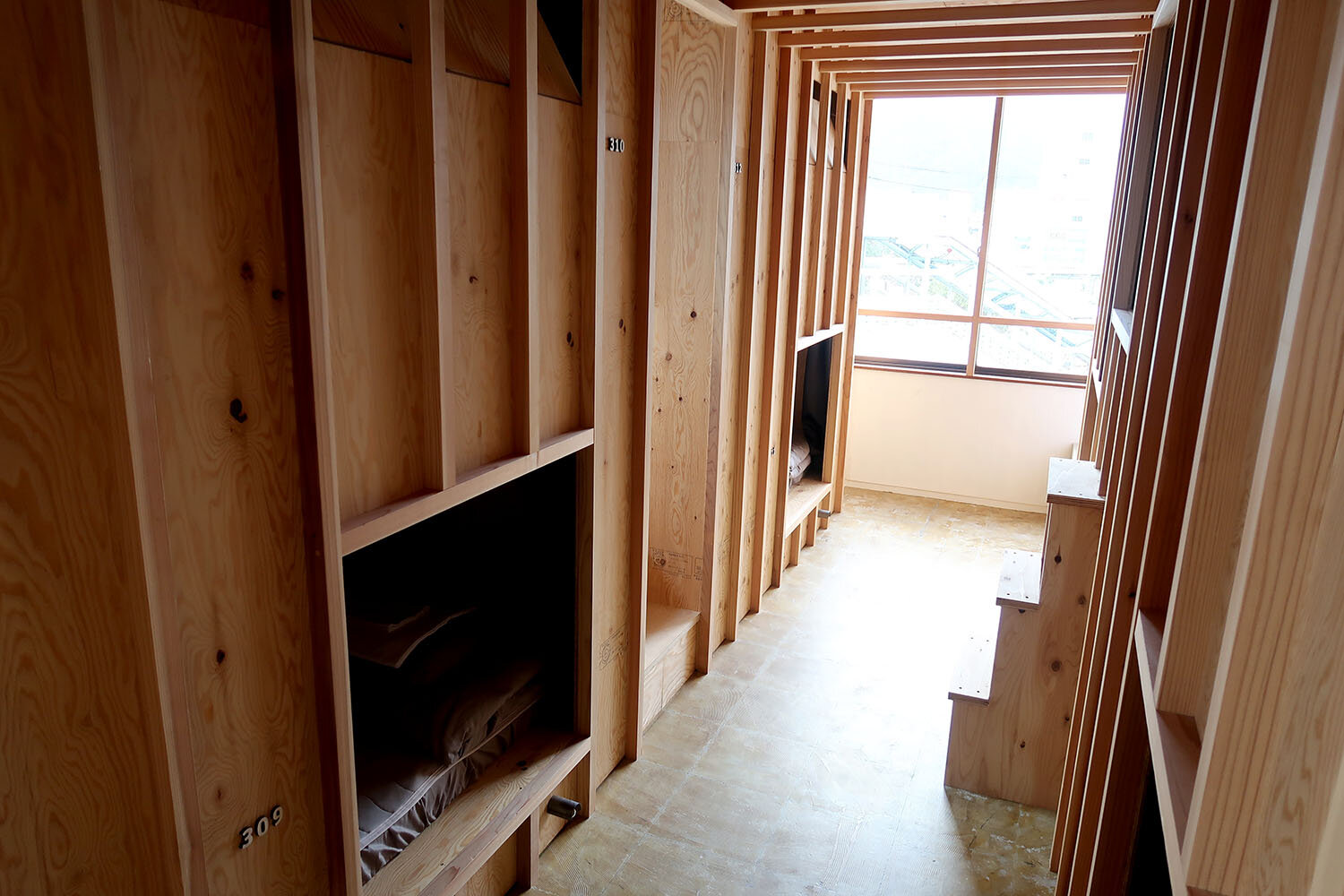
Why Kumano Hostel in Katsuura
Literally 100 feet from the Kii-Katsuura train and bus station, Why Kumano Hostel could not be more conveniently located. They only have dorm rooms and the beds are compartment style (kind of like a wooden capsule hotel) so it may not be for everyone, but we figured it was just one night so we would manage.
The staff was very friendly and even helped us do laundry, which was much needed after two days on the trail (500 yen for a load). The receptions doubles as a cafe where you can get a good americano before you head out in the morning. If you don’t mind sleeping in a dorm room it is a great place to stay in Katsuura. Check availability for your dates.
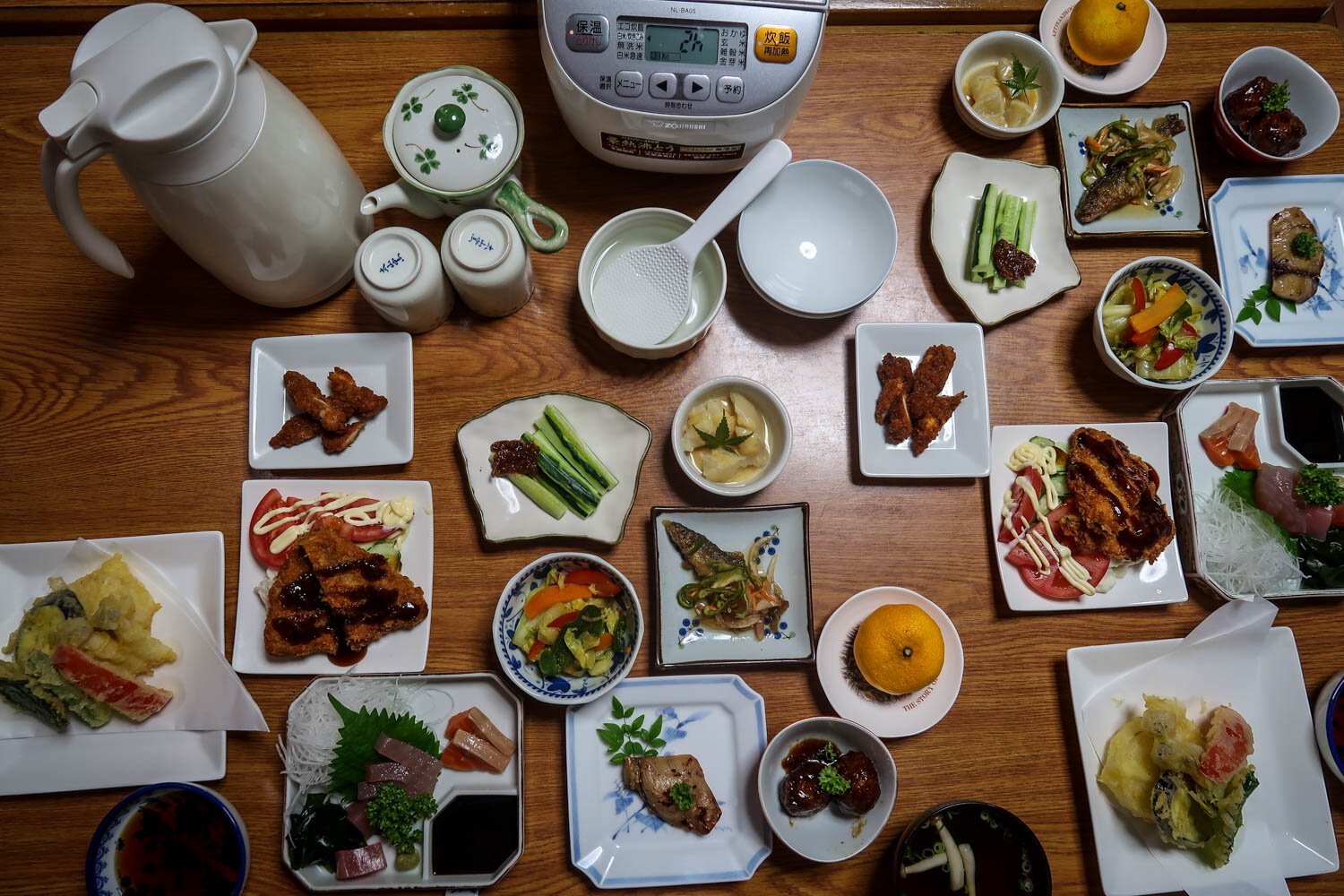
I’ve got good news for all you foodies – you’ll have some incredible food during your Kumano Kodo hike.
Many of the guesthouses along the Kumano Kodo include meals with your stay. Minshuku Momofuku, the guesthouse we stayed at in Koguchi included a gigantic dinner, breakfast and even a packed lunch for us to bring with us the next day. The food was clearly lovingly prepared and featured local ingredients and lots of fresh fish.
As you are hiking, there are many stretches where you will not have access to towns or any food. For this reason, we’d definitely recommend bringing along a few snacks.
Are you vegetarian? One important thing to note is that vegetarianism is not common in the Japanese countryside, and this can be difficult to fully accommodate. When you make your reservation at guesthouses, there is usually an option to select if you don’t eat meat. However, there may still be dashi (fish stock) used in some of the cooking. More info: Check out this guide to Japanese food , which has some useful info for traveling in Japan as a vegetarian.
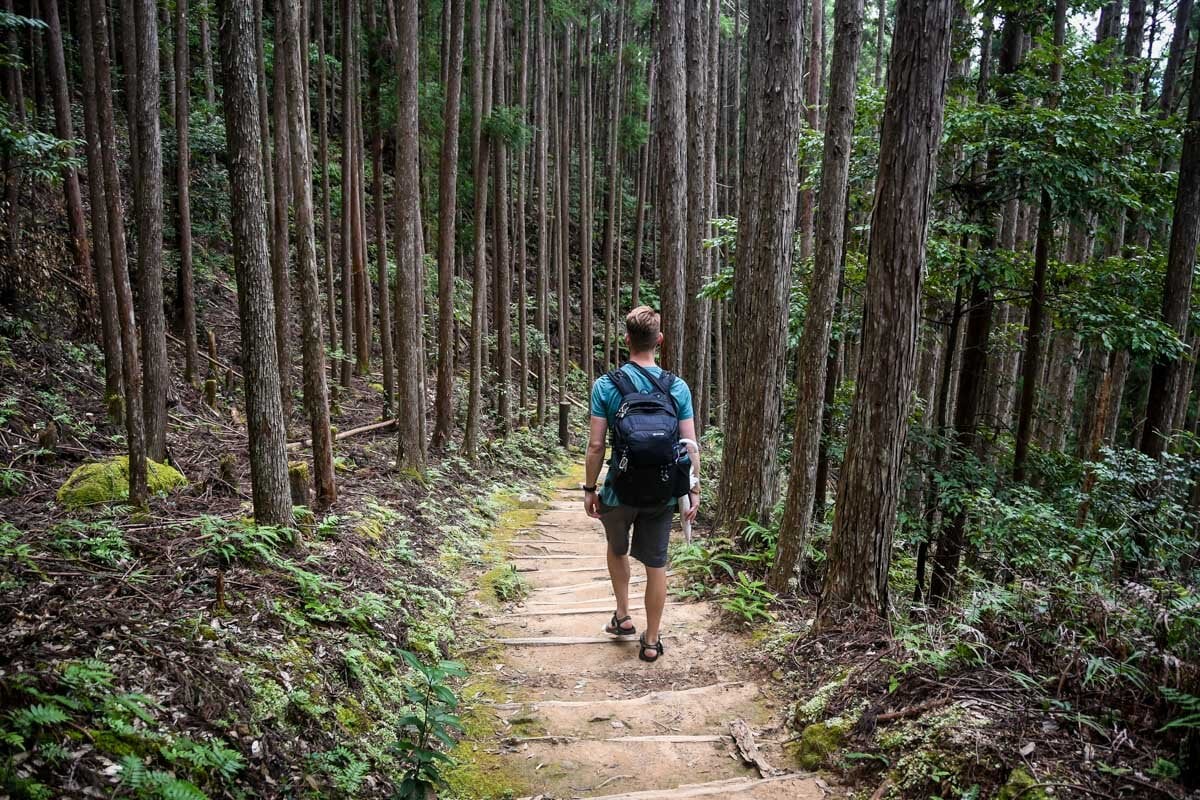
Since you’ll need to carry everything with you on this trek, it’s important to pack light. Here are some of the essentials:
- Comfortable day pack
- Packing Cubes : this will keep your clothing organized and compressed inside your day pack so it’s not a huge mess
- Clothes for hiking & layers (depending on the time of year)
- Rain jacket
- Clothes to change into at night
- Hiking shoes: We wore when we did the Kumano Kodo in the summertime (and they were perfect for us!), but during cooler seasons, we would have worn hiking boots or sneakers instead.
- Battery pack for charging electronics
- Water Bottle and/or Camelbak : remember, it’s safe to drink from the taps in Japan, so you can fill up in towns along the way
- Dry bag : If you encounter rain along the trail, you’ll be happy you have a safe place to store any electronics (it happened to us!)
- Camera: Canon PowerShot G7x – high-quality photos and compact enough to stash in a bag.
- Snacks: We’d recommend stocking up on some snacks in a bigger city, like Osaka. Or better yet, pack granola or protein bars, trail mix, beef jerky, etc. from home, as these types of hiking snacks can be difficult to find in Japan.
- Kindle or book: for reading at night
- Toothbrush & toothpaste (and other essential toiletries)
- The visitors center near the Kii-Tanabe train station offers free bamboo sticks for hikers to use as trekking poles, as well as “passport books” to collect stamps at points along the way (just for fun!)
Insider Tip: Only bring what you need on the Kumano Kodo. Leave the rest of your luggage at your hotel in Osaka (or wherever you’re staying before and after the hike). If you need your luggage transported, there are services for that! Choose any one of the services from the Kumano-Travel.com which ranges from $10 to $60 USD depending on the distance.
What to pack for traveling to Japan
We know it can be overwhelming packing for a trip to a new destination. That’s why we spent hours creating this super helpful PDF just for you.
In this FREE Japan packing list PDF download , we’ve provided packing checklists for everything from clothing and toiletries (for both women and men!) to what shoes to pack and extra stuff you may want to have on-hand just in case.
Plus, we’re sharing tons of packing hacks and tips for traveling in Japan that you won’t find anywhere else!

- Example: When we booked our accommodation, there were no rooms left by Nachi Falls, so we had to be sure to catch the last train of the day to Katsuura. We would have preferred to stay near the falls in order to see and photograph it in the morning light, but we were outta luck!
- Download Google Maps and Maps.me maps for the region. Maps.me does a great job at highlighting trails and points of interest. You should also get the trail maps from Kumano-Travel.com which show in detail what to expect along the hike.
- You might also find it helpful to learn a few basic Japanese words and phrases before your trip.
- Pack snacks. There is not much access to snacks along the way, and if you do find some options in bigger towns like Hongu, there isn’t a ton of variety.
- Bring rain gear. It is known to rain all year round in this region, so you’ll want to be prepared.
- Not returning to the same hotel? We used a luggage transfer service called Yamato Transport to store our luggage and transfer it from Osaka to Tokyo. It was cheap (just $25 USD, but can be as low as $15 USD depending on size), and so convenient! (We had been living in Asia for the better part of a year, and had a lot of stuff with us that we didn’t want to lug around on the Japanese trains!)
- Account for the time getting to and from the Kii Peninsula. You’ll need to have a good chunk of time on either end devoted to train and bus travel, so be aware of this as you plan your day before the trek and the day after.
- Bring Cash (in small bills if possible): You’ll be traveling to small mountain towns that don’t always take credit cards or have ATM’s. Be sure to know if you have paid for your accommodation beforehand or not and bring enough cash accordingly.
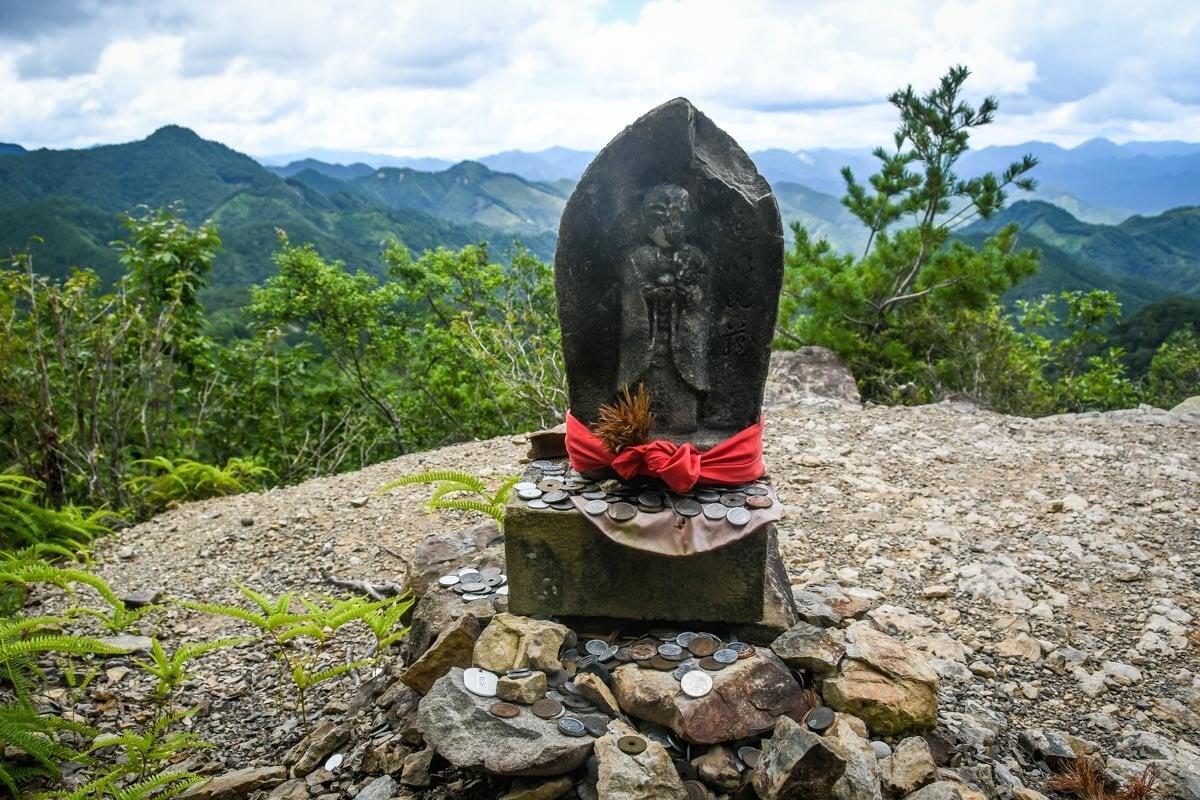
Japan is a notoriously expensive destination, and in some ways, the Kumano Kodo is no exception. Accommodation along the trail is limited, and therefore, not entirely cheap.
Here are some examples of what we paid for accommodation (for 2 people):
- 1-night stay at a family-run guesthouse with dinner, breakfast, and lunch included: $187 USD (19,800 yen)
- 1-night stay at a budget guesthouse, no meals included: $114 USD (12,100 yen)
- 1-night stay (in dorm beds) in a hostel in Katsuura after our trek (no meals included): $99 USD
But outside of accommodation, food, and a few bus rides, you won’t really have any other expenses because the hike itself is free. And hey, when you’re in nature all day, you’re not gonna be tempted to go on a shopping spree!
Tip: You may want to budget a bit of money for a bottle of wine to enjoy after a long day of hiking! We found the brand Alpaca available at some convenience stores in the region was actually an alright wine for around 700 yen ($7 USD).
How much did we spend during our entire Kumano Kodo Hike?
The total for 3 days / 3 nights for two people was ¥53,500, or $490 USD . That averages out to about $82 USD per person per day, which isn’t all that bad for Japan when you think about it.
This includes all accommodation, food, transportation within the region (buses that aren’t part of the JR Pass ), and a few adult beverages!
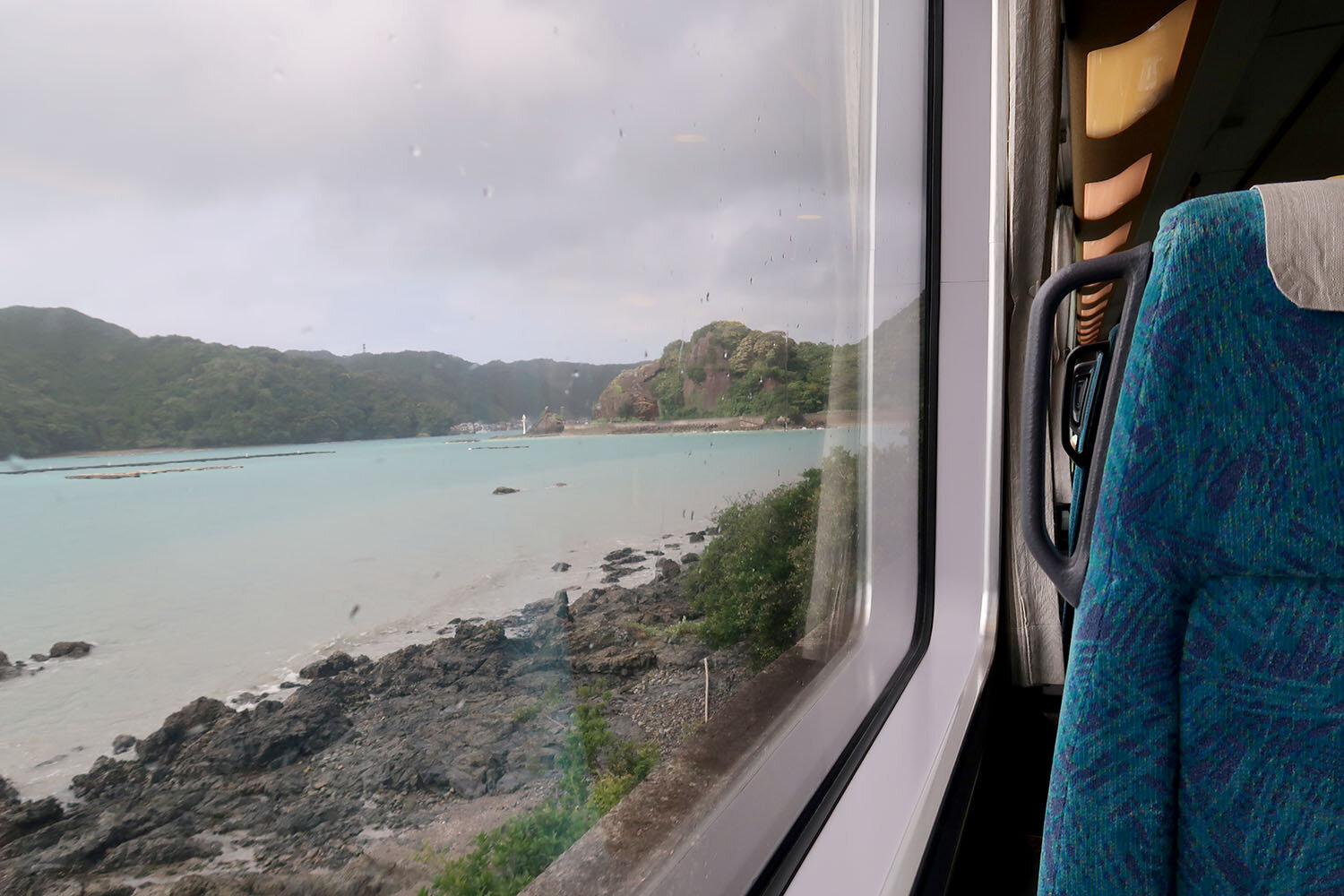
Whether you’re coming from Tokyo, Osaka, or anywhere in between, you’re going to start this trail in one of two places (Nakahechi Route – most common):
- Tanabe in the west part of Kii Peninsula
- Katsuura in the southeast of Kii Peninsula
The route we took was from Osaka’s Tennoji Station to Tanabe Station (sometimes called Kii-Tanabe).
The nice thing about traveling around the Kumano Kodo is that each town or village is connected on a bus route. So if you don’t want to hike a portion of the trail or if your plans change, you can take the bus to the next town. Here are some of the key bus routes in the region .
How to Ride the Bus: Enter from the back of the bus and take a small ticket from the machine by the door. It will have a number on it corresponding with the stop number. There is a monitor (in English and Japanese) displaying the stops. Push the Stop button on the wall when you see the stop you want to get off. As you exit out the front of the bus, pay the driver in cash in the bus fare machine.
You’ll want to keep an eye on the time because, in true Japanese fashion, everything is on time, even buses. And most places in this region close early, and same goes for the buses. Don’t expect buses to run after 5 or 6 pm.
We took 3 buses in the region (1 long distance and 2 short distances) and the total we spent per person was 1,940 yen ($18 USD).
Important Note: While the entirety of your transportation will not be covered by the JR Pass (you’ll need to take some local buses), just getting to the Kii Peninsula and back out is likely to make getting a JR Pass well worth your money. Read all about how to calculate if the JR Pass is worth it for you .
Kumano Kodo FAQs
We’re trying our best to answer some common questions about this hike. If you have a question that you don’t see answered here, be sure to write to us in the comments below and we’ll get back to you!
How hard is the Kumano Kodo?
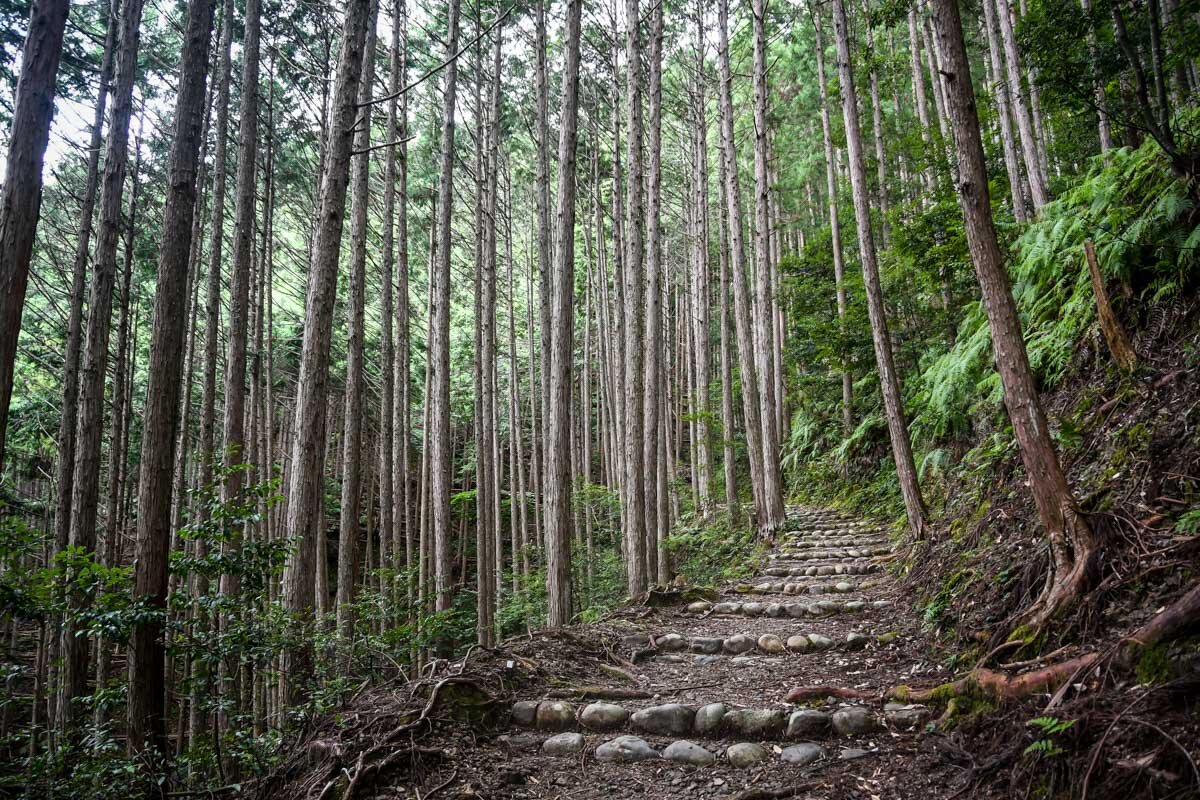
This is a difficult question to answer because it varies from person to person based on their prior experience. It is also going to depend on which route you take, as different sections of the trail are steeper than others.
We do quite a bit of hiking, and we felt like this trail was moderate. You won’t feel any effects of elevation, and the paths are well-maintained and clearly marked. There are some very steep sections, but there are also many flat areas to balance it out.
The most difficult part, in our opinion, was the stretch from Koguchi to Nachi Taisha at the end of the route (Day 3 on our route). This is a long day – it took us about 7 hours from start to finish, and there are many steep sections. Another thing to note is that you don’t cross any towns or villages along the way, so you need to be sure to bring enough water and food on this day.
What ages is the Kumano Kodo Trail suitable for?
We think anyone who is relatively fit and likes to hike would be able to enjoy the Kumano Kodo, either in its entirety or just a portion.
We saw a handful of older people doing this hike (60s – 70s), and while we didn’t see any children, I’m sure kids do make this hike (as long as parents know their limits and are prepared). This hike wasn’t any more challenging than others that we’ve seen children on.
How crowded is the Kumano Kodo Trail?
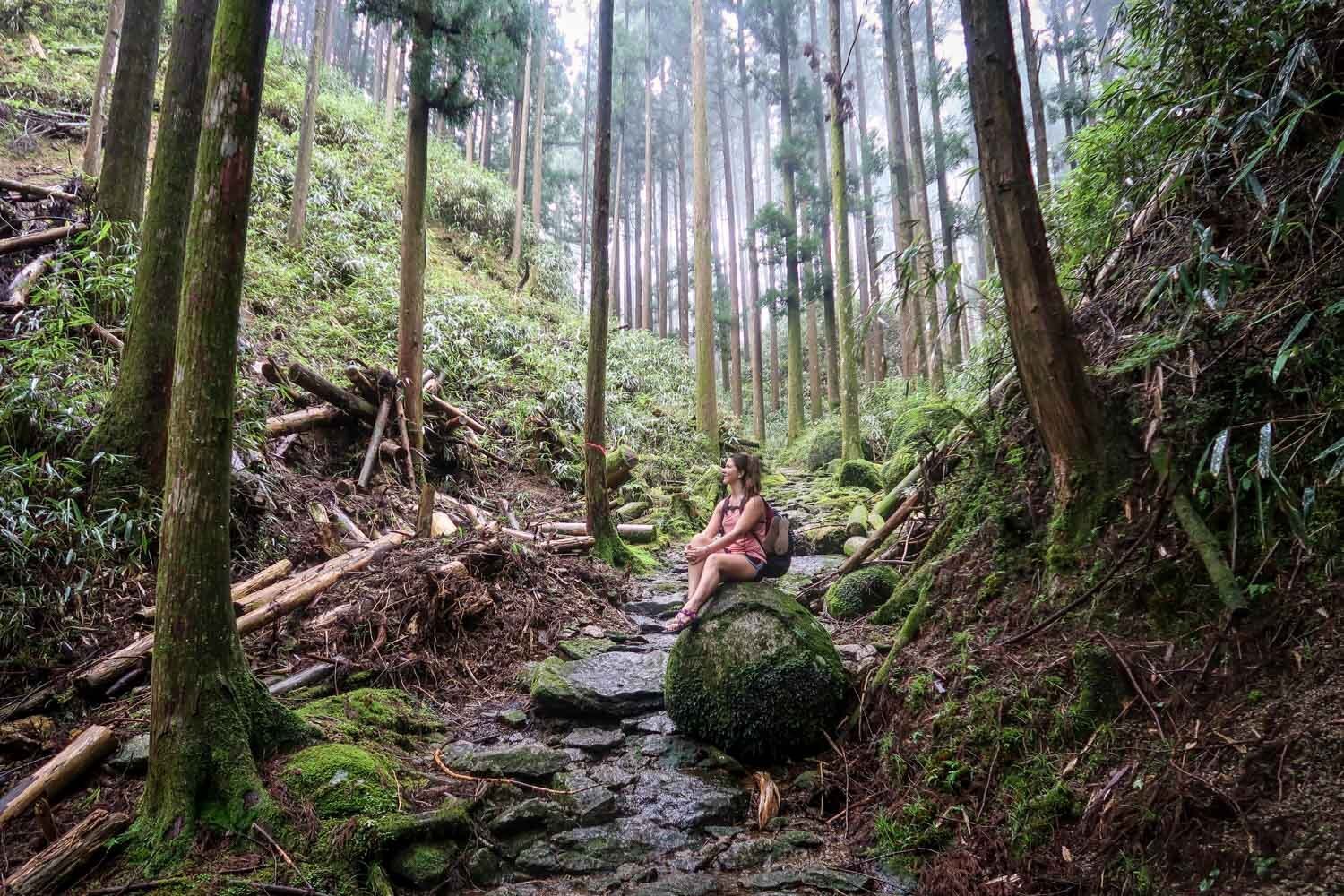
This is going to vary throughout the year, as some seasons are more popular for hiking in Japan (I’m talking about you, Spring and Autumn!) than others.
We did the Kumano Kodo in August, and on each day of our hike, we counted fewer than 10 other people. I mean, can you imagine any greater contrast to Tokyo’s infamous crowds?! I will point out that during certain times of the year, it can get busier than what we experienced in August. However, it is still far from the crowds you may associate with Japan.
And this under-the-radar reputation may not last long…
Lonely Planet named the Kii Peninsula as one of the “top 10 regions” in their 2018 Best in Travel Awards , so I think it’s only a matter of time before this trail becomes more well-known amongst general travelers.
Good to know: Another major point to mention is while it may not be crowded, the small towns along the way don’t have all that much accommodation. So it is important to book your rooms in advance, no matter which time of year you’re traveling.
Read next: We’ve rounded up all the things Japan is most famous for in a guide that’s also packed with practical travel tips. Plus, we’re sharing a few things we personally think Japan should be famous for, but most foreign tourists are surprised to know (spoiler alert: one of those things is hiking!).
Other epic hikes to add to your bucket list
If you’re reading this article, I imagine you’re a hiking enthusiast. We’ve done some pretty epic hikes around the world and created guides to help you navigate the same trails we have.
- Tongariro Crossing, New Zealand : Widely considered to be the best day hike in New Zealand, this is a can’t-miss if you’re visiting the North Island.
- Routeburn Track, New Zealand: If you’re traveling in New Zealand, you’ll want to add this hike to your list as well. This multi-day trek on the South Island is one of the best hikes in the country.
- Fimmvorduhals Hike, Iceland: This is one of our very favorite day hikes ever, and if you like the Tongariro Crossing, this should also be on your list!
- Old Man of Storr, Scotland: This hike on the Isle of Skye brings you up close to some otherworldly rock formations.
- Volcan Acatenango, Guatemala: This overnight hike just outside Antigua allows you front seat views to watch the neighboring Volcan Fuego erupt all night long.
- Ijen Crater, Indonesia: This classic sunrise hike in East Java ends with epic views over a neon blue crater lake.
- Inca Trail : This classic trek in Peru is worthy of a top spot on your hiking bucket list.
- Everest Base Camp : If you’re looking for a hike you’ll be telling your grandkids about, this is it! Stay at tea houses along the way and make lifelong friends.
Are you planning a trip to Japan?
We have TONS of resources on travel in Japan and destinations throughout the country. Check out our Ultimate Japan Travel Guide for all the answers to your most burning questions, or read some of our favorite articles below.
- How to Hike the Tateyama Kurobe Alpine Route in Japan
- Best Japan Travel Apps
- Japan Rail Pass: Where to Buy a JR Pass & Is it Worthwhile?
- Foods to Eat in Japan: Guide to Japanese Cuisine
Save this article on Pinterest for later!
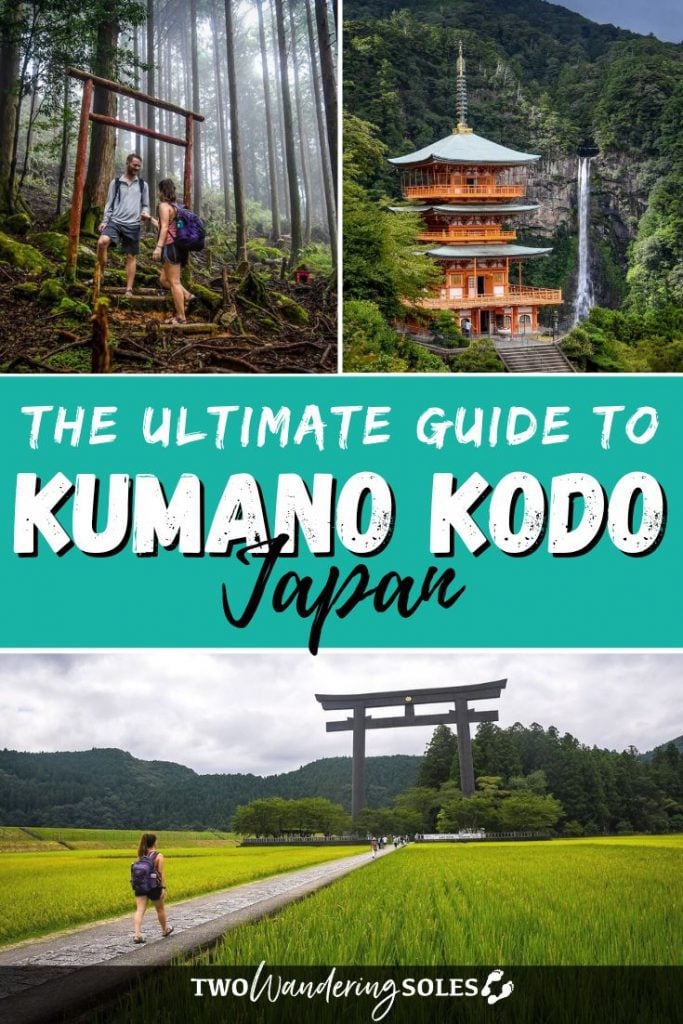
We want to hear from you!
Do you want to hike the Kumano Kodo Trail? When are you planning on going? Do you have any more questions about trekking on the Kumano Kodo? Let us know in the comments below!
Comments (18) on “ Kumano Kodo Trail: How to Hike Japan’s Pilgrimage Route On Your Own ”
We plan to hike this trail next year, either in March or Nov. I have a question about footwear – I see that you hiked in sandals, as it was August. What are the trails like? For comparison, we have experience hiking in the Alps, the Rockies, and the mountains north of Vancouver, Canada, (where the trails can be rough – climbing over roots, logs, and rocks etc, and I would not wear sandals as they do not protect the bottom of your feet enough). In your opinion, for the Kumano Kodo, would lighter weight sneakers be adequate or do you need a hiking shoe / boot?
Thank you so much for writing this up, really nice. Are there any places in Osaka or some other city where we can leave our luggage and travel light for the hike? Any suggestions would be much appreciated, thanks!
Hey, I’m traveling solo for two weeks and originally thought of doing one of the suggested hike itineraries. However part of me get’s more concerned navigating alone. Thoughts on any one day hikes on the trail that you are aware of. Right now my itinerary is as follows: – 6 days in Tokyo (1 of those nights going to stay near the large lake by Mt. Fuji – 3 days in Kyoto – 2 days (1 night) at Hiroshima (and see the island) – 3 days Osaka
Let me know if any day trip hikes from those areas you recommend.
Hello! Thank you so much for this great resource! I am flying into Osaka, staying one night there and then heading down to Kii-Tanabe. I will be on the trail for 3 nights and 4 days then will head back to Osaka from Katsuura. I am only visiting Osaka and the Kumano Kodo, so I don’t think the JR pass makes sense. I am researching right now… do you know if it is possible to buy one way tickets at the train station? (For example, a ticket from Tennoji to Kii-Tanabe). Thanks for any insight!
*Amazingly detailed* information. Thank you!!
Fantastic information! Thank you. Is the hike mostly steep?
This looks amazing! We only have time for one short hike, is this your favourite hike in Japan?
I am actively planning my 40th birthday trip to Japan to hike the Kumano Koda Trail plus see Osaka, Hiroshima, Tokyo, etc. I’m big on research & your multiple blogs have been a Godsend to answer questions I couldn’t quite find & now I have THANK YOU!
There is so many interesting trails in japan to do
Awesome thanks you. You write so good
Is there a specific starting point? I’d like to get the dual credential as I have done the Camino.
Fantastic article and very comprehensive. Thank you so much for the masses of information. I almost feel like I don’t need a travel guide. I’m planning on walking the route for my 70th birthday in 2025. So plenty of time to save although it’s not expensive by any means. Excellent article. Regards Cindy
Wow, what an excellent way to celebrate your 70th! It’s totally possible without a guide. Happy trails 🙂
Thank you for this awesome resource. Question: Did you see any campers? We are planning to do it, but only can do it if camping is a possibility. We may spring for one night in a guest house to get that experience, but are used to overnight hiking with camping and are perfectly comfy that way, especially if it makes the trip affordable enough to be possible on our budget.:-) Thanks for any advice you can offer on this! We are thinking of doing the higher elevation route, unless we can camp the same rout you have described! -Sarah
Hi! My husband and I are planning a trip to Japan in May/June and this is on our list! Did you use Kumano Travel just to book your accommodations? Or did you use them for everything? I looked at their model itinerary for 3 day/2 nights and it wasn’t quite enough hiking for what we are looking for. The longest hiking day they have is 2-3 hours. You itinerary is more of what we are looking for.
Hey Hannah, we did use Kumano Travel to book our accommodation. It was pretty simple and we were happy to support the local tourism. But just like you, we wanted to do more hiking than the routes they had, so we made our own plan. Our route is above and we thought it was excellent 🙂 Please let me know if you have any more questions. Cheers!
Hi. What a fantastically informative article. I am hoping to hike hear next October, and this info will be really helpful for planning, thanks very much. X
You are very welcome, Sally! Have a great trip!
Leave a Reply Cancel reply
Your email address will not be published. Required fields are marked *
Save my name, email, and website in this browser for the next time I comment.
Hiking the Kumano Kodō: Japan's ancient pilgrimage route
Oct 8, 2019 • 7 min read
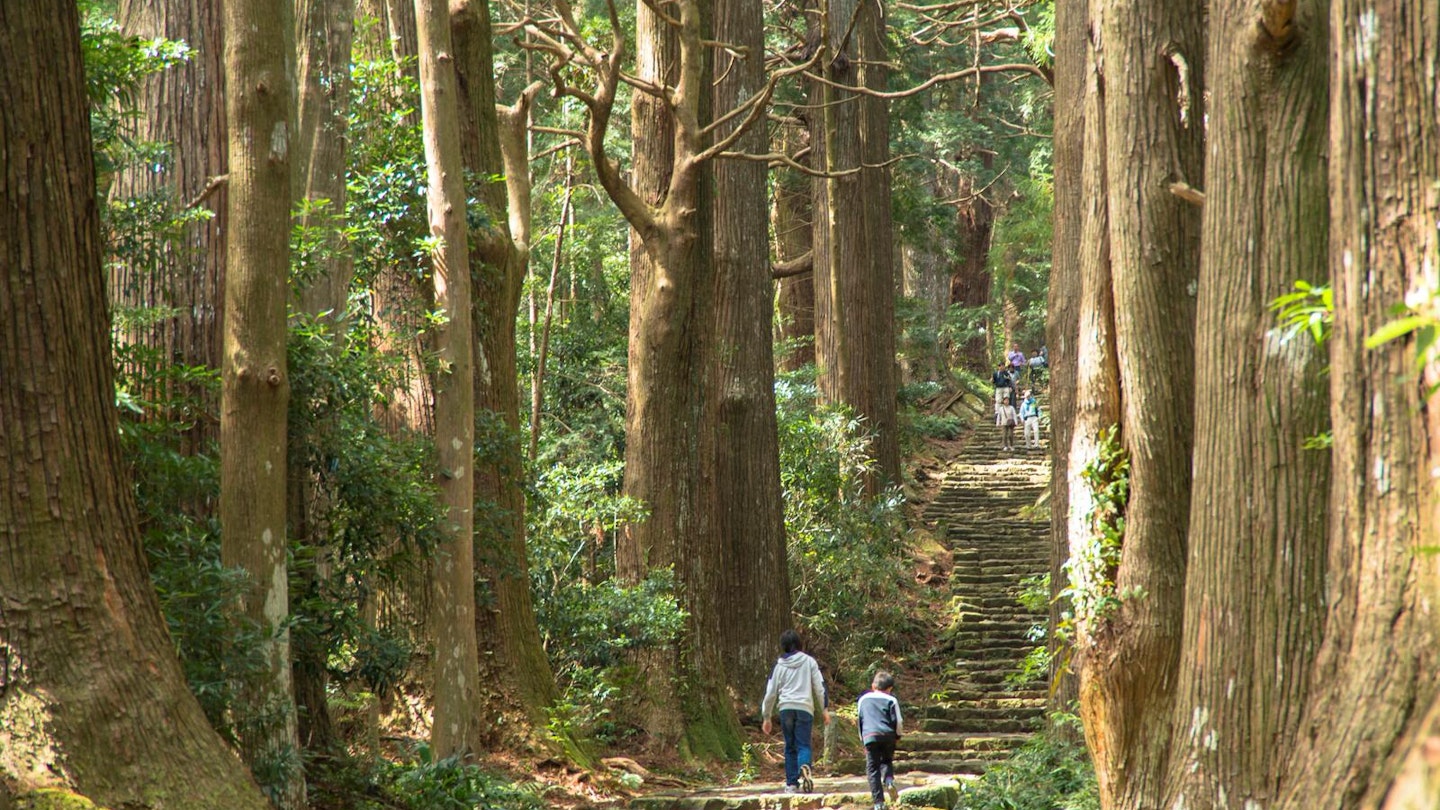
Walkers on the Kumano Kodō in the Kii Peninsula © JTB Photo / Getty Images
One of Japan's most remote and rewarding journeys, the Kumano Kodō hiking route weaves through the mountainous Kii Peninsula, south of Osaka. Once a sacred pilgrimage trail reserved for emperors and samurai, the ‘Kumano Old Road’ is today open to all seekers and wanderers, with plenty of intensely photogenic shrines and natural beauty along the way.
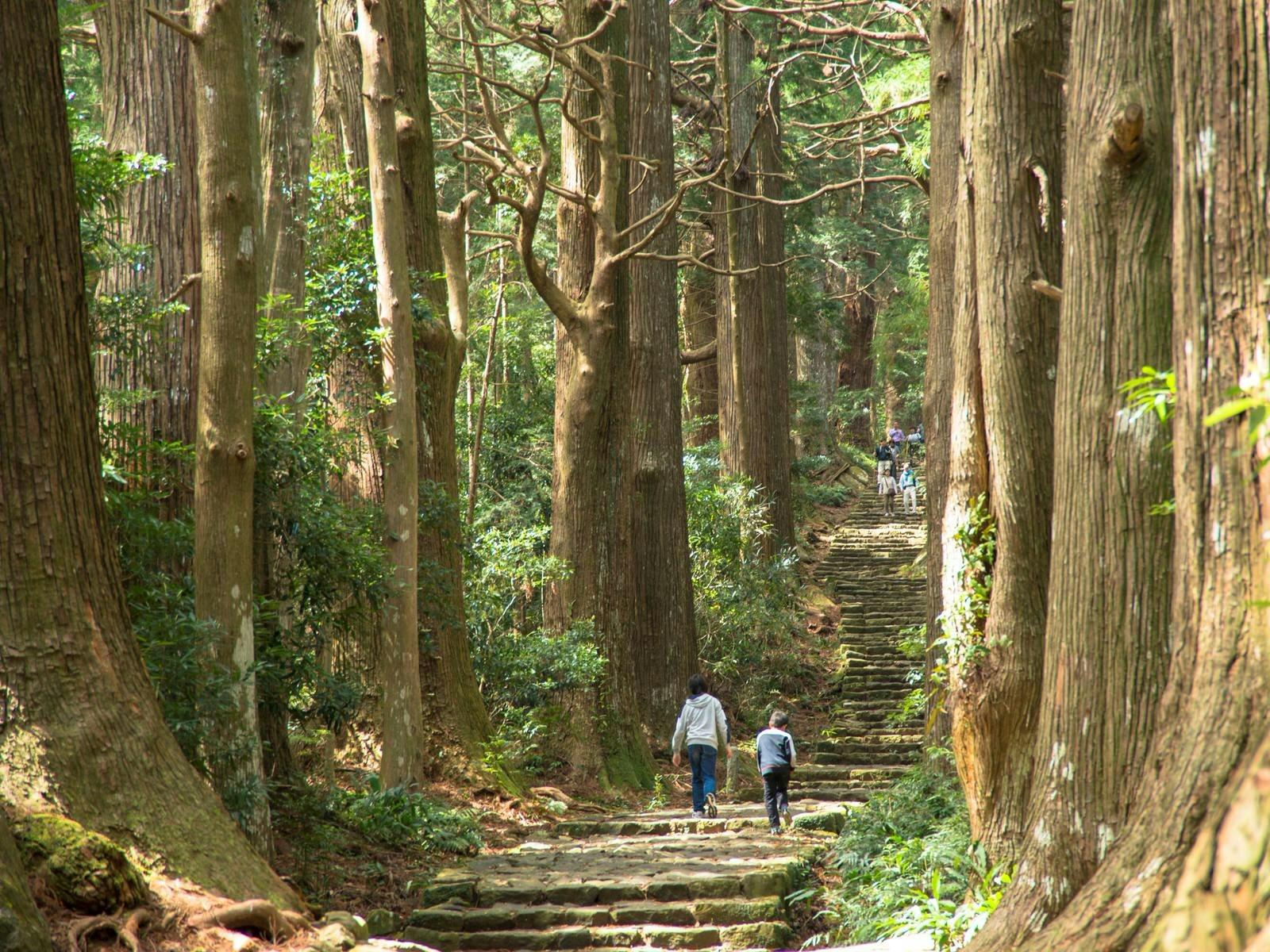
From old road to World Heritage Site
Even before organised religion existed in Japan , locals worshipped nature in the Kii Peninsula 's mystical landscape. Towering trees, the nation's tallest waterfall, and the mountains in between were themselves considered kami (gods), and a walk among them a sacred act. Emperors and samurai from Kyoto kept detailed diaries of their pilgrimages here; one of the earliest was by an aristocrat who travelled to Kumano in 1109.
Over the years Buddhist temples and shrines of Shintō, Japan's native religion, were built; and in 2004, the Kumano Kodō and its sacred sites were given World Heritage status – one of only two pilgrimage routes recognised by Unesco (the other is the Santiago de Compostela in Spain and France).
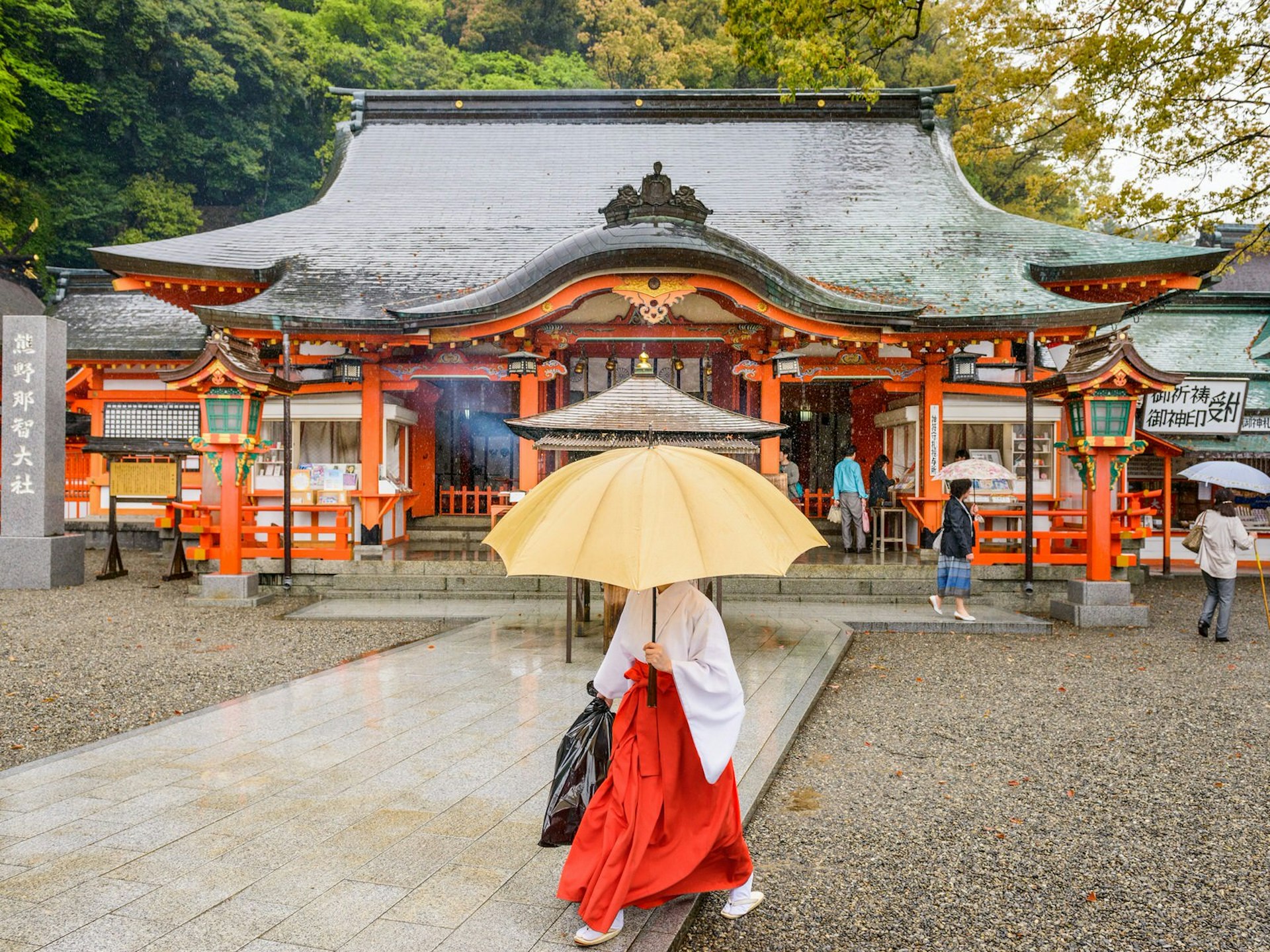
Pick your pilgrimage
The Kumano Kodō is not one route but a network of trails through the deeply forested mountains, with no official start or end point and no prescribed hiking order. Moderate to strenuous hiking options last a few hours to several days, taking in some of Japan’s top ‘power spots’ – temples, forests and waterfalls thought to enrich the soul. While purists may want to hike the entire way, there’s no shame in riding the buses that circulate between the sights and trailheads.
Historically, pilgrims would visit the three grand Shintō shrines of Kumano – collectively known as Kumano Sanzan – cornerstones of the Nakahechi route (aka the Imperial Route), the most action-packed way through the region.

Hiking the Nakahechi route
On the Kii Peninsula's west coast, Tanabe (aka Kii-Tanabe) is the gateway to Kumano, offering one last micro-glimpse of the modern world before setting out. Fortify yourself the night before your journey with sashimi, yakitori , sake and the local speciality umeshu (Japanese apricot liqueur, sometimes mistakenly called 'plum wine') in one of many atmospheric izakaya (Japanese pubs).
From Tanabe, a 40-minute bus ride takes you to the start of the route at the Shintō shrine Takijiri-ōji , where centuries of pilgrims used to perform ablutions in the healing river waters before commencing their journey.
A 4km hike opens with a steep uphill climb and rambles along tree roots and boulders before arriving in Takahara, nicknamed 'the village in the mist', a good place to bed down for the night.
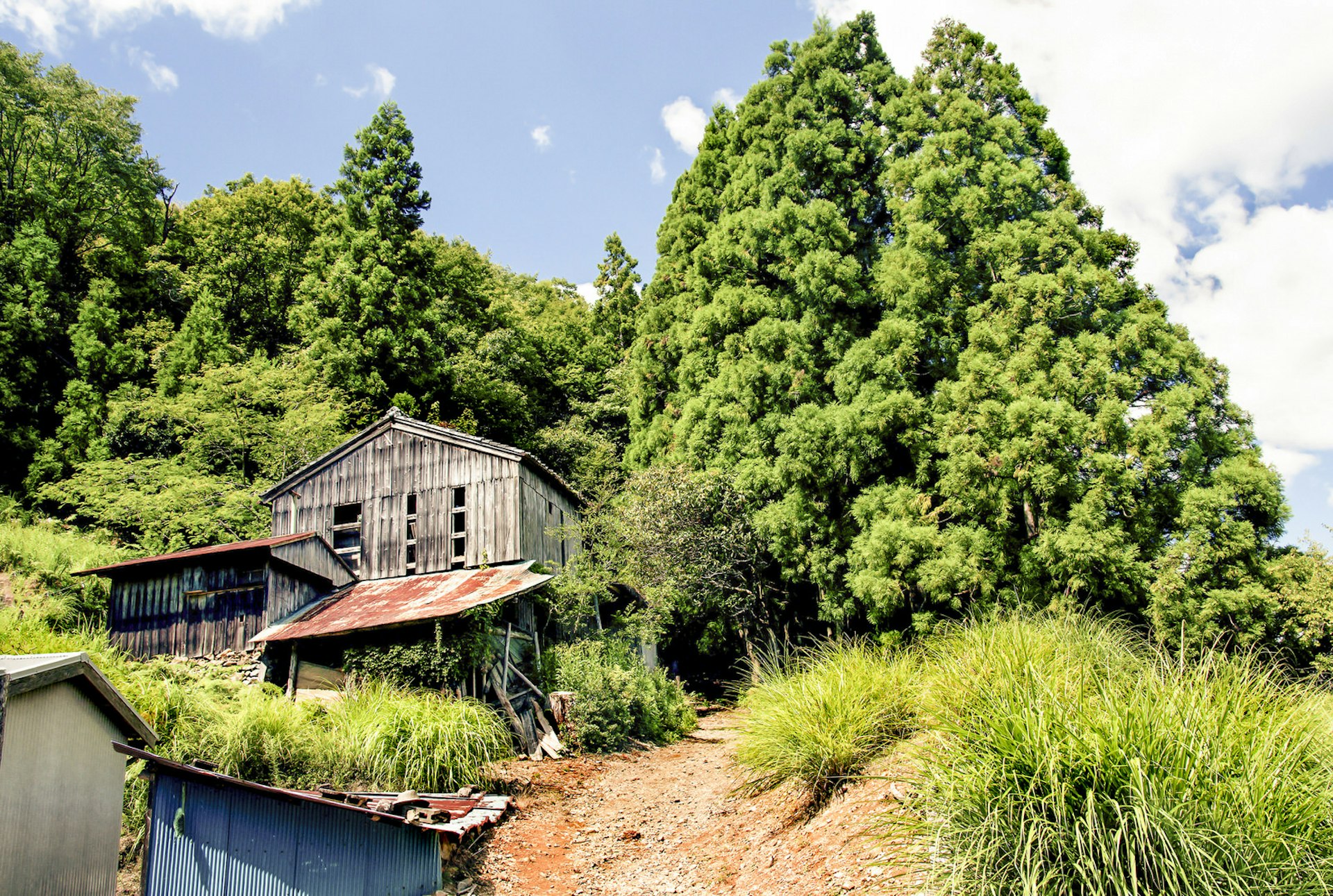
Many visitors opt to forgo the next 13km hike – with an elevation gain of 830m – for a bus ride to the next town of Tsugizakura and its groves of ancient pines; it's a 25-minute hike from Takahara to the bus stop, and another 25 minutes' walk from the bus stop to Tsugizakura.
Fit hikers can cover the next 21.5km in about 8 hours, via isolated villages, forest trails and an inspirational lookout point to Kumano Hongū Taisha , first of the grand shrines, perched over a tree-covered ridge. Near the shrine, the modern Kumano Hongū Heritage Centre provides museum-quality descriptions in English about the route and World Heritage Sites. Japan's largest torii (Shintō shrine gate), nearly 40m tall, stands nearby.

Midway through the next 27.5km (about 1.5 days) is the toughest part of the hike, the forebodingly named Dogiri-zaka (body-breaking slope) – about 5km straight uphill for an 800m gain in elevation. It’s been notorious for centuries; one 13th-century poet hiker wrote ‘it is impossible to describe precisely how tough it is.’
Your reward is a stop at Nachi-no-taki , Japan's tallest waterfall (133m), subject of countless photos and the backdrop to the brilliant orange pagoda across the valley. The waterfall is the kami (god) enshrined at the adjacent Kumano Nachi Taisha , the second of the grand shrines of the area.

To reach the last shrine, Kumano Hayatama Taisha , you might travel from the Hongū area as the ancients did, down the river Kumano-gawa by traditional flat-bottomed boat, to where it empties into the vast Pacific at the town of Shingū (or kayaks and motorised boats are also available). At the shrine, an 800-year-old pine tree – itself considered sacred – makes a fitting end to the trail.
Day-tripping Kumano
Not up for hiking? You can day trip from Osaka to some of Kumano's best-known sights. Limited express Kuroshio trains circle around the peninsula to Kii-Katsuura station in about 3.5 hours; from here it's a 25-minute bus ride to the shrine area. For a taste of the hiking experience, break a serious sweat by ascending to the main shrine building via a fantastical, 800m tree-lined arcade. With a little extra time, return to Kii-Katsuura station and continue by train to Shingū and Kumano Hayatama Taisha.
From Osaka’s Kansai Airport, catch a train to Hineno, where you can transfer to Kuroshio trains.

Detours, hot-spring villages and Kōya-san
An easy bus ride or about 3.5km walk from Hongū is a trio of connected onsen (hot spring) villages, where inns and waters have soothed bodies and souls for centuries. Note that the custom at Japanese hot-spring resorts is to go au naturel (most are gender-separate); use changing areas and small modesty towels, and inquire before setting out if you have tattoos as many baths in Japan prohibit guests sporting ink.
A good choice is picturesque Yunomine Onsen, where a stream rushes downhill through the centre of the hamlet, and small ryokan (traditional inns) boast some rustically beautiful baths. Watarase Onsen is home to a large indoor-outdoor bathing complex surrounded by larger inns. The most unusual is Kawa-yu Onsen, where hot water bubbles through small stones into the riverbed; and bathers carve out makeshift tubs from the river stones before dipping in. Note: a swimsuit is required at Kawa-yu.
Related content: How to soak up wellness in Wakayama's onsens
With more time to explore the region, two longer routes are the Ohechi and Iseji trails. The Ohechi’s unimpeded views of the Pacific, around the peninsula’s southern coast, made it a favourite of worshippers, sightseers, writers and artists during the Edo Period (1603-1868). Iseji, meanwhile, connects to the northeast with the Ise Grand Shrine, considered Shinto’s most sacred, in neighbouring Mie Prefecture.
Another side trip north of Kumano Kodō, the mountaintop Kōya-san is a palpably spiritual temple complex, headquarters of the Shingon sect of Esoteric Buddhism and also on the Unesco World Heritage list. Only the fittest, most dedicated hikers will want to hike the 70km Kohechi trail from Kumano; for the rest of us there are a couple of daily bus connections. That said, most visitors visit Kōya-san as a standalone trip from Osaka (there are several daily trains), while a new direct bus line from Kyoto saves time and train transfers.
Related content: Exploring Kōya-san: staying at Japan’s sacred mountaintop temple complex

Although the Nakahechi route is open year-round, during peak seasons (spring and autumn), the weather is the most reliably temperate and reservations are advised well in advance. The Obon holiday season in mid-August can also get quite busy.
Where to stay
There are plenty of places to stay throughout the region, but the greatest concentration is in the towns of Tanabe and Katsuura. In between, the route is lined with small guesthouses, ryokan and minshuku (family-run inns). Most of these inns feel like a step back in time, and especially in the small villages you can expect an authentic Japanese experience; even in recently constructed lodgings, most accommodations are traditional style with futon bedding on tatami mat floors, shared baths and local cuisine.
Lodgings in the hot-spring villages near Hongū are well worth the detour, with standards from basic to deluxe (though not luxury).
Visit the Kumano Tourism Board’s accommodations site to view options and make reservations.
Make it happen
The Tanabe City Kumano Tourism Board is an excellent resource for planning a visit. It operates the comprehensive Travel Support Centre in Tanabe, across from the train station, and offers detailed guide maps to the region and multilingual accommodation booking service, all available online.
This article was published September 2017 and updated October 2019.
Explore related stories
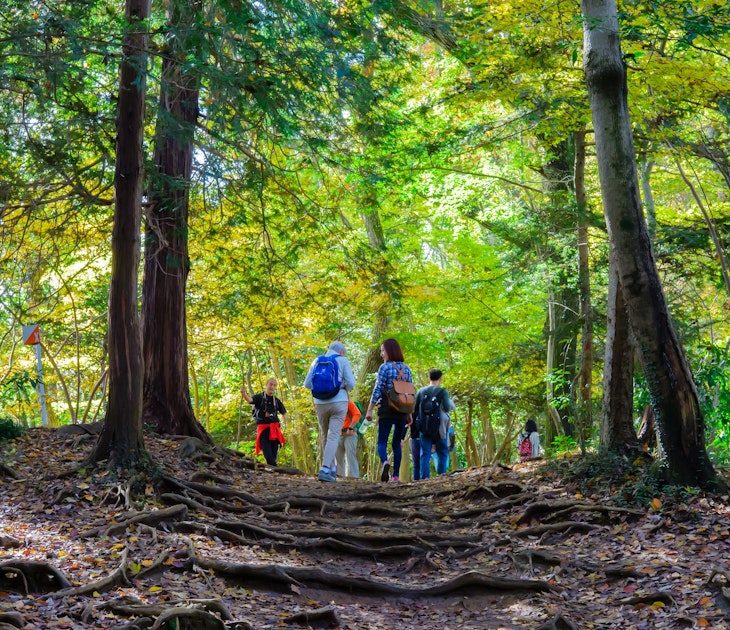
Feb 5, 2020 • 4 min read
Beautiful, spiritual and lacking crowds, Mt Takao could be the perfect complement to a Mt Fuji trek, and one of Tokyo’s most enjoyable day trips.

Oct 4, 2019 • 6 min read
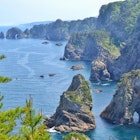
Sep 24, 2019 • 5 min read
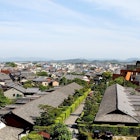
May 26, 2016 • 6 min read

Apr 14, 2024 • 6 min read

Apr 2, 2024 • 10 min read

Mar 26, 2024 • 8 min read

Mar 25, 2024 • 6 min read

Mar 25, 2024 • 10 min read

- Kumano Kodo Guide: All you need to know to hike Japan’s ancient pilgrimage trails
This article may contain links to products and services we use and recommend. We may receive compensation when you click on links to those products. For more information, see our Disclosure Policy .

Download your Sustainable Travel Checklist and show the world you care
Map of accommodation, points of interest, eateries and transport, kumano sanzan - the three grand shinto shrines of the kumano kodo, kumano hongū taisha, kumano nachi taisha, kumano hayatama taisha, what to expect when hiking the kumano kodo (compared to the camino de santiago), religious/spiritual context, terrain and climate, logistics and infrastructure, what kumano kodo route to choose, description, when is the best time to hike the kumano kodo, how to get to the kumano kodo, is there public transportation along the kumano kodo, where to stay and how to book accommodation on the kumano kodo, is (wild) camping allowed on the kumano kodo, what about food (and water) on the kumano kodo, how much to carry (and where to stock up), what to do with excess luggage during the kumano kodo, luggage storage options, luggage forwarding options, how much does it cost to hike the kumano kodo, what else to know before hiking the kumano kodo, ten essential tips for a safe kumano kodo pilgrimage, do you really have the right insurance coverage, bring enough cash, get your (dual) pilgrimage recognised, where to find further information about the kumano kodo, what was your kumano kodo experience like, author: sandra rosenau.
Whether you’re after a rewarding outdoor experience or an enriching spiritual journey with one-of-a-kind hospitality, the Kumano Kodo has it all. Hiking the Kumano Kodo was one of our absolute favourite experiences in Japan (and indeed, of all times). In this guide, you will find all the information you need to create your own unforgettable memories hiking the ancient trails in the Kii Mountains of Japan .
As travellers, we should all be aware of our travel behaviour and its environmental, economic and social impact; and make conscious decisions about it. Too often, we hear negative stories in the media about tourists behaving badly.
Here is your chance to tick some boxes and check out what it really takes to travel with a sustainable mindset.
The fine print: I agree to receive the Minimalist Journeys newsletter full of news, actionable tips and practical advice every month. I know I can unsubscribe at any time. I have read and agree to the Terms of Use and Privacy Policy .
Below is a map of the recommended accommodation, points of interest, eateries and transport terminals/stops mentioned in this article.
Kumano Hongū Taisha [ Official website , Google Maps location ] is located in the centre of the Kii Mountains, at the confluence of the Kumano and Otonashi Rivers. Its original entrance is marked by the world's largest shrine gate (called Torii ) - the Ōyu no hara Torii - which is 34 metres high and 42 metres wide. Being destroyed by floods (and rebuilt) a few times in its history , Kumano Hongū Taisha was relocated from its original position by the Kumano River to higher ground nearby in 1889. Among others, Kumano Hongū Taisha enshrines Izanagi , the founding father deity of Japan .
The second Grand Shrine in the Kii Mountains is Kumano Nachi Taisha [ Official website , Google Maps location ]. It's uniquely positioned on the side of a mountain high above the Nachi River and next to Nachi Falls - at 133 metres, Japan 's tallest single-drop waterfall and the home of Hiryū Gongen , another important Shinto deity. Nachi-san (as the sacred complex is often called), is also home to Seiganto-ji, a Temple of the Tendai School of Buddhism, and a sacred 850-year-old Camphor tree, which is said to grant wishes to worshippers who walk through its hollow trunk.
The third Grand Shinto Shrine, Kumano Hayatama Taisha [ Official website , Google Maps location ] is located on the east coast of the Kii Peninsula, in Shingū City near the mouth of the Kumano River. The Grand Shrine is home to a sacred 850-year-old Podocarp tree, called Nagi no Ki . It is said that Izanagi and Izanami , the mythological couple that created Japan , first arrived in the area on a rock named Gotobiki Iwa . The rock marks the location of Kamikura-jinja, the original shrine, which pilgrims can reach by climbing a narrow 500-step stairway a few hundred meters south of the main complex.
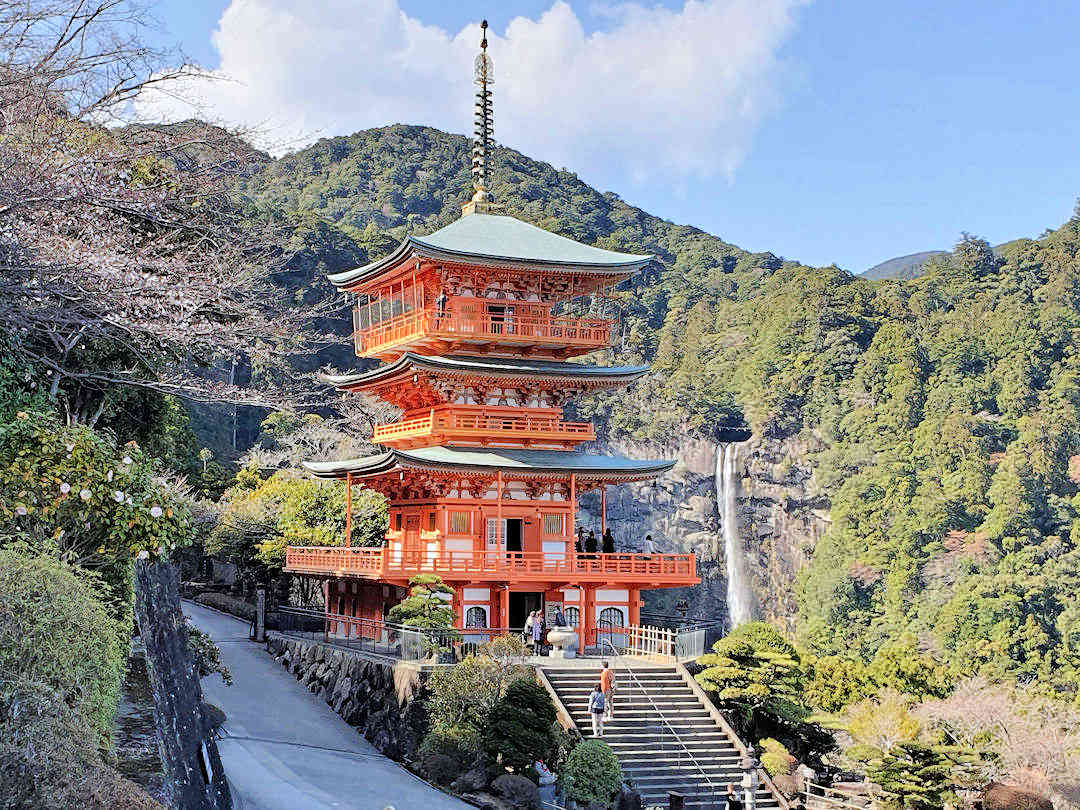
Nachi-san (which includes Nachi Falls) is one of the sacred sites connected by the trails of the Kumano Kodo
The Kumano Kodo and the Camino de Santiago are both religious/spiritual pilgrimages. However, while all routes of the Camino de Santiago end at the Cathedral of Santiago de Compostela [ Official Website , Google Maps location ], the Kumano Kodo leads to and/or connects three sacred sites (the Kumano Sanzan , Koyasan and Yoshino/Omine) – which means, between those sites, pilgrims may hike in either direction.
Both pilgrimages have pilgrim passports, and stamps can be collected along the route to receive official recognition:
- The minimum distance required for ANY of the Camino routes is 100 kilometres on foot or 200 kilometres by bicycle.
- The Kumano Kodo offers official recognition only on two of its six routes: three recognised options on the Nakahechi route and the Kohechi route from Koyasan to Kumano Hongu Taisha .
Unlike the Camino de Santiago (and surprising to us), many of the people we spoke to on the Kumano Kodo did not choose it for religious or spiritual reasons. Instead, they sought refuge from the hustle and bustle of the big cities, and a peaceful and immersive outdoor experience.

Pilgrims who do both the Camino de Santiago and the Kumano Kodo can become Dual Pilgrims
Another significant difference between the two pilgrimages is the level of difficulty. All Kumano Kodo routes are (significantly) shorter but the three mountain routes – the Omine Okugake Michi , Kohechi and Nakahechi – are (significantly) more physically demanding than the Camino routes . To give you an idea: On the Nakahechi (the easiest of the three mountain routes), we hiked 67 kilometres over five days, with an elevation gain of 3,400 meters. Long stretches of uphills and downhills, often on slippery terrain, put a strain on your feet, legs and knees. Therefore, on the mountain routes of the Kumano Kodo , a decent level of fitness is a must, and the use of trekking poles is highly recommended.
Both pilgrimages take you through some of the wettest regions of their respective countries: Galicia in Spain and the Kii Peninsula in Japan , so carrying a raincoat or poncho is essential in both cases.
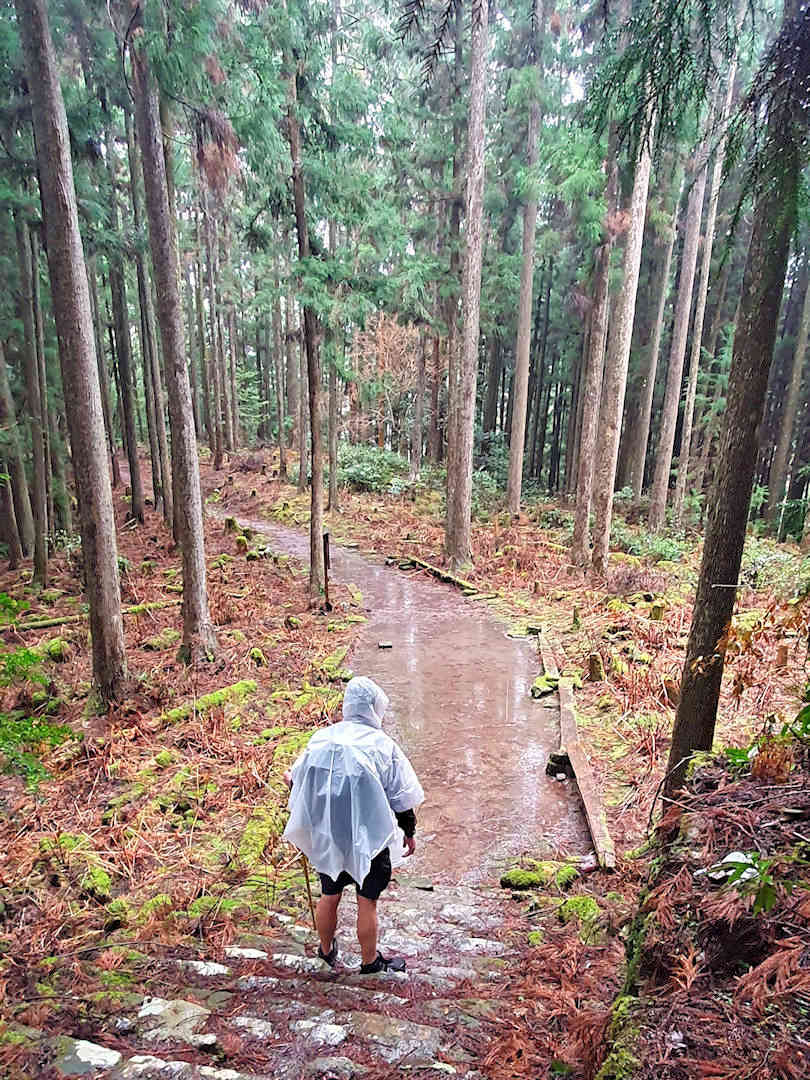
The Kii Peninsula is one of the wettest regions of Japan , so bringing a raincoat or poncho is essential when hiking the Kuman Kodo
While both pilgrimages pass through beautiful natural landscapes, the mountain routes of the Kumano Kodo – the Nakahechi , the Kohechi and the Omine Okugake Michi – lead mainly through forests and over mountain passes, and (significantly) fewer (and smaller) villages compared to the Camino. The coastal routes of the Kumano Kodo – the Iseji , the Kiiji and the Ohechi – on the other hand reminded us a bit of the Camino Portugues de la Costa .
Unlike the Camino de Santiago , where pilgrims can usually find accommodation upon arrival (especially in the off-season), lodging on the Kumano Kodo mountain routes must be booked in advance, with the availability and location of accommodation dictating the distance hiked each day. On the most challenging route, the Omine Okugake Michi , you need to bring your own camping gear.
Way markers are present on both pilgrimages, helping pilgrims to keep to the trail. In many places, signs even indicate trails that are not part of the Kumano Kodo , making it hard to get lost. Most way markers are made of wood or stone, but in some cases, especially on (parts of) the more remote mountain routes, it may just be an arrow and ribbons. So, check your whereabouts regularly using offline maps that track your GPS location.

Signs indicate trails that are not part of the Kumano Kodo , making it hard to get lost
Distance markers on the Camino count down the kilometres to the Cathedral of Santiago de Compostela (and on to Cape Finisterre). On the Kumano Kodo Nakahechi route , numbered markers (approximately every 500 meters) count up towards Kumano Hongū Taisha (and down towards Kumano Nachi Taisha ). On the last stage of the Kohechi route , 33 statues of Kannon (the Buddhist deity of compassion and mercy) count down your distance to Kumano Hongū Taisha.
The symbol of the Camino de Santiago is the scallop shell, while the Kumano Kodo is symbolised by the three-legged crow (known as Yatagarasu ).
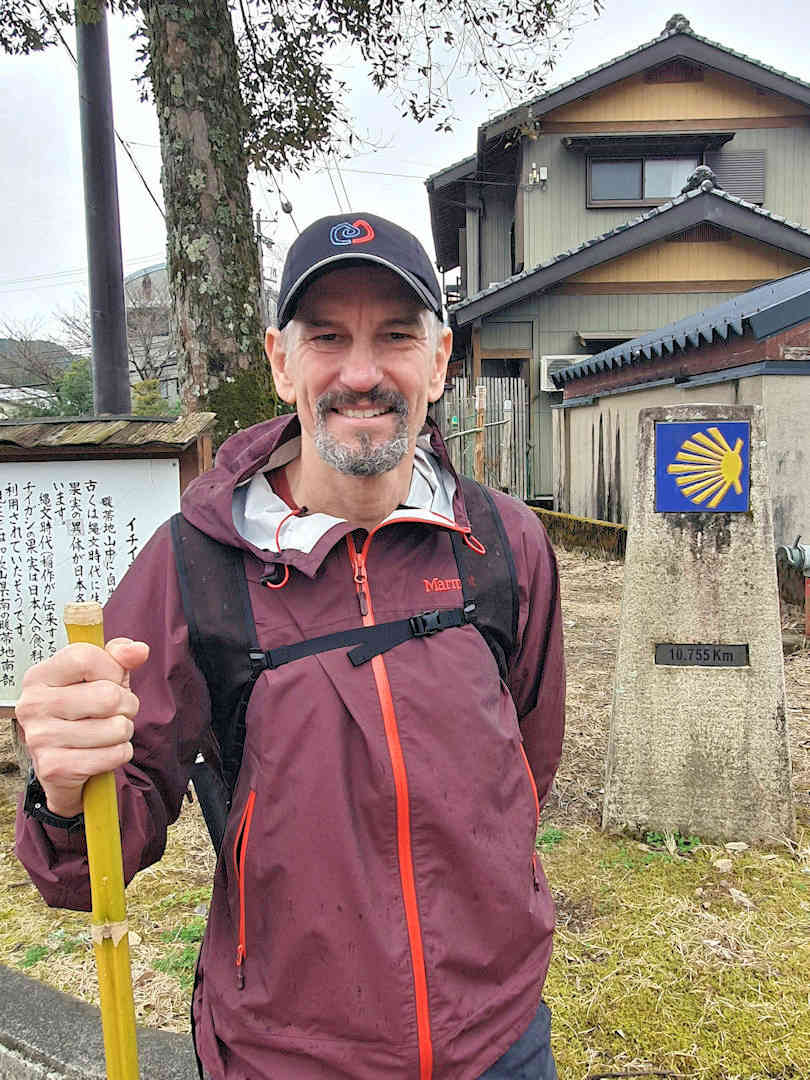
A Camino de Santiago distance marker can even be found in Hongu
Which of the six Kumano Kodo routes to choose will depend on the following:
- how many days you want to spend hiking the Kumano Kodo ,
- the time of year of your visit,
- your fitness levels,
- your thirst for adventure/risk tolerance, and
- the gear you have (and are happy to carry on your back).
The three coastal routes ( Iseji , Kiiji and Ohechi ) are relatively easy (and easily accessible) routes that can be hiked in (shorter) parts (including as day hikes ). The Nakahechi route is more challenging but still easily accessible. It can also be done in parts .
The Kohechi takes it up a notch from the Nakahechi . The complete route can only be done as a 4-day through-hike. Alternatively, the last section (from Totsukawa Onsen [ Google Maps location ] to Kumano Hongu Taisha ) can be done as a day hike . The Omine Okugake Michi is the most challenging route. It can only be done as a through-hike, though it can be shortened by two days avoiding the Ōminesan-ji Temple area.
To help you decide which Kumano Kodo route is the right one for you, we compare all six routes in more detail below (in alphabetical order):
- Omine Okugake Michi
- The eastern coastal route has a maximum elevation of approximately 700 metres.
- The most popular section is the 78-kilometre-long Central Section from Umegadani [ Google Maps location ] to Hana no Iwaya-jinja [ Official website , Google Maps location ] (the oldest Shinto shrine in Japan and gravesite of Izanami , the founding mother deity of Japan )
- The route splits at Hana no Iwaya-jinja (Kumano City) with one branch heading inland and one branch continuing along the coast.
- Scenery highlights comprise river valleys, forests, quiet villages, mountain passes, ocean views, beaches and rice paddies.
- The western coastal route has a maximum elevation of around 300 metres.
- The most popular section is from Fujishiro-jinja (Kainan) to Kii-Tanabe (approximately 80 kilometres).
- Scenery highlights comprise quiet suburban neighbourhoods and villages, Daisen-ryo Kofun/Tomb of Emperor Nintoku (Sakai City), river valleys, rural countryside, orchards, forests, mountain passes and ocean views.
- This remote mountain route has a maximum elevation of approximately 1,200 metres.
- Its northern passes are snowed in and thus closed from mid-December to mid-March.
- The final section (Totsukawa to Kumano Hongū Taisha) is open all year and can be done as a day hike.
- Scenery highlights comprise forests, mountain passes, quiet villages and onsens.
- Bear sightings are possible.
- This mountain route crosses the Kii Peninsula from West to East and has a maximum elevation of approximately 900 metres.
- Scenery highlights comprise forests, mountain passes, quiet villages, river valleys, onsens and ocean views.
- The southern coastal route has a maximum elevation of approximately 500 metres.
- Due to heavy urbanisation, only the section from Kii-Tonda to Mirozu (approximately 37 kilometres) is recommended. Another worthwhile section leads through the forest from Uragami to Fudarakusan-ji (approximately 15 kilometres).
- Scenery highlights comprise the Ago-no-Watashi ferry crossing, mountain passes, forests and ocean views.
- This very remote alpine mountain route through Yoshino Kumano National Park has a maximum elevation of 1,900 metres.
- The route is largely uninhabited. It is a training route for Shugendō practitioners (mountain ascetics) from early May to end of September.
- Large drops are frequent, and some sections along cliff faces and ridgelines require the use of (installed) ladders, ropes and chains.
- Scenery highlights comprise mountain passes, forests, river valleys and panoramic mountain vistas.
- The Ōminesan-ji temple area is inaccessible to women, requiring a detour (or more southern start) for female hikers.
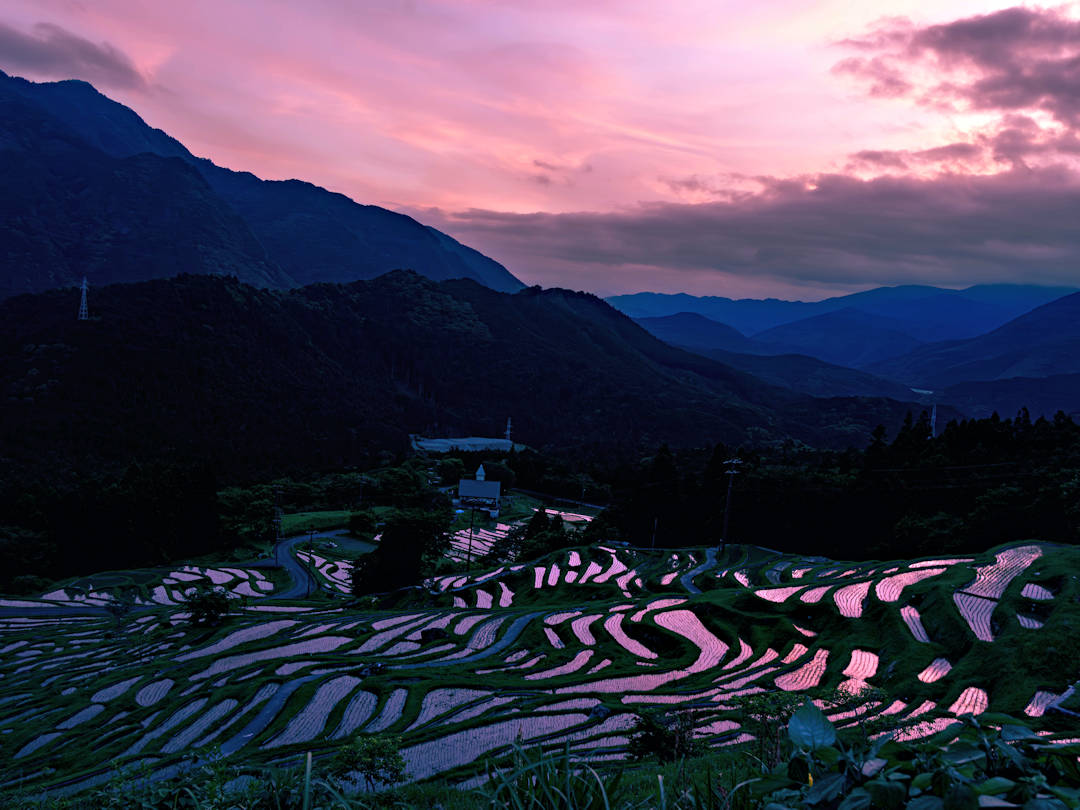
A small detour on the Iseji route takes you past the Maruyama Senmaida rice terraces | Photo by Soichiro Ito on Unsplash
The best time to hike any of the Kumano Kodo routes is in Spring (March to May) or Autumn (mid-September, through October and November, and into early December): The temperatures are perfect for hiking, there is enough daylight to finish each day’s stage without stress, and all service providers are open for business. On top of that:
- In Spring, you can witness the beautiful blooming of flowers and trees (including cherry trees).
- Autumn is a great time to enjoy the vibrant colours of the foliage change.
If you want to hike the Kumano Kodo in Winter (December to February), we can only recommend the coastal routes ( Iseji , Kiiji and Ohechi ) and the section from Hosshinmon-oji to Kumano Hongū Taisha on the Nakahechi route . Hiking all other Kumano Kodo routes in Winter is not recommended (even impossible) for various reasons: the days are shorter leaving you insufficient time to finish stages during daylight hours and alpine mountain passes are snowed in (and thus closed from mid-December to mid-March).
Summer (June to August) is typhoon season, which means it is hot and humid, with a lot more rain (and wind), making it less ideal for hiking. Summer also means some nasty critters are way more active (more on that below).
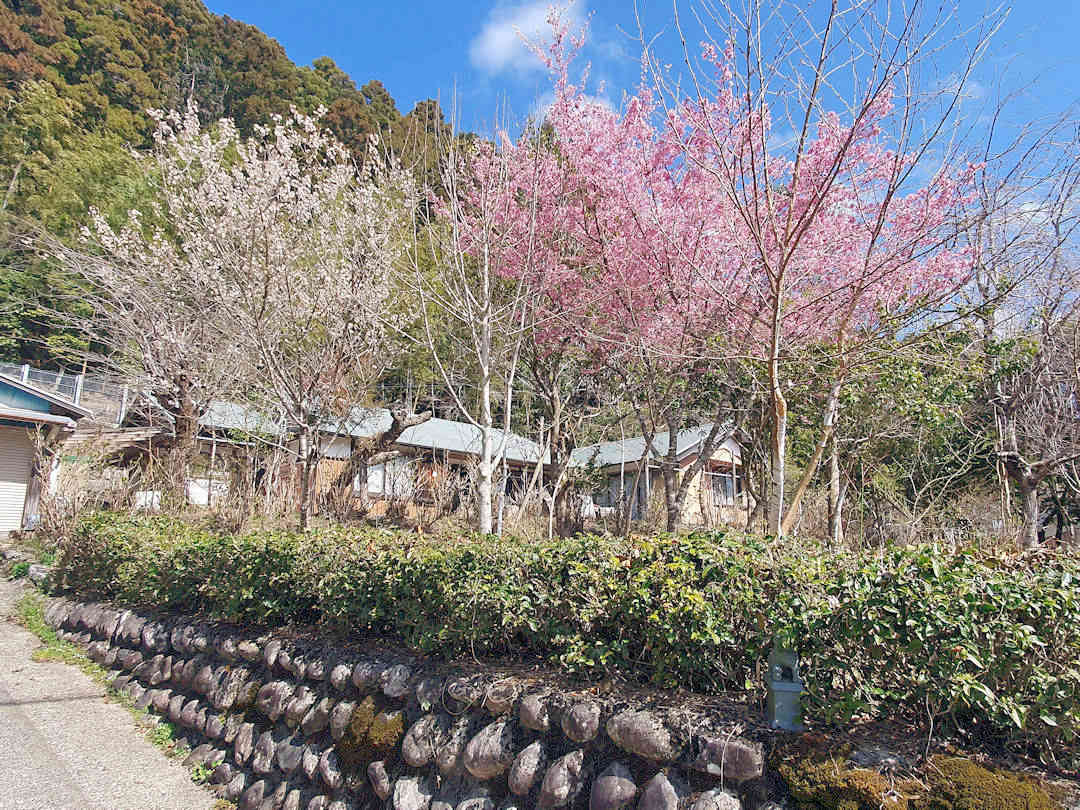
Spring is one of the best seasons to hike the Kumano Kodo
Getting to the Kumano Kodo is relatively straightforward, especially when using Japan ’s efficient public transportation network, but it does take time.
The Kii Peninsula is south of and roughly halfway between Osaka and Nagoya. The nearest international airports are Kansai International Airport [ Google Maps location , IATA: KIX] located on an island south of Osaka, and Chubu Centrair International Airport [ Google Maps location , IATA: NGO) on an island south of Nagoya. The closest regional airport is Nanki-Shirahama Airport [ Google Maps location , IATA: SHM], south of Kii-Tanabe, which has regular flights from/to Tokyo International Airport (Haneda) [ Google Maps location , IATA: HND].
The most common access points to the Kumano Kodo are as follows:
- Ise City (Iseshi): The JR Rapid Mie train takes 1.5 hours from Nagoya Station. From Iseshi Station, a bus ride of approximately 30 minutes will get you to Ise-Jingū Naiku .
- Umegadani: It takes just under 3 hours from Nagoya Station on the JR Nanki Limited Express and JR Kisei Local Shingū trains (a change is needed at Taki Station).
- Kumanoshi (the nearest train station to Hana-no-Iwaya-jinja ): The JR Nanki Limited Express takes just over 3.5 hours.
- Hachikenya-hama is just outside Osaka’s Temmabashi Station (Tenmabashi-eki).
- Kainan (the nearest train station to Fujishiro-jinja ): The JR Kuroshio takes just under 1 hour and 15 minutes from Shin-Osaka or Osaka Stations.
Getting to Kōyasan requires the use of multiple modes of transportation (none are covered by the JR Pass ):
- The Nankai Limited Express or Nankai Koya Line trains from Osaka’s Namba Station to Gokurakubashi Station take 1 hour and 30-45 minutes.
- From Gokurakubashi Station, the Nankai Koyasan Cable car takes you to Kōyasan Station in 5 minutes.
- The bus ride from Kōyasan Station to the trailhead near the Senjuin-Bashi bus stop takes 10 minutes.
If you are planning to hike from Kumano Hongū Taisha to Kōyasan, your closest access points are Shingū and Kii-Tanabe (with bus rides from there taking between 1 hour and 1 hour 45 minutes) – see below on how to get to both from Nagoya/Osaka.
- Kii-Tanabe (the nearest town on the western side of the Kii Mountains) – The JR Kuroshio Limited Express train gets you there from Shin-Osaka or Osaka Stations in just under 2.5 hours.
- Kii-Katsuura and Shingū (the nearest towns on the eastern side of the Kii Peninsula) – From Nagoya Station, Shingū can be reached on the JR Nanki Limited Express train in approximately 3 1/2 hours (and Kii-Katsuura in about 4 hours). If you’re coming from Shin-Osaka or Osaka Stations, the JR Kuroshio Limited Express train takes about 4 hours to Kii-Katsuura (and 4 hours 15 minutes to Shingū).
From either of those access points, a bus ride is required to get to the starting point of your hike. Pending the route and starting point that is selected, this bus ride can take anywhere between 25 minutes and 2 1/2 hours. As the route and starting point chosen, determines which access point is most suitable, we’ll cover this topic in more detail in our sample itineraries (link).
- Kii-Tanabe is also the closest train station to Tokei-jinja – see above on how to get to Kii-Tanabe from Osaka.
- From Kii-Tanabe, the JR Kinokuni Local Shingū train takes you in just under an hour to Mirozu , 1 hour 45 minutes to Kii-Uragami and just over 2 hours to Nachi Station . The bus ride from Nachi Station to Nachi-san takes just under 20 minutes.
- Yoshino is the nearest train station to Yoshino Kinpusen-ji . It can be reached from Osaka’s Abenobashi Station using the Kintetsu Limited Express train in just over 1 hour and 15 minutes. The nearby ropeway, one of the oldest in Japan , whisks you up the mountain in under 5 minutes. The Kintetsu trains are not covered by the JR Pass .
- If you are planning to hike from Kumano Hongū Taisha to Yoshino Kinpusen-ji, your closest access points are Shingū and Kii-Tanabe (with bus rides from there taking between 1 hour and 1 hour 45 minutes) – see above on how to get to both from Nagoya/Osaka.
Given the time it takes to get to most access points, it is not recommended to travel from Nagoya, Osaka or further afield on the day you plan to start your hike. Likewise, we do not recommend booking your flight out of Kansai International Airport [ Google Maps location , IATA: KIX] or Chubu Centrair International Airport [ Google Maps location , IATA: NGO) on your last day of hiking.
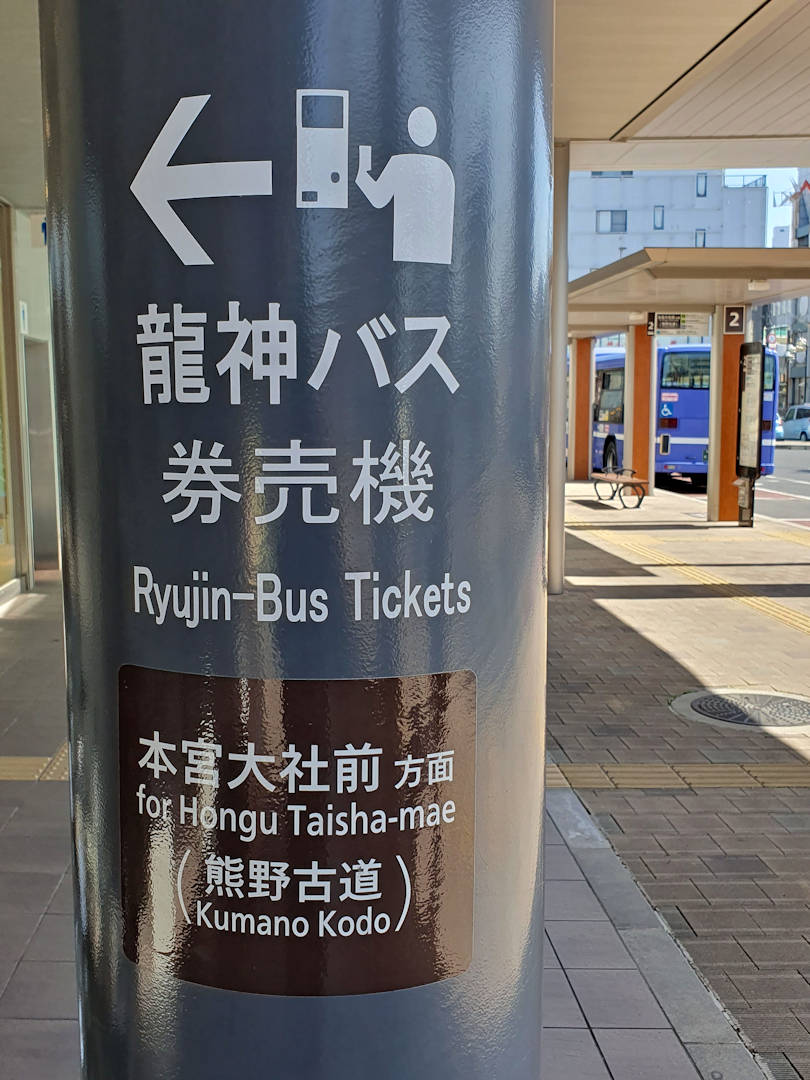
Buses are the predominant mode of transportation in the Kii Mountains
The short answer: It depends. The three coastal routes are loosely traced by railway lines (and some local buses), making it relatively easy to join/leave the routes.
It’s different for the three mountain routes where buses are the only form of public transportation (if they exist at all). The ancient Kumano Kodo mountain routes do not follow the modern road network (or vice versa), so the opportunities to join/leave the mountain routes of the Kumano Kodo are limited to the few occasions where the routes meet the roads on the bus network. Furthermore, buses go very infrequently. So pending the schedule, you may have to wait a few hours until the next bus arrives.
Out of the three mountain routes, the Nakahechi is best serviced by buses , and you can join/leave the Kumano Kodo at various points. Check our itineraries for recommendations on common entry/exit points and the Tanabe City Kumano Tourism Bureau website for up-to-date bus timetables .

Make sure to check the bus schedule as buses on the Kii Peninsula are very infrequent
Traditional Japanese inns (known as Minshukus and Ryokans ) are the most common form of accommodation on the Kumano Kodo (except the Omine Okugake Michi route ), offering a unique cultural experience:
- You will be sleeping on futons in rooms with tatami floors and paper-thin sliding doors (if you’re a light sleeper: bring earplugs, just in case).
- Bathrooms are shared among the guests.
- Many of these inns have onsens (hot springs), which provide a blissful way to relax and rejuvenate after a long day of hiking.
- Most inns also offer home-cooked meals by way of meal plans (more on that below).
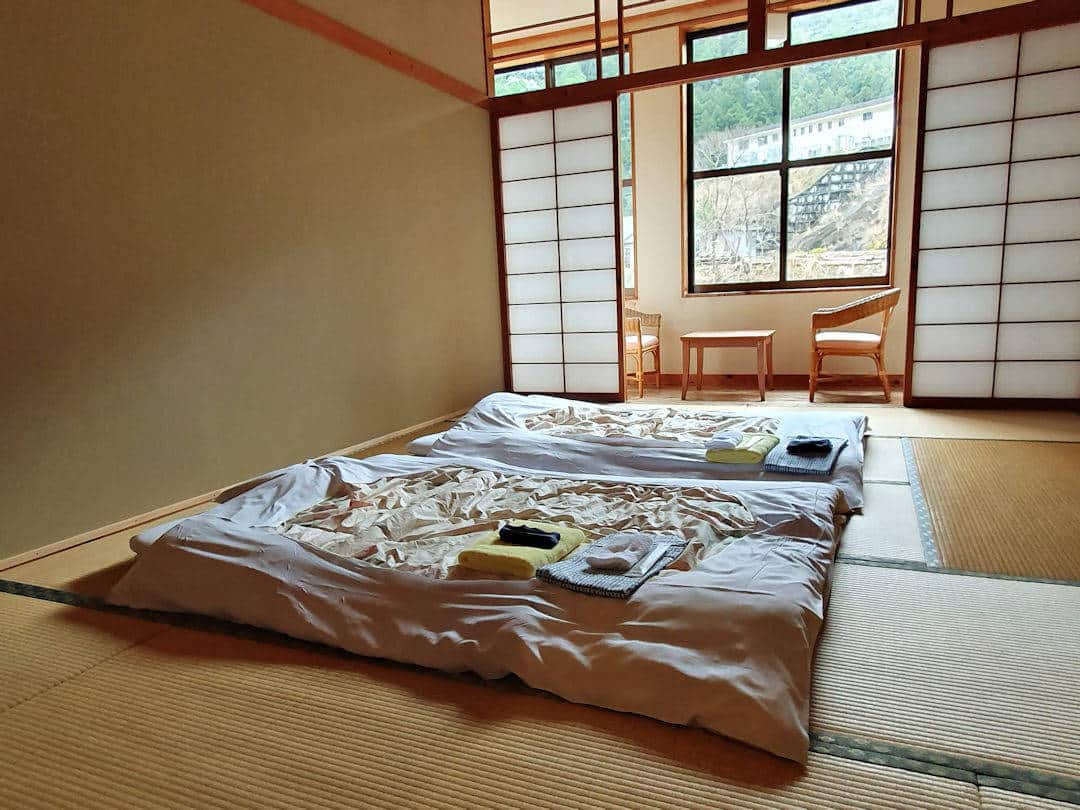
Traditional Japanese inns are the most common form of accommodation on the Kumano Kodo
Accommodation options along the Kumano Kodo are limited, especially on the Kohechi and Nakahechi . We, therefore, recommend booking all your accommodation (well) in advance.
Traditional inns are run by local families, who often don’t speak English (or very little). If you speak Japanese, you can contact the inns and make your reservation by phone (or fax) – email is still relatively uncommon.
If you don’t speak Japanese use booking platforms such as Agoda or Booking.com , which list some guesthouses along the trail and provide a convenient and familiar way to secure your accommodation (we booked three of our five nights through these platforms), or make your reservation via the Kumano Travel website .
For easy reference, here are our accommodation recommendations on the Kumano Kodo Nakahechi route (* where we stayed):
- Kii-Tanabe area
- Chikatsuyu/ Nonaka area
- Nachisan/ Kii-Katsuura
- Guest Cafe Kuchikumano * is a 1-star guest house with 5-star service. Highly recommended as a great starting accommodation for your pilgrimage.
- Guesthouse Ogawaya has free WiFi, washing machine and a fully equipped kitchenette with a microwave and toaster.
- Guesthouse Takao , a 3-star property also has a restaurant to make your stay more indulgent and memorable.
- Minshuku Momiji-no-Sato is a small rental house at the east end of the sleepy main street of Chikatsuyu village, directly on the Kumano Kodo route. It can booked through Kumano Travel .
- Guest House AGAE (pronounced "ah-gah-eh") is a lovingly renovated rental house in Chikatsuyu village. It too is booked through Kumano Travel .
- Minshuku Nakano * is a family-run guesthouse located in the southern part of Chikatsuyu village. The shared lounge area is nice.
- J-Hoppers Kumano Yunomine Guesthouse * is situated in Hongu, a 10-minute drive away or a 70-minute walk on the Kumano Kodo Pilgrimage Route from Kumano Hongu Taisha Grand Shrine.
- Guesthouse Yui is a 2-star accommodation, but don't let the star rating fool you. Guesthouse Yui is situated in Hongu, 8.5 km from Hosshinmon Oji Shrine and 23 km from Kumanokodo Nakahechi Museum of Art.
- Guesthouse Okagesan has two Japanese-style rooms, a living room, kitchen, bathroom and toilet in the property. Couples particularly like the location.
- Koguchi Shizen-no-Ie * is an old junior high school that has been beautifully renovated as a lodge.
- @koguchi is like a home-away-from-home in this remote mountain settlement. It can be booked through Kumano Travel .
- Minshuku Momofuku is run by Mr. Nakazawa, a friendly retiree. This tiny guesthouse has only two rooms and can also only be booked through Kumano Travel .
- Minpaku Kodo was a family home that was re-purposed into a guesthouse.
- Oyado Hana * has a pleasnt hot spring bath, but with small accommodation rooms.
- Chochu Stay So House is a very clean property near public transport.
- Hanare is located within 600 metres of Kamikura Shrine and less than 1 km of Kumano Hayatama Taisha . It features accommodation with a shared lounge and free WiFi throughout the property as well as free private parking for guests who drive.
- Kokoyui Guesthouse Shingu is a beautiful, modern-looking, renovated older Japanese home in a quiet residential area of Shingu City.and can be booked through Kumano Travel .
- Shingu Guest House has private accommodation in Shingu with access to a garden, a shared lounge, as well as a shared kitchen.
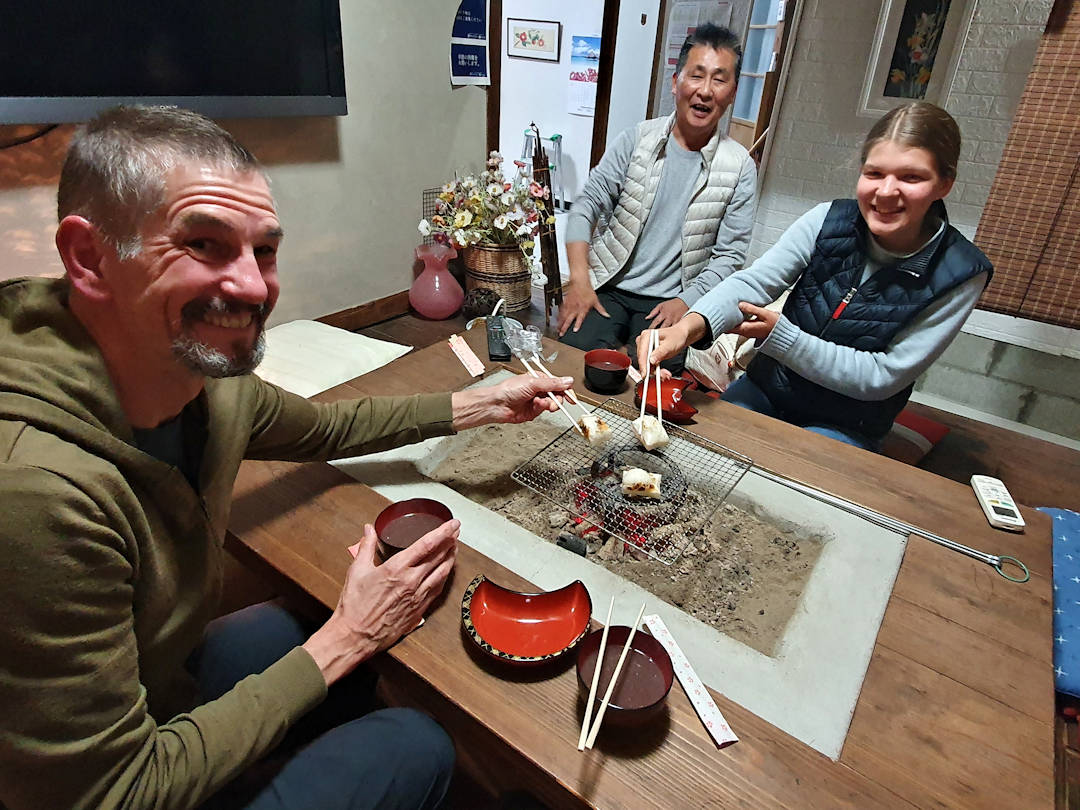
Interacting with your Japanese hosts and other guests is a wonderful experience
Kumano Travel [ Official website ] is a locally run agency that connects pilgrims with guesthouses and local activities. The Kumano Travel website provides a list of guesthouses in each location, along with details on meal plans, pricing and reviews . Once you have found an inn you like, complete a booking request and send it off. Kumano Travel typically responds within 24 hours, either confirming your booking or providing alternative options if your preferred guesthouse is not available.
It is important to note that Kumano Travel ’s cancellation policy is quite strict, so it is essential to review the terms and conditions before making a booking. Once you have paid for your accommodation through the booking system, you will receive a booking confirmation, which you then present to your inn upon arrival.
On the Kumano Kodo , camping outside of designated campgrounds is only allowed on the Omine Okugake Michi route , where the Misen Hut is the only serviced accommodation option among otherwise basic unstaffed mountain huts and other shelters (the latter operating on a first come/first served basis).
There are a number of campgrounds on the
- Iseji: Naosobimura , Ise-Kashiwazaki , Furusato Onsen and Owase
- Kohechi: Omata
- Nakahechi: Chikatsuyu , Kawayu Onsen , Watase Onsen and Koguchi
- Ohechi: Kii-Tanabe , Tonda and Susami .
Some campgrounds may be located off the actual Kumano Kodo trail, requiring additional walking from/to the trailhead. Advance booking is recommended (especially during Golden Week). Other than dedicated campgrounds, you may also be able to camp on private land in the villages you pass through (after asking for permission).
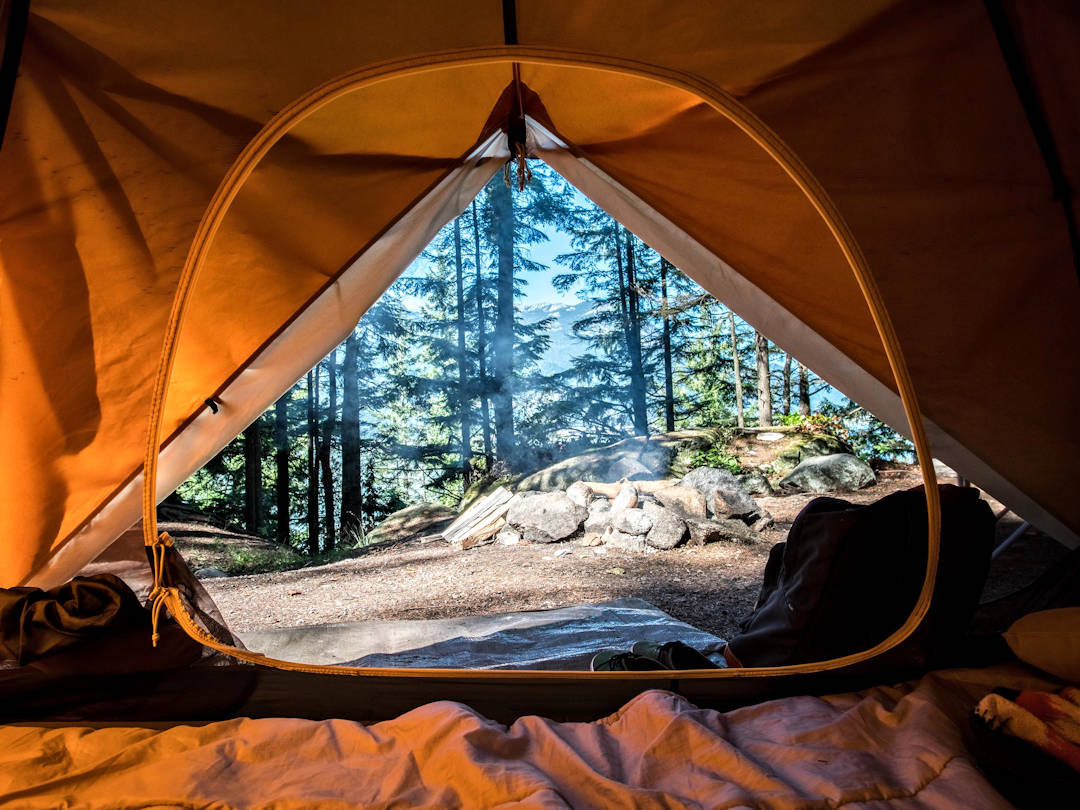
On the Kumano Kodo , camping outside of designated campgrounds is only allowed on the Omine Okugake Michi route | Photo by Scott Goodwill on Unsplash
How much food and water you should carry when hiking the Kumano Kodo will depend on the route you choose and the number of days you are planning to hike. Also, when booking accommodation in Japan (not just on the Kumano Kodo ), you are commonly offered a meal plan – for example, dinner only / breakfast only (one meal), dinner and breakfast (two meals) OR dinner, breakfast and lunchbox (three meals). It may make sense to book a meal plan depending on the route you choose.
We’ll talk about both in more detail below.
- Iseji, Kiiji and Ohechi
The coastal routes regularly pass through villages with small grocery stores/convenience stores or family-run restaurants, which means you can stock up (at least) at the end of each day and generally only need to carry enough food and water to sustain yourself through the day.
That said, shops and restaurants may not be open on the day of your hike, so always bring extra food. The coastal routes are also routes where you can find drink vending machines (at relatively regular intervals). To reduce the amount of plastic waste, however, we recommend refilling your water bottle at your accommodation before you start your hiking day.
Given the prevalence of shops and eateries along the coastal routes, booking a meal plan is not generally needed. Do check though in advance that the shops and/or eateries you intend to visit are open on the day of your hike.
There are hardly any shops or restaurants in the small villages you stay in on this route, thus booking a meal plan is recommended (see below). There are some water refill opportunities along the Kohechi but you can’t rely on them, so make sure to fill up your water bottle each morning (and en route as needed).
Given the remoteness of the trail and the lack of shops/restaurants, we recommend booking a full meal plan (dinner, breakfast and lunch box) for each of your overnight stays on this route.
On the Nakahechi route , you will pass through and stay in small villages (with small shops and eateries), thus you only need to carry enough food and water to sustain yourself through the day. That said, we would encourage you to always carry extra food as these small businesses may not be open when you need them.
Some guest houses also sell food items to guests (for example, instant noodles, microwaveable meals, biscuits and muesli bars). And if you pass through Yunomine Onsen, you can boil eggs and sweet potatoes in the hot spring:
- You can buy both at the small grocery store across the road, but Yumune Chaya , the teahouse adjacent to the Yumune Kusushi Tōkō-ji Temple (squeezed between the river and the public onsen), offers the best price.
- Hang the little bags the eggs/sweet potatoes are sold in on the nails in the wooden frame around the hot spring and wait until they’re done (around 10-15 minutes).
While there are some places along the trail where you can fill up your water bottle, they are not as frequent. Therefore, it is advisable to fill up your water bottle at your accommodation before starting your hike in the morning (and en route as needed).
We hiked the Nakahechi route largely without a meal plan, buying provisions for breakfast and lunch (sandwiches, boiled eggs, rice balls, etc) before our hike and at the small shops along the route, and eating dinner at one of the small restaurants in the villages or buying ingredients to cook at our accommodation.
That said, if you are hiking on a Sunday (when most shops are closed), stay in the accommodation without a guest kitchen (most of them don’t have one) OR if you are hiking from Kumano Hongu Taisha to Kumano Nachi Taisha (or vice versa), we recommend to include a meal plan (for peace of mind and the experience). Our dinner in Koguchi was huge, the buffet breakfast (with scrambled eggs, sausages/bacon and toast) a good base, and our lunchbox (supplemented with snacks) sufficient to get us through the day.
Given the remoteness of this route, you will have to carry sufficient food for your entire hike – only the Misen Hut offers meals, and there are no villages along the route. Some mountain huts provide the opportunity to refill your water bottle, otherwise, you will need to refill from mountain streams (though they are not always reliable, so make sure you fill up at every opportunity).
The Misen Hut is the only serviced accommodation along this route. If you’re planning to stay in the hut, booking the full meal plan is recommended.
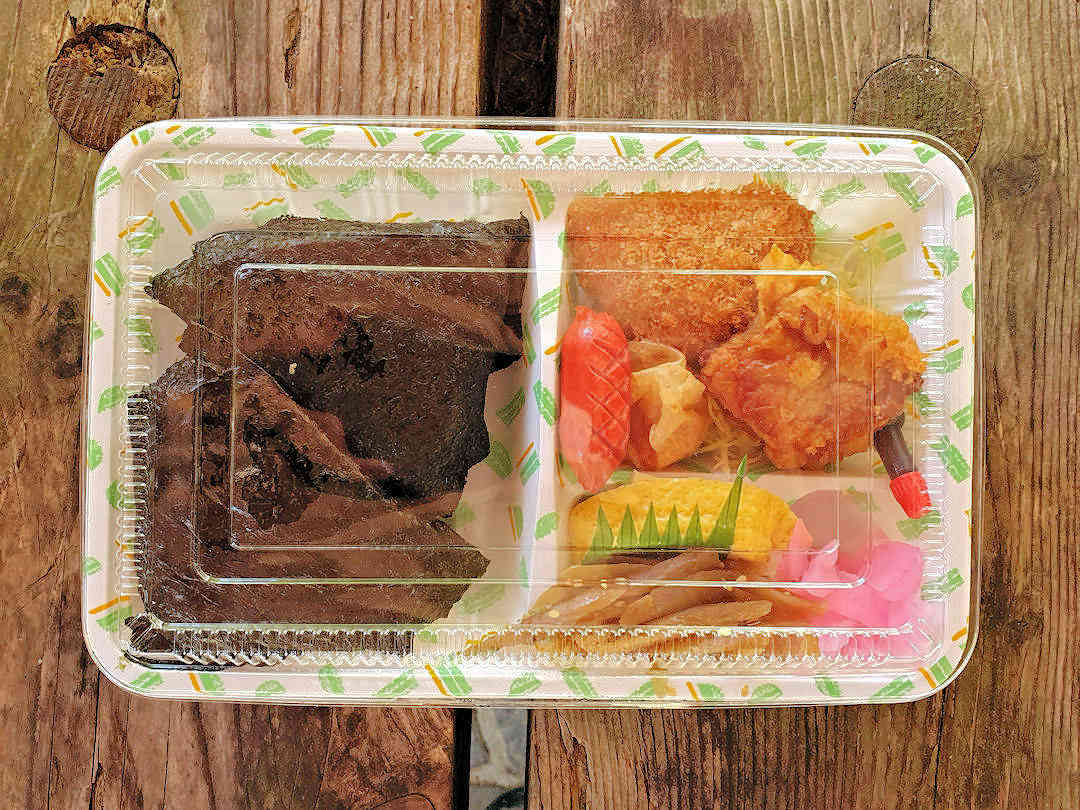
Meal plans with lunch boxes can be a worthwhile inclusion when booking accommodation along the Kumano Kodo
Chances are that you don’t just come to Japan to hike the Kumano Kodo . So what do you do with any luggage you don’t need to be schlepping around with you on the trails? You can either store any excess luggage (and pick it up afterwards) or forward it to your next destination.
Before we headed to the Kii Peninsula, we reduced the content of our travel packs to the absolute minimum, leaving everything we didn’t need (including our laptops) in a separate bag in Osaka. If you need a place to store your excess luggage, Daikoku near Osaka’s Shin-Imamiya Station is a safe and convenient option. With storage costs for a medium-sized bag of JPY80 per day, Daikoku is also significantly more affordable than coin lockers (which have a time limit as well).
If you’re travelling through Kii-Tanabe, you can also store your excess luggage at the Tanabe Tourist Information Center (next to the train station) for JPY500 per bag/day.
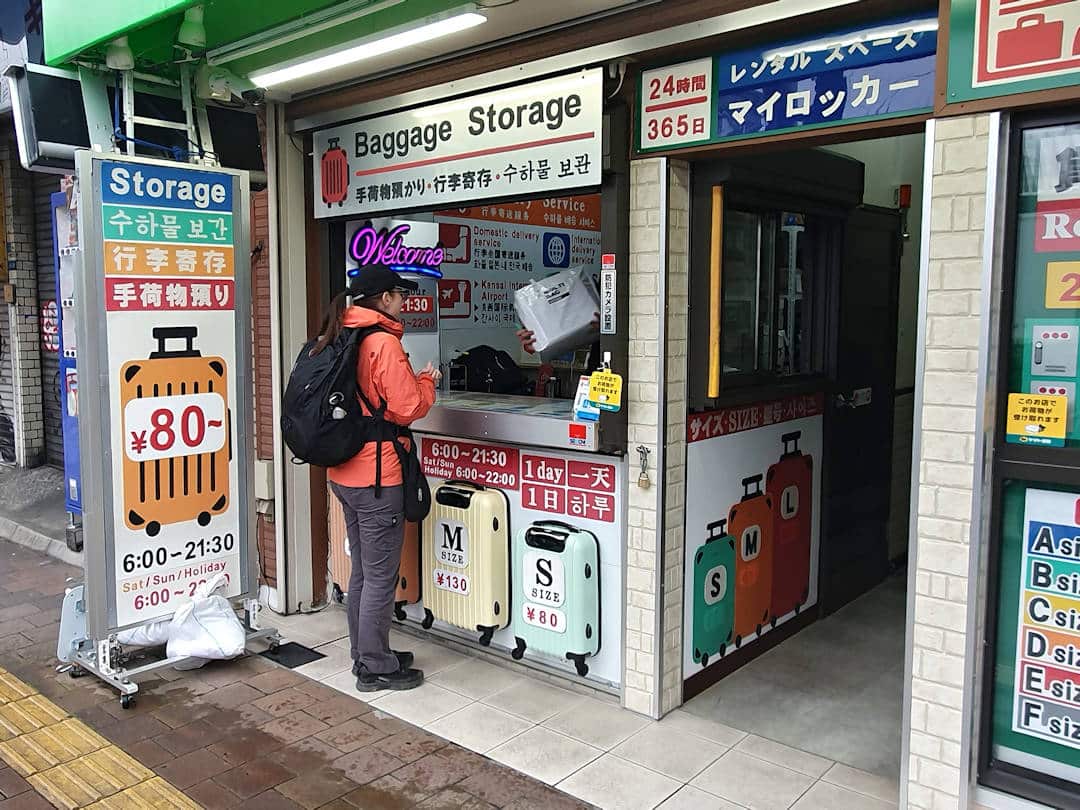
Daikoku near Osaka’s Shin-Imamiya Station is a safe and affordable option to store luggage while hiking the Kumano Kodo
If you only want to carry a daypack with food and water but have your main luggage available at your accommodation each night, same-day luggage forwarding services are available along the Nakahechi and Kohechi routes. The best is to ask your accommodations (or Kumano Travel ) to organise this for you. The service is not cheap though: budget between JPY2,500 and JPY5,500 per bag/day.
If you want to hike the Kumano Kodo with a reduced pack and have your excess luggage join you after your hike, you can also forward your excess luggage to your post-hike destination. We did this when hiking the Nakasendo , using Yamato and paying JPY1,620 for one travel pack from Osaka to Matsumoto.

Same-day luggage forwarding is available along the Nakahechi and Kohechi routes of the Kumano Kodo
Over the six nights we spent on the Kumano Kodo ( Nakahechi route ) in March 2023, we spent an average of JPY7,150 per person per night. This includes four night’s accommodation in traditional Japanese inns and two nights’ accommodation in a hostel (all private rooms), all food/beverages, luggage storage (one bag/one week) and luggage forwarding (one bag/same day) as well as public bus transportation on the Kumano Kodo . Not included is the train journey to Kii-Tanabe/from Kii-Katsuura.
For more details, check out how to budget like a pro: How much does it cost to hike the Kumano Kodo?
For over 1000 years, people from all levels of society have attempted the Kumano Kodo pilgrimage - sadly not all of them survived it. Even today, some areas along the Kumano Kodo don't have mobile phone coverage and/or offer limited access to emergency services to reach injured pilgrims.
So, do heed our advice to make sure you and your hiking pals have a safe and enjoyable experience:
- Do not attempt to hike in the dark. Make sure you leave early in order to have plenty of time to enjoy your hike, take sufficient breaks and arrive well before sunset at your next accommodation.
- Carry enough food and water to sustain yourself. Many of the routes are physically demanding, so it is vital to stay hydrated and keep your energy levels up.
- Protecting yourself from the sun is also important. Apply sunscreen and wear a hat, especially on sunny days - while you hike through forests for most of the day, you can get sunburned.
- Insect repellent may also be necessary during the summer months to protect yourself from bugs and mosquitoes.
- Most injuries on the Kumano Kodo are from slips and falls as many of the old moss-covered stones or wooden planks are slippery (even when not wet). Take your time and watch your step, especially on downhill sections. Where possible, walk along the side of cobble-stoned sections where leaves and tree roots provide a safer surface. Trekking poles are also recommended.
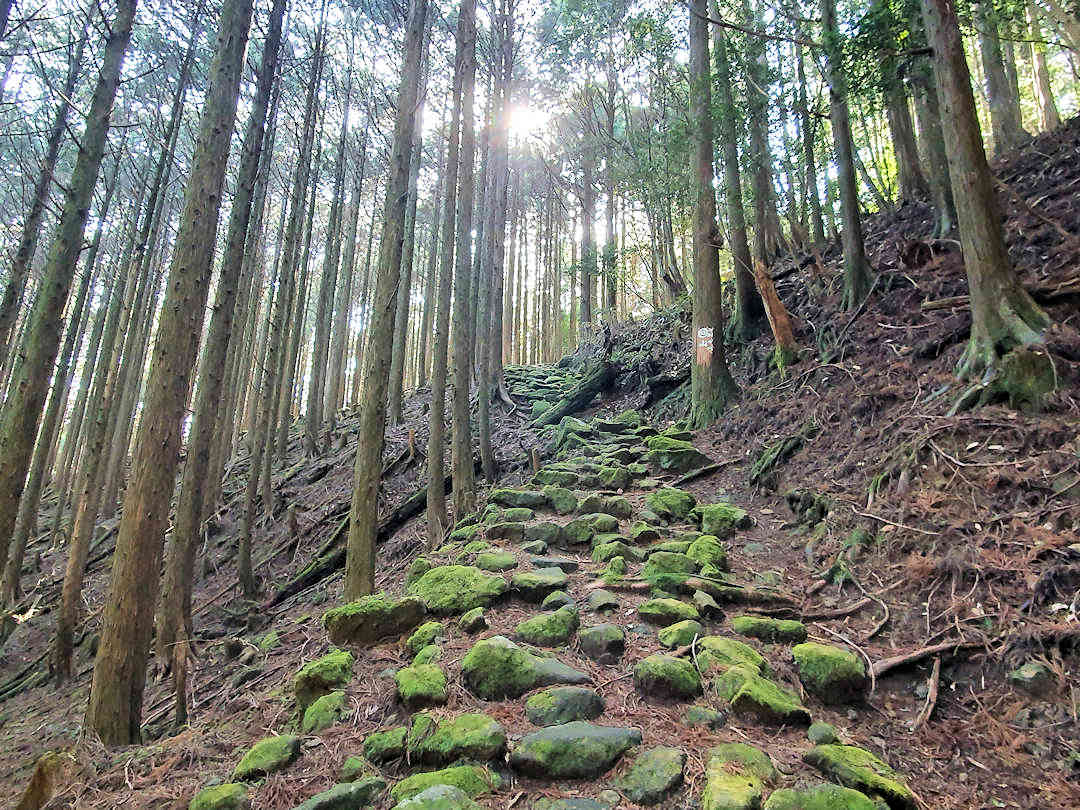
Most injuries on the Kumano Kodo are from slips and falls, so watch your steps on those slippery moss-covered stones
- Bring a Personal Locator Beacon if you are planning to hike one of the more remote routes (especially on the Omine Okugake Michi ) - mobile phone coverage on those routes is limited to non-existent.
- While you are not likely to encounter bears on the more frequented routes (including the Nakahechi ), Asian black bears do roam the Kii Mountains, and carrying a bear bell is advised when hiking more remote trails. For further information on bear safety check out this post.
- Other potentially dangerous animals include the venomous Mamushi snake (a small pit viper 50 to 80 centimetres long), the Mukade (a black centipede with orange legs about the length of an adult hand with a very painful bite), and the giant hornet known as Suzumebachi. These critters are most active during the summer months. If you are bitten by a snake call emergency services (119) immediately.
- Summer (June to August) is also typhoon season. Typhoons can bring very strong winds, heavy rainfalls, flash floods and landslides, making it unsafe to hike (you will see some of the damage from prior typhoons along the trails). Stay up-to-date with the latest weather conditions to ensure your safety .
- In the event of an accident or bite, you may end up in hospital. While Japanese medical facilities are great, they are not cheap. So, do make sure to buy travel insurance for your trip.
Having insurance can be a lifesaver (or a nuisance). Our step-by-step guide helps you find a policy that suits your needs.

Asian black bears roam the Kii Mountains and carrying a bear bell is advised on remote Kumano Kodo trails
It is important to bring plenty of cash as very few businesses along any of the Kumano Kodo routes accept credit cards, and ATMs that accept foreign cards are not readily available (and may charge withdrawal fees). Read more about how much it does cost to hike the Kumano Kodo .
If you want to have your pilgrimage recognised (particularly if you have completed or are planning to also walk the Camino de Santiago )
- Pick up a pilgrim passport free of charge at the Tanabe Tourist Information Center [ Official website , Google Maps location ].
- Make sure you collect stamps along the route. They can be found at many of the small shrines ( oji ) along the trail (look out for the small huts on poles) and are proof that you actually walked the route. Also, don’t forget your completion stamp.
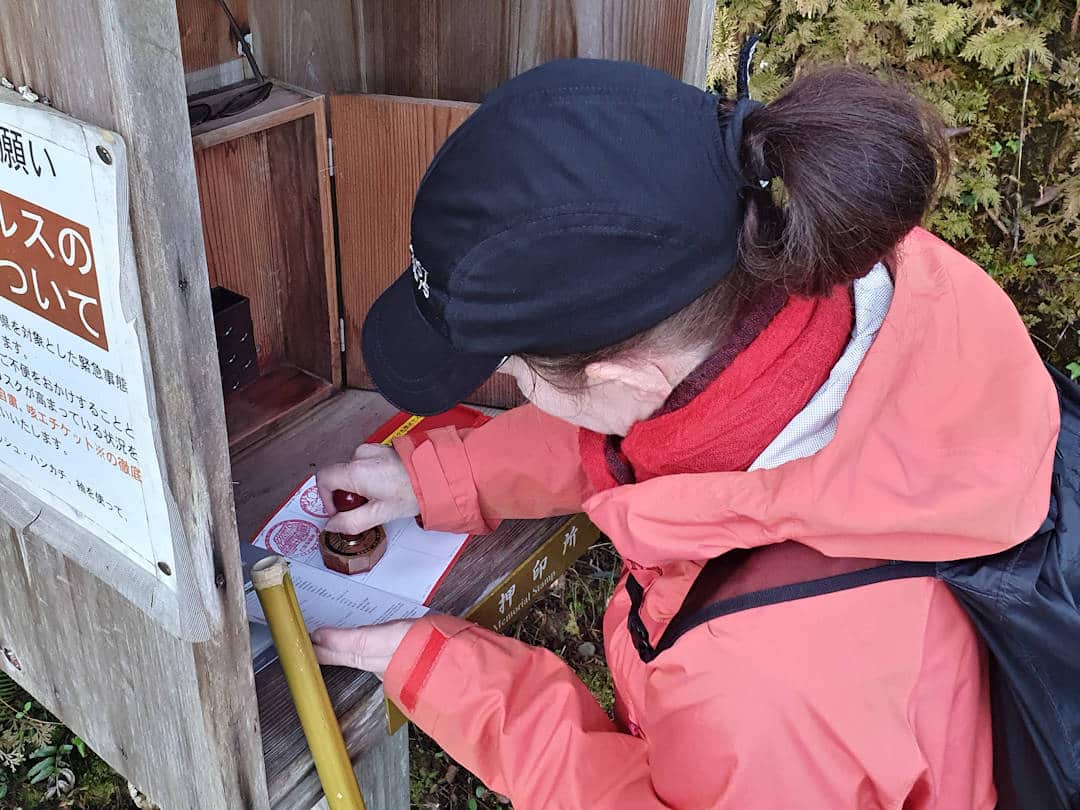
Collect stamps along the Kumano Kodo if you want to have your pilgrimage (officially) recognised
If you’ve already completed the Camino de Santiago and would like to be recognised as a dual pilgrim, head to the Kumano Hongu Heritage Center [ Official website , Google Maps location ] across the road from Kumano Hongu Taisha OR to the Tanabe Tourist Information Center for your dual pilgrimage registration:
- You need a copy of your Camino de Santiago Pilgrims certificate – a digital copy is sufficient.
- The registration process takes about 10 minutes.
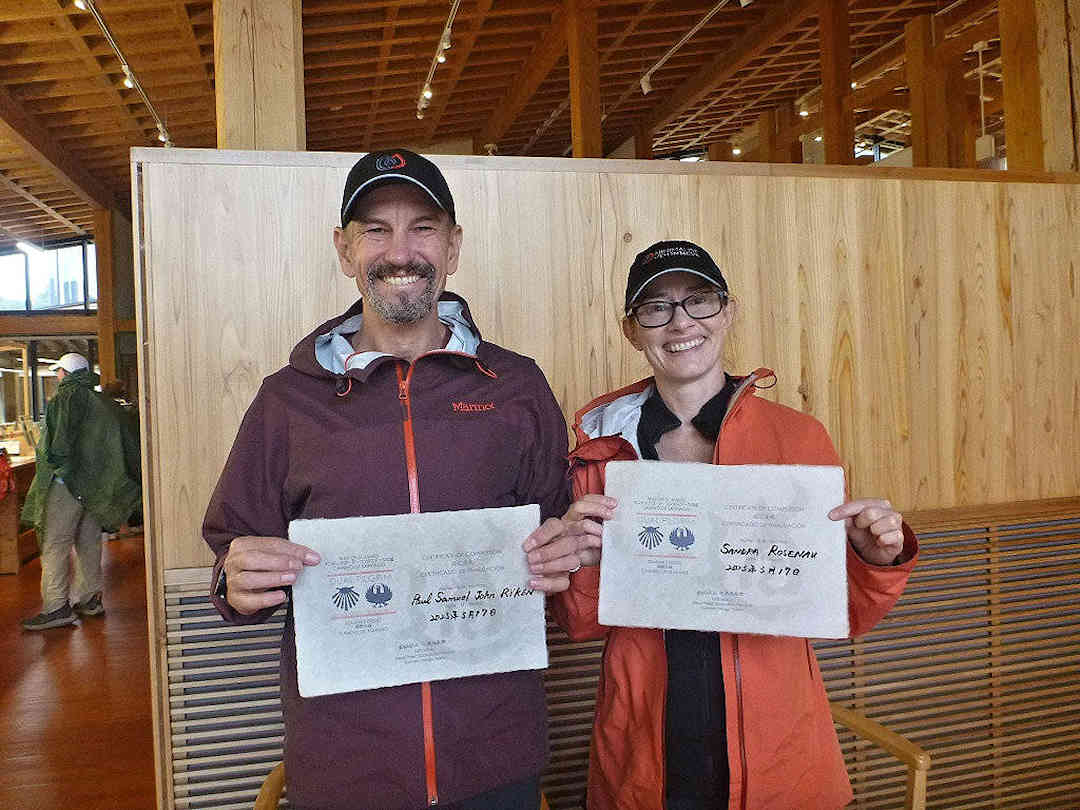
For those who have completed the Camino de Santiago and the Kumano Kodo , Dual Pilgrim certificates are issued by the Kumano Kodo Heritage Center in Hongu
Stage-by-stage description: Ise to Noasobimura | Noasobimura to Ise-Kashiwazaki | Ise-Kashiwazaki to Furusato Onsen | Furusato Onsen to Owase | Owase to Kata | Kata to Kumano City | Kumano City to Shingu
Brochures, maps and videos:
- Higashi Kishu Promotion Division – Kumano Kodo Iseji
- Tanabe City Kumano Tourism Bureau – Iseji
- Visual introduction – Iseji
Stage-by-stage description: Hachikenya-hama to Abi-oji | Abi-oji to Izumi Fuchu | Izumi Fuchu to Yamanakadani | Yamanakadani to Kainan | Kainan to Yuasa | Yuasa to Gobo | Gobo to Kirime | Kirime to Kii-Tanabe
Maps (Japanese only):
- Stages in Osaka prefecture
- Stages in Wakayama prefecture
Stage-by-stage description: Koyasan to Omata | Omata to Miura-guchi | Miura-guchi to Totsukawa Onsen | Totsukawa Onsen to Kumano Hongū Taisha
- Tanabe City Kumano Tourism Bureau – Kohechi Overview
- Tanabe City Kumano Tourism Bureau – Kohechi Full Brochure
- Virtual introduction – Kohechi
To learn more about the Nakahechi route , check out our sample itineraries and cost article.
- Tanabe City Kumano Tourism Bureau – Nakahechi Full Brochure
- Visual introduction – Nakahechi
Stage-by-stage description: Kii-Tanabe to Tonda | Tonda to Susami | Susami to Kushimoto | Kushimoto to Nachi
- Tanabe City Kumano Tourism Bureau – Ohechi Overview
- Tanabe City Kumano Tourism Bureau – Ohechi Full Brochure
- Virtual introduction – Ohechi
- Randomwire: Omine Okugake Michi Trail Guide
- Mountains and Plateaus Map from Amazon Japan
The Tanabe Tourist Information Center [ Official website , Google Maps location ] is a great place to
- grab a paper copy of the Kumano Kodo route maps and an up-to-date bus schedule;
- check for any route adjustments (typhoons in prior years have closed routes/required detours to be put in place).
The Kumano Hongu Heritage Center [ Official website , Google Maps location ] across the road from Kumano Hongu Taisha is a great place to learn more about Wakayama Prefecture and its UNESCO World Heritage sites .
Have you hiked the Kumano Kodo ? What route did you do, when did you do it and most importantly, how was your experience? And if you have any questions we haven’t answered please contact us. We’d love to hear from you.

This Epic Hike in Japan Takes You Through Ancient Shrines, Onsen Towns, and Magical Forests
You’ve heard of the camino de santiago. but what about the kumano kodo here’s how to hike japan’s sacred route..
- Copy Link copied

Pilgrims can find peaceful solitude along the Kumano Kodo trail.
Photo by Peter Bohler
Located south of Osaka on the Kii Peninsula of Japan ‘s Honshū island, the Kumano Kodo trail system is an ancient religious route that connects three sacred sites, Yoshino and Omine, Kumano Sanzan, and Koyasan. It’s also one of only two UNESCO World Heritage pilgrimage sites, alongside the Camino de Santiago to Santiago de Compostela in Spain. Among outdoors enthusiasts, it’s also known as a unique, multiday trek that winds in and out of dense, foggy forests, to the top of lush mountains, past Shinto shrines, and through tiny villages.
Nakahechi, the most sacred of the Kumano’s seven trails, was developed in the 10th century and connects three grand shrines known collectively as the Kumano Sanzan. Most visitors will choose to focus on this 44-mile-long route since it’s well-serviced and gives hikers a chance to see a variety of cultural and natural highlights. It also ends at the awe-inspiring Shinto shrine, Kumano-Nachi Taisha, which sits on a mountain next to the tallest waterfall in Japan, the Nachi Waterfall.
If you too want to experience the Kumano Kodo, here are some essential tips to plan your hike along the Nakahechi.
Which route to choose

After Hongu, hikers can opt to walk the rest of the way to Nachi or take a boat out to the coast and pick the trail up again from there.
Photo by Jessie Beck
There are a couple of ways to take on Nakahechi. If you have time to hike it all, you can choose between a 72-mile route that includes a boat ride down the Kumano-gawa River and passes all three shrines, or the 42-mile route that writer Peggy Orenstein traveled , which begins in the village of Takijiri Oji, passes east through the Kii Mountains, and ends at the grand shrine Nachi Taisha. Those short on time can opt for one of several variations of the above that involve a mix of hiking and buses.
To find one that works for you, browse the sample itineraries and book transportation and lodging through Kumano Travel, the official reservation system of the Tanabe City Kumano Tourism Bureau. Accommodations (including all meals) run about $90 a night, and luggage-shipping services cost around $35 a day.
How many days do you need?
Depending on which route you choose, the trip typically takes three to six days to complete, and while the hiking can be strenuous, you don’t exactly rough it: Pilgrims stay in hotels, ryokan , and minshuku (guesthouses) at villages along the way, most of which provide meals (including a lunch box for the trail) and access to hot springs or an onsen , a traditional Japanese bath.
Suggested stops along the way

The Nachi Taisha is the final grand shrine of the route.
Jessie Beck
Along the Nakahechi Route, some can’t-miss stops include:
- Takahara is a small town on the top of a beautiful set of mountains that’s a popular place for hikers to spend their first night on the trail, and has gorgeous views of the fog-covered valley below in the morning. Kiri-no-Sato Takahara Lodge “Organic Hotel” (closed Sundays) and Sen Retreat Takahara are two excellent hotel options.
- Chikatsuyu is typically the town where hikers spend their second night. Sen Retreat also offers glamping-style lodging (complete with washing machines for your clothes).
- Fushiogami Teahouse is a low-key, family-run teahouse ( Google Maps ) that’s a popular stop for a quick break and a refreshment before arriving at Hongu. The tea is grown nearby, so bring a few yen to buy some loose-leaf tea for later.
- Kumano Hongu Taisha is the first major grand shrine, or taisha , of the trail, located in an area known for its onsens. Don’t miss the cakes at a petite cafe called Choux or the ramen at Menya Mitsuashi .
- Kumano Hayatama Taisha is the second taisha of the trail, in the port city of Shingū. If you opt to take the boat tour from the Hongu Taisha, this is where it will drop you off as well.
- Kumano-Nachi Taisha is the final Taisha of the route, a stunning mountain-top building that overlooks an equally grand waterfall.
Related : In This Coastal Japanese Airbnb, Guests Are Given a Bed—and a Mystery to Solve
How to book accommodations
Kumano Travel, the official reservation system of the Tanabe City Kumano Tourism Bureau , is the easiest way to book hotels along the way.
However, if you want to stay somewhere not listed on their website, it’s easiest for foreigners to use an Online Travel Agency (OTA) such as Booking.com. Many hotels along the trail have Japanese-only websites, which can be difficult for non-Japanese speakers to navigate and use.
Food and water

Most accommodations along the Kumano Kodo will make a packed lunch for hikers to take to go.
Be sure to stock up on water, especially during warmer months, and bring snacks and lunches for the day. Since you pass by small towns and villages (as well as the odd vending machine) frequently, there are plenty of opportunities to re-stock as you go.
Packing tips
In addition to your normal hiking gear, you’ll want to bring hiking poles—the trail is steep and often rocky—and be prepared for rain at just about any time of the year.
Dealing with luggage

A pilgrim along the Kumano Kodo
If you prefer not to hike with all of your luggage each day, you have a few options.
First, you can opt to have your luggage moved each day (advanced booking required). Prices vary but start around 4,500 Yen (~$30 USD) per day for up to two pieces of luggage.
Another option is to pack only what you need for the hike and forward the rest of your luggage to the first hotel you will be staying at after you get off the Kumano Kodo. Many hotels in Japan will offer a luggage-forwarding service at the front desk, so you don’t need to book or organize anything in advance.
If you’re considering storing luggage at a train station in Japan, note that at most coin lockers in Japan, you can only store bags for up to 3 days, which may not be enough time for many hikers on the trail.
Is it easy to do on your own?

Dense forests are mixed with grand mountaintop views along the trail.
The Kumano Kodo trail is incredibly well-marked (to the point where there are just as many signs stating “not Kumano Kodo” as signs marking the trail) and easy for anyone with hiking experience to do without a guide.
Make sure to download an offline map—either through Google Maps, Alltrails, or both—to access while passing in and out of cell service.
Get a little help
Several tour companies will organize and book everything for you. Opt for one of Oku Japan ’s self-guided trips—four- to 11-day itineraries starting at $1,210 . Or, for a local’s perspective on the region’s culture and history, travel with a guide on Oku’s nine-day Kumano Ancient Trail tour, which begins and ends in Kyoto and includes all transportation to and from the trail, entrance to museums and temples, accommodations, meals, and luggage transfer (from $3,395) . A similar nine-day tour with Walk Japan starts at $3,035 (prices in Yen, starting at ¥464,000).
Getting there
The trailhead is easy to reach from Osaka. Trains run regularly from the Shin-Osaka station to Kii-Tanabe and take about two hours. From there, pick up a bus from a well-marked bus stop to Takijiri Oji, which takes another 40 minutes. Check Kumano Travel for the most up-to-date information on timetables and even more details and options for getting here.
This article was originally published in 2018 and most recently updated on April 10, 2024, with current information.

Your Travel Flamingo
Digital Nomad & Female Travel Blog
How to Hike Kumano Kodo: Japan’s Ancient Pilgrimage Trail
February 23, 2021

If I had to choose one word to describe the entire experience of hiking Kumano Kodo, it would be: spiritual. There was something deeply profound about being immersed in wilderness, following in the path of ancient Japanese pilgrims for several days. Those long days in complete silence, discovering numerous historic temples and sacred sites in the forest feel like discovering another world entirely. Here is a complete guide on how to hike Kumano Kodo in Japan.
The history of this trail dates back as far as the year 600, when Buddhism first arrived in Japan, however, the area has been regarded as being a sacred site since prehistoric times. The first pilgrims said to complete the pilgrimage of Kumano Kodo did so in the 800s. Even back then, there was no discrimination as to who could make the trek. From Japanese emperors, to wealthy nobles, to the everyday man; people from all walks of life made this long journey to seek religious rites and purification.
In 2004, the Kumano Kodo became a UNESCO World Heritage Site.
Kumano Kodo Today
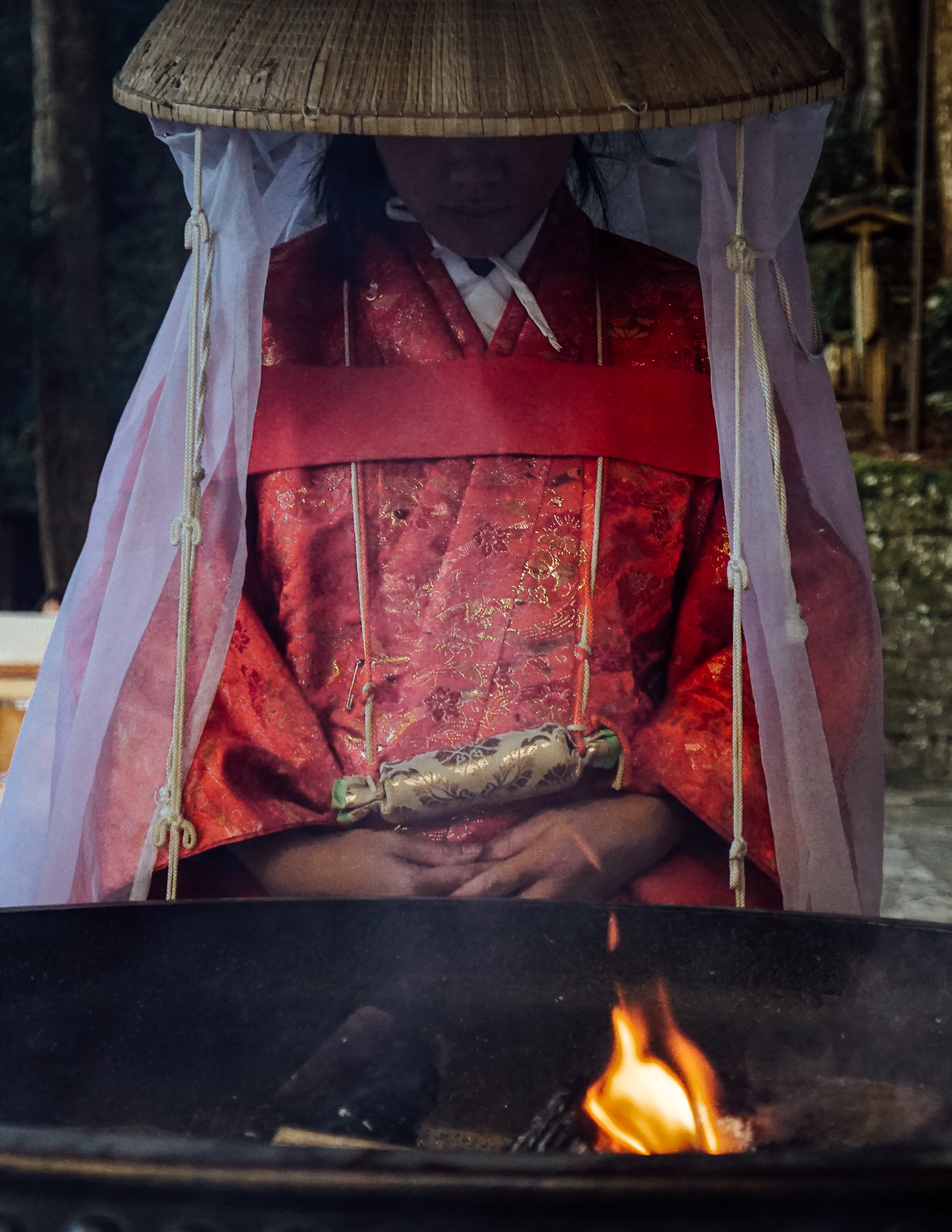
Back then, this would have been a very difficult journey, as it would take you deep into the untamed forest, across steep and treacherous terrain. Today, the path is mostly well maintained and easy enough for the experienced trekker. You may even cross paths with the random highway or two (thanks modernization).
To hike Kumano Kodo is an outdoor adventure like no other. Not only are you retracing the steps of ancient pilgrims, but you are passing by the very temples and sacred sites they used to worship in. You will pass countless temples, ojis (ancient shrines) and other elements to show you the unique, spiritual side of Japanese culture. Not to mention, the wild beauty of the Kii Mountain Range, which will have you in sheer awe every single day.
When planning to hike Kumano Kodo, you should strongly consider the weather. Japan has a temperate climate, and it very much has 4 distinct seasons. The altitude of the Kii Mountains makes it a bit cooler year round than the national average as well. Since the weather is drastically different from season to season, planning when to go will dictate your experience in some ways.
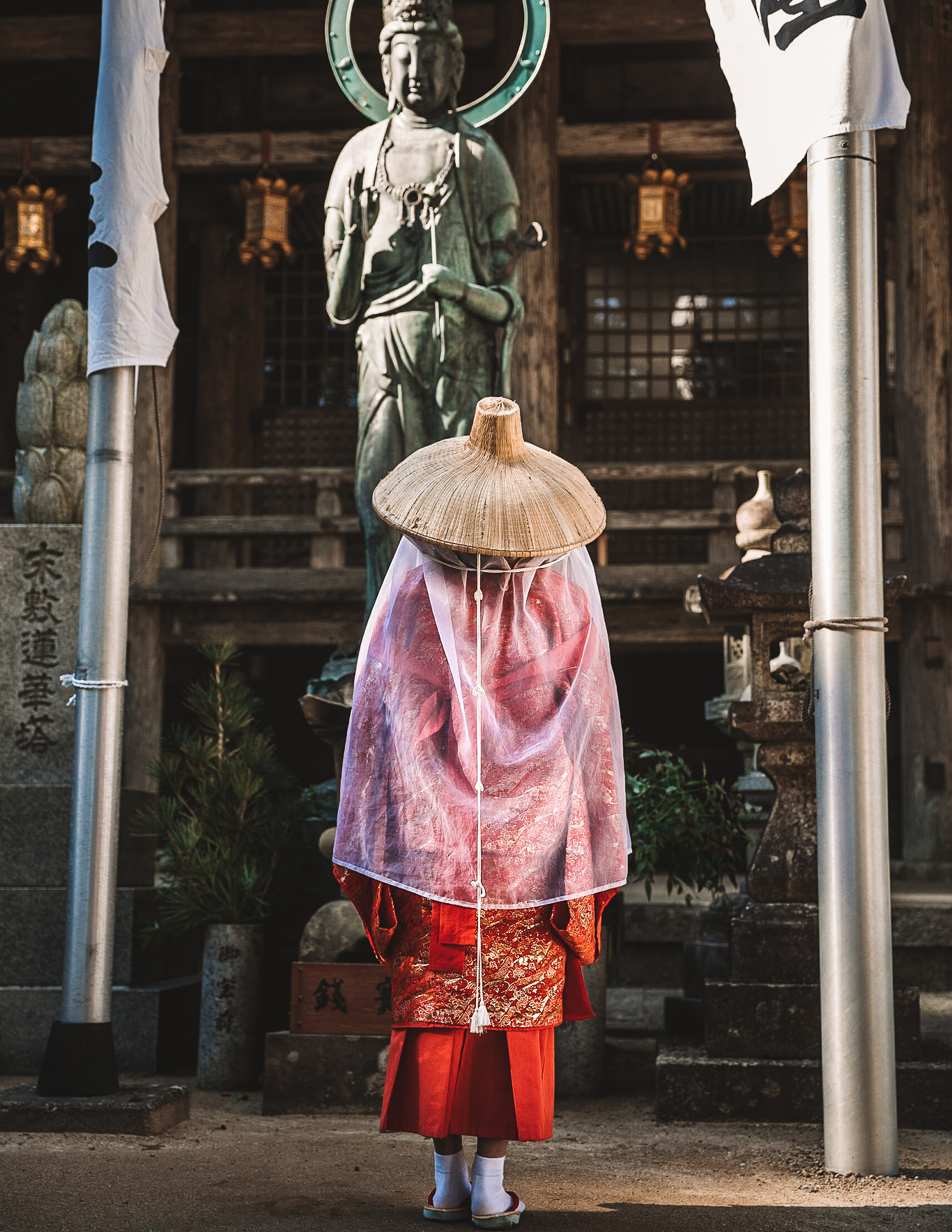
Many people choose to hike Kumano Kodo in spring because of the cherry blossoms. By no means is this trail one of the best places to view cherry blossoms, but they will be present, and make beautiful framing for when you pass by the temples and villages.
Daytime temperatures are usually between 10 – 15 C, which is pretty ideal. It’s warm enough to hike in a t-shirt during the day, when your body will be hot from all physical activity.
But bear in mind this is a popular time to trek, and you will encounter more people on the trails. You will also need to book your accommodation well in advance to secure a room, a feat made more difficult by the already limited capacities. Unfortunately, wild camping on Kumano Kodo is not permitted.
Summers in Japan are very hot and humid. Luckily, at this altitude you do have some respite from that. But it will still be considerably hotter than other times of year, with average daytime temperatures between 25-30 C.
Factor that in with hiking and carrying your pack, you will definitely feel hot and sticky, and the heat may slow you down if you aren’t used to trekking in these conditions. Summer also sees the most rain, so that is another disadvantage.
If you do hike Kumano Kodo in summer, a positive is that the mountains are very lush and green this time of year, due to the heavy rainfall. The rice fields you pass during summer will be full and very green. There are also some festivals to look forward to in summer on the Kumano Kodo trail.
You also have the advantage of maximum daylight hours, so you can take your time each day on the trail.
Autumn is another popular season to hike Kumano Kodo because of the beautiful fall foliage in Japan . The trail has lot’s of trees bearing the iconic maple leaves in this time of year. The temperatures are also very are comfortable, with daytime temperatures between 10 – 15 C.
Daylight hours are still long, and the overall conditions are good in this time. The only negative is that this season falls into typhoon season in Japan. In the unlucky event that one hits this area during your trek, you’ll have to cancel it completely.
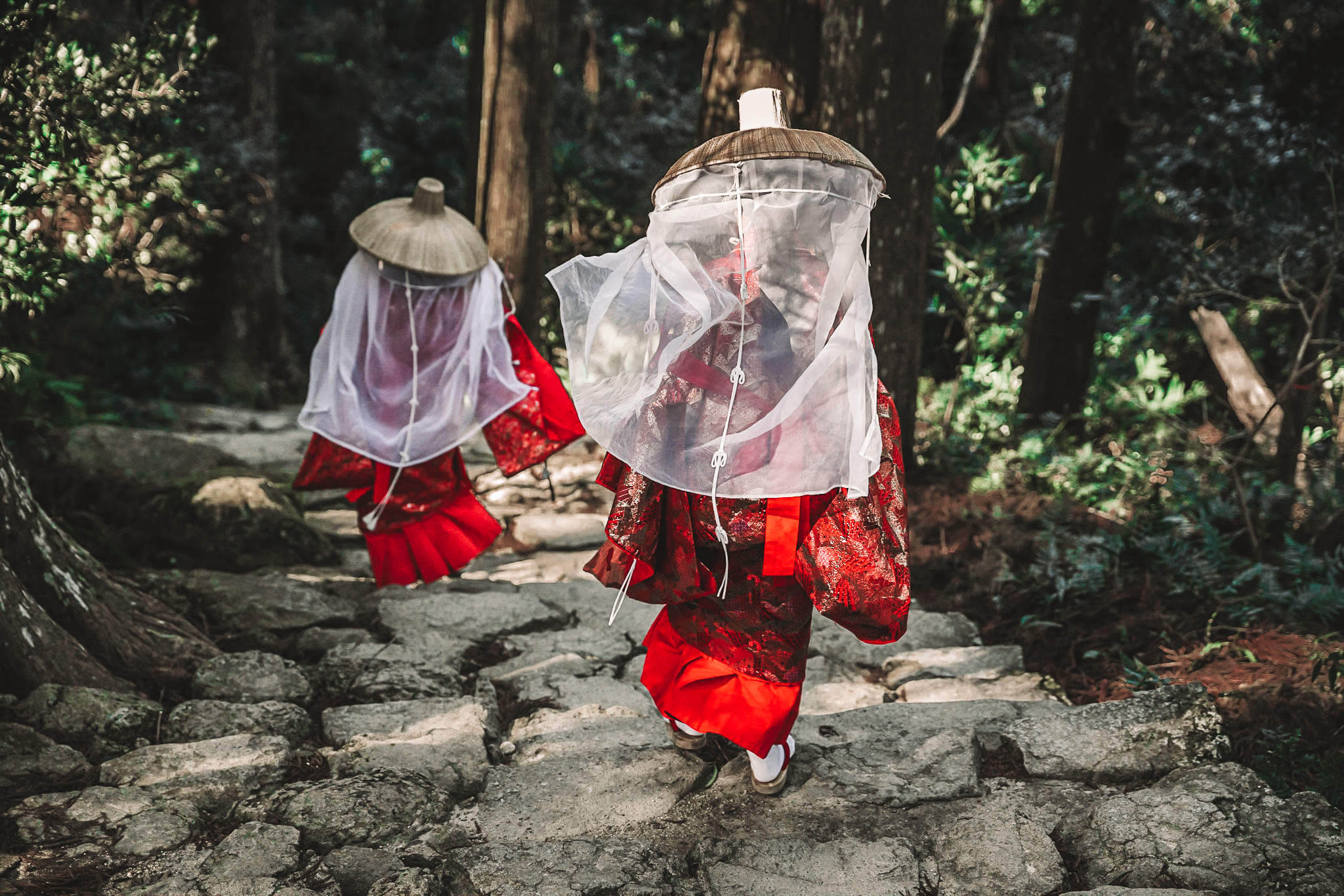
Winter in Japan gets ver cold, with daytime temperatures as low as 5 C. This season does see the least rainfall, so that is a positive aspect. However, if the temperature drops, it’s possible to experience snow.
The biggest downside to hiking in winter is definitely the shorter daylight hours. The sun rises after 7am and goes down a little after 4pm everyday in winter. If you aren’t comfortable hiking in the dark, this could be a problem on the longer trekking days.
Winter is the least popular season, so you will have the trail mostly to yourself. However, some guesthouses may be closed, so there are less options to choose from. The upside to this, is that the ones that do remain open will have a lot of vacancy.
Which Season is Best?
I hiked Kumano Kodo in winter to avoid crowds and can report a positive experience. Although we got every type of weather, from snow, to rain, to wind, with proper gear this shouldn’t be an issue. I would recommend trekking in this season to those wanting a more tranquil experience in nature. We had many days where we didn’t come across a single person on the trail and it was simply glorious.
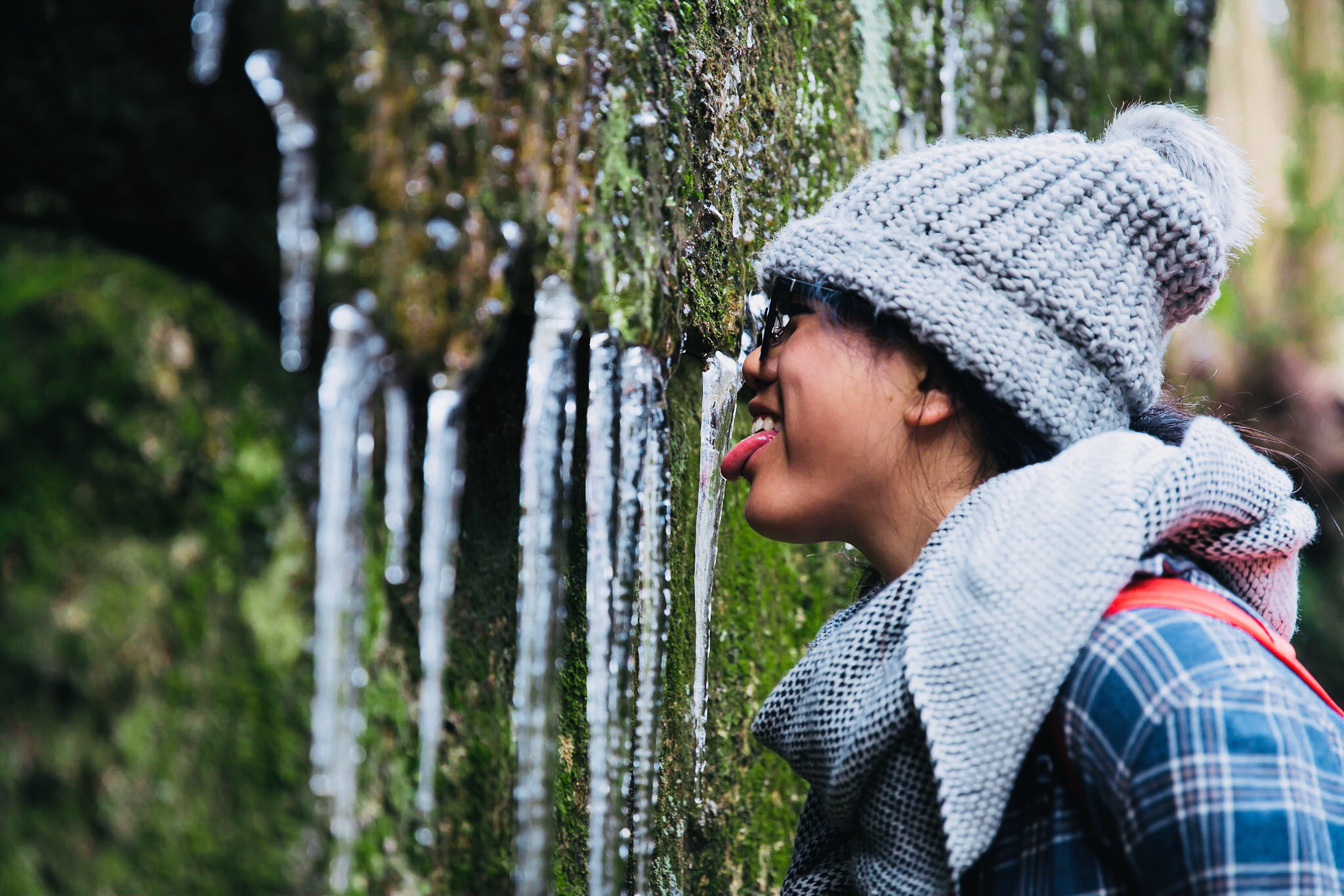
Wildlife in Kumano Kodo
In this area of Japan, there haven’t been any recent reports of bear sightings, so you can hike Kumano Kodo without fear of crossing ones path. However, should you want to err on the side of caution, one person in your group can still wear a bear bell.
While you won’t see bears, you may see deer during your trek. The ancient pilgrims saw them as a positive omen, and regarded them as protectors of the forest, allowing pilgrims safe passage.
Besides deer, you likely won’t encounter many other mammals. But you may come across some lizards, toads, and even some tiny freshwater crabs near water sources. If you are lucky, you may see a black kite soaring across the sky.
Dangerous Animals
Something you do need to look out for are snakes. The brown viper, known locally as “mamushi” is a venomous snake found all over Japan. Luckily, they are pretty shy and not usually aggressive towards humans. But as a rule, keep your eyes on the path, watch where you step, and always have proper footwear.
Killer Hornets
Also a species that can be found all over Japan are the Japanese giant hornets, also known as the killer hornets. As the name suggests, a run in with this insect can cause major problems, and in some very rare cases, death. They only really become an issue in the summer months, all the more reason to hike in the other seasons.
Spiders on Kumano Kodo
Not a dangerous creature, but a word of caution for anyone who suffers arachnaphobia: please familiarize yourself with the golden weave orb spider before doing this trek. In the wilderness of Japan, there are lot’s of very big spiders, and this mountain range is no exception. I opted to trek in winter because this is the only season cold enough that they vanish from the trail. In any other season, expect to see a lot of bigger than average spiders.
What to Pack

In ancient times, the Kumano Kodo trail went through untamed wilderness. Today, some parts of the trail intersect modern day roads or other signs of civilization. But there are still long stretches where you won’t be near any civilization, and deep in the mountains with access to no modern conveniences. It’s crucial to pack everything you need and might need.
Here’s a complete packing list of what to prepare to hike Kumano Kodo.
Hiking boots – proper hiking boots will be ideal, as you’ll frequently walk on rough terrain, cross streams and encounter rain or even snow.
Waterproof jacket – rainfall is prominent in this region in all seasons. bring a lightweight waterproof jacket. If it’s winter, bring warmer layers to go underneath, but honestly you heat up pretty fast if you keep moving.
1-2 Hiking pants – I got away with wearing yoga pants in winter, but you’d do well to bring proper hiking pants.
2 Hiking shirts – you can get away with just two shirts. You will have plenty of opportunities to wash them every time you arrive in a village for the night. If it’s winter feel free to bring two more long sleeve shirts, to use as layers in case it gets cold
3 -4 Pairs of socks – if you get caught in rain, your socks may get soaked. I went through all my socks in just half a day during a downpour. In this case more is better
Underwear – self explanatory
1 Bikini – to wear in the onsens in Yunomine and Katsuura
1 nice city outfit – to wear in Tanabe and Katsuura (try to keep it lightweight)
Sunblock (in warmer months)
Mosquito Spray (in warm months)
Toothbrush & toothpaste
Tissue papers and/ or wet wipes
Microfiber lightweight towel
Travel sized toiletries – the guesthouses you stay in should supply shampoo & soap, but you can bring your own if you prefer
Waterproof backpack – the size doesn’t mater much. my group brought 40 liter backpacks while I got away with a 15 liter backpack. As long as it fits all your supplies and is waterproof
2 Liter water bottle – in warmer months, you may need more
Poncho – it is almost guaranteed to rain at some point on your trip, regardless of season
Flashlight/ headlamp – to use at night and if you get caught on the trail after nightfall
Portable Charger – to keep your devices charged, in case of emergency
Camera + lens
Emergency Supplies
Food supplies.
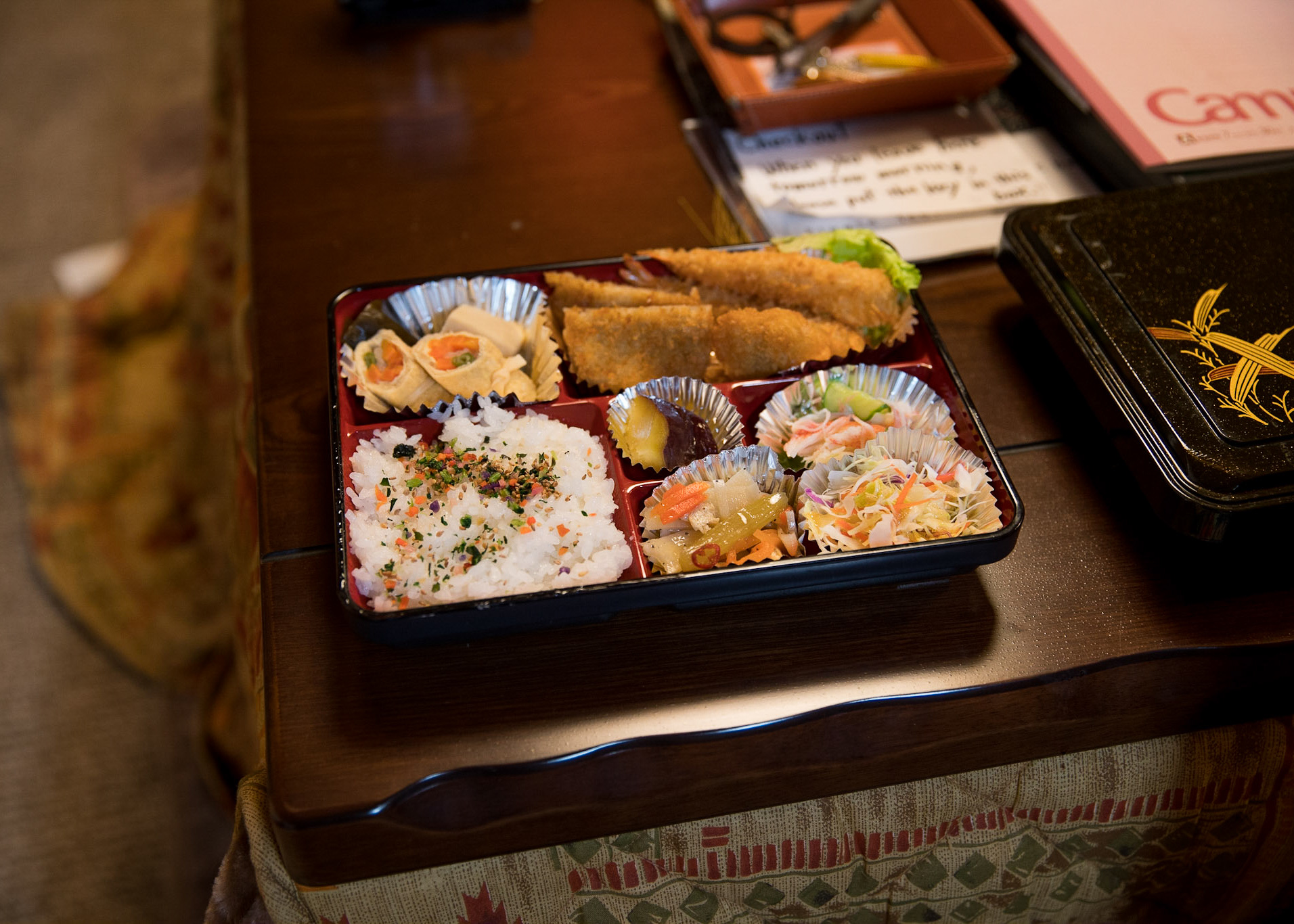
Depending on your arrangements with the guesthouses you book, you may not need to pack all your food. Usually, trekkers will opt to have their breakfast and dinners at the guesthouses. For an extra fee, the guesthouses can also prepare you a little lunch bento each morning, so you just need to pack some snacks. Some good options are:
- Onigiri (riceballs)
- Energy bars
How to Prepare

Booking Accommodation
The first step in preparing for your trip should be booking your accommodation. Further in this article, I will share an ideal itinerary and where to stay overnight according to the planned itinerary.
To book your place, the easiest way is to go through this website here .
Since a lot of these guesthouses, (locally called minshuku) are family owned, they also don’t speak much English. This website takes care of all the communications for you, and you’ll have a digital copy of your entire itinerary to refer to.
Booking should take place a couple months prior to your trek. If you are visiting in the high season (cherry blossom season or during a festival) it’s ideal to book even earlier.

No Wild Camping
You must remember that Kumano Kodo is not just a hiking trail, but a sacred pilgrimage site. For this reason wild camping is extremely frowned upon. If you respect the local culture, please do not do it.
I have heard there are designated campsites in some villages such as in Chikatsuyu, Kawayu Onsen, Wataze Onsen, and Koguchi. If you want to camp you can look into those.
Camping may be a bit cheaper than a guesthouse, but meals will likely not be provided. And since these are rural parts of Japan, you may not find markets very easily, so if you choose to camp, you will likely need to pack all your food.
Training and Conditioning
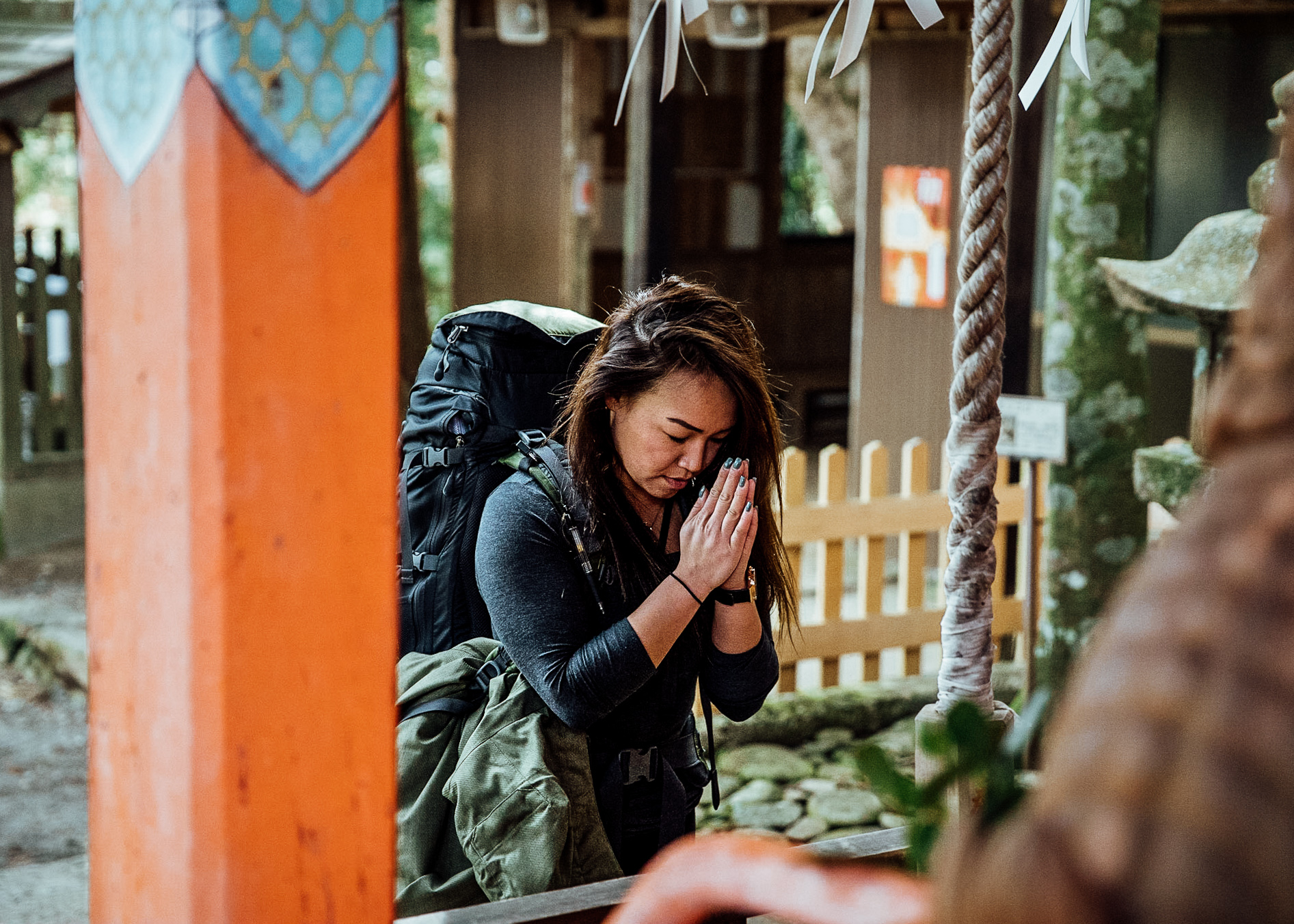
Something not to be overlooked before you hike Kumano Kodo, is that you need to evaluate your fitness level.
This is a serious trek, and although I think it’s suitable for most people, it doesn’t mean you can show up out of shape.
It’s necessary to train and be fully prepared beforehand. Hike your local trails or hit the gym and work on your cardio. It’s a strenuous journey, and everyone in my group was hurting by the end, despite being experienced hikers.
Wifi Hotspot
It’s a good idea to have access to internet, in case of emergencies. It’s easier to get a mobile hotspot when you arrive in Japan than a SIM card.
Also, if you are trekking with a group, you can all share the hotspot, making it a cost effective option. This will come in handy should you get lost, and need to contact your accommodation to let them know you will be late, or any other situations which may arise.
Getting to Tanabe
To get to the starting point of the trek, you’ll need to get to Tanabe. The station you should arrive in is Kii-Tanabe Station .
As far as major cities on the tourist trail go, Tanabe is most easily reached from Osaka . It takes about 2.5 hours, if you take the direct line on the Kuroshio Line .
Full Trek Itinerary

Here, I’ll provide a full itinerary based on someone with above average fitness level. At this level of fitness, you can complete the whole trip in 6 days, with 4 days of trekking involved.
On trekking days you will walk on average between 20 – 30 kilometers, carrying a 15 kg pack (this is why I said conditioning is key).
If this does not sound like you, no worries, you can still do this trek. You’ll just need to either pay to have your backpack transferred between accommodations (costing more money), allowing you to walk faster without weight, or just reduce the walking distance each day.
If you choose the latter, you’ll need to extend your trip by 1 or 2 days to complete the trek at a slower pace.
Day 1: Arrive at Tanabe

Tourist Information Center
Once you arrive at Kii-Tanabe Station, it’s ideal if you head to the tourist information center and check the time of the bus to the trail head for the following day.
Find the tourist center here .
The center closes at 6PM, so if you are arriving after that, don’t worry. The information should be somewhere on the wall.
Going Out in Tanabe
If you are up for it you can head directly out for the evening on the town. Conveniently, the main nightlife area is directly across from the station.
Tanabe isn’t known for nightlife in the same way Tokyo or Osaka is. However, the nightlife setting here is more intimate, yet still fun.
A good starting point is Ekimashin Street, where you’ll find a narrow street lines with traditional style restaurants and bars. We opted for some sashimi from Shinbe , to get some quality protein in before our trek.
You will have to exercise some self control as to not get drunk the day before a 4 day trek, because there are some great sake bars in the area, and even some small cocktail bars.
Where to Stay
We stayed at Buddha Guesthouse , which is the best budget option in town. It was clean and very comfortable for our one night stay.
Day 2: Hike to Chikatsuyu
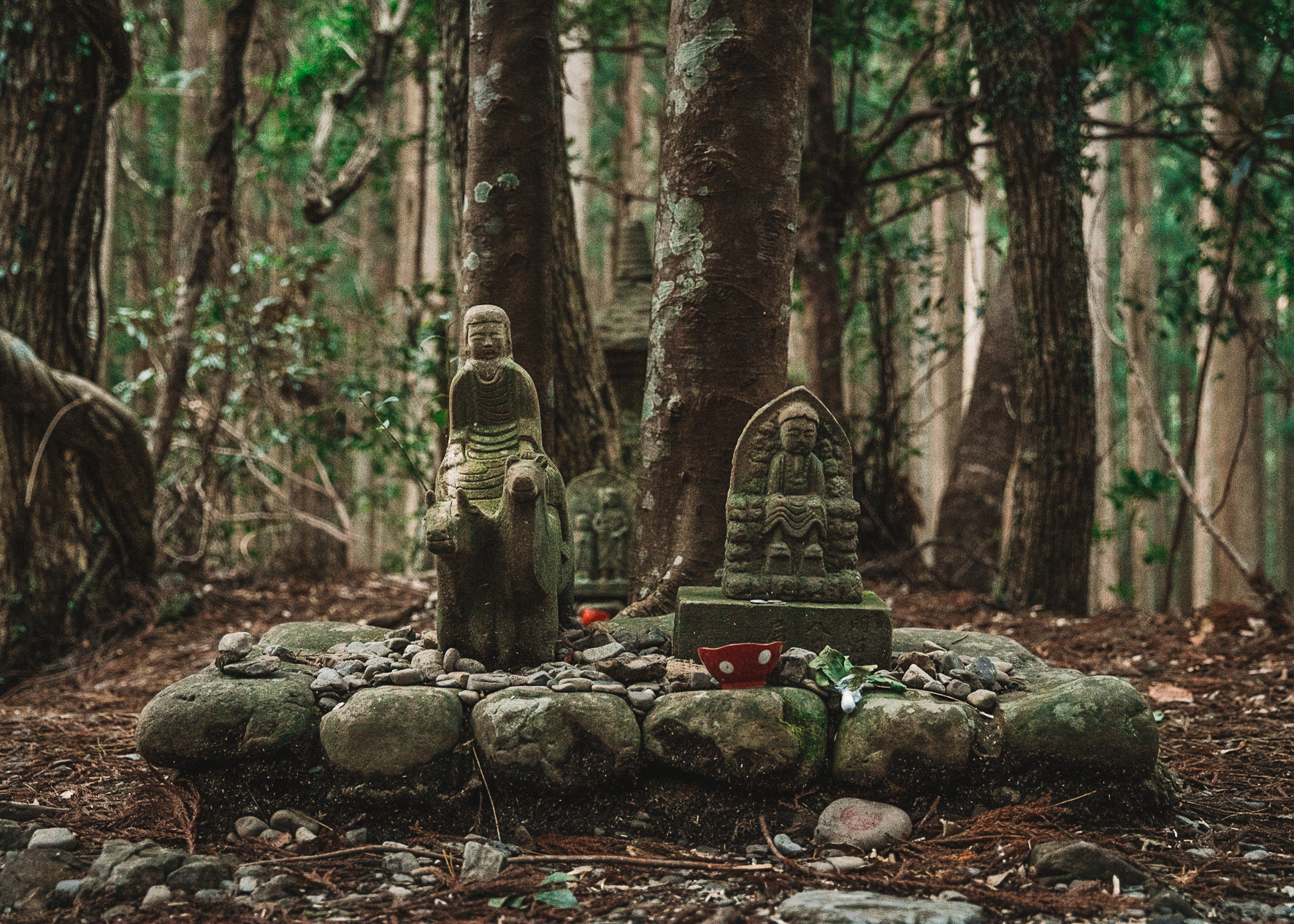
Distance Trekked : 13.3 km
Total Elevation Gain : 1010 meters
Trekking Time : 8 hours (including stops)
Main Sites: Takahara Rice Terraced Village, Gyuba-doji, Chikatsuyu Village
Where to Stay : Happiness Chikatsuyu
To start your hike in Kumano Kodo, you must get to the trailhead.
The first day, you’ll need to wake up early to get to the Kumano Kodo trail first by bus. At the Tanabe Tourist Center, you’ll find a ticket machine. Buy a ticket for “Takijiri”, which will cost 960 yen ($9 USD).
Check the current bus timetables here , but there should be a bus departing before 9 AM.
You’ll wait as bus stop #2 for your bus. The journey takes about 40 minutes.
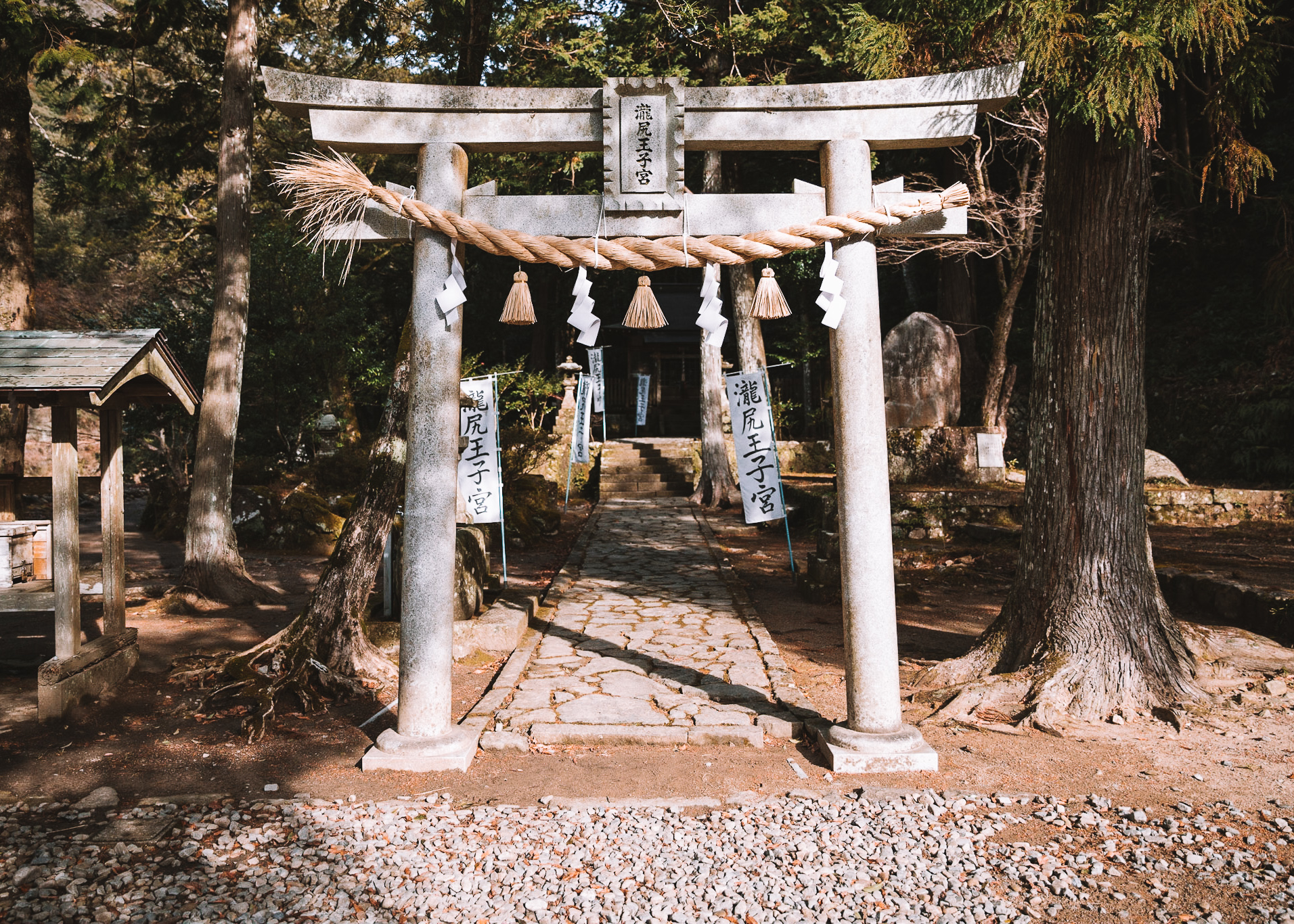
Start the trek at Takijiri oji
Once you arrive at the trail head, you will find yourself at the Takijiri oji, your first shrine of the Kumano Kodo trek. It will be a steep ascent up for a while, until it levels out a bit.
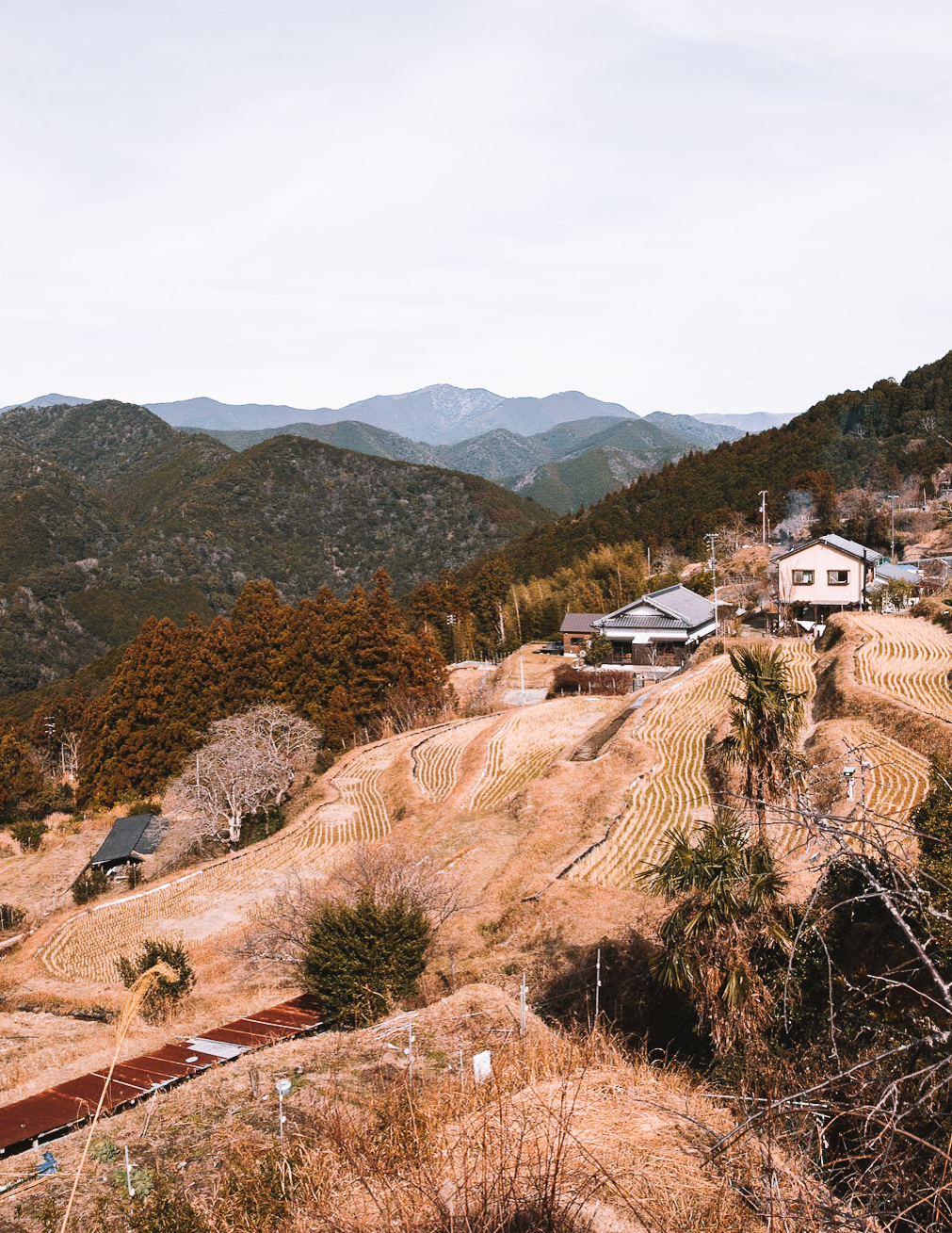
After trekking about 4 km, you will reach Takahara. Depending which season you visit, you may get a view of lush green rice terraces, or just brown grass. If you trek in winter, unfortunately it will be the second one.
If you visit in summer, you may even see the terraces filled with water, a truly iconic view especially when it reflects the sky. This is also a good spot to have lunch.
Chikatsuyu Village
After that continue trekking through the forest, where you’ll have a long stretch of steady incline, passing a few more ojis on the way. After the peak, you have a steep descent into the valley before reaching Chikatsuyuu, a quaint mountain village where you’ll spend the night.
If you arrive early enough, be sure to explore the village itself. It’s a quaint, traditional Japanese mountain village, with a few of its own shrines as well.
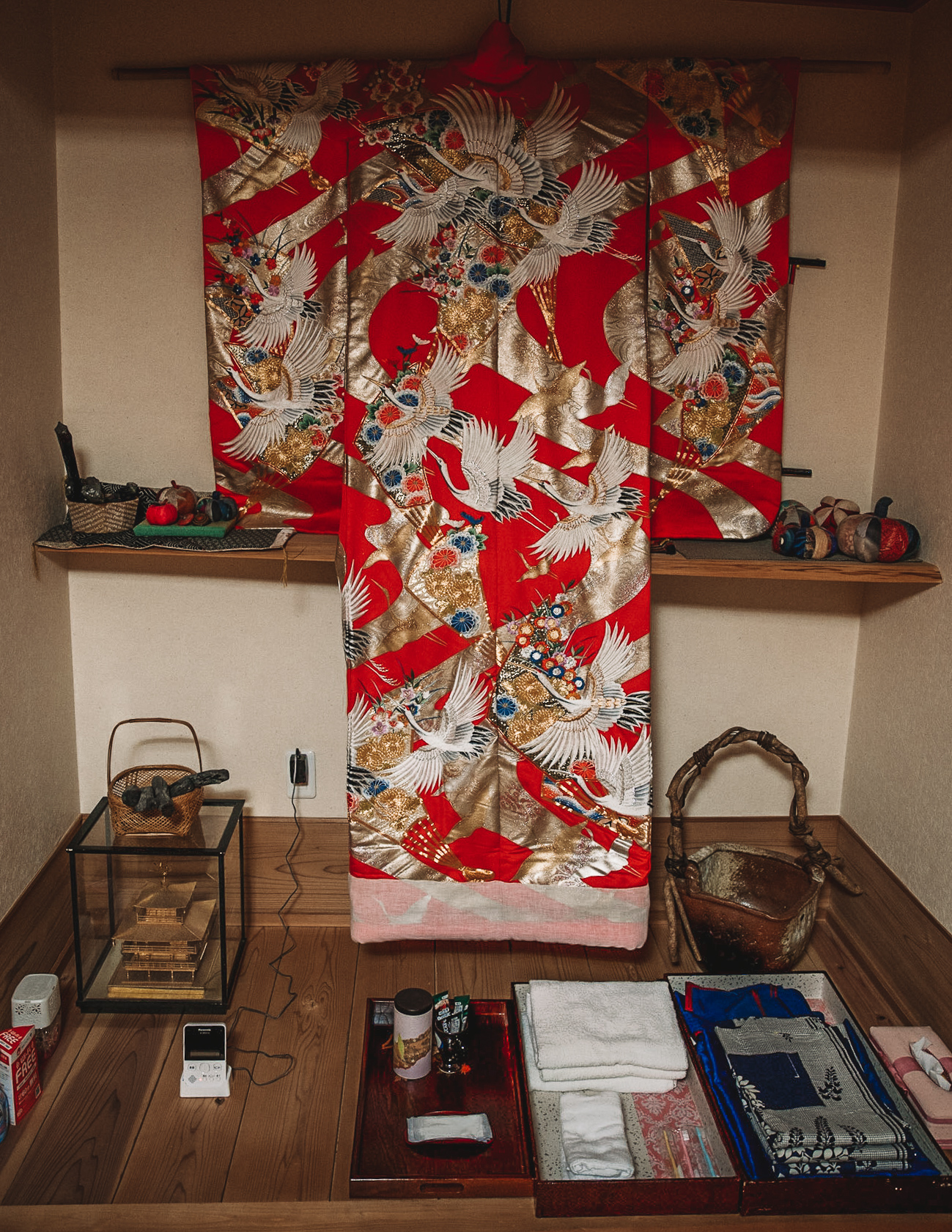
Day 3: Hike to Yunomine Onsen
Distance Trekked : 36.3 km
Elevation Gained : 1700 meters
Trekking Time : 14 hours (with stops)
Main Sites : Toganoki-jaya Teahouse, Tsugizakura-oji, Yunomine Onsen Village
Where to Stay : Minshuku Yamane
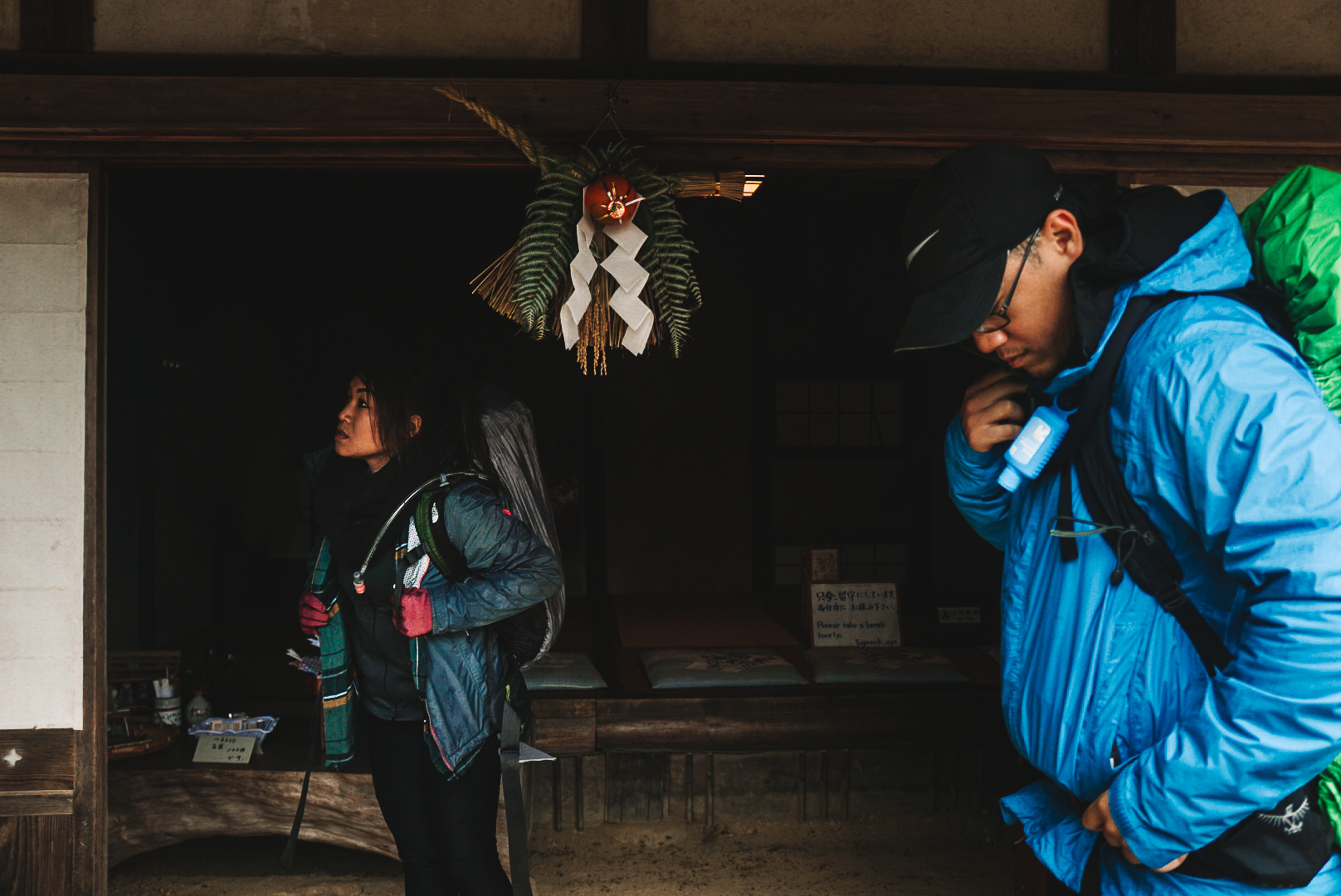
You’ll need an early start to complete this long day. While the elevation gain is mostly steady, it’s a long distance to cover, and you’ll be hiking across multiple terrains, including some switchbacks.
It’s best to plan for a 12 – 14 hour trekking day, which will have you averaging 2 miles an hour, with enough breaks in between.
Early on in the day, you will pass Toganoki-jaya Teahouse, a cute place to stop by.
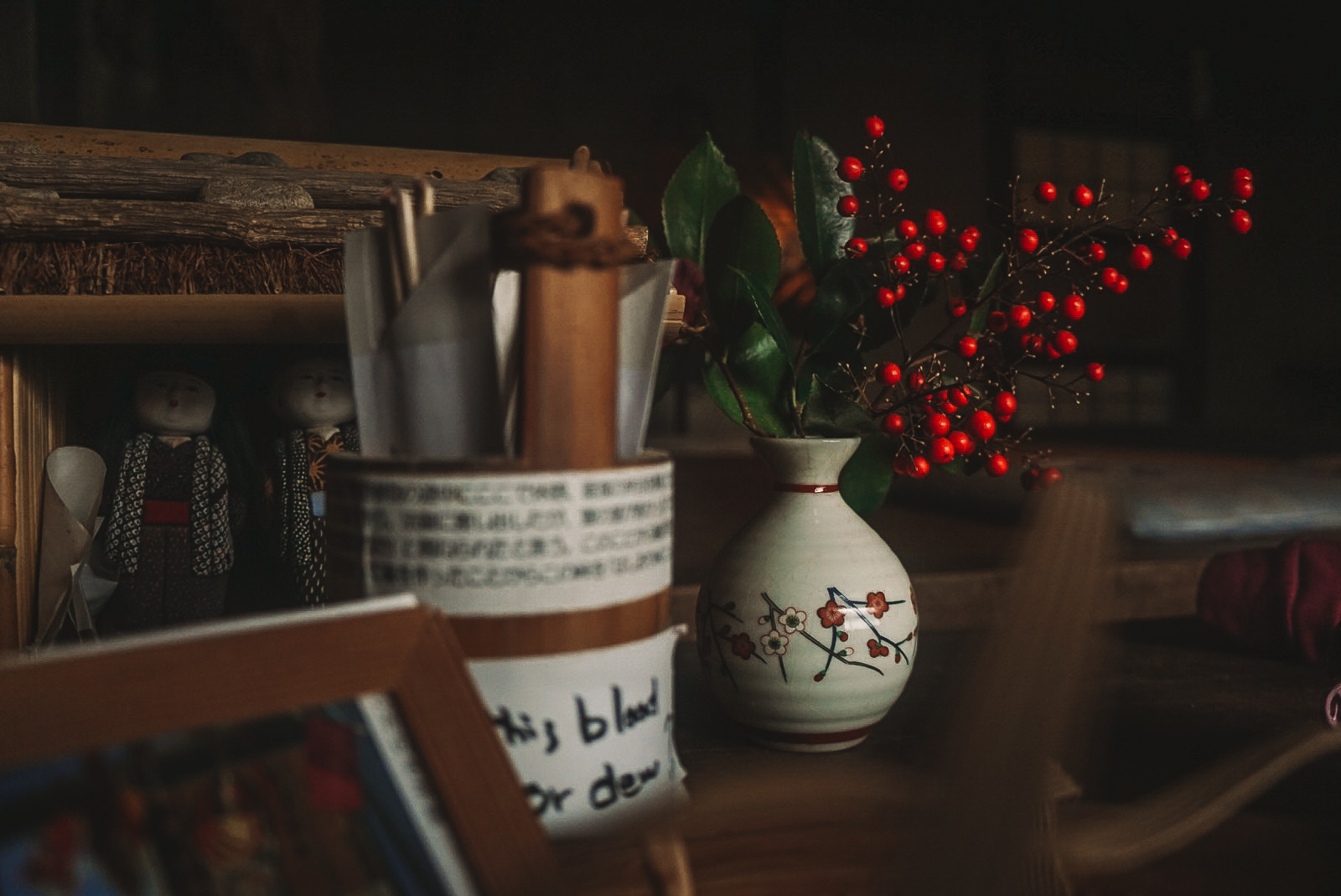
Then, you will walk through the forest, crossing streams and coming across ancient ojis in the wilderness.
On this day, we encountered the heaviest rain of the trek, and were glad to use the ojis for shelter and protection. If you do this, be sure to say a little prayer to each one before you leave thanking them.
You’ll pass many temple on this day, the most notable one being Tsugizakura Oji. Although there are many points of interest, try not to spend too much time any any of them.
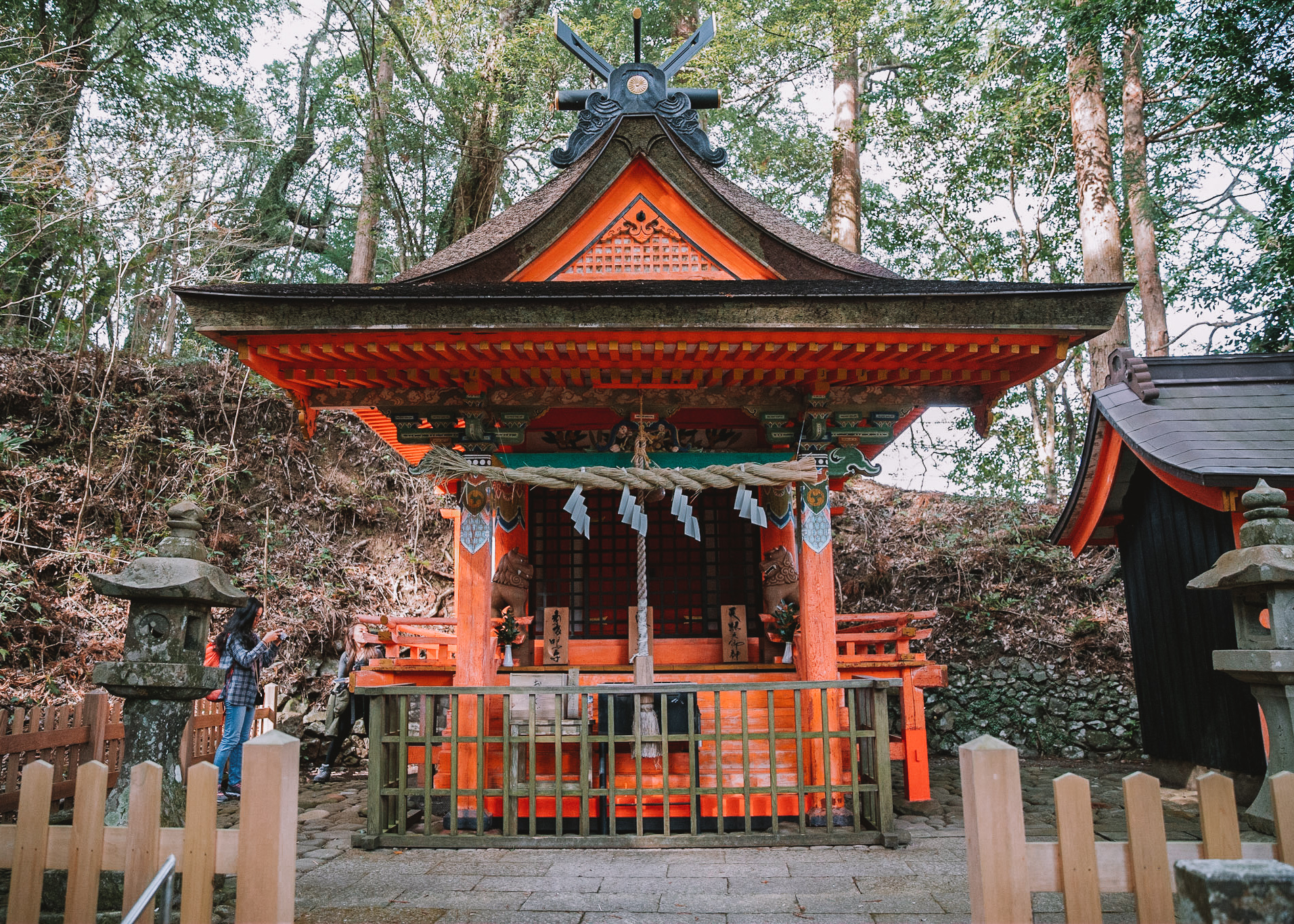
Time management will be key to making it to Yunomine onsen before nightfall. Your accommodation will be in a hotspring village, so you’ll want enough time to enjoy the bathes too!
Arriving at Yunomine Onsen
Techincally, Yunomine Onsen village is not the most direct path through the Kumano Kodo. It takes a slight alternative route, but you don’t lose any time and it is totally worth the visit. This onsen village has over 1800 years of history, and has been a rejuvenating stop for pilgrims for over a century.
By day 2, you will be halfway through your trek and believe me, you’ll be glad you spent the night here and relaxed in the healing hot springs. Its the perfect place to unwind and sooth your sore muscles.
Be sure to check out the village before you leave. You can find communal cooking onsens around the village, where locals come to cook their food in the thermal waters. If you want, you can purchase some veggies or eggs from the market, and try for yourself.
Minshuku Yamane
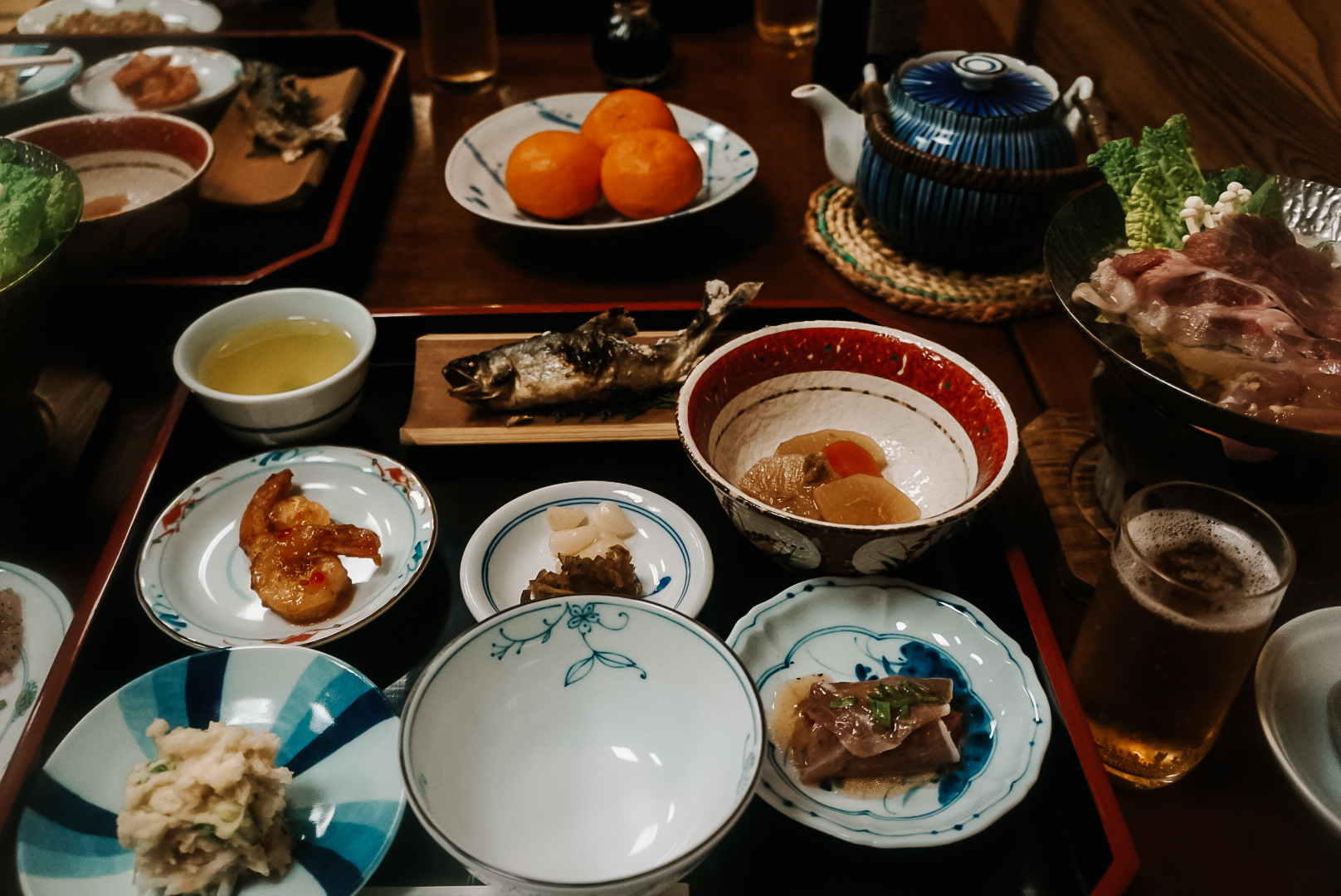
I stayed overnight in Minshuku Yamane, and can’t recommend it enough. the guesthouse features in-house hotspring bathes, and the dinner here will be one of the best you may have in Japan.
The owner is also the cutest oba-san (Japanese grandma), who made us feel like family in every way possible. I can’t recommend this place enough.
Day 4: Hike to Ohara
Distance Trekked : 21 km
Elevation Gained : 137 meters
Trekking Time : 8 hours (with stops)
Main Sites : Kumano Hongu Taisha, Oyunohara, Hyakken-gura Viewpoint & Jizo
Where to Stay : Sansaro Cafe & Guesthouse

This is the easiest day of the trek, and arguably the best. Have a slow morning at Yunomine Onsen, before leaving for day 3.
You will have some steep stairs up, before a long descent until you reach the valley where Kumano Hongu Taisha is. You will pass through a very intriguing forest, with slick redwood trees. These trees look unlike any other I’ve ever seen, and you will stumble across an oji or two here as well.
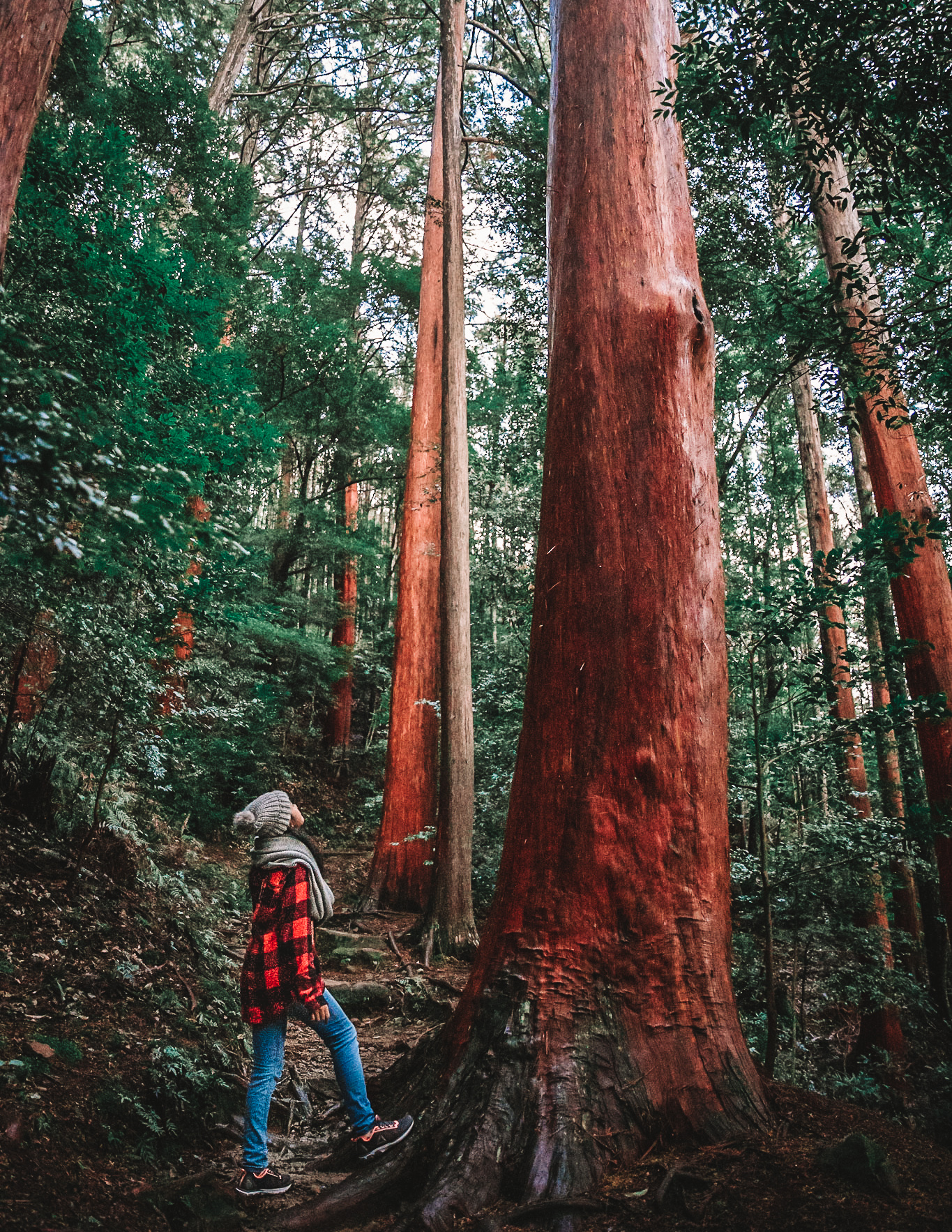
Once you reach the peak of the day, you will see Kumano Hongu Taisha peaking out from the valley beyond the many mountains. It’s an indescribably beautiful sight, one that was said to bring pilgrims to their knees in ancient times.
From here, it’s all downhill, until you reach the river valley.
Kumano Hongu Taisha

First, you will visit the Kumano Hongu Taisha, the most spiritually significant temple of the hike in Kumano Kodo. While in the temple, you may choose to buy a fortune teller. In recent years the Kumano Kodo has become popular enough that they now print fortunes in English.
Sadly mine said that this year was a good one to have a baby, so I promptly tossed mine out. But if you agree with your fortune, be sure to tie the paper to the fortune rack in the temple for good luck.

This is the site of the largest tori gate in all of Japan. It sits idyllically between two rivers, which join together on the southern facing side. In the past, this was the most significant part of the pilgrimage, with over 12 shrines making up the entire complex.
In Japanese culture, tori gates represent a window into the spirit world. There are various spiritual festivals that take place here, including a major one in the spring.
This festival involves waking up the Japanese deities, and carrying them around in a procession ceremony, until they are brought back to Oyunohara.
If you want to trek in Spring, you can try to catch this festival. It’s a fascinating insight into ancient customs of this religion and region.
Hyakken-gura
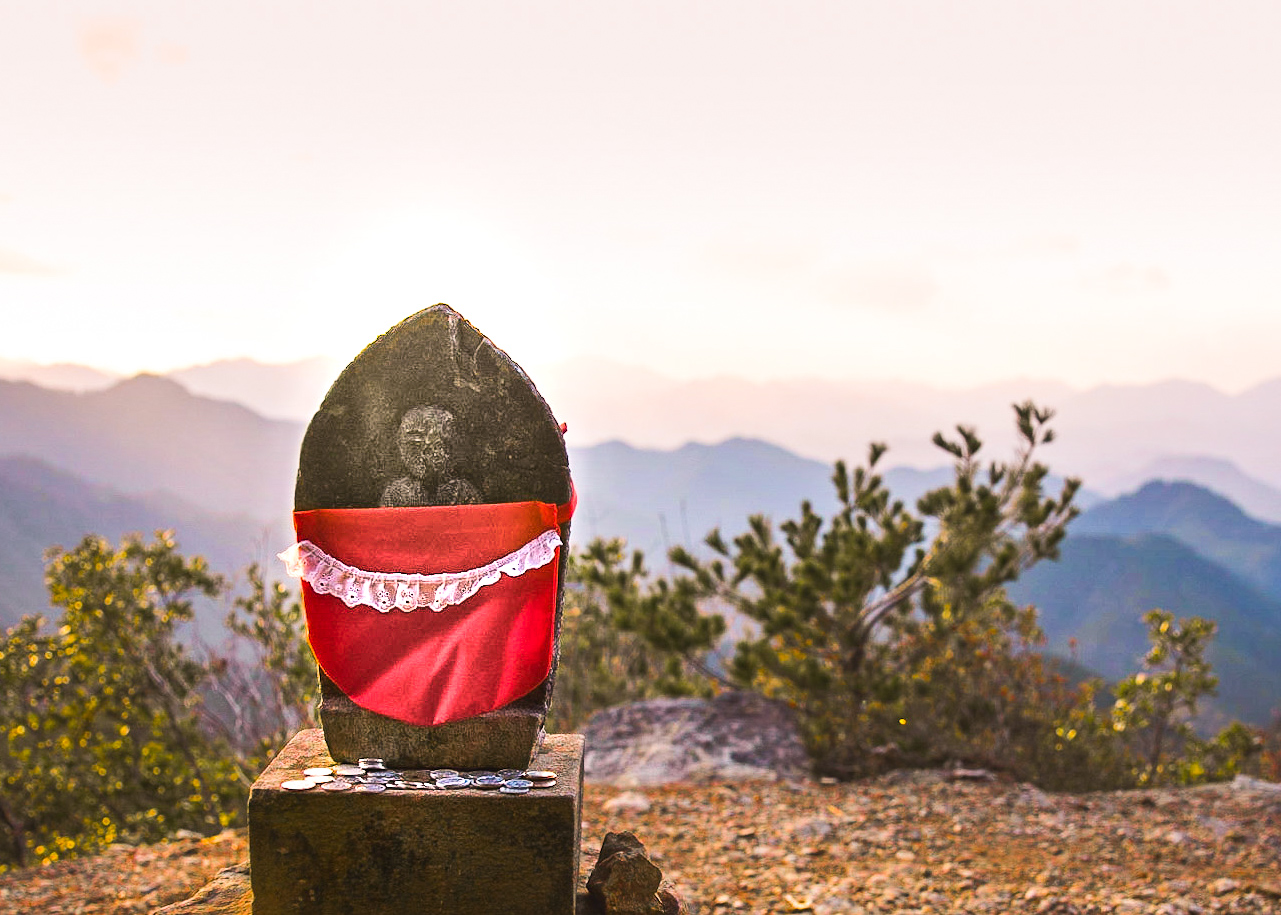
You will re-enter the forest shortly after Oyunohara, and walk for about an hour until reaching an iconic viewpoint of the hike in Kumano Kodo.
Here you have a lone jizo, perched over the side of the trail, with sprawling views of the endless mountains in the background. This view is breathtaking, and if you are a photographer, this will be a highlighted photo spot.

If you are comfortable with night-hiking, stay for sunset, when the mountains turning every shade of blue against a warm florescent sky.
Then, it’s a little over 2 hours of walking from Hyakken-gura to Ohara, where you’ll rest for the evening.
Day 5: Hike to Nachi Taisha the Waterfall Temple
Distance : 33 km
Elevation Gain : 1300 meters
Trekking Time : 11 hours (with stops)
Main Sites : Kumano Nachi Taisha, Hiro-jinja Shrine, Nachi Waterfall
Where to Stay : Hotel Charmant (in Katsuura)
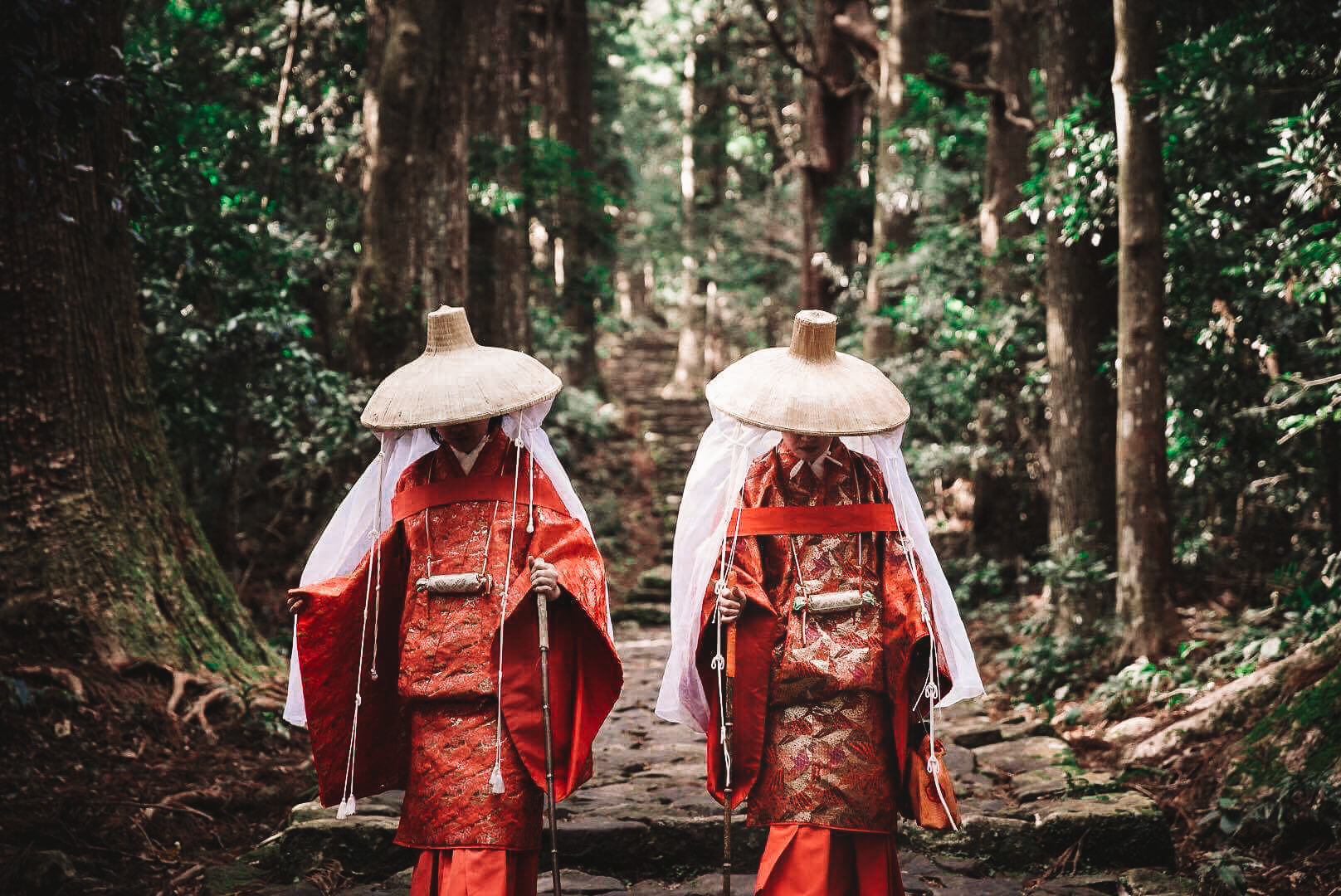
This is supposedly the most challenging day of the trek, likely due to the very steep incline through the Echizentoge pass. Japanese people have even given it the nickname “broken-leg mountain” due to the many injuries that happen on this stretch of the trail.
If you are visiting in winter, it can also be slippery due to ice. Feeling worried yet? So was I!
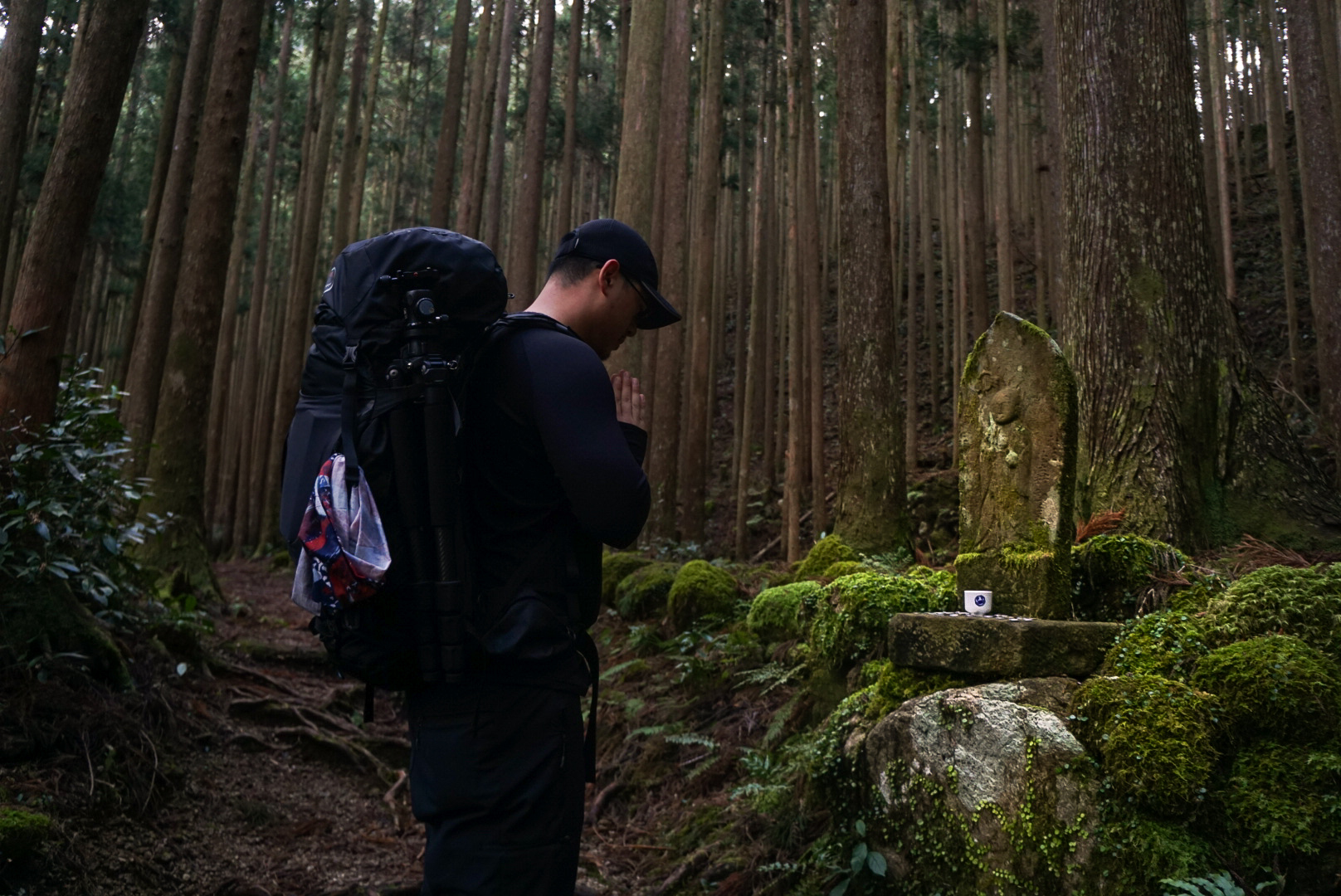
But don’t let this information scare you; I did not find this day to be nearly as difficult as it was rumored to be. It’s a very steep 800 meter incline to reach the top of the pass, so prepare for your glute muscles to cry for about 90 minutes. But after that it’s kind of smooth sailing and all downhill.
Before you begin your ascent up to the pass, you will pass a few more iconic ojis and sites.
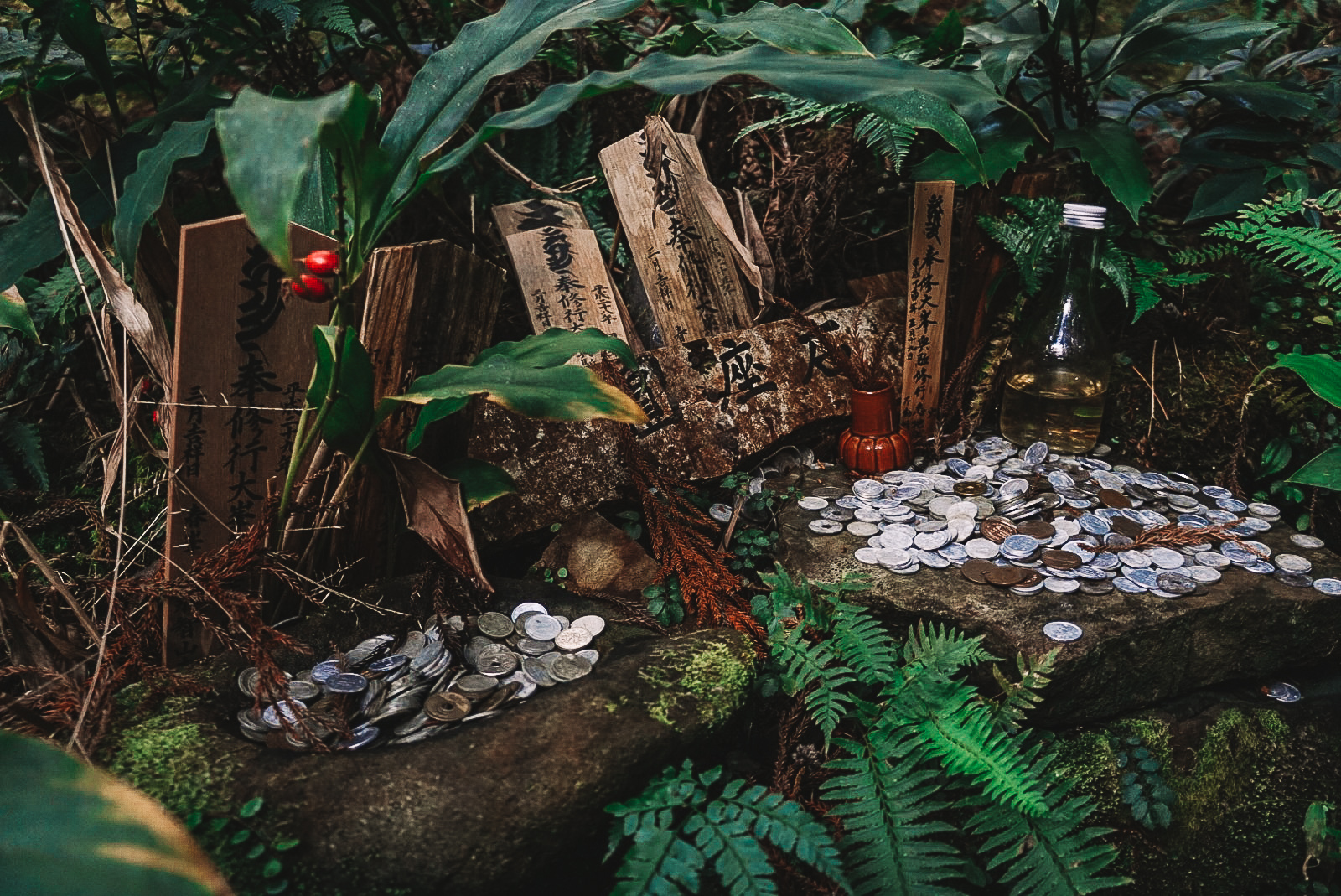
One of which is Waroda-ishi Rock, a sacred rock where legend says the deities of Kumano Kodo sat, as they drank sake.
When the final ascent starts, you will be deep in the forest, and walking through some very rough and rocky terrain. Try not to trip over the tree roots, or twist an ankle in one of the holes.
Once you reach the top of the pass, you will be at the highest point of the whole trek.
From there, it will be more or less a leisurely walk, taking you gradually down on your final descent, while passing the remains of historic teahouses.
After many hours of walking, you may get a peak of the ocean through the trees. This is when you know you are almost finished.
After seeing the ocean, you’ll just walk about an hour further on a gradually sloping trail.
I found this part of the hike enjoyable, as we had gorgeous lighting bathing the forest, creating little golden spotlights peeking through the trees. It was magical, especially since we were no longer hyperventilating and struggling to go uphill.
Once you hear falling water, you have arrived at your destination, and the end of the trek.
Kumano Nachi Taisha
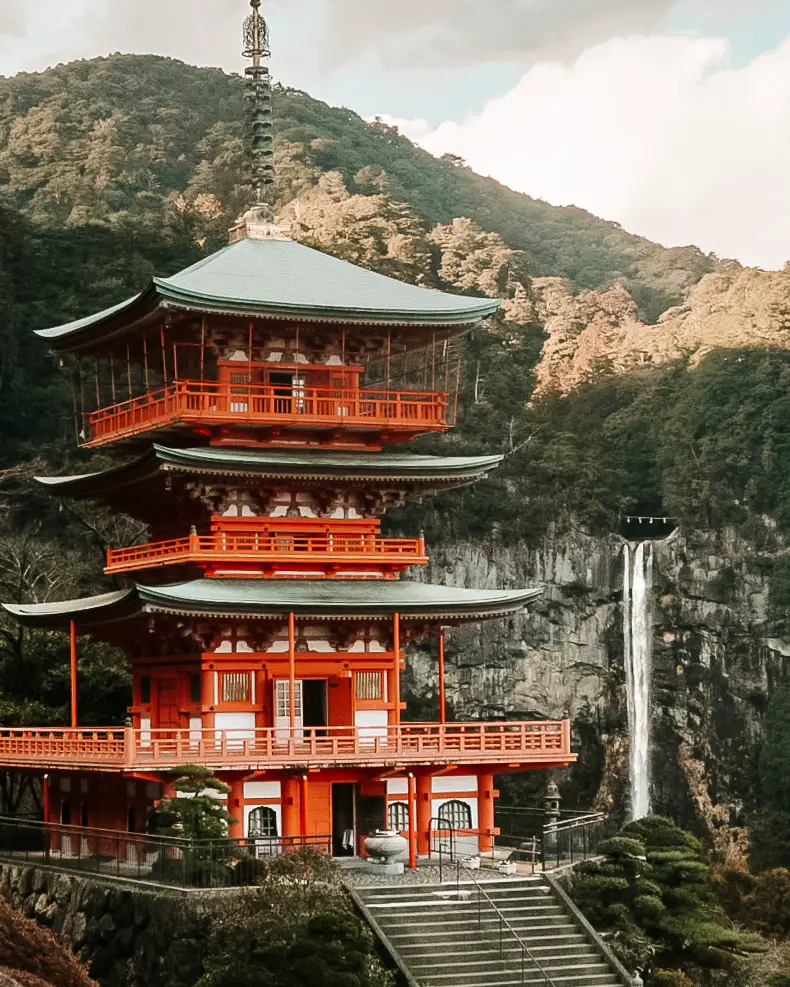
This temple is one of the three main temples of the pilgrimage, and possibly one of the most stunning you’ll ever see. The complex is large, with all buildings built and painted in the traditional vermillion red color.
The biggest attraction is the pagoda, which is set right against the cliff in front of the Nachi Waterfall.
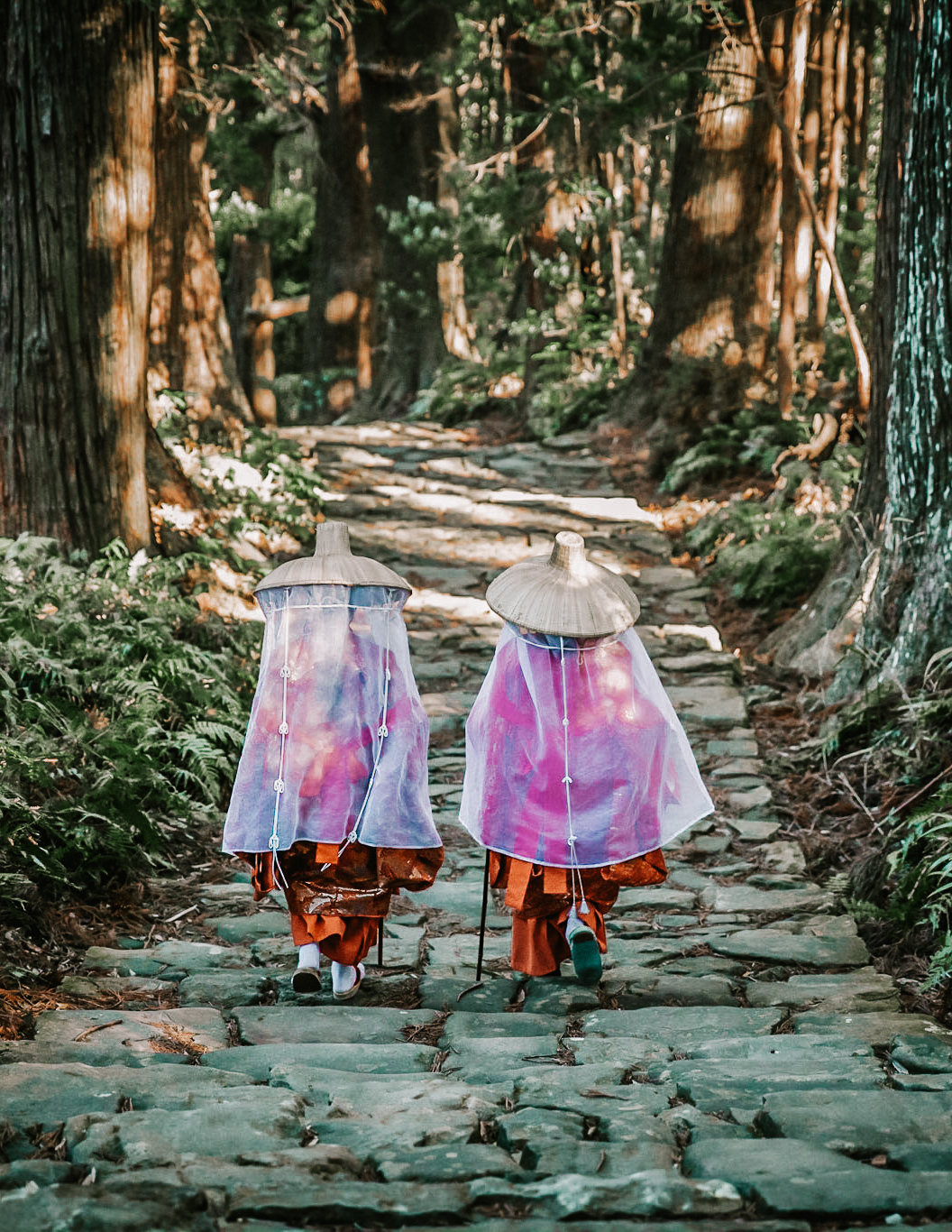
The waterfall is also the tallest one in Japan. It freefalls unobstructed from 133 meters into the basin below.
For the evening, take the bus to Katsuura nearby to spend the last night of the trip.
Day 6: Explore Katsuura
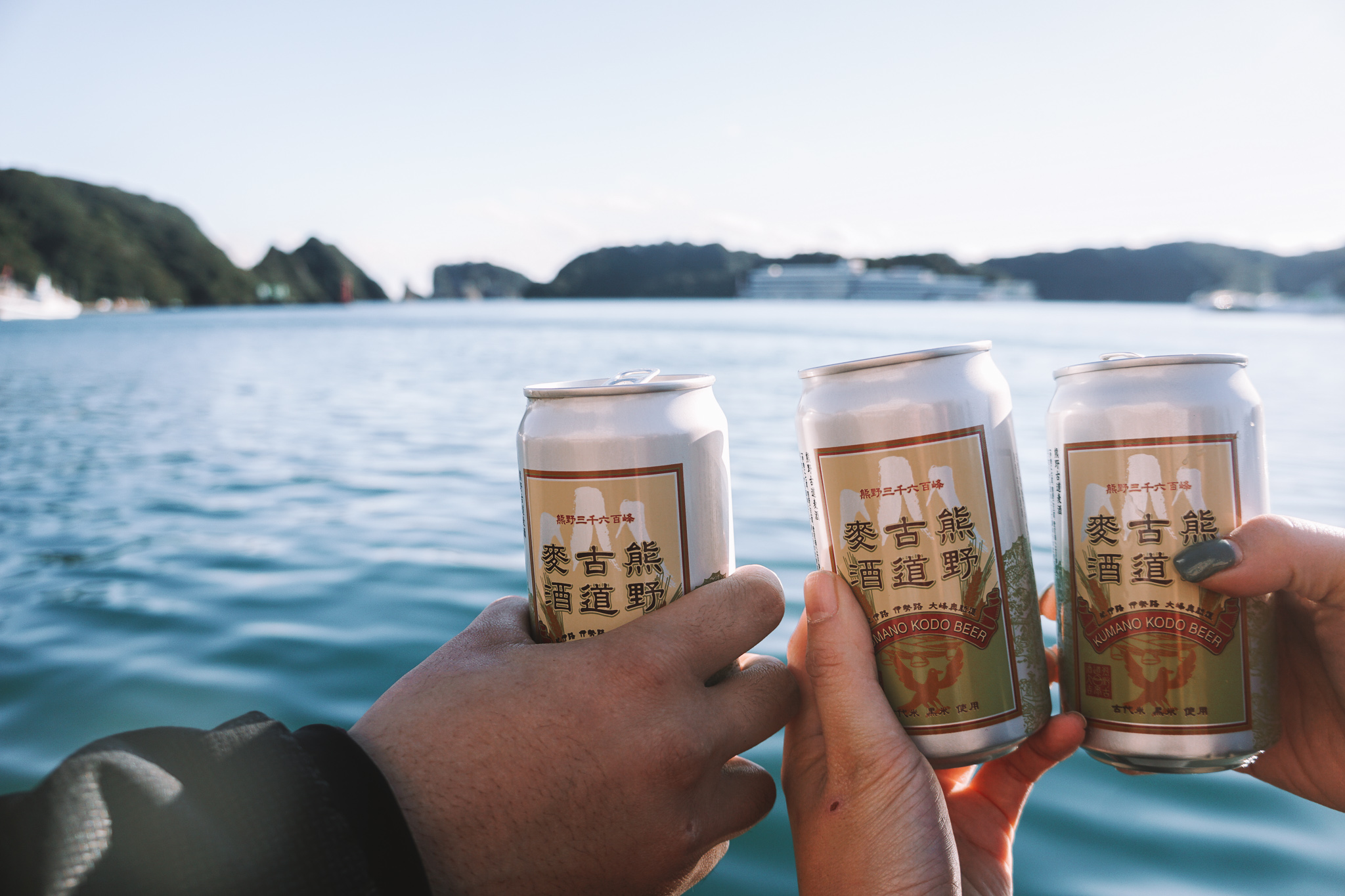
After you hike Kumano Kodo, you will really need a day of relaxing by the sea. So, your last day of this trip should involve exploring Katsuura, a Japanese coastal town with a thriving fishing port. Here you can explore the beaches, try seafood caught freshly that day, or go for a boat tour of the harbor. here are the best things not to miss in Katsuura.
Things to Do
Go for a bay cruise.
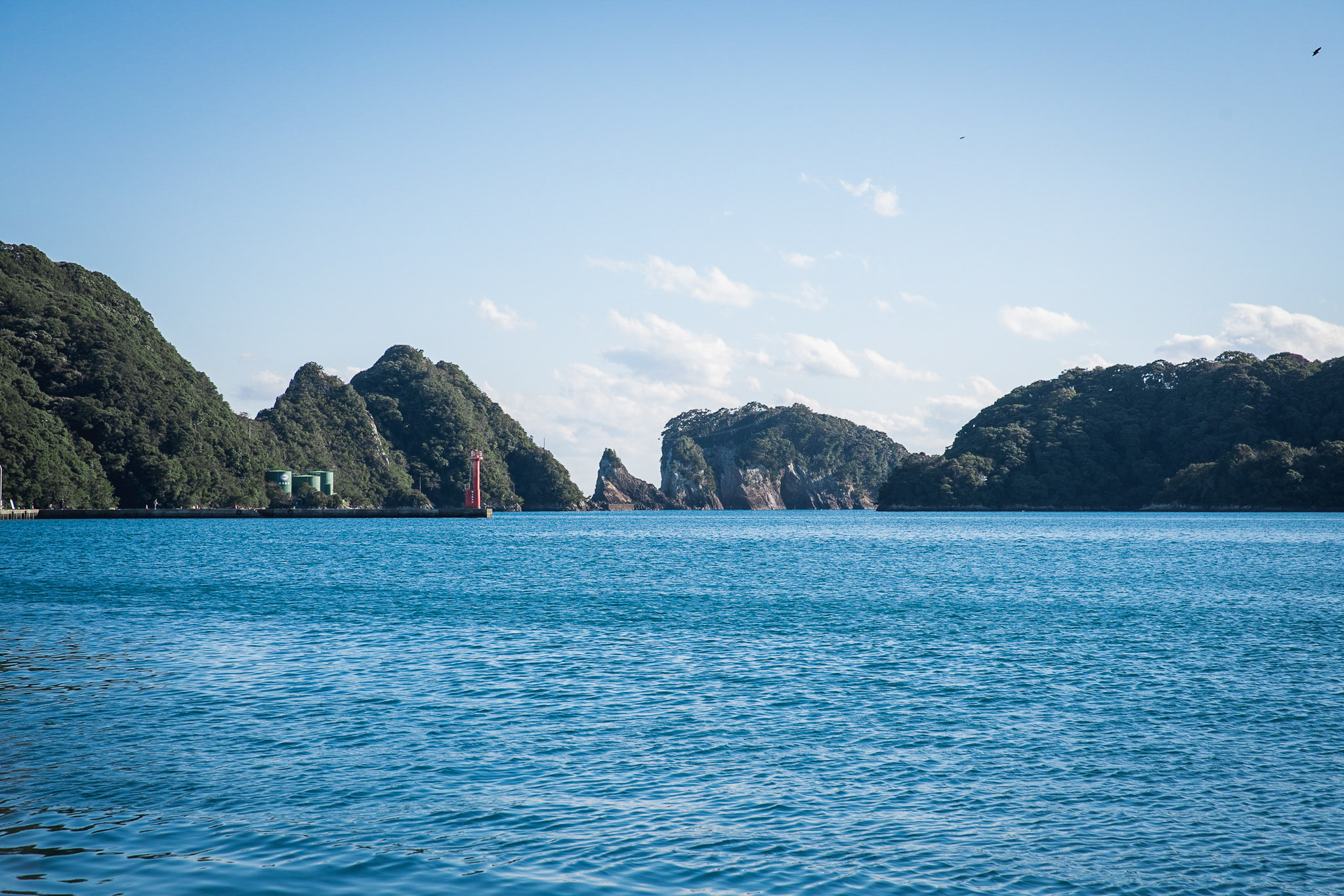
The entire coastal area of Katsuura is comprised of bays and little islands, which are considered a marine park in itself. A bay cruise is the best way to enjoy the scenic coastline from the water, and visit the smaller islands off shore. If you are lucky, you may even spot a pod of dolphins or a whale.
Attend the Fish Auction
Some travelers take intrigue in attending Japanese fish auctions. If you can wake up early enough, you can experience the excitement (or lack thereof) at the local tuna auction every morning at 7 AM, at the Katsuura Fish Market.
Outdoor Natural Onsens
Katsuura is home to a number of natural outdoor onsens. One of the most popular is Rakuda-no-Yu, also known as “Camel Rock”. This bath requires a short boat trip to reach, and is mixed gender. The best part? The view of the entire bay from the hotspring!
Tomisaki Shrine
You may feel burnt out from temples after trekking the Kumano Kodo, but if you aren’t, you could visit Tomisaki shrine. This shrine is located in the center of town, and holds an important place in the history of this area.
Eat Fresh Tuna
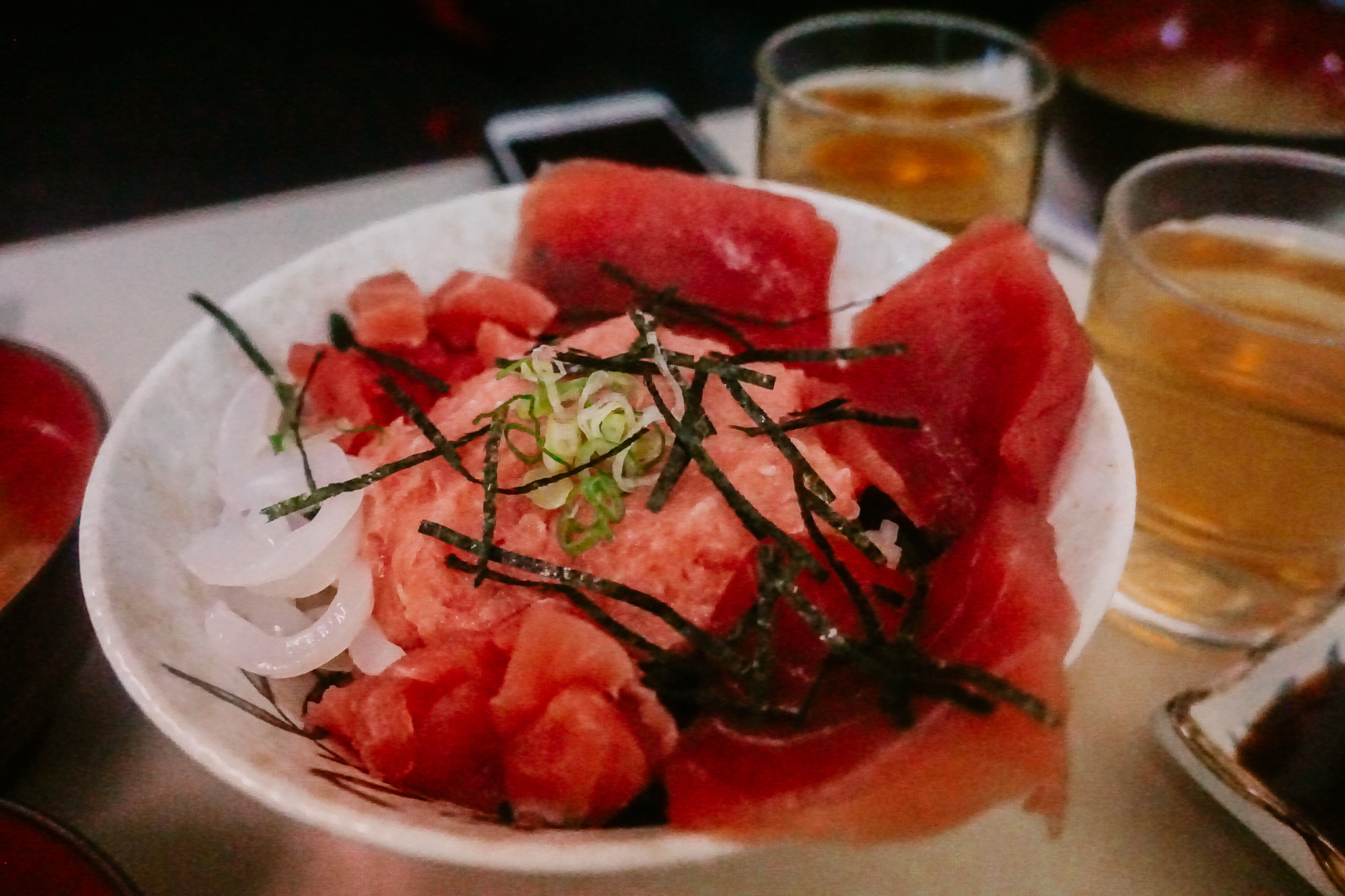
An absolute highlight of visiting Katsuura, is eating enough seafood to fulfill your hearts content. The most famous seafood from this city is bluefin tuna. In my opinion, the best way to enjoy it is as sashimi over rice. It’s so incredibly fresh, and a bit cheaper than in the bigger cities.
Katsuura Central Beach
If you are visiting in summer, you could even go for a swim since it will be warm enough. This beach also features a tori gate right on the beach, which makes an epic sunset photo spot.

And there you have it! The complete guide on how to hike Kumano Kodo in Japan. This trek was one of the best experiences I’ve had not only in Japan, but in the world. It’s not to be missed.
What’s your favorite hike in the world? Let me know below!
YOU MIGHT ALSO LIKE

February 24, 2021 at 4:07 pm
Wow! What an amazingly detailed post about Kumano Kodo! I’ve never heard of it, but the photos are absolutely beautiful, I definitely recognize the pagoda. If I ever visit, I will definitely follow this guide, you’ve covered everything!
February 25, 2021 at 11:10 am
Yeah the pagoda is definitely the most famous landmark of this trip. I can only imagine what the ancient pilgrims thought when they saw it for the first time
February 24, 2021 at 4:20 pm
I don’t think I will ever be up for an intense hiking trip in Asia, but I know what to read now if I decide to do so in the future. What kind of hiking boots/shoes do you have? When I hiked up Mt Snowdon in Wales (an “easy” hike) I bought hiking shoes instead of boots, since I liked the freedom of movement it gave me and the lack of breaking in required.
February 25, 2021 at 10:32 am
Between you and I, I trekked the Kumano Kodo in running shoes and lived to tell the story! But for the post, I have to give the most practical advice. There are lot’s of streams to cross, and uneven terrain over large tree roots and boulders. Boots are ideal because they will support your ankles and keep your feet dry. The last thing you want is wet feet esp in winter. It’s a recipe for getting sick. A reliable brand for hiking boots is Salomon 🙂
February 25, 2021 at 4:40 am
This is great – I’ve only done the “popular” places in Japan like Tokyo. This makes me want to book a return trip!
February 25, 2021 at 11:07 am
Japan is definitely a place to travel more than once, there’s so much to see
February 25, 2021 at 4:30 pm
Great blog post! Amazing amounts of history, nature and good practical information. Your photos are AWESOME!
February 26, 2021 at 2:41 pm
Thanks! Had to make use of all that extra weight my camera gear added
February 25, 2021 at 4:59 pm
How fascinating to hike the Kumano Kodo and know you are walking the path of pilgrims from ages past. Good to know the path is in decent shape these days to hike and accessible pretty much all year round. What an amazing variety in the things you saw along the way for 6 days.
February 26, 2021 at 2:42 pm
February 25, 2021 at 7:13 pm
This sounds like a fantastic and spiritual experience. I will definitely include it in my itinerary when I go back to Japan. I enjoyed a temple hike in Takayama a lot, hence, can imagine how immersive this experience must be. I also love how close you got to the local culture – which is not that easy in reserved Japan 😉
February 26, 2021 at 2:43 pm
Oh, I love Takayama! I wonder if it’s the hike I’m thinking of, can’t remember the name, but I didn’t get to do it in the end. Anyway, if you were a fan of Takayama I know you’ll love Kumano Kodo.
February 26, 2021 at 1:18 pm
Wow I didn’t know much about this and certainly didn’t know it was a world heritage site, but rightly so. What a fascinating history this trail has. Thank you for the detailed information on this, you have put Kumano Kodo on my radar for my future plans in Japan.
February 26, 2021 at 2:45 pm
I had never hear of it until my second year in Japan either. Just makes me wonder what other amazing places am I yet to know even exist.
Leave a Reply Cancel reply
Your email address will not be published. Required fields are marked *
Save my name, email, and website in this browser for the next time I comment.
- Media & Industry
- Meetings & Events
- Select Language 简体中文 繁體中文(香港) 繁體中文(臺灣) India (English) Bahasa Indonesia 한국어 ภาษาไทย Tiếng Việt Singapore (English) Philippines (English) Malaysia (English) Australia/New Zealand (English) Français Deutsch Italiano Español United Kingdom (English) Nordic countries(English) Canada (English) Canada (Français) United States (English) Mexico (español) Português العربية Japan(日本語) Global (English)
- India (English)
- Bahasa Indonesia
- Singapore (English)
- Philippines (English)
- Malaysia (English)
- Australia/New Zealand (English)
- United Kingdom (English)
- Nordic countries(English)
- Canada (English)
- Canada (Français)
- United States (English)
- Mexico (español)
- Global (English)
- Fujiyoshida
- Shimonoseki
- Ishigaki Island
- Miyako Island
- Kerama Island
- Tokyo Island
- Koka & Shigaraki
- Hida Takayama
- Ginza, Nihonbashi
- Beppu & Yufuin (Onsen)
- Ginzan Onsen
- Nagasaki Islands

- Kumano Kodo
- Shikoku Karst
- Amami Oshima
- Hachimantai
- Omihachiman
- Aizuwakamatsu

- Diving in Japan
- Skiing in Japan
- Seasonal Flowers in Japan
- Sustainable Outdoors
- Off the Beaten Track in Japan
- Scenic Spots
- World Heritage
- Home Stays & Farm Stays

- Japanese Gardens
- Japanese Crafts
- Temple Stays
- Heritage Stays
- Festivals and Events
- Theater in Japan
- Japanese Tea Ceremony
- Cultural Experiences in Japan
- Culture in Japan

- Local Cuisine Eastern Japan
- Local Cuisine Western Japan
- Local Street Food
- Japan's Local Ekiben
- Japanese Whisky
- Vegetarian and Vegan Guide
- Sushi in Japan Guide
- Japanese Sake Breweries

- Art Museums
- Architecture
- Performing Arts
- Art Festivals
- Japanese Anime and Comics
- Japanese Ceramics
- Local Crafts

- Scenic Night Views
- Natural Wonders
- Theme Parks
- Samurai & Ninja
- Iconic Architecture

- Wellness Travel in Japan
- Japanese Ryokan Guide
- A Guide to Stargazing in Japan
- Relaxation in Japan
- Forest Bathing (Shinrin-yoku)

- Experiences in Japan
- Enjoy my Japan
- National Parks
- Japan's Local Treasures
- Japan Heritage
- Snow Like No Other
- Wonder Around Japan

- Visa Information
- Getting to Japan
- Airport Access
- COVID-19: Practical Information for Traveling to Japan
- Anime Tourism
- Countryside Stays
- Accessible Tourism
- Hokkaido Great Outdoors
- Scenic World Heritage in Tohoku
- Shikoku’s Nature and Traditions
- Southern Kyushu by Rail

- Traveling by Rail
- How to Travel by Train and Bus
- JR Rail Passes
- Scenic Railways
- Renting a Car
- Sustainable Travel in Japan
- Travel Brochures
- Useful Apps
- Online Reservation Sites
- Eco-friendly Accommodation
- Luxury Accommodations
- Traveling With a Disability
- Hands-free Travel
- How to Book a Certified Tour Guide
- Volunteer Guides
- Tourist Information Center

- Japanese Manners
- Spring in Japan
- Summer in Japan
- Autumn in Japan
- Winter in Japan
- Cherry Blossom Forecast
- Autumn Leaves Forecast

- Japan Visitor Hotline
- Travel Insurance in Japan
- Japan Safe Travel Information
- Accessibility in Japan
- Vegetarian Guide
- Muslim Travelers
- Safety Tips

- JAPAN Monthly Web Magazine
- Arts & Cultures
- Nature & Outdoor
- Festivals & Events
- Insider Blog
- Things to do
- Local Guides
- Food & drink
- Traditional
- Hokuriku Shinetsu

My Favorites
${v.desc | trunc(25)}
Planning a Trip to Japan?
Share your travel photos with us by hashtagging your images with #visitjapanjp
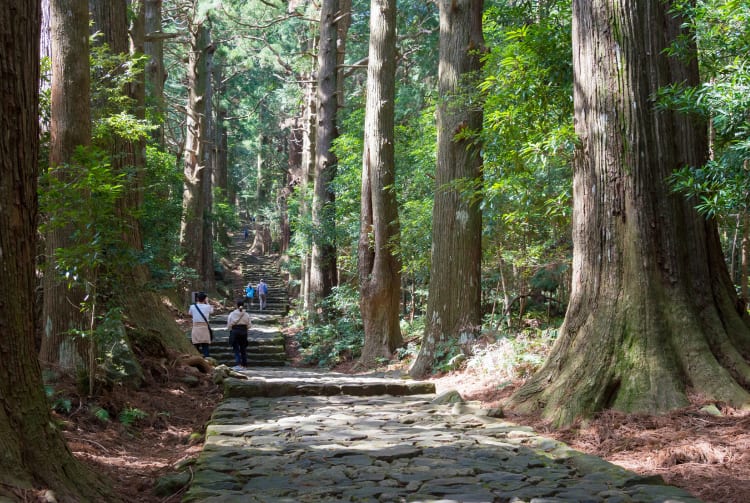
For centuries pilgrims have followed the Kumano Kodo, sacred trekking routes through Mie, Nara, Wakayama, and Osaka prefectures that were established over a thousand years ago. The trail is a UNESCO World Heritage site, connecting three of the area’s most sacred shrines—the Kumano Sanzan—with other natural and spiritual sites throughout the region. Stroll along stone paths through tranquil forest mountain paths, and connect with Japan’s spiritual and cultural traditions. Various routes have been popularized throughout the years, such as the Kohechi Route from the sacred mountaintop temple Koyasan to Kumano Hongu Taisha, or the Nakahechi Route from Tanabe to the Kumano Sanzan. Choose the one that best suits your interests.
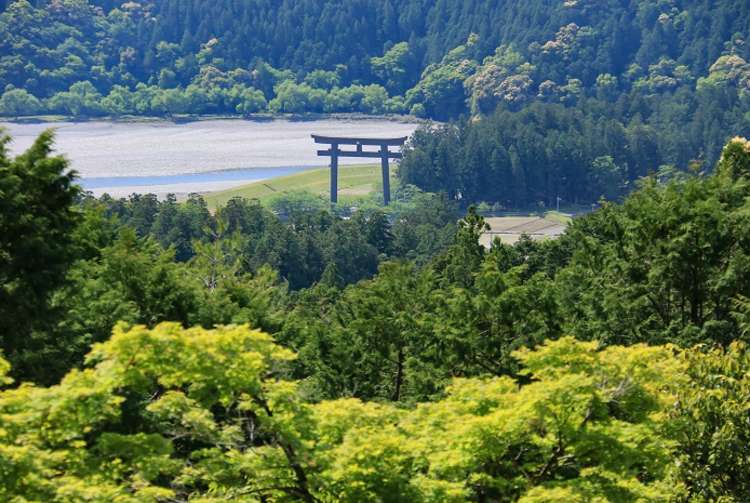
Duration 1day / 4.5hours Highest Point 1,072m (Hatenashi-toge Pass) Elevation Gain 990m Horizontal Distance 8.5km
* Duration is an estimate and may vary depending on route and pace.
Reference: Kohechi Route (Hike of a Scared Mountain via the Kumano Kodo Pilgrimage Route)
Access to the Kumano Kodo varies depending on the route. From JR Gojo Station, take a bus to Warabio, and walk to the trailhead. The trip takes about 3.5 hours. Or take a local bus from JR Kii-Tanabe Station to Hosshinmon-oji, a trip of about 2.5 hours.
Kumano Kodo (Tanabe City Kumano Tourism Bureau)
Kumano Kodo (Hikes in Japan)

Other Hiking & Trekking Courses
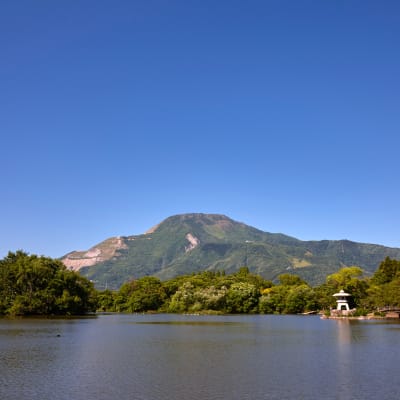
Explore by Interest

Find the backdrop for your next adventure

- Hiking & Trekking
- Hiking & Trekking Courses
Please Choose Your Language
Browse the JNTO site in one of multiple languages
- Tokyo Cheapo (繁體中文)
Sacred Pilgrimages: Hiking the Kumano Kodō
Thousands of feet on spiritual journeys have beaten the paths of the Kumano Kodo over the past thousand years. The network of pilgrimage routes runs across the mountainous Kii Peninsula in Wakayama Prefecture, down in the southern part of the Kansai region . Whether you find solace in Buddhist tradition, something Abrahamic or simply see Nature as your temple, it’s easy to see why the Kumano Kodō is a UNESCO World Heritage Site (the only other place of pilgrimage on the list is the Camino de Santiago in Spain).

A sacred triangle of temples
The Kumano area has been considered a sacred site since prehistoric times. First associated with nature worship, it became something of a super spot for ascetic training when Buddhism rolled into Japan around the 6th century. Over the years, Buddhism and Shinto mingled, and the worship at the shrines in Kumano changed shape.
There are three major shrines in Kumano: Hayatama Taisha, Hongu Taisha and Nachi Taisha. Together, they are known as the Kumano Sanzan; each enshrines one of the area’s mountains, and under the influence of Buddhism came to be worshipped as the three deities of Kumano. There are two Buddhist temples in the complex, too — Seiganto-ji and Fudarakusan-ji. It’s all rather complicated, and I’m certainly no expert in Japanese religion — have a look at the Wikipedia page for more insight.
Over the centuries, the Kumano Kodō became popular first among members of the imperial family and aristocrats, and later among the general populace. People of all shapes, genders and sizes made the holy trek, sometimes more than once. Fast-forward to the present, and not much has changed, there. Thousands hike the trails each year — and I’ve recently added my name to that list.
The here and now
As part of a cheapo mission, I strapped up and set off to cover at least some of the Kumano Kodo (the routes are seven-fold, varied and long), and now, based on my experience, I’ve put together this guide to make it easy for you to venture out there too.

Hiking Kumano Kodō: The basics
Hike itineraries are typically 4-6 days , but you can extend or shorten them as you like. The altitude is fairly low (most of the hiking is below 600m), and the routes are relatively easy, provided you’re in good health. If you’re keen on roughing it, you can pitch a tent at campsites along the routes, but a big part of the charm of the whole experience is staying at a small traditional B&B or hotel ( minshuk u or ryokan ) in the villages and hot spring spots. It’s also a lot kinder to tired muscles!
You can take a completely DIY approach to the Kumano Kodō, but we recommend booking your trip with the community-run Kumano Travel . They are reasonably priced, have an intimate knowledge of the area, and are proponents of responsible, sustainable travel — which we like. You can opt for self-guided or guided tours, and pick accommodations to suit your budget. Oh, and they didn’t pay us to say all that.

Like anywhere else in the country, the Kumano Kodō can get a little crowded on Japanese national holidays and weekends. Golden Week (the slew of holidays at the end of April and early May) and Obon (mid-August) are perhaps the busiest (and therefore best times to avoid). If you can manage a mid-week trip, do that — most people will be at work.
How to get there
The Kumano Kodō is quite a distance from Tokyo (about six hours by various train combinations), so your best bet is to spend the night before in Osaka , and take the ~2-hour train ride from Tennoji Station early in the morning. The start of the main trail is reached by train to Kii-Tanabe (where a helpful visitor center is located), then a bus outside the train station to Takajiri (about 40 minutes).
There’s a handy and cheap luggage-forwarding service available , which is a very welcome option if you are on a longer trip and have regular suitcases. This is basically just a local chap who drives your luggage to your next accommodations whilst you hike un-burdened.
Sample itinerary: The Nakahechi route
The photos and ramblings you’ll see below (and above) are from this 4-day/3-night itinerary , which I recommend for everyone, really. It takes you from Takijiri-oji to Kumano Hongu Taisha , requiring one half-day and two full-day walks.
The Nakahechi route takes you east into the mountains, towards the Kumano Sanzan, and is the most popular route for pilgrims from the Western regions of Japan. It was favored by the imperial family back in the day, so you’ll be following in the footsteps of royalty.
Day 1: Takijiri-oji to Takahara
The first day eases you into the hike, with a 3.7-km walk that takes 2.5 hours or so, depending on your fitness levels. I managed it with no trouble, and booked into a lovely ryokan called Kiri no Sato in Takahara (organized in advance). After chomping down some fresh, healthy local food, taking in the awesome mountain views, and getting a good night’s sleep, I was ready for the full day’s hike ahead.

Day 2: Takahara to Tsugizakura-oji
This was a 14km, 7-hour walk (you can do it in six or under if you are super fit) that took us high up into the mountains and along forested paths. We walked under and over massive Cryptomeria trees and past abandoned tea houses, seeing several shrines and statues dotted about. The day was made easier by the man in the picture below, who serves up surprisingly excellent coffee.

I overnighted at a quaint little place called the Iriorian Minshuku in Nonaka, which was simple but eminently sufficient. It was a good place to put my feet up and get in some chill-time in the last rays of the afternoon sun.
Fun fact about Nonaka: You can find one of “the 100 famous waters of Japan” at the Nonaka-no-Shimizu spring. This is a cool spot to fill up your canteen.

Day 3: Tsugizakura-oji to Kumano Hongu Taisha
This is the day you’ll need to mentally prepare yourself for, as it’s a 21-km trek that easily takes the whole day (think 7-8 hours). Demanding is one way to describe it; lengthily scenic is another. The route takes you through mountain-top villages and past pretty awesome lookout spots (have your camera ready) as it meanders towards the grand shrine that is Kumano Hongu Taisha.

A word of warning — there aren’t any eateries until you get close to the shrine. When you get to a place called Fushiogami-oji (where you’ll catch your first glimpse of the Kumano Hongu Taisha in the valley below), you might find a few vendors selling snacks and coffee (but only if you happen to catch them on their somewhat erratic business days).

A long stone staircase will lead you up to the shrine, which is on a ridge and surrounded by huge cedar and cypress trees. Entrance is free, but if you want to peek into the Homotsuden Treasure Hall, you’ll have to pay ¥ 300 (it’s cheaper for youngsters) and make sure you get there between 9am and 4pm.

While the shrine may look really old (and to be fair, it is), it was originally built on a different site called Oyunohara. That’s the name of a sandbank at the confluence of the Kumano and Otonashi Rivers. Unfortunately, a flood wrecked the place in 1889, and Kumano Hongu Taisha was relocated to its current spot. You can still see Oyunohara; it happens to be marked with the largest torii in the country — 42m wide and 33.9m tall. The torii gate is steel and brand new, having been erected in the year 2000. Look out for it.

Sad sidenote: While all three days offered beautiful hikes, sadly the overzealous Japanese bureaucracy-plus-construction engine has run deep into the countryside. Concrete-lined mountain streams are all too common a sight all over Japan, and the Nakahechi route of the Kumano Kodo is no exception. This is a real pity, as the ubiquitous concrete and man-made cedar forest with little biodiversity (almost no bird song) at times threaten to spoil the historical pilgrimage.

Day 4: Bus back to Kii-Tanabe
The end point of Day 3 is the old hot spring town of Yunomine. After a good soak in the steaming baths and a solid night’s sleep, you simply hop onto a bus the following morning and head back to Kii-Tanabe. From there, you can board the train home.
Lunches and snacks: The ryokan usually provide a packed lunch for you to take on your hike (they certainly did in my case), but be warned that the portions are a little on the, well, little side. It’s a good idea to stock up on protein bars and snacks in Osaka before you head off on your hike.
For a more detailed guide to the Nakahechi and other routes of the Kumano Kodō, have a look at Kumano Travel . They have PDFs and everything. Respect.
- Accommodation
- Irorian Minshuku
- Kiri no Sato
- Kumano Hongu Taisha
- Restaurants
Get the best Japan Cheapo hacks direct to your inbox

Updated: 2024 Japan Cherry Blossom Forecast
The blooms are fashionably late. Here's when to see sakura in all the major cities.

April 2024: Top Events Around Japan
Look forward to flowers and festivals galore!

8 Perfect Places To See Cherry Blossoms in Osaka
Castle grounds, sprawling parks — and somewhere extra special.

Cherry Blossoms in Kyoto: 14 Best Sakura Spots
From temples to riversides, geisha districts — and more.

9 Things To Do in Fukui
Explore the shiny new stop on the Hokuriku Shinkansen — an easy trip from Tokyo.

6 Must-See Fertility and "Penis Festivals" in Japan
Stop giggling and start reading.

11 Best Places to See Cherry Blossoms in Japan
Riverside paths, real castle moats, pagodas and more.

Ghibli Park Guide: Tickets, Getting There and More (Updated)
Now with the Valley of Witches, and real-life cat buses.

March 2024: Top Events Around Japan
Plum and cherry blossoms, spring festivals, the Grand Sumo Tournament in Osaka — and more!

The Survival Guide to Kyoto Station
Bookmark this for easier travels.

5 Reasons To Visit Ishikawa
The prefecture extends a warm welcome, as part of its efforts to rebuild in the wake of the Noto earthquake.

February 2024: Top Events Around Japan
Winter wonderlands, oyster festivals, and rituals to chase away demons.

Recommended hotels located nearby

Close without accepting
You are using an outdated browser. Please upgrade your browser or activate Google Chrome Frame to improve your experience.

- Nakahechi – ‘ The Imperial route’
- Kohechi – the Mountainous Route
- Iseji – the Eastern Route
- Ohechi – the Coastal Route
- Walking Tours
- FAQ’s

Japan's Sacred Pilgrimage walk
A practical guide to walking the kumano kodo trails by raw travel, kumano kodo food , getting to the kumano kodo trailhead, kumano kodo accommodation, practical considerations, kumano kodo walking tours.

Kumano Kodo, Koyasan & Kyoto
Self-guided Kumano Kodo, Koyasan and Kyoto tour with a flexible itinerary This self-guided Kumano Kodo […]
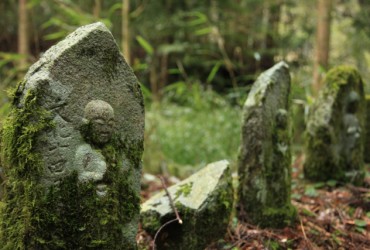
Kumano Kodo trail
Kumano Kodo trail (self-guided, on demand) – Nakahechi route including Grand Shrines This self-guided […]
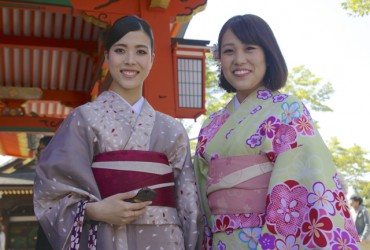
Kumano Highlights
Kumano Kodo highlights This itinerary is perfect for those who wish to explore the […]
Testimonials
“We loved everything about this experience on the beautiful, unspoilt Kii Peninsular. The scenery was wonderful, the trails varied and interesting and satisfyingly challenging. The immersion in Japanese culture was authentic and rewarding and our hosts, accomodation and food were simply superb. The support and options provided by RAW Travel were much appreciated as an unfortunate knee injury just prior to our trip meant some modifications to original plans. The self-guided option was the perfect balance for us. We really appreciated the fact that the support was certainly adequate to give us confidence to do what we did but not so organised and complete as to detract from the sense of adventure we felt from being independent and able to negotiate our way around local transport, sights and activities and to explore the things that were of greatest interest to us.”
“A big thank you for organising a terrific trip! I think most of us are back now and all really had a wonderful experience. What an amazing place! Thanks again for all your trouble.
It was such a lovely experience from beginning to end. Far better than I expected really especially when it came to:
– we were always greeted with a friendly, helpful manner – the locals we met along the way were such humble and respectful people – everything was clean, ran precisely and reliably – food was wonderful, same with accommodation – the scenery was a favourite – spectacular old cedar trees to pretty blossoms and orchards etc – enjoyed the challenge of the walk and reading the amazing history – we always felt safe and help was nearby
I would love to go back again someday…”
“I feel limited by words when trying to express my experience with Japan and walking The Kumano Kodo. The land and people of Japan are, in one word, beautiful. I fell in love with Kyoto from the moment I arrived. My two night stay at the Zen temple in Koyasan was, well, Zen! So peaceful and welcoming, a perfect way spend a couple relaxing nights before embarking on my pilgrimage. And joining the monks for their morning ceremony was a wonderful experience to shall never forget and hope to have again, soon.
The walk itself was just magic, from the locals, to the landscape and the lodging along the way. Your comprehensive instructions were so easy to follow and inline with the current situation in Japan regarding transports timetables etc. The instructions and track notes you provided made it soooo easy to follow the trail, I almost felt like I was cheating in my efforts to complete the pilgrimage…with the trail being so well marked, it’s almost impossible to get lost, and having the confidence of your detailed track notes allowed me to enjoy the journey that much more. Not to mention the helpful locals i met along the way.
I really cant say enough about the whole experience and I’m very grateful for RAW’s efforts in putting the whole trip together for me and I will not hesitate to use or recommend your services again.”

“We have now returned from our trip to Japan. We had the best time & loved the Kumano trek. The accomodation, food, transporting of our bags, maps…everything was fantastic & really well organised. Oh the food…the food…the lovely food!!!! Thank you for your help organising this trip. I would definitely use Raw Travel again!!!”

Copyright RAW Travel 2018
- Destinations
Kumano Kodo Pilgrimage Routes Guide
Kumano Kodo Guide to Sacred Routes and Shrines
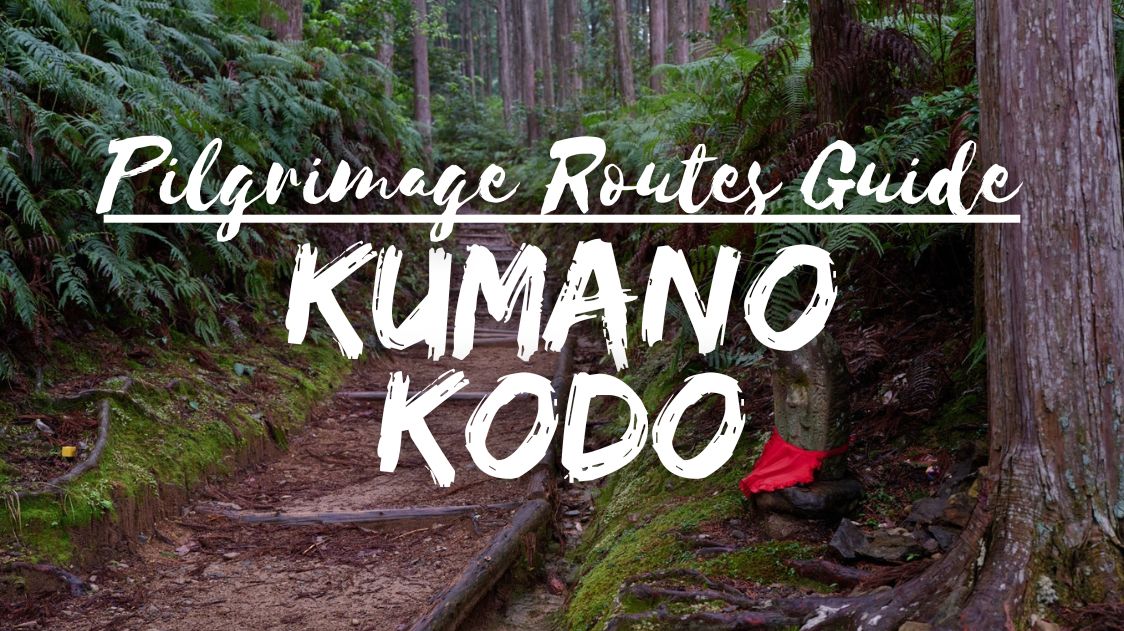
In Japan’s Kii Peninsula, the Kumano Kodo draws through the landscape, a network of ancient paths with more than a thousand years of history. This pilgrimage route, the only one in the world recognized as a UNESCO World Heritage Site along Spain’s Camino de Santiago, connects the natural beauty of the region with its deep spiritual heritage.
Here, emperors, warriors, and seekers have all embarked on journeys that intertwine physical endurance with spiritual questing. At the heart of these paths lie the Kumano Sanzan, the collective name for the three grand shrines that embody the fusion of Shinto and Buddhist beliefs: Kumano Hongu Taisha, Kumano Hayatama Taisha and Kumano Nachi Taisha.
Traversing the Kumano Kodo is an exciting experience that allows travelers to explore the scenic vistas as well as the traditions and rituals that have been part of the Japanese way of life for centuries.
Understanding the Kumano Kodo
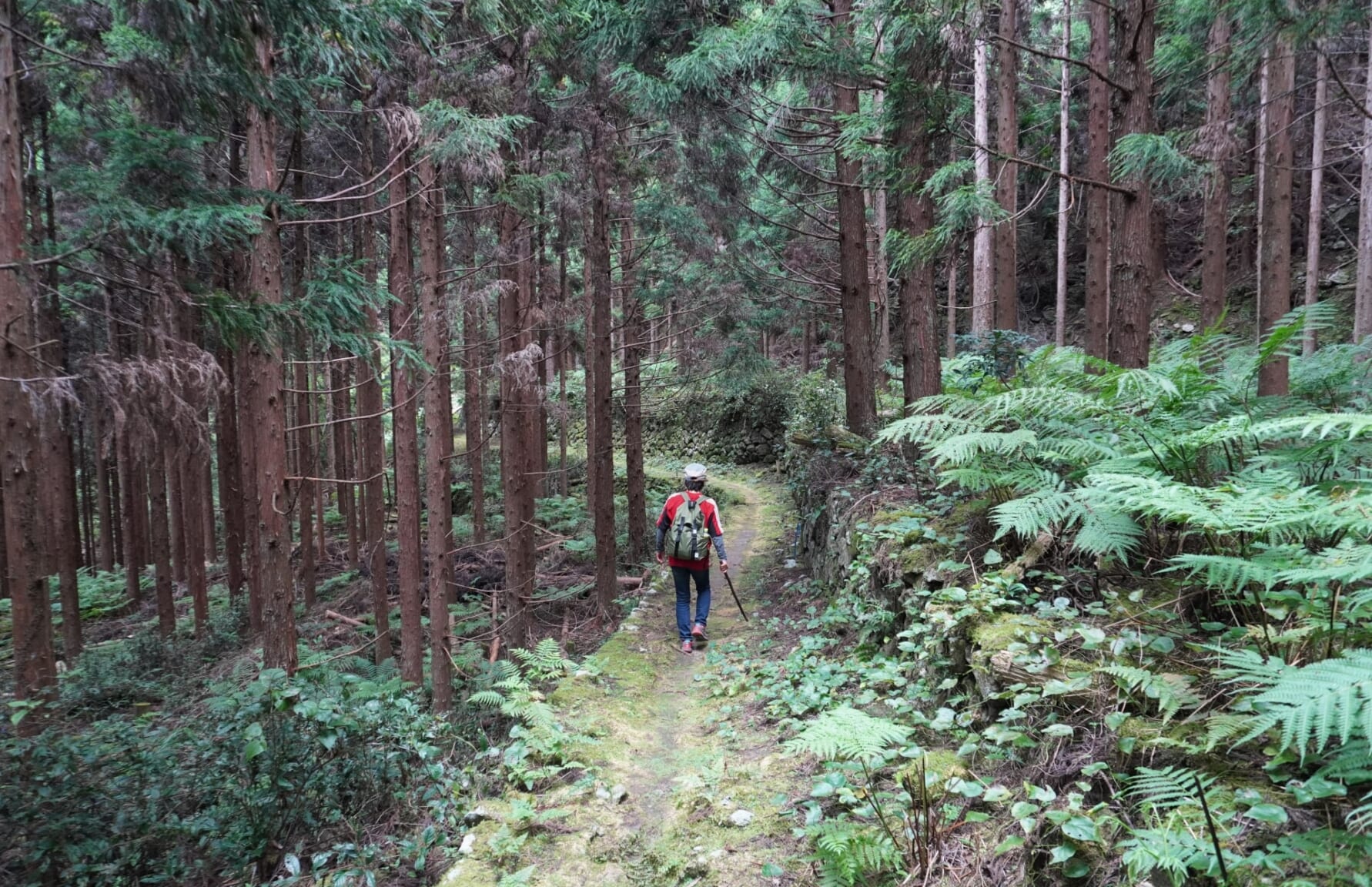
Shugendo: The Practice of Asceticism in the Mountains

The Kumano Deities: A Synthesis of Shinto and Buddhism
At the heart of the Kumano Kodo’s spiritual significance are the Kumano deities, revered in both Shinto and Buddhism. These deities, associated with the three grand shrines of Kumano, embody the region’s syncretic religious traditions, where ancient Shinto gods and Buddhas are seen as manifestations of the same divine essence. Pilgrims on the Kumano Kodo encounter along the way various symbols, rituals, and festivals that celebrate these beliefs.
Exploring the Kumano Kodo Routes
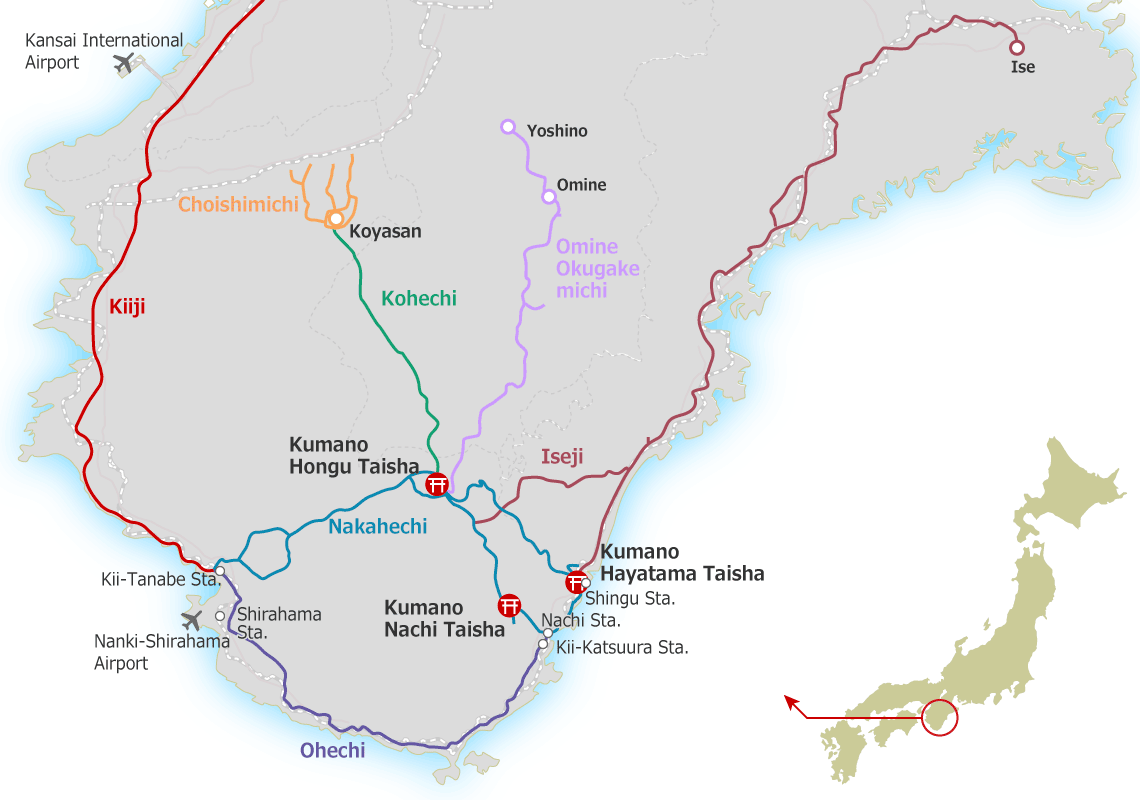
The Kumano Kodo consists of a network of trails, each with its distinct journey through. These routes vary in character, offering diverse challenges and insights into the region’s rich history and natural beauty.
Nakahechi Route: The Imperial Road
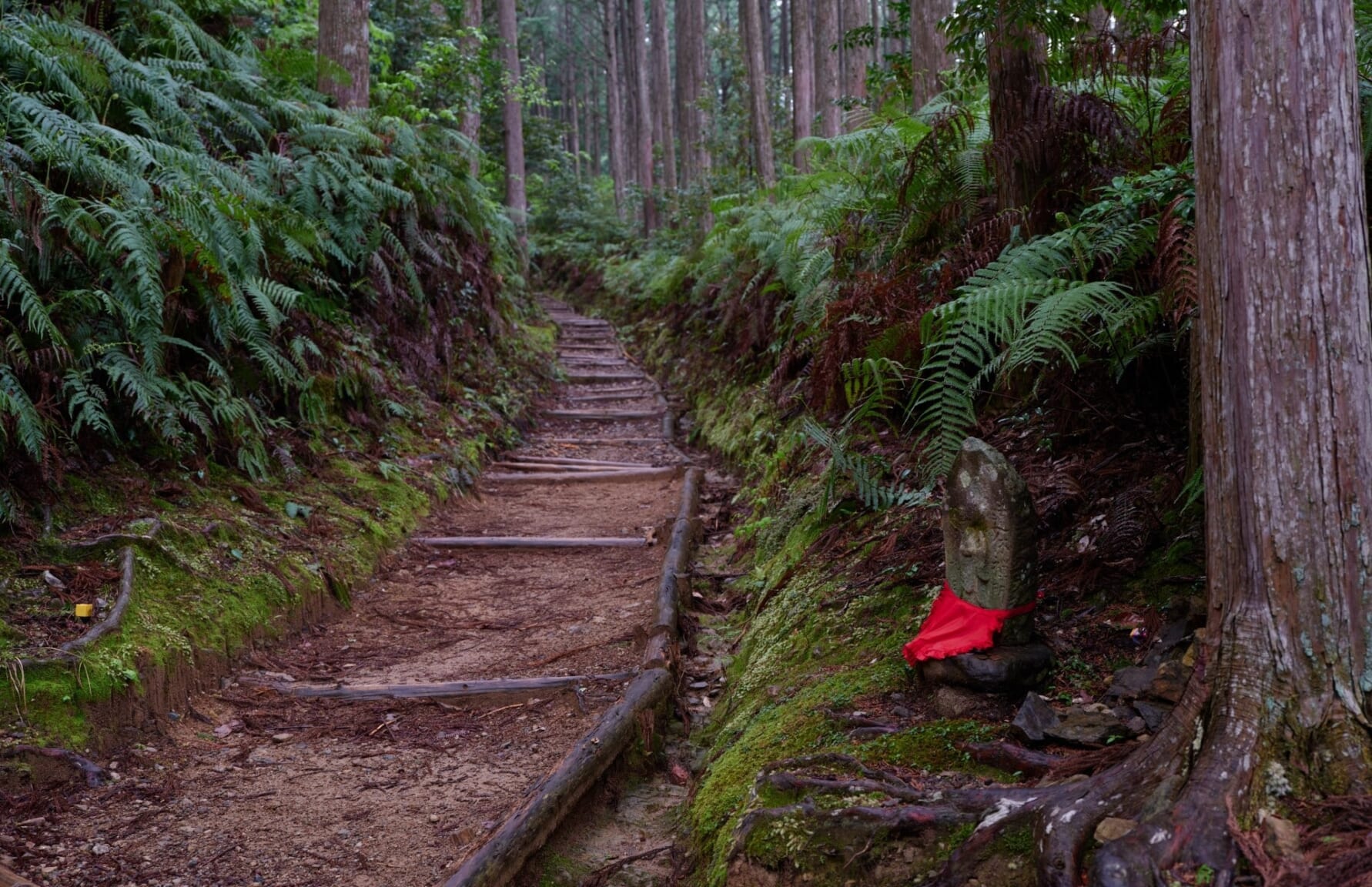
Takijiri-oji to Tsugizakura-oji
Takijiri-oji Shrine is a popular starting spot, next to the Kumano Kodo Information Center, as the western gateway to the sacred sites. The path from Takijiri-oji to Tsugizakura-oji is about 17 Km long and can be done in a day, although some may choose to break it down in smaller sections. There are lodgings and restaurants along the route as well as local buses running between Kii-Tanabe and Chikatsuyu. From this point to Tsugizakura-oji there are stone paved sections.
Tsugizakura-oji to Kumano Hongu Taisha
This leg of the journey is about 20 Km, with natural mountain trails, forest trails and some paved roads. Bear in mind you won’t find restaurants on this section so make sure to bring food. As it has less infrastructure than the previous section, we can enjoy tranquil paths, roads along creeks and the occasional waterfall, culminating in the majestic presence of Kumano Hongu Taisha.
From Hongu Taisha to Nachi Taisha y Hayatama Taisha
The hike from Hongu to Nachi typically takes two days, with the first section covering from Hongu to Koguchi village and then, from there to Nachi on the second day. There are no restaurants on these sections so you have to bring your own food.
Hayatama Taisha from Nachi Taisha or Hongu Taisha
Kumano Hayatama Taisha can be reached from Nachi Taisha over a 20Km route that can be covered in a day or less, for those opting for taking the train from Nachi station to Shingu station. There’s also an alternate route from Hongu Taisha that involves a combination of bus with a boat ride along the Kumano River.
Kohechi Route: The Mountain Pilgrim’s Trail
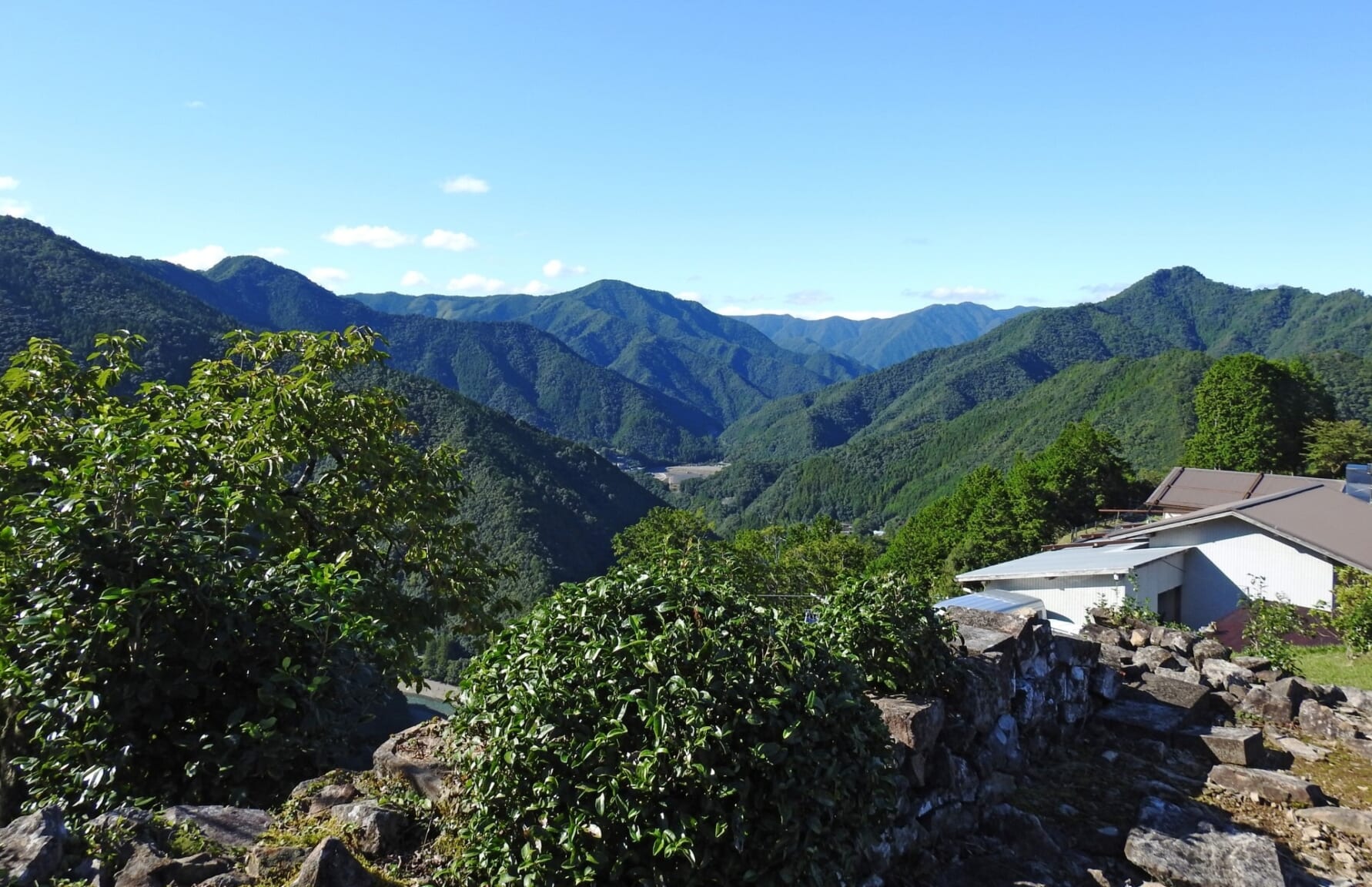
Main sections
- Koyasan – Omata : About 17 Km, around 7h walking.
- Omata – Miura guchi : About 15 Km, around 7h walking.
- Miura guchi – Totsukawa Onsen : About 18 Km, around 8h walking.
- Totsukawa Onsen – Hongu Taisha : About 15 Km, around 8h walking.
Iseji Route: The Coastal Path
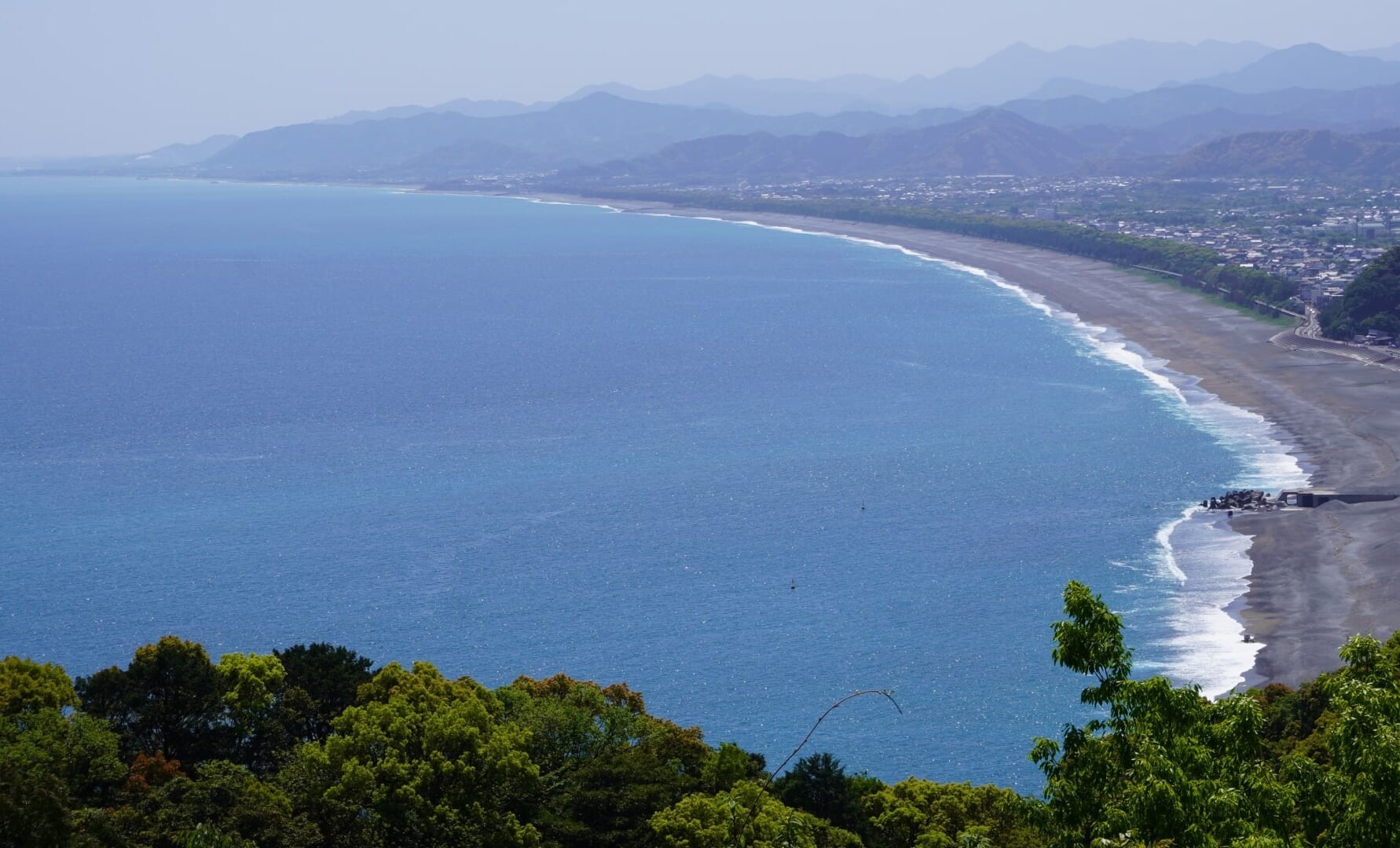
Hiking for the entirety of this path takes approximately two weeks, traversing a variety of terrains like sandy beaches or rugged cliffs, and passing through small, picturesque towns along the way. Key highlights include the ancient Magose-toge Pass, with its beautifully preserved cobblestone paths, and the well preserved post-town of Owase, with its traditional buildings that give the feeling that the Edo period was frozen in place.
Ohechi Route: The Southern Coast Path

This route is about 92 Km long and connects Tanabe City with Kii-Katsuura. This route is usually done in 3 or 4 days, going through the towns of Shirahama and Susami as popular resting spots, as well as several villages and train station to stock up in food and drinks.
More info: 3 Days Itinerary in Kumano Kodo by Ohechi Route
Omine Okugakemichi Route: The Ascetic’s Trail
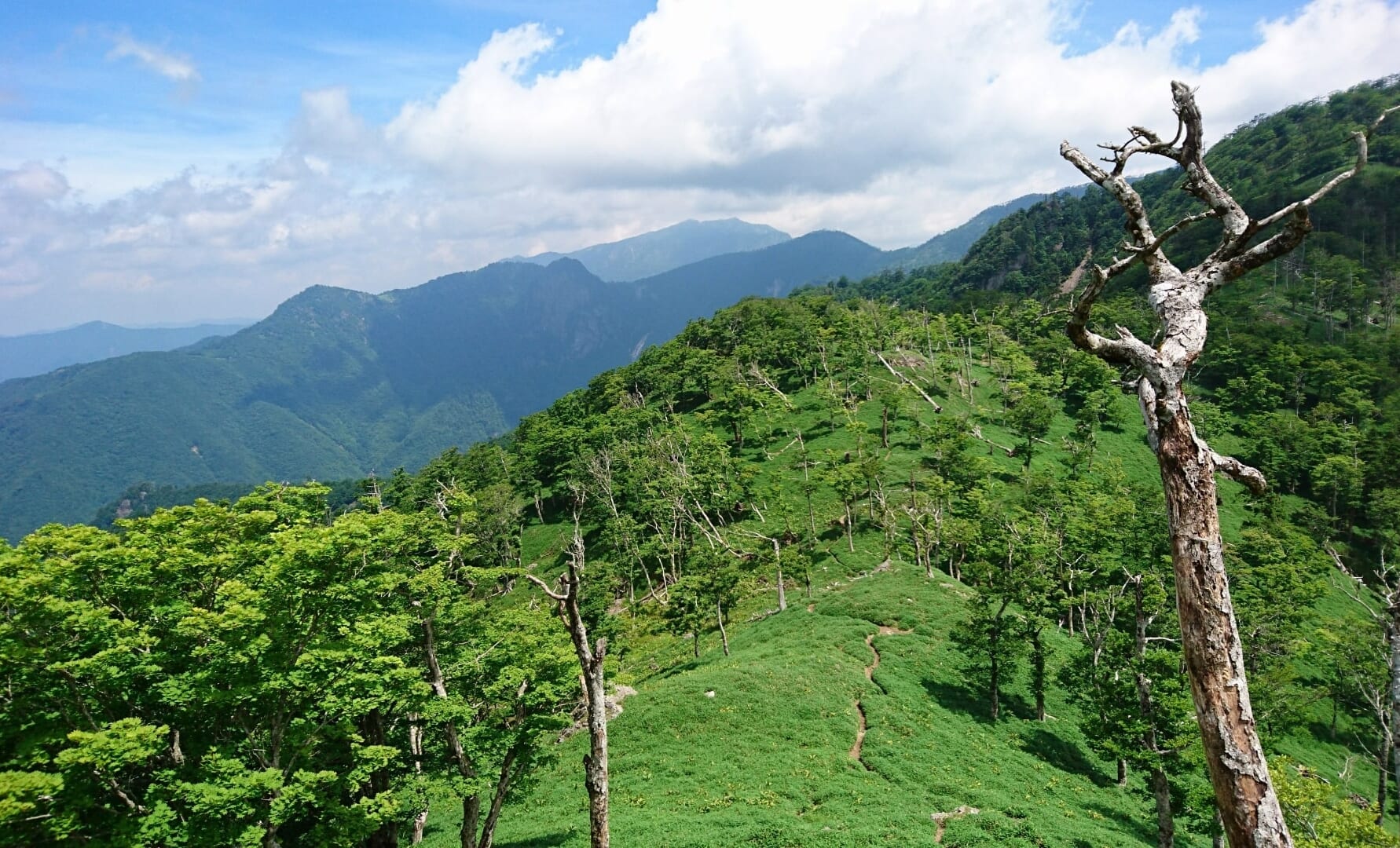
The Kumano Sanzan
Kumano hongu taisha: the heart of the pilgrimage.
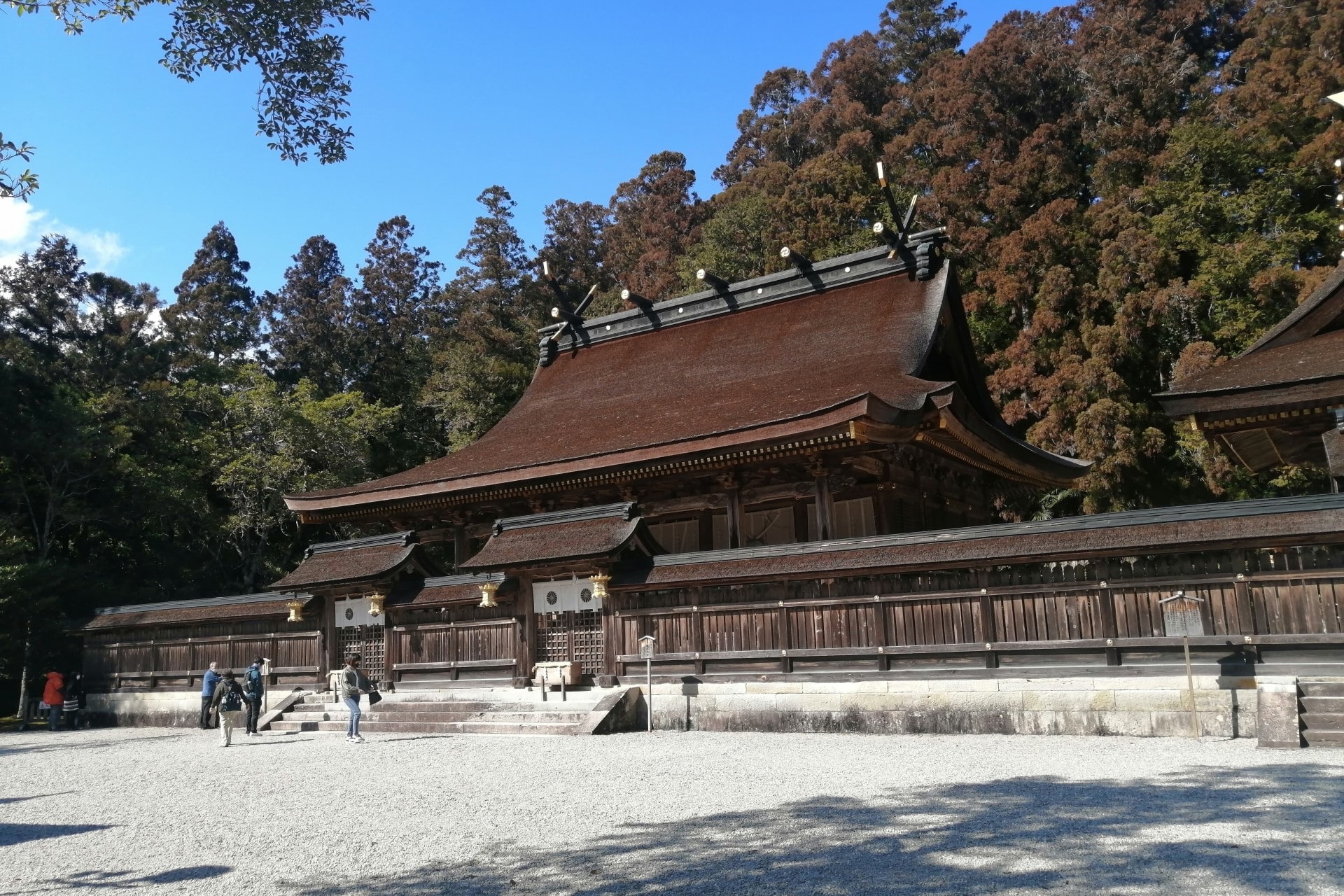
Kumano Hongu Taisha (熊野本宮大社) , in the mountains of the Kii Peninsula, is a cornerstone of the Kumano Kodo pilgrimage. The main deity of this grand shrine is Kato Mimiko no Okami, among many other deities linked with Japan’s mythical origins. The exact foundation date is unknown but it’s commonly attributed to one of Japan’s first emperors, making it one of the most ancient shrines in the country, with invaluable cultural treasures and historical artifacts. The latest reconstruction dates from 1889.
The Great Torii Gate and the Hongu Heritage
Dominating the approach to Kumano Hongu Taisha is the Great Torii Gate, the largest in the world at 33-meters tall, symbolizing the entrance to a sacred space. This gate, erected in the year 2000 at the Oyunohara sandbank, serves as a threshold, separating the mundane from the sacred, and invites pilgrims to enter with reverence and mindfulness.
Oyunohara: The Original Sacred Site
Before its current location, Kumano Hongu Taisha was located at Oyunohara, a vast, open-air sanctuary, set at the confluence of the Kumano River’s tributaries, holds deep spiritual importance. Oyunohara’s natural setting, surrounded by towering trees and flowing waters, provides a serene backdrop for contemplation and connection with nature, echoing the pilgrimage’s enduring themes of renewal and spiritual journeying.
Kumano Nachi Taisha: The Waterfall Shrine

Kumano Nachi Taisha (熊野那智大社) is a place where the imposing Nachi Waterfall creates one of the most iconic sights from all over the country. This is a unique space where the majesty of nature plays a central role. Kumano Fusumi Okami is the most important deity enshrined here, where the lines between Shinto and Buddhist traditions blur.
The Nachi Falls: Where Nature and Spirituality Intersect
Nachi Falls , with its impressive height as Japan’s tallest single-drop waterfall, is not merely a scenic attraction; it holds deep spiritual significance. The sight of the water cascading down into the basin below is a powerful reminder of nature’s cycles and its nurturing force. For many, the falls evoke a sense of awe and reflection, heightened by the proximity of the shrine’s sacred structures.
A Closer Look at the Shrine Complex
The architectural elements of Kumano Nachi Taisha, from the grand main hall to the striking pagoda of Seiganto-ji, are thoughtfully integrated into the natural landscape. As visitors move through the complex, they encounter a series of buildings that not only showcase historical craftsmanship but also tell the evolving story of this spiritual site. The interplay of architectural beauty and the lush environment offers a tranquil setting for exploration and contemplation.
Kumano Hayatama Taisha: The Shrine by the Sea
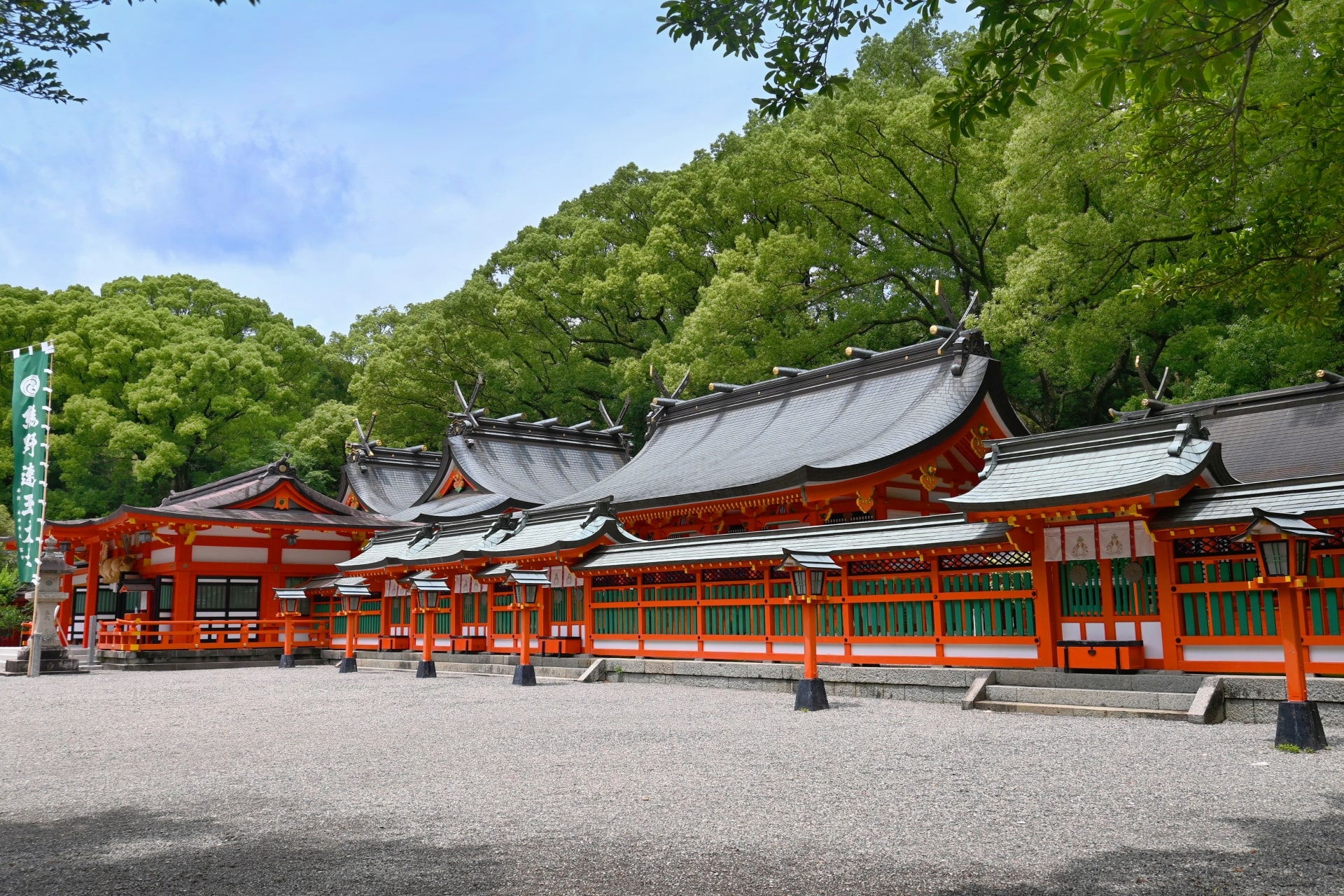
Kumano Hayatama Taisha (熊野速玉大社) is located close to where the Kumano River meets the ocean in Shingu City. It enshrines the deities of Kumano Hayatama no Okami and Kumano Fusumi no Okami among several other syncretic deities. As part of the Kumano Sanzan, this shrine is deeply rooted in the area’s history and spiritual traditions.
The Spiritual Significance of Hayatama Taisha
Kumano Hayatama Taisha is home to ancient artifacts and sacred objects that date back to the origins of the Kumano worship, as well as the towering 1,000-year-old sacred Nagi tree. Designated as a Natural Monument of Japan, the tree symbolizes calmness and safety and its leaves are taken as a keepsake for pilgrims, to protect them during their journey.
Practical Tips for Pilgrims
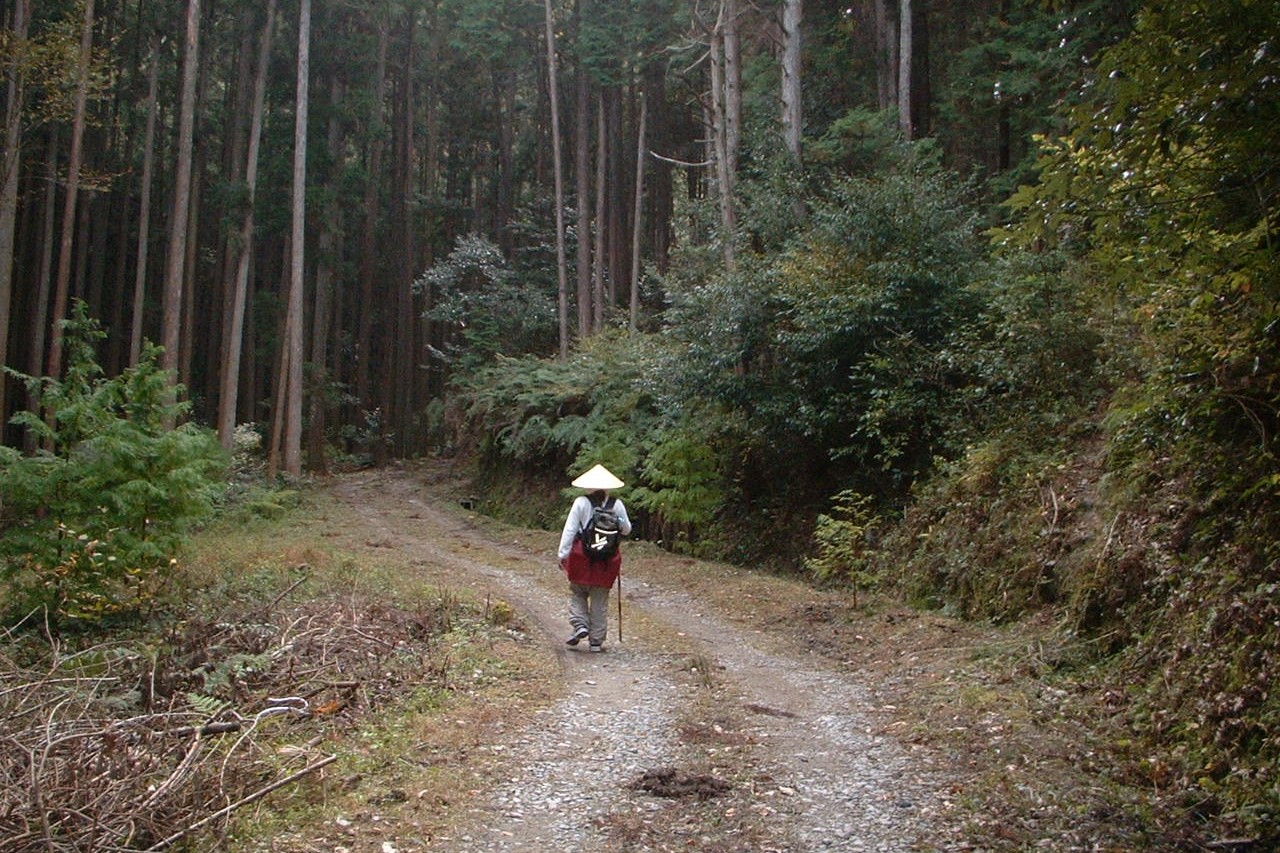
Best Times to Visit and Weather Considerations
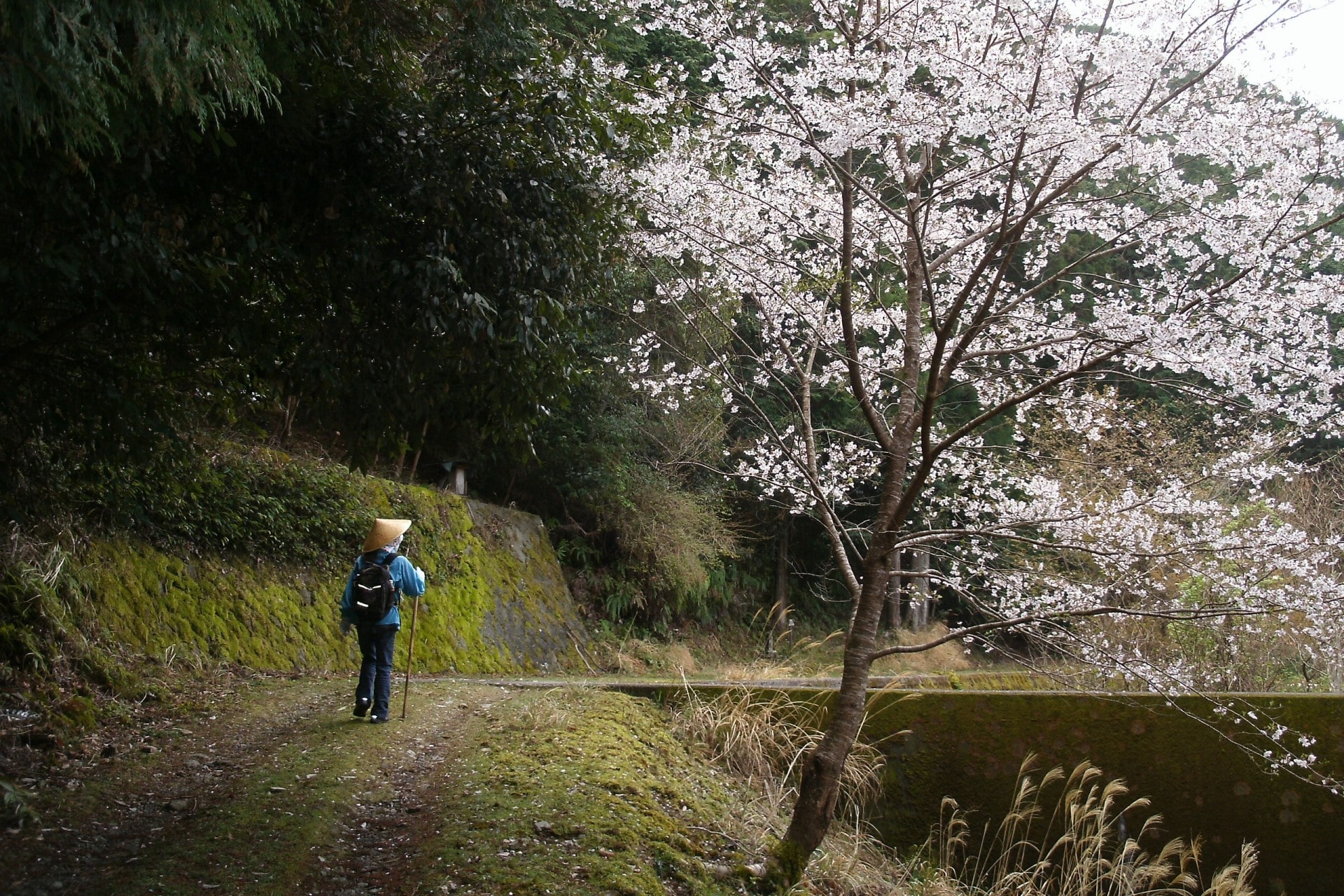
The Kumano Kodo can be walked year-round, but each season offers a different experience. Spring brings mild weather and the bloom of cherry blossoms, making it a popular time for pilgrimage. Autumn is equally favored for its cooler temperatures and the stunning display of fall foliage. Summer offers lush greenery but comes with high temperatures and humidity, requiring ample hydration. Winter sees fewer visitors which for some may be a better pilgrimage experience, though some trails may be more challenging due to colder weather.
Essential Gear and Preparation Tips
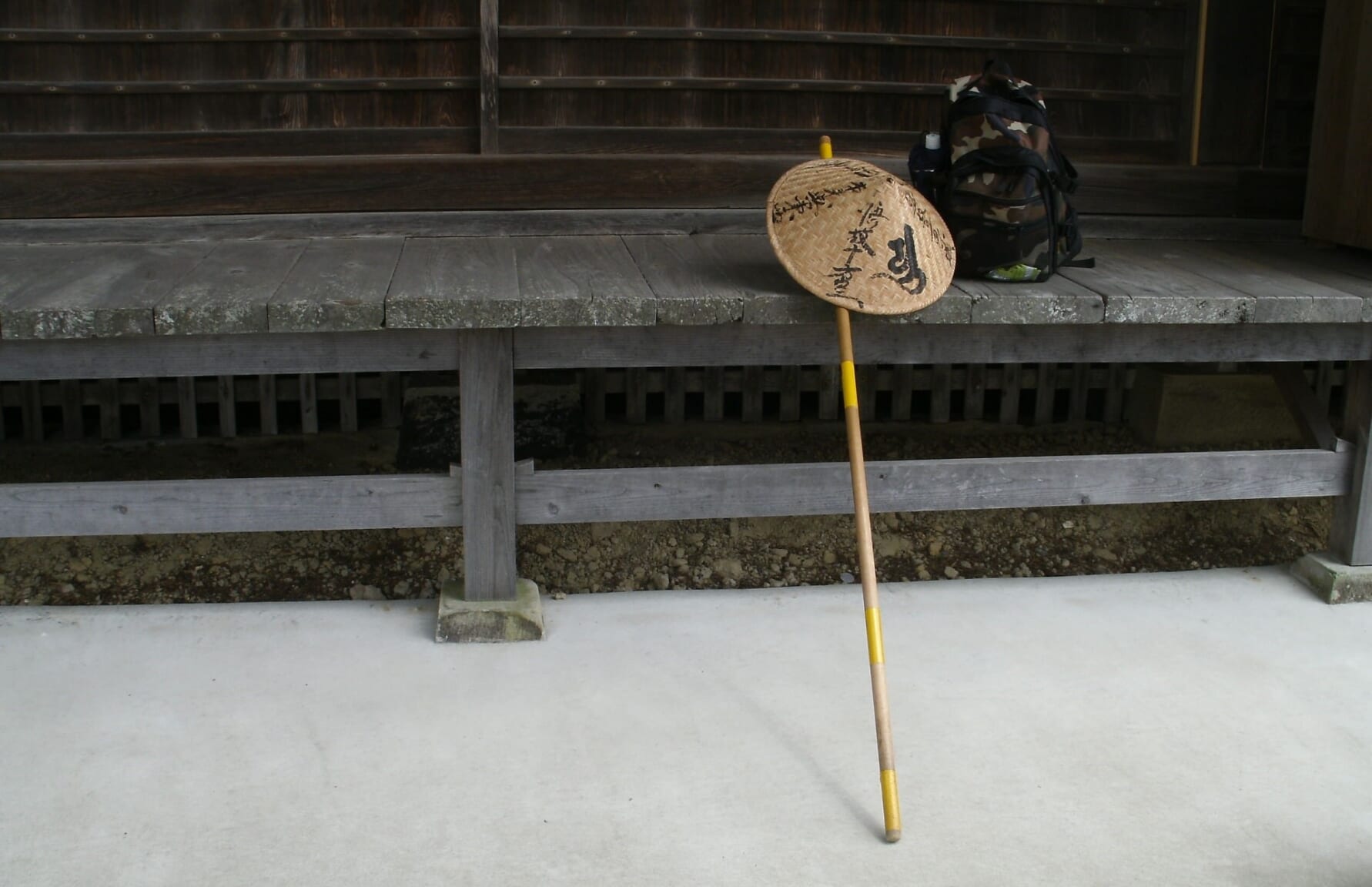
- Sturdy, broken-in hiking boots are a must, as trails can be uneven and occasionally slippery.
- Lightweight, breathable clothing that can be layered allows for adjustments to changing weather conditions.
- A reliable rain jacket or poncho is essential, as the region is known for sudden showers.
- A daypack to carry water, snacks, and a basic first aid kit will help ensure a safe trek.
- For those planning multi-day hikes, arranging accommodations well in advance is recommended, as guesthouses and inns along the route can fill up quickly, especially during peak seasons.
Navigating the Routes: Signage and Wayfinding
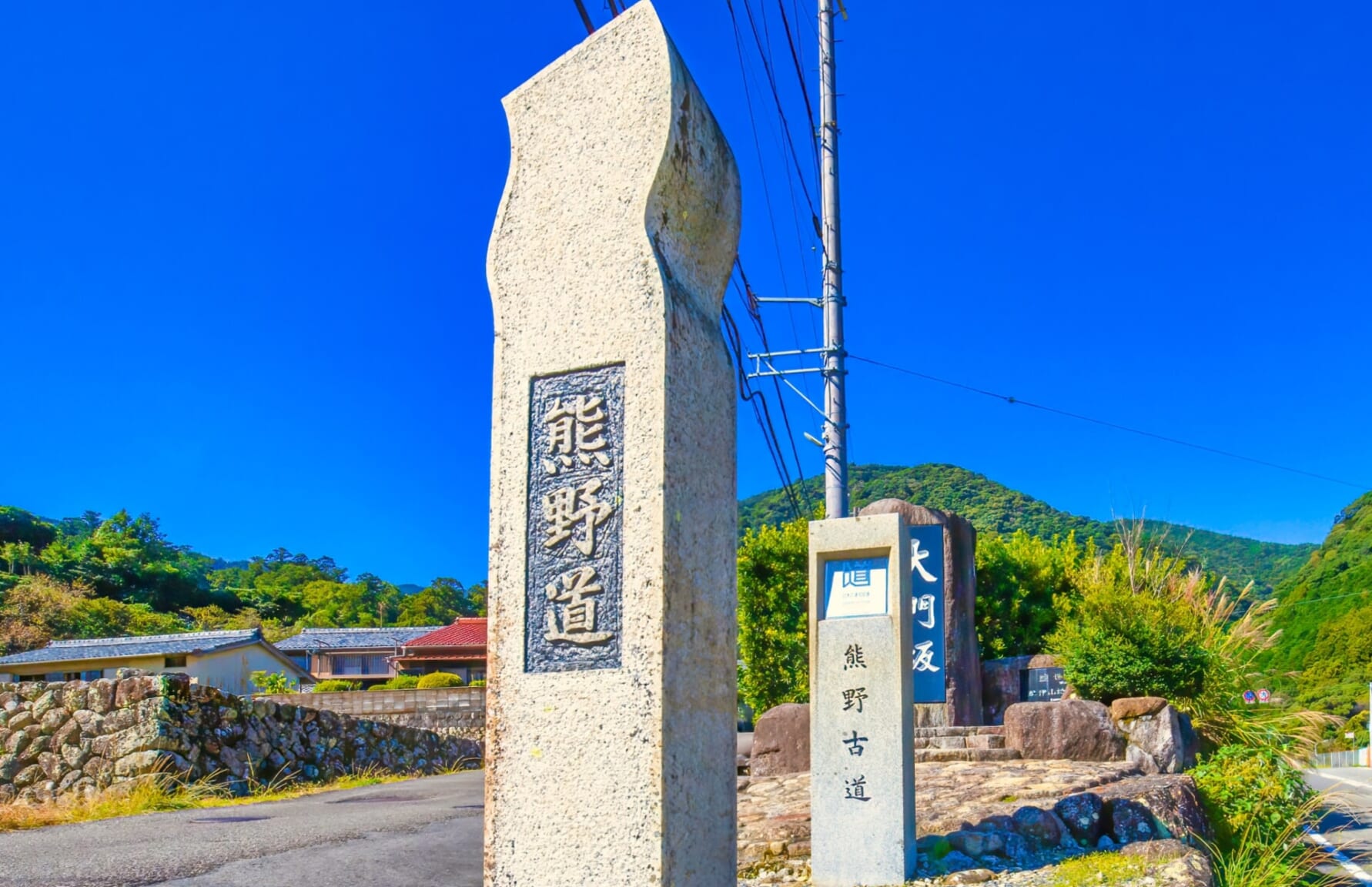
As the trails of the Kumano Kodo wind through ancient forests, across mountain passes, and by sacred shrines, they invite a deep sense of reflection. Pilgrims often find that the physical challenge of the journey is matched by an inner journey of discovery and contemplation. The experiences along the way, from the warmth of local hospitality to the solemn beauty of the shrines, leave lasting impressions that extend far beyond the pilgrimage itself.
For more information about traveling in Japan, check these articles below, too!
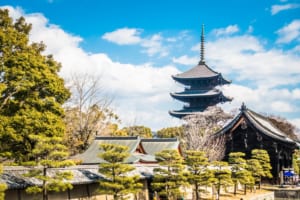
▽Related Articles▽
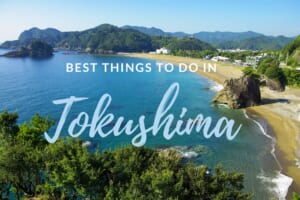
▼Editor’s Picks▼
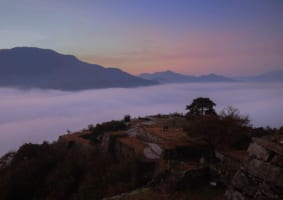
Photographer, journalist, and avid urban cyclist, making sense of Japan since 2017. I was born in Caracas and lived for 14 years in Barcelona before moving to Tokyo. Currently working towards my goal of visiting every prefecture in Japan, I hope to share with readers the everlasting joy of discovery and the neverending urge to keep exploring.
- Things to Do
Japan: Koya-san & Kumano Kodo Trek
8 days | trek ancient trails in the tranquil countryside of japan..

Stray off the tourist trail with an eight-day trekking adventure on some of the ancient pilgrim routes in Japan. The Koya-san and Kumano Kodo treks take you deep through the wilderness and into the mountainous landscapes of Honshu, as well as provide insight into the strong connection with past and present pilgrims hiking these historic routes. Along the way, stop by peaceful temples and tranquil monasteries, soak in traditional onsen and discover the cultural hubs of Kyoto and Osaka. This small-group adventure will give you both a physical and cultural workout around the best of enchanting Japan.
Trip overview
- Explore Kyoto on a couple of nearby hikes for a different perspective on the life and culture in this notable city, as well as visiting some sites of natural and religious significance.
- Experience two of the main religions in Japan – Buddhism and Shintoism – by following the footsteps of ancient pilgrims on their quest for faith along the Koya-san and Kumano Kodo trails.
- Discover two of the major cultural hubs of Japan on foot, walking the Philosopher’s Path in Kyoto and strolling through the Dotombori district in Osaka.
- Join in on the morning prayers and share a traditional shojin ryori (Buddhist vegetarian) meal during an overnight temple stay in Koya-san, deep in mountainous Wakayama prefecture.
- Soak in an ancient onsen after a day of trekking in Yunomine – there's no better way in Japan to relax and rejuvenate, as well as understand local cultures, than in the natural mineral waters of a hot spring.
- By travelling on this trip, you’ll learn about our Intrepid Foundation partner, Eden Reforestation Projects. Donations help them provide local employment opportunities and tackle climate change one tree at a time as they restore forests across 10 different countries. Intrepid will double the impact by dollar-matching all post-trip donations made to The Intrepid Foundation.
- The active nature of this trip means that the fitter you are, the more you will be able to enjoy it. It is expected that travellers joining this trip will have had some experience hiking before joining this tour. On some hikes you will need to be able to carry your overnight pack on the trail because we will forward your luggage to the next destination. Hiking distances vary from 3-15km per day with no more elevation change than 60-900m on one hike.
- The hikes on the Koya-san trail and Kumano Kodo include sections rather than the whole trail, which gives you an experience of the trails without needing to commit to multiple days of strenuous trek-king.
- In some destinations you may be staying in a ryokan – which is a Japanese-style inn with shared facilities. It’s a great taste of tradition, but not everyone finds futon mattresses on tatami mat flooring, small bathrooms and proximity to other guests as comfortable as more Western-style hotels and beds. Read more about ryokans in our ‘Accommodation’ section of the Essential Trip Information.
Konnichiwa! Welcome to Kyoto, Japan. Your adventure begins with a welcome meeting at 6 pm today. If you have some free time, step out onto the streets for your first taste of this beautiful city. Originally founded as Heian-kyo – ‘tranquility and peace capital’ – in AD794, Kyoto was the capital of Japan for over 1000 years before the emperor and government relocated to Tokyo. Because of this, Kyoto is rich in history, with over 2000 temples, shrines and gardens. After the meeting tonight, perhaps head out for your first taste of traditional Japanese food. As the millennium-long home of the imperial kitchen, Kyoto is known as the centre of Japanese culinary tradition, so you’re sure to have a delicious meal wherever you go.
- Hotel (1 night)
There are no meals included on this day.
It’s very important that you attend the welcome meeting as we will be collecting insurance details and next of kin information at this time. If you are going to be late please let your travel agent or hotel reception know. Ask reception or look for a note in the lobby for more information on where the meeting will take place.
Get active this morning with a walk to the eighth century Shimogamo Shrine – located right at the intersection of the Kamo-gamo and Takano rivers. The shrine is dedicated to the god of harvest and holds many rites around purification and agricultural produce, and this visit will provide you an introduction to Shintoism – an indigenous belief system connecting ancient past and present Japanese culture together. Continue onwards to renowned Ginkaku-ji, also known as the Silver Pavilion, to see Japanese garden design at its best and learn about the key principles of Japanese Zen. Afterwards, take a short but steep hike up behind Ginkaku-ji for some scenic views over Kyoto. On your way back to the hotel, walk along Philosopher’s Path, lined with cherry blossom trees, and if there’s time, stop by two other Zen temples. Today’s introduction to the importance of Buddhism and Shintoism in Japanese culture will inform some aspects of your hiking trails in the days to come, so listen up!
- Kyoto - Shimogamo Shrine
- Kyoto - Path of Philosophy (Tetsugaku-no-Michi)
- Kyoto - Ginkaku-ji (Silver Pavilion)
- Kyoto - Mt. Daimonji-yama hike
Today's walk is around 15km for a total of about 8 hours (with many stops).
Leave your accommodation after breakfast and take a train (approximately 2.5 hours) to Kii-hosokawa Station in the Koya-san district, ready for your forest trek. Koya-san is the name given to a monastic complex in the Koya-Ryujin Quasi-National Park, and is one of Japan’s most sacred sites. Begin your 11-kilometre trek on the Koya-san Choishi Michi trail, passing by stone signposts (choishi), which stand every few hundred metres to help the original pilgrims find their way. After approximately 4.5 hours, you’ll reach Daimon Gate – a two-storey crimson gate that marks the entrance to Koya-san. Being the centre of Shingon Buddhism, Koya-san is steeped in centuries of history, and you’ll be able to learn about its role as an active spiritual centre this afternoon. Tonight you will stay in traditional shukubo (temple stay) accommodation, and enjoy a shiojin ryori (Buddhist vegetarian) meal provided by your hosts.
- Temple Stay (1 night)
- Koya-san - Koya-san Choishi Michi trail
- Koya-san - Okuno-in Mausoleum
Today you'll hike around 11 kilometres (approximately 4.5 hours).
As you travel on public transport for the next few days, we'll forward your big luggage to Yunomine while you take a smaller bag with you to Koya-san. You will also carry this bag on your hike today.
1 x piece of luggage is included in our luggage forwarding service. If you have extra luggage you'd like to be forwarded from Kyoto to Yunomine, the cost will be about 1800-2300 JPY depending on the size. Your Leader will be able to advise the exact amount whilst on your trip. which you’ll carry on your hike today.
Today’s accommodation will have shared facilities.
This morning, you’ll have the chance to participate in the monastery’s morning prayers, before making tracks to Yunomine Onsen by private vechicle. This 4.5-hour journey weaves through the Koya-san and Kumano Kodo mountains, so you’ll definitely want a window seat. Yunomine is an ancient onsen town that forms part of the Kumano Kodo trail – of which you will be trekking in the coming days. Yunomine Onsen has such a long history that one of its onsen baths, Tsuboyu, is designated as a World Heritage-listed site. Historically, pilgrims would perform purification rituals in the hot spring water as part of the religious process of their pilgrimage. Today you’ll also get to visit Kumano Hongu Taisha – one of the three grand Shinto shrines on the Kumano Kodo.
- Ryokan (1 night)
- Kumano Kodo - Kumano Hongū Taisha
Embrace an early start as you’ll hike part of the historic Kumano Kodo today. The Kumano Kodo is one of only two World Heritage-listed pilgrimage routes in the world, the other being the Way of St James (Camino de Santiago) in Spain. This morning, transfer to Ukegawa by bus (a short 15-minute ride), then begin hiking this pilgrimage route to Koguchi. The first 5 kilometres are a gradual uphill to Hyakken-gura, then it’s an undulating trail to the Sakura-toge Pass for around 3.5 kilometres. After this, it will mostly be downhill until you reach Koguchi. Today’s trails are surrounded by natural forest, full of cedar and cypress trees, and upon reaching the Hyakken-gura peak, you’ll be greeted with sweeping views of the mountainous terrain of Wakayama.
- Guesthouse/Ryokan (1 night)
- Kumano Kudo - Hiking
Today’s hiking distance is approximately 13 kilometres and will take about 6 hours, with elevation change of about 400 metres. This morning, your luggage will be transferred to tonight's accommodation, so you'll only need to carry a day pack with you on the hike today.
New day; new trail – get ready for another full-day hike on the sacred Kumano Kodo. For around the first 3 hours, it’s a steep uphill climb, rising to over 800 metres. After reaching the Echizen-toge Pass, follow the ridge of the forest for another couple of kilometres until you reach the highest point at Funami-jaya teahouse (868 metres). Continue mostly downhill for approximately 4.5 kilometres to Nachi Taisha – another of the three Kumano shrines, and probably the most photographed because of the nearby waterfalls that cascade in the background. Enjoy the peaceful scenery and sense of accomplishment before heading by taxi to Kii Katsuura this afternoon. Your accommodation this evening is a Japanese-style guesthouse.
- Guesthouse (1 night)
Today’s hiking distance is approximately 15 kilometres on mountain trails and will take about 7-8 hours.
This is a challenging hike, known to locals as a 'body breaking slope'. If you are not up to the hike today, there's an option to take the local bus to Nachi Falls, explore that area by yourself and meet the group when they get there. Once you start the hike, it will be very difficult to turn back. Your luggage will be transferred to tonight's accommodation, so you'll only need to carry a day pack with you on the hike today.
In the morning, visit the local tuna market at Kii Katsuura, where tuna from the cool waters of the Pacific is traded daily, before you hop on a train and rest your legs for the long journey to Osaka (approximately 5 hours). You’ll hit Osaka around lunchtime, just in time to head on a walking tour with your leader to the famous Dotombori neighbourhood, which is the city’s most popular shopping, food and entertainment district. At night, this district is lit by hundreds of neon lights and mechanised signs, including the famous Glico Running Man and Kani Doraku crab. How about getting a group of your travel pals together for a night of food, drinks and possibly some karaoke!
- Osaka - Dotombori District walking tour
- Kii Katsuura - Tuna Market
With no activities planned for today, you are free to depart at any time of the day. Hotel check-out time is usually around 10 am, however if you have later onward connections, you will be able to store your luggage at the hotel reception during the day.
6 breakfasts, 2 lunches, 5 dinners
Train, Private vechicle, Taxi
Hotel (3 nights), Ryokan (1 night), Guesthouse/Ryokan (2 night), Temple Stay (1 night)
Dates and availability
Important notes.
1. As this is an active hiking trip you will need to have an excellent level of fitness. Please read the itinerary carefully to make sure that you'll be able to make the most of the activities on this trip and enjoy an active adventure in Japan.
2. Your luggage will be forwarded to the next destination at different points of the trip, but you'll still need to be able carry a small day pack during the hiking. 3. A Single Supplement is currently not available for this trip due to limited rooms at many of our properties.
4. We are currently unable to book pre or post tour accommodation at our start & finish point hotels due to limited room availability. We recommend booking a hotel of your choice through an online booking engine if you are planning to stay longer in Japan.
5. This trip does not include a Japan Rail Pass. If you are planning to travel in Japan before or after your trip you will need to purchase your own Japan Rail Pass in advance or individual tickets in country.
6. It is essential you pack light and compact for rail travel in Japan. From May 2020 size restrictions were implemented for luggage transportation on Japan trains. You will be allowed up to two pieces of portable luggage, the total length, width and height of which must not exceed 250 centimetres. (up to 2 meters in length) and 30 kilograms in weight. Luggage over 251cm will NOT be permitted on trains at all. Please notify your tour leader at your Welcome Meeting if your luggage is the size limits mentioned above, so they can make the necessary arrangements.
7. Please note that there are generally less double rooms in Japanese hotels, even those in Western style. While every effort will be made to accommodate double room requests, this may not always be possible.
Want an in-depth insight into this trip? Essential Trip Information provides a detailed itinerary, visa info, how to get to your hotel, what's included - pretty much everything you need to know about this adventure and more.
Filter by rating


IMAGES
VIDEO
COMMENTS
Kumano Kodo accommodation. Obviously there are countless options of places to stay at along the Kumano Kodo trail. These are a mixture of Japanese-style lodges and Western B&Bs/hotels. Prices vary massively from as little as 2,500 yen (£18) per night all the way up to 25,000 yen (£180) per night for an uber lux place.
The Kumano Kodo trail is not a set route, and there is no set number of days you must be on the trail. You can do one route in a day and have just as much time if you do a five-day trek, or you can even stay on the Kumano Kodo trail for three weeks. It's all up to you, your budget, and your time in Japan.
The trail was used by emperors, samurais, and common people alike, and it is still an important part of Japanese culture today. In 2004, the Kumano Kodo was designated as a UNESCO World Heritage site, recognizing its cultural and historical significance. A summary of the hike. The Kumano Kodo is a 75-kilometer trail that takes 5-6 days to complete.
Kumano Kodo Walking Trail Overview. If you're looking to do a trek in Japan, you're probably considering either the Kumano Kodo, which is in Wakayama (southern Kansai), or the Nakasendo, which connects Tokyo and Kyoto via the mountains of Central Honshu.Since the Nakasendo has become popular in recent years, we find that the Kumano Kodo gives you a more authentic and less touristy ...
The Kumano Kodo Pilgrimage Route is one of the world's premier spiritual roads. ... A mythical three-legged crow is the symbol of the Kumano Kodo, and of Japan's national soccer team. ... (794-1185), former emperors began making the arduous trek to the region in search of spiritual enlightenment. The pilgrimage gradually became more widely ...
The Kumano Kodo is one of Japan's great ancient pilgrimage routes, flaunting the best of Japan's natural beauty and spirituality. Located in Kansai south of Kyoto, the Kumano Kodo will lead you deep into one of the most magnificent mountain ranges in Japan. This complete guide to the Kumano Kodo will dive into the history of the pilgrimage, the different Kumano Kodo trails, and how to hike ...
Kumano Hongu Taisha — Found at the center of the Kumano Kodo Pilgrimage and serving as the lead shrine to over three thousand shrines across Japan, this sacred complex can be reached by climbing up 580 stone steps.; Kumano Hayatama Taisha — A sacred space, three deities of Shintoism are said to have come to Earth on a rock near the shrine. Religious artifacts dating back to the third ...
One of Japan's most revered pilgrimage trails, the ancient Kumano Kodo weaves around the mountainous Kii Peninsula in Wakayama, passing through areas of remarkable spirituality and natural beauty. ... Along the journey stop off at the hidden hot spring hubs before finishing the trek at the tallest waterfall in the country. Highlights. Walking ...
Get There. Kumano Kodo (熊野古道, Kumano Kodō) refers to a network of pilgrimage trails through the southern Kansai region. The Kodo ("old ways") are a key part of the region's World Heritage designation and have been in use for over 1000 years. They are the only pilgrimage routes besides the Camino de Santiago to be designated a World ...
Located nearly 100 kilometers (62 miles) south of Osaka on Japan's Kii Peninsula, the Kumano Kodo is a network of pilgrimage routes that have been in use for more than 1,000 years. ... If you are considering doing a Kumano Kodo trek, we highly recommend researching further on this site.
Hiking the Kumano Kodō: Japan's ancient pilgrimage route. Login Save . Andrew Bender. Oct 8, 2019 • 7 min read. ... Self-reflection not selfies: why Tokyo's Mt Takao trek is a perfect complement to Mt Fuji. Feb 5, 2020 • 4 min read. Beautiful, spiritual and lacking crowds, Mt Takao could be the perfect complement to a Mt Fuji trek, and ...
Kumano Sanzan - the three Grand Shinto Shrines of the Kumano Kodo Kumano Hongū Taisha. Kumano Hongū Taisha [Official website, Google Maps location] is located in the centre of the Kii Mountains, at the confluence of the Kumano and Otonashi Rivers.Its original entrance is marked by the world's largest shrine gate (called Torii) - the Ōyu no hara Torii - which is 34 metres high and 42 metres ...
Located south of Osaka on the Kii Peninsula of Japan 's Honshū island, the Kumano Kodo trail system is an ancient religious route that connects three sacred sites, Yoshino and Omine, Kumano Sanzan, and Koyasan. It's also one of only two UNESCO World Heritage pilgrimage sites, alongside the Camino de Santiago to Santiago de Compostela in Spain.
An ancient pilgrimage trail winds through the mountains of Japan's Kii Peninsula, a densely forested region south of Osaka and Kyoto. It is the Kumano Kodo, a sacred passage of immense natural ...
The Kumano Kodo is an 190-mile (370km) network of pilgrimage trails, consisting of five interconnected routes which run through the Kumano region of Japan, on the mountainous Kii Peninsula, south of Osaka. The name translates literally to English as the 'old roads to Kumano' and the trails have been in use for over 1000 years.
The first day, you'll need to wake up early to get to the Kumano Kodo trail first by bus. At the Tanabe Tourist Center, you'll find a ticket machine. Buy a ticket for "Takijiri", which will cost 960 yen ($9 USD). Check the current bus timetables here, but there should be a bus departing before 9 AM.
Kumano Kodo. For centuries pilgrims have followed the Kumano Kodo, sacred trekking routes through Mie, Nara, Wakayama, and Osaka prefectures that were established over a thousand years ago. The trail is a UNESCO World Heritage site, connecting three of the area's most sacred shrines—the Kumano Sanzan—with other natural and spiritual sites ...
Thousands of feet on spiritual journeys have beaten the paths of the Kumano Kodo over the past thousand years. The network of pilgrimage routes runs across the mountainous Kii Peninsula in Wakayama Prefecture, down in the southern part of the Kansai region.. Whether you find solace in Buddhist tradition, something Abrahamic or simply see Nature as your temple, it's easy to see why the Kumano ...
The Kumano Kodō (熊野古道) is a series of ancient pilgrimage routes that crisscross the Kii Peninsula, the largest peninsula of Japan.These mountainous trails are used by pilgrims to the "Kumano Sanzan" (熊野三山) - the Three Grand Shrines of Kumano: Kumano Hongū Taisha (熊野本宮大社), Kumano Nachi Taisha (熊野那智大社) and Kumano Hayatama Taisha (熊野速玉大社).
Kumano Kodo Food The wonderful regional cuisine in the traditional guesthouses is truly one of the highlights of hiking the Kumano Kodo. From the fresh organic produce grown in the region to the freshly caught river fish and the vegetarian cuisine of Koyasan monastery accommodation, walking the Kumano Kodo is also an exploration of tastes.
Kumano Hongu Taisha (熊野本宮大社), in the mountains of the Kii Peninsula, is a cornerstone of the Kumano Kodo pilgrimage. The main deity of this grand shrine is Kato Mimiko no Okami, among many other deities linked with Japan's mythical origins. The exact foundation date is unknown but it's commonly attributed to one of Japan's ...
The hikes on the Koya-san trail and Kumano Kodo include sections rather than the whole trail, which gives you an experience of the trails without needing to commit to multiple days of strenuous trek-king. In some destinations you may be staying in a ryokan - which is a Japanese-style inn with shared facilities.
The Kumano Kodō is a region of Japan comprised of branching pilgrimage routes that stretch into varying corners of the Kii Peninsula. The pilgrimage itself dates back more than 1,000 years and its routes have been walked by all levels of society, from commoners and artisans to aristocrats and retired emperors, and stands as a symbol of ...